


 GEORGE CHUBINASHVILI NATIONAL RESEARCH CENTRE FOR GEORGIAN ART HISTORY AND HERITAGE PRESERVATION
GEORGE CHUBINASHVILI NATIONAL RESEARCH CENTRE FOR GEORGIAN ART HISTORY AND HERITAGE PRESERVATION
THE FUNERARY MONUMENTS OF GEORGIA FROM THE SEVENTEENTH TO THE NINETEENTH CENTURIES
TBILISI
2022
©George Chubinashvili National Research Centre for Georgian Art History and Heritage Preservation www.gch-centre.ge

Project initiated and directed by Dr EKATERINE KVACHATADZE Editor
Dr SAMSON LEZHAVA Consultant Dr ELDAR NADIRADZE
Photographs by GOGOTUR MISRIASHVILI Design by DATO MOSIASHVILI
Translated into English by Dr TAMAR GOGUADZE
English editor MARTIN KENNETH ALMOND Shota Rustaveli National Science Foundation of Georgia www.rustaveli.org.ge
The project was implemented with the financial support of the Shota Rustaveli National Science Foundation of not necessarily reflect the views of the Foundation.
©Ekaterine Kvachatadze

CONTENTS
Foreword ......................................................................................................................
Ekaterine Kvachatadze
GRAVESTONES WITH FIGURATIVE RELIEF SCULPTURES IN LATE MEDIEVAL AND MODERN GEORGIA ..............................................................................................
Samson Lezhava
THE GRAVESTONE _ AN EXPRESSION OF GEORGIAN CULTURAL WORLDVIEW .............................................
Manon Liluashvili ARCHITECTURALLY DESIGNED FUNERARY MONUMENTS TH TH CENTURIES: BALDACHINS, SEPULCHRES, CHURCH MODELS .........................................................................................
Manon Liluashvili GRAVE STATUES IN GEORGIA AT THE END TH TH CENTURY ......................................................................................
Giorgi Papashvili GRAVESTONES, EVERYDAY LIFE AND MATERIAL CULTURE TH TH CENTURY GEORGIA ..............................................................................................................
Nodar Aronishidze INVENTORY OF GRAVESTONES ......................................................................................................
SELECT BIBLIOGRAPHY ........................................................................................................... ILLUSTRATION CREDITS ..........................................................................................................
TO THE CHERISHED MEMORY OF DIMITRI TUMANISHVILI
FOREWORD
gravestones with pictorial decorations in general. I began to work on the topic immediately: I travelled to Telavi and need to study late medieval Georgian sculpture. I adopted this as a topic for my PhD research at the kind suggestion Foundation of Georgia, that an opportunity arose to study gravestones from an art-historical perspective. Dr Tumanishvili was the first person to whom I brought this good news, and he wished us success with his customary joyful optimism.
The Memorial Monuments of Georgia from the Eighteenth to the Nineteenth Centuries. The project was funded by the Shota Rustaveli National Scientific Foundation of Georgia.
The monograph was prepared for publication by Dr Ekaterine Kvachatadze, Dr Samson Lezhava, Giorgi Papashvili, Manon Liluashvili and Nodar Aronishidze.
The goal of the work is to present an overall survey of those late medieval and modern gravestones embellished with pictorial relief sculptures and architectural décor, to consider their essential features, their iconological, stylistic, thematic and ideological novelties, their artistic tendencies, and the influence upon them of folk-art traditions.th c. to the content and iconography of the decorations and the medieval tradition of relief sculpture. Additionally, the modern Neo-Baroque and Art Nouveau styles, sometimes combined in a somewhat eclectic manner. published in the book. including the members of the staff of the George Chubinashvili National Research Centre for Georgian Art History and Heritage Preservation: Tamar Belashvili, Iza Bukia, Mariam Gachechiladze, Ekaterine Gedevanishvili, Irine Giviashvili, Tamaz Dvali, Mariam Didebulidze, Levan Zedginidze, Baadur Kupreishvili, Aza Lobjanidze, Kiti Machabeli, Natia Natsvlishvili, Qristine Sabashvili, Marine Pantskhava, Temur Kantaria-Jabadari, Tsitsino Chachkhunashvili, Natalia Chitishvili, David Chikhladze, Tamta Khosroshcili, David Khoshtaria; our colleagues: Tamar Belkania, Giorgi Gagoshidze, Natalia Gengiuri, Tea Intskirveli, Ana Shanshiashvili, Neli Chakvetadze; and historians: Eldar Bubulashvili, Ketevan Dighmelashvili, Archpriest Ilia Chigladze, Gabriel Shalibashvili, Teimuraz Jojua; the staff of the Georgian National Museum: Gia Marsagishvili, Nino Dolidze, Nino Datunashvili, Gulnaz baratashvili, Eter Sulkhanishvili; Oni Local Museum: Akaki Rekhviashvili, Gia Berishvili, David Japaridze; Ambrolauri Museum of Fine Arts: Ketevan Beradze; The Georgian National Museum in Sighnaghi: Marine Chakhsnashvili; Telavi History Museum: Marine Okhanashvili; Tsageri History Museum: Nugzar Kopaliani; Kaspi Local Museum: Giorgi Chaduneli; Tetritskaro Local Museum: Tamar Talakhadze; Chokhatauri Local Museum: Natia Kalandadze; Kutaisi State Historical Museum: Nona Kartsidze, Nino Sarava, Maia Kebuladze; Kutaisi Central Archive: Merab Kezevadze; Samtskhe-Javakheti History Museum: Tsiuri Lapachi; The Mayor’s office of Akhaltsikhe Municipality: Revaz Andghuladze; The Mayor’s office of Tsalka Municipality: Amiran Sakvarelidze; The Mayor’s office of Aspindza Municipality: Kakha Zedginidze; Kharagauli History Museum: Nino Dididze; Didube Pantheon: Badri Kutateladze; Documentarian Shota Gujabidze; G. Tsereteli Institue for Eastern Studies at Ilia State University: Eter Gviniashvili; The Faculty of Humanities at Batumi Shota Rustaveli State University: Zaza ShaShikadze; The National Archives of Georgia: Ketevan Kobiashvili; Marta Misriashvili.
Ekaterine Kvachatadze
5

1. The gravestone of Bishop Parthenoz of Kharchashani Detail
EKATERINE KVACHATADZE
GRAVESTONES WITH FIGURATIVE RELIEF SCULPTURES IN LATE MEDIEVAL AND MODERN GEORGIA
Georgian memorial monuments form an immensely important component of the history of Georgian culture, a culture which unites centuries-long traditions of Georgian fine arts, architecture, ethnography,
The scope of our art-historical research is limited to one epoch within this diversity and multiplicity – we aim to analyse specifically those gravestones which were produced from the Middle Ages to the
gravestone monuments.
Georgian memorial culture has been fundamentally studied by ethnologist Eldar Nadiradze, who in his monograph discussed the historiography, chronology, typology-classification, and symbolism of Georgian memorial monuments. This scholar also dedicated a special place in his various works to the historical, artistic and stylistic analysis of those gravestones which have zoomorphic images (particularly those
The earlier studies of gravestones are covered widely in a multitude of works published by historians and ethnologists. However, the topic of gravestones occupies a relatively minor place in works published by art historians. amounts of photographic material, has been presented in a book published by folklore specialists A. Arabuli and E. Tataraidze . Therefore, we may justly assert that a satisfactory and thoroughgoing arthistorical study of memorial gravestone monuments has not been conducted until now.
E. Nadiradze, The Memorial Culture of Georgia, The Symbolism of Memorial Monuments, –––, The Zoomorphic Monuments of Georgia, N, Berdzenishili, Matters Concerning the History of Georgia, Archaeological Expedition in Kola-Oltisi and Changli, The Material Culture of Shota Rustaveli’s Epoch, Archaeological Excursions in Mashavera Gorge, Archaeological Inquiries in Algeti and Iori Gorge, Drosha Enimkis Moambe, Materials for Georgian Ethnographical Studies, The Bulletin of the Georgian National Museum, Journey to Samtskhe-Javakheti, in the Bibliography section.
Matsne
Dzeglis Megobari, Pirosmanashvili’s Little Fisherman ARS GEORGICA
Late Medieval Buildings in Kakheti and Kartli, The Grave Monuments of Early 20th c, International Proceedings, Proceedings, Spektri, ACADEMIA Spektri, Proceedings
A. Arabuli, Remember me with forgiveness
7
of Georgia, allowing us to make a full and comprehensive study of those gravestones decorated with reliefs and produced within our target period; the study will focus on the peculiarities specific to different regions as well as some different stylistic and artistic tendencies. This chapter aims principally to discuss the range of figurative depictions on gravestones, their iconography, symbolic language, and artistic and visual specificities. We shall try to shed light on their relation to medieval sculpture, and trace their heritage and development against the background of the changes in worldview occurring during the modern period. The Middle Ages in Georgia lasted until th almost fourteen centuries . At the final stage of the development of medieval Georgian sculpture, like the and technical mastery became evident, along with a simplification of forms. Despite this, architectural sculpture retains some continuity with, and loyalty to, its tradition. We know Georgian sculptures of th th are decorated modestly, simply and sometimes even scantily, and differ greatly from those of the later Middle Ages. These older monuments are in a state of gradual deterioration and decay. They mostly display only crosses and epitaphs, an arm holding a bow and arrow or a sword, or sometimes a plough th th decorated with Bolnisi crosses, ought to be classified as memorial sculptures, as should the relief of the iconostasis th th c., we already discern attempts to preserve the traditions of medieval sculpture, which sometimes were followed in a somewhat mechanical manner. One may observe in these streams should be highlighted in this respect: relief depictions on gravestones (an ethnographic-folk by Western European and Greek models, which already sporadically appeared at the time. th th decorated with depictions, in which one can perceive a continued, albeit slightly altered, development of the creative thinking behind medieval relief sculpture. The gravestones of the time became a kind of skill and fine mastery .
T. Dadiani, E. Kvachatadze, T. Khundadze, Medieval Georgian Sculpture, E. Nadiradze, The Memorial Culture of Georgia, th memorial church built on his grave. The tile displayed the depictions of St Ioane of Zedazeni, the holy fathers and those who Qartuli Khelovneba, ACADEMIA , Moambe, (Georgian National
8
sculptures in the round. Consequently, bas-relief became the predominant artistic language of formhaut-relief sculpture th c. sculptures in the round do not appear in memorial monuments.
Based on the collected material, we have defined a typology of the memorial gravestones found widely distributed across the country. We have tomb chests, obelisks, stelae, maturi, cruciform tombs, tombs th c. onwards, we also have human statues, busts, etc. It is difficult to say with confidence today when the tradition of carving full-length depictions of the tombs of St David Gareja, St Dodo of Gareja and St Nino, which displayed full-length, painted depictions of the saints . Zaza Skhirtladze dated the earliest painted layer of the surface of St Nino’s tomb to the th th . It th th
preserved
The most widespread type of gravestone in Georgia is the tomb chest, the decorations of which manifest the aesthetics and artistic tendencies of different eras. The worldview of an epoch, the economic and social background, the profession of the departed and his or her social status was also clearly reflected in other memorial monuments. mausoleum of this bishop, the Chapel of Divinity is located near the village of Pichkhovani (Akhmeta saalkirche built with alternating brickwork and slate stonework . The ledger stone, with its relief depiction of the bishop, was
. The date of the building of the church, which is also a burial place for the inscription dedicated to the ktetors of the church . The full-length depiction of the bishop almost fully covers the area of the tomb’s surface. Bishop Parthenoz is dressed in episcopal vestments: he is wearing a long sticharion with a long epitrachelion over it; his sakkos is opened in the front and a large omophorion, embellished with a cross on each side, is crossed over his chest. Under the hem of his sticharion, we see
Z. Skhirtladze, The Final Resting Place of St David of Gareja, Z. Skhirtladze, St Nino, Essays of The Georgian National Museum, The tile is preserved at the court church of King Erekle’s Palace within the territory of the History Museum in Telavi. Qartuli Khelovneba, N ACADEMIA, ,
This stone with an inscription is preserved today in the treasury of stone sculptures at the Simon Janashia Museum of God and the reason for all, through your help, we, Parthenoz, the bishop of Kharchashani with the assistance of Peter, my brother, built this church as an intercessor for our souls at the second coming of Christ and as a burial for my my brother’s
The Bulletin of the Georgian National Museum, vol. 16,
9
the toes of his shoes pointing outward. The bishop is holding his arms crossed over his abdomen, slightly below his chest. His palms are carved smoothly in bas-relief, while his long, elegant fingers are bevelled
hand of the bishop is partly covered by the lower edge of his beard, which is divided into two parts. On the right wrist we see the rounded sleeve of the inner robe, although it may be an epimanikion one of the episcopal vestments; the face of the bishop, which clearly displays distinct portrait features, is slightly raised in comparison with his hair; each of his facial features is sculpted through tangible, smooth modelling: his slightly raised, thick eyebrows, surrounded by an engraved contour, adjoin his straight and thin nose with wide, almost horizontally stretched nostrils. The slightly puffed eyebags under his deeply recessed, almond-shaped eyes, and the semi-circular wrinkles carved under the high cheekbones, indicate his old age. His lightly carved, thick lips, although immersed in his beard, are clearly outlined. The thin layer of his long beard rests upon his chest and flows down to the level of his hands, its end parted down the middle. His smoothly carved beard, surrounded by a sharp outline, looks as though it has been polished, lending it the impression of tenderness. The portrait of the bishop is permeated with a calm spirituality.
th c relief sculpture and continues the best traditions of the Middle Ages. It has been as Ananuri, David Gareja, the Church of Peter and Paul in Sagarejo, and the Deesis of the eastern facade . And yet, the innovative and widespread tendencies of the era are also evident; these are most apparent in the diligently particularized, highly nuanced and detailed depictions of the figure of the bishop and his vestments. The depiction, alongside the monumental character of its form and the high level of generalization characteristic of the Middle Ages, also bears the individual features of a portrait.
the time, which indicate an orientation towards European works of art
As noted earlier, we know of no analogous tomb from Georgia’s Medieval period. Both iconographically and stylistically it is closer to contemporary mural paintings and to the embroidered tomb covers of the later period.
The life-sized figure on the bishop’s grave can also be interpreted as a portrait of the founder of the supplicatory inscription written in his role as a founder of the church. There are many portraits of both public figures and clergymen in contemporary monumental paintings, as well as portrait-like images of . Perhaps this zeitgeist inspired the creation of a relief portrait to immortalize the name of an outstanding bishop.
Little is known of the identity of this Bishop Parthenoz of Kharchashani, to whose name a specially built and highly distinguished mausoleum-chapel was dedicated, and whose gravestone is completely unique among the memorial gravestones of medieval Georgia. Unfortunately, all the available sources offer only very limited information about him. The special character of his burial place testifies to the fact that he must have been from an upper-class family, probably that of the Cholokashvilis . As is
Ananuri, th Literatura da Khelovneba, I. Khuskivadze, The Late “Folk” Mural Paintings of Georgian Churches, ACADEMIA
The Georgian Goldsmith of the 14th-19th cc., The historian Gabriel Shalibashvili shared with me this theory in a personal conversation.
10
well known, the Cholokashvili family were the landlords of Akhmeta at the time, and several bishops held in the chronicles of T. Zhordania, signified an educated, scholarly monk involved in educational activities. We also see several documents
Parthenoz of Kharchashani
The wooden and stone sarcophagi, as well as fabric tomb covers embroidered with the images of bishops, were well known in the Christian East at the time . Although, unlike the figure of the bishop of Kharchashani, most of the Russian, Serbian, and Romanian monuments of the time are carved in hautrelief technique, or are sometimes almost sculptures in the round, reclining upon the surfaces of tombs, and obviously reflecting European illusionistic tendencies.
Austrian, and Italian gravestones of the same time are totally different .
The presence of the tradition of full-length, flat depictions of clergy on their gravestones in the earlier th c. in the Jerpoint Monastery grounds in County Kilkenny, often referred to as the tomb of St. Nicholas. The gravestone of Ioane of Florence (the first
It is noteworthy that the tradition of covering the tombs of outstanding clergy or nobility with th th cc especially if such tomb covers were designed for the tombs of those clergy who were canonized as saints th th the present day. They belong to both public figures and the clergy. Among the embroidered tomb covers designed for clergy, we should point out the one made for the grave of St. Zenon of Iklato from Ikalto brilliant mastery found in the sculpture of the Middle Ages. The portrait of Parthenoz shows the influence of some elements of modern Realism. It finds no analogy among the medieval or later gravestones with figurative reliefs that are known to us today.
T. Zhordania, The Chronicles, relevant information.
The Manuscripts of the Georgian Law, Documents from the Social History of Georgia,
Cahiers archèologiques
Atti del V Congresso Internazionale di Studi Bizantini
Friedrich W. Leitner, Anmerkungen zu den Inschriftenträgern im Bezirk St. Veit an der Glan - die Grab- und Gedächtnisdenkmäler, © Landesmuseum für Kärnten www.biologiezentrum.at; E. Panofsky, Grabplastik (vom alten
N. Natsvlishvili, The Roman Catholic Churches in Georgia: History and Architecture, currently preserved at the Istanbul Archaeological Museum.
Revue Roumaine D’histoire de L’art, gratitude to Marina Okhanashvili - the chief treasury officer at Telavi Historical Museum, for providing me with a photo of the embroidered headpiece of the saint.
11
th c. Moreover, full-length depictions of human beings carved on gravestones are relatively rare th th century . The gravestone of Darejan, a woman, interred in the interior of mehtar (a private servant or ktetor
to a later period based on its artistic tendencies carved bas-relief depiction clearly betrays a stylistic link with medieval sculpture through its high degree depictions of vessels for water and wine, such as various types of a jug, with relief-carved, circular motifs lined up beside them. These images probably represent items connected with the cult of the departed prosphora are depicted on a horizontally elongated tile, together with their equipment (hammer, mason’s square, using simple, rigid, and generalized outlines. The artistic and stylistic features of the relief composition, which depicts these builders from what appears to be an aerial viewpoint, remind us of other gravestones of the same period. They also call to mind gravestones from later periods. Both the human figures and the items of everyday use are depicted by the same means and with the same height of relief carving. the decline of professional mastery to the level of mere craftsmanship, a decline which will later result th th . in Poladauri Gorge are also distinguished by their artistic diversity th- th cc. by their artistic and stylistic features. That said, they greatly differ from the highly artistic portrayal of the bishop of Kharchashani, which was nourished by the medieval tradition of Georgian sculpture. These gravestones are mostly created by masters of the folk tradition, and at the same time, bear features of
As noted earlier, a certain group of stelae from pre-Christian times are considered to be memorial monuments, although the difference of opinion over this issue prevails among scholarly circles. Very few of even the memorial stelae display figurative depictions. This issue passes beyond the scope of our current research. On medieval Georgian stone pillars, see K. Machabeli, Early Medieval Georgian Stone Pillars, Georgian Stone Crosses, I want to thank my colleague, Natia Natsvlishvili for providing me with the photo of the gravestone.
V. Beridze, The Georgian Church Architecture of the 16th-18th cc.
12
edges of the stone are surrounded by torus-moulded borders decorated with coniferous shaped engraved
one of the sides of the tomb. It is separated by a border of lily ornaments. The frontal depictions of three men standing side by side are carved on the left; two of them are holding their arms akimbo, while the third holds his arms crossed over his chest. The grim-looking figures, wearing long tunics with belts indeed almost flat, low relief. A large square shape is carved in the upper left corner of the composition, surrounded by a frame. This shape is a relatively common motif in the gravestone décor of this period. It even a loom. At the right of the frieze, different wine vessels are arranged in a line: a jug, a kula (a wooden sura karkara (a the centre. The tree of life is depicted in all four corners of the gravestone. The compositions of the sides covered with different types of drinking vessels, where each item is surrounded by a low ogee arch, slight movements, where each figure and vessel are separated from one another by arches resting on pillars. One of the three men, whose depiction is distinguished by its low relief, its generalized forms and with his legs crossed. The other two men also seem to be depicted seated: one of them is pouring wine into a cup from a jug, while the other one is holding his arms akimbo and looks as though he is depicted in movement. From this time onwards, scenes representing feasts, with their specific iconographic pattern, become a common feature of gravestone décor. It is worth noting that this theme became common in the th th postures, signifying a farewell to this life, creates a somewhat abstract scene through the laconism and conventionality of the presentation; the feeling of detachment is further emphasized by the placement of each figure under a separate arch.
Therefore, it is clear that the memorial mason is perfectly familiar with the ornamentation of the th th cc. and also with the iconography of figurative relief-carving, where we often find motifs such as lilies , knotted simply outlined human figures on smoothly carved flat surfaces . It is also typical for this era to depict th the lilies arranged in lines found on the ornaments of monumental architectural sculpture, and he speaks
Programme and Abstracts, Sakartvelos Sidzveleni,
13
. It is th th and folk art.
We find very shallow relief, indeed almost flat depictions of human figures, shown in full-length, on
various wine vessels, and perhaps a comb and a mirror depicted on the side areas by the head. The tradition of depicting personal items such as a mirror and comb, typical of the gravestone décor in Kvemo Kartli, is often associated with superstitious or mystical views about the souls of the departed. There
countries, and it symbolizes the transfer of the departed to the other world . According to the Christian interpretation, the Christian represents a kind of mirror image of Christ . On western European graves as early as the early Middle Ages, we also see combs belonging to craftsmen, which have some special function, It seems that the relief-carved combs of different shapes depicted on Georgian gravestones
. This theory is supported by a relief-carved image of a woman holding earlier, the relief-carved square shape, which can sometimes be identified as a loom according to the which was also a common occupation in those days both for women and men. Another grave at the same cemetery preserves fragments of a three-line Mkhedruli inscription, partly
. A relief composition is spread horizontally across the same facet, displaying
depiction of a man holding the handle of a jug in one hand. The distinctive manner in which the oval shape of the man’s face, his eyes, and eyebrows are depicted, is almost identical to the figures in the late medieval monumental relief sculptures, where the distinctive features include high cheekbones, thick, arched eyebrows closely linked to a wide nose, raised eyeballs surrounded with a thick contour, and short, thin lips. Thus, the carefully dated epitaph accompanying this particular gravestone may become our guide for dating those other gravestones without epitaphs which share the same style; the process is particularly difficult in the case of folk artworks.
th th
The tradition of placing a comb and a mirror in the grave of the departed survived to later times in almost all the parts of Georgia.
Dzeglis Megobari, Dzeglis Megobari,
14
are depicted on one of the shorter side facets, while the opposite facet contains a deep niche. On one of the longer side facets, we see a frontal depiction of a man and a lateral depiction of a horse, both contained within a single rectangular frame. The man, dressed in a long tunic, is leaning on a long spear with his left hand; in his other hand, he is presumably holding a rolling block rifle, which was particularly th century Europe, when the Georgian armed forces had just begun to use firearms. From that period onward they were used alongside the spear, which was the principal weapon for Georgian th century, however, firearms fundamentally influenced the changes that took place within the rules of military combat in Georgia . On the right of the man, we see a bandolier and a small church model. Our attention is drawn to the diagonally depicted bridle of a horse, which is drawn in rather crude proportions; the reins of the bridle reach all the way to the saddle, where they end in a disc shape composed of concentric circles. The depiction of a borjgali - the symbol of the sun placed on the saddle of a riderless horse, may here symbolize a warrior who has passed away. The genesis of
of Christ. A cosmological image symbolizing the horse is found in Georgian mythology and folk beliefs, border between the two worlds, while the soul of the actual horse of the departed, which was sacrificed, . The items depicted on the right of the horse and contained within a rectangular frame must represent a comb and a mirror. The surface of the opposite longer-side facet is densely covered with various depictions on a laid table, where we see dishes and food shown from different angles (some of them are displayed in lateral and the others in contained within the same composition, are typical of the medieval Georgian artistic modus. A similar approach is employed in the relief depictions of gravestones, the compositional pattern of which may be either organized, symmetrical or scattered around in a disorderly manner. Another tombstone, also from the Kvemo Kartli region, is similar to this latter gravestone. The stone is currently preserved in the stone artefacts repository of Sh. Amiranashvili Georgian National Museum different style of carving is particularly evident in the depiction of the human being: the facial features of the man depicted on a gravestone in Zemo Bolnisi are similar to those of the medieval relief figures, schematic carving of the folds of the clothing is rather rigid. Similar iconography is typically found in the depictions on some of the gravestones in Kvemo Kartli (e.g., the cemetery of the Monophysite church in famous for its ethnocultural diversity. There is another important gravestone preserved at the museum th th
Ibid. M. Tsurtsumia, The Georgian Armed Forces (900-1700): Organization, Tactics, Armament, Lexikon der Christlichen Ikonographie electronic journal Semiotics, N. Abakelia, The oldest Cosmological Concepts and Archaic Religious Symbols in the Cultural Memory of Georgians,
15
th
relief sculpture . This particular type of gravestone, along with its themes, was widespread among the
the long-side facets of a tall tomb chest is densely filled with depictions of a hunting scene, a banquet, musical stringed instruments, and aerial depictions of set tables with different types of drinking vessels, trays with food etc. These prototypical parallels shed light on the close cultural relations and reciprocal influences between Georgia and its neighbouring regions in this period. However, these works display traditions clearly different from the patterns found in medieval Georgian art.
various parts of Georgia to use certain patterns of compositions for gravestone decorations and that these patterns varied from region to region. With time, these scenes or compositional themes (such as a banquet, hunting, a plough with bulls attached to it, the departed persons with their military, agricultural
system through the shared interpretations of local stonemasons.
As noted earlier, Kartli is distinguished among the other regions of Georgia for the multiplicity and diversity of gravestones with figurative depictions. Here, as well as in other parts of Georgia, most of th
memorial masons working in a folk style. Their style is usually simple or simplified, sometimes crude or unsophisticated, rigid, generalized, and schematic, although some truly highly skilled works of high artistic and cultural-ethnographic value can also be discerned among them. During this period, in stark contrast with the Medieval era, priority is often given to full-length depictions of human beings from
in the concept of the individual human being typical of this epoch. Many quotidian elements reflecting the contemporary ethnographic and social reality of the time appear in these monuments. The practice of openly displaying professional and daily household items belonging to the departed, and bestowing a special significance upon them, may be linked to the increase of secular and realistic trends typical to the era, and also to the revival of pre-Christian traditions; it was considered important to place food
Gravestone images included to promote the intercession for, and the salvation of, the souls of the
semantic meaning and were inspired primarily by a universal Christian symbolism firmly established in the art of the Middle Ages. The graves are mostly decorated with depictions of crosses, angels, epitaphs and full-length human figures in their contemporary costumes, together with social and professional items (military and agricultural equipment, weaving tools, sewing machines, scissors, tables, dishes, th
century, statues standing on pedestals became increasingly widespread; some of them were imported from abroad, while the others were made by local masters. Most of the statues depict a grieving widow. th century, gravestones were decorated with medieval-style relief sculptures, but they also
Katharina Otto-Dorn, Türkische Grabsteine mit Figurenreliefs aus Kleinasien, ARS ORIENTALIS, The Arts of Islam and the East,
Materials from the Ethnography of Georgia, The Memorial Culture of Georgia,
16
incorporated elements typical of Art-Nouveau, Neo-Classical and Neo-Baroque décors. At the turn of th c., it became increasingly popular to place simply decorated ledger stones on the graves of kings calligraphy and were decorated with relief depictions of crosses, angels, family coats of arms and crowns
Among those gravestones in Kvemo Kartli and Shida Kartli that are embellished with figurative compositions, we often find the maturi and horses.
The gravestones at the churchyard of the church of St Marine in Dzveli Marabda are highly distinguished among the gravestones in this part of the country. According to the local tradition, the tombs belong .
The full-length depictions of men with their arms crossed over their chests and dressed in tunics are finely carved in low relief; they are distinguished by more sophisticated sculptural forms, slightly stylized sometimes weapons depicted near the elbows of human figures. For dating the graves in Marabda, one needs to pay attention to the ornamental border made up of images of lilies, like those seen in the th th cc. The depictions of shoes with heels and pointed toes, as well as the jigha th th cc., when these details were almost part of a dress code influenced by the Iranian culture of the time . The stylistic elements characteristic of medieval sculpture are evident in the iconography of the human figures: along with the facial features typical of the epoch, the depiction of a halo on this figure is almost identical to those on th th th cc. although it was very old, maybe even medieval. As already noted, there are no full-length depictions of the departed at this time; the flat surfaces of gravestones are simply decorated with neatly carved relief depictions: the arms of warriors holding arrows and bows, military weapons (shield, sword, staff, spear,
The gravestones at the old cemetery of the churchyard of the Church of St George in Akhalsopeli
Mother of God . Here we find archaic tombstones similar to the ones in Gokhnari, and also some later th th
weapons and professional tools, including weaving tools, shepherd’s crooks, sheep shears, bulls attached to ploughs, dishes etc., are freely displayed around the figures on the surface of the stones. The men are dressed in chokha-akhalukhi, and wear belts with daggers around their waists or are dressed in
Ethnographic Pictures from the 16th-18th cc. History of Georgia. Georgian Clothing, Shida Kargli (Ethnographic Research),
17
S. Bedukadze, Folk Stonemasonry in Algeti Gorge, The jigha
shepherd’s clothing, while women wear traditional, long Georgian dresses, shoes with heels, chikhtikopi headdresses with curls flowing down from them and veils. The women sometimes have a prominently displayed, individualized hairstyle: Sometimes on the sides of the head, we see their thin or thick braids is polysemantic. According to Georgian folklore and mythology, the hair acquires a magic meaning as a constantly renewing power and the source of the energy of life. This was reflected in the ritual of the cult of the departed in a peculiar way. It was a custom to place someone’s lock of hair into the grave of the departed on the day of the burial . The power of hair is also linked to sacral power in the Old , St Nino used her hair to bind the grapevine cross – the supreme symbol of Christianity in Georgia.
Akhalsopeli: it depicts a woman embracing her infant, which stands as an allusion to the archetypal image of the Virgin and Child . The décor of the gravestones in Bza differs through their stylistic diversity, bearing the imprints of the hands of many different masters while indicating the centuries-old age of the cemetery. A distinctive gesture of the hands is another common element shared by some of the gravestones. Relief depictions of arms end with the palms crossed over the chest in such a way that the palms look rather unnaturally attached to the arms, which are carved so that the forearms and upper arms
the haut-relief and innocence, also symbolizes Jesus Christ himself according to the Christian metaphorical system the salvation of the souls of the departed and their forgiveness is also linked with the Resurrection of already mentioned, symbolizes the separation of the departed from the world. The gravestones found in Gomareti, Manglisi, Kojori, Didi Toneti, Pitareti, Samshvilde, and Dmansi are th th reflects the diversity in the contemporary fashion of the time. The clothing helps us to correctly identify the dates of these graves. They display Georgian traditional clothing along with Circassian and Europeanth century . In the th century, the European style almost fully replaced traditional clothing, especially for women, who increasingly would appear in traditional costumes only at their wedding ceremonies in the church. Unlike them, men still dressed in chokha-akhalukhi th century. The Georgian headdress also remained in everyday use for quite a long time . Brides traditionally placed crowns over their chikhtikopi headdress during the church wedding, although after the disappearance of the traditional
R. Siradze, Literary-Aesthetic Essays, A gravestone with a depiction of a mother and a child was also found in the village Gomareti in Kvemo Kartli.
N. Datunashvili, Georgian Clothing and its Social Aspects from the 15th to early 19th c.,
18
Georgian headdress, the crown has frequently been replaced by a bridal veil according to the Europeanth of Georgian and European elements. of three arches, as was common for the depictions of women. This central arch may symbolize the royal doors of the sanctuary, as the location of her church wedding. A similar arch was also depicted on a grave in Tsveri village, containing a depiction of a man wearing a wedding crown and a chokha-akhalukhi (Fig. linked with the rituals of both weddings and burials . A relief depiction of a young man on a tomb chest th th th on a grave at the Kukia cemetery in Tbilisi, with a similar European hairstyle and fashionable clothing European clothing with a chikhtikopi headdress and a lightly carved bridal veil placed over it. The fashions and trends typical of the era are clearly reflected by the clothing of finely carved figures on the tomb to note how a stonemason in Didi Toneti presented the weaving implements and other handicraft tools of a chikhtikopi headdress and braids. Scissors and sheep shears are also depicted near her head. By her about the activities of the departed woman, and possibly her form of employment, while at the same time are distinguished by their diversity. Here we see both the realistically carved, well-proportioned figurative depictions and other tombs with less sophisticated reliefs. Tomb chests and stelae present a comprehensive gallery of different social classes, where they are depicted dressed in all kinds of chokha-akhalukhi, belt and dagger, socks and shoes, chikhtikopi and veil, displayed with agricultural tools and weapons, decorative accessories, etc. Here we also have memorial monuments for couples, where a single tomb displays the depictions of Haut-relief depictions of lambs and horses are also frequently seen on the surfaces of tombs, and on upper and lower facets. We also see those Christian iconographic symbols established in medieval Georgian art, for instance, flourishing crosses, distinguished; a baptismal fountain is depicted on the surface of the tomb, surmounted by a cross with figure of an athletic man dressed in a high-class chokha-akhalukhi is carved in haut-relief technique and A. Letodiani, Theoretical Consideration of Symbol and the Eikonic image of King Tamar in Old Georgian Literature, (Histories and Praises of the Crowned Ones; The Life of Tamar – the King of Kings; Tamariani; Abdulmesiani), PhD Thesis,
19
appears to be standing against the background of a central pillar: above his head, we can see the borjgali
and Dvani are particularly interesting. Finely carved tomb chests are found in the churchyard of the church of the Holy Archangels near Gori. All four facets of these tombs are decorated with finely carved architectural motifs and geometrical ornaments, while their main surfaces most often display reliefs figures of human beings are depicted with deeply engraved, generalized, simple, sometimes rather stiff the association that comes to mind is the style of book illustrations from this era. The most widespread type of gravestone in Shida Kartli was the maturi distinguished: it is rich in architectural, sculptural elements and various skilfully carved ornaments. The figures of human beings are depicted with simpler, more schematic, and heavily engraved outlines and find bas-relief depictions of well-proportioned figures with their diligently carved clothing and equipment
As noted earlier, while making decorations for gravestones, stonemasons often followed certain , which present almost identical relief figures of women: both women are elegantly depicted with flowing silhouettes and neatly carved details; both wear chikhtikopi headdresses
In the Ruisi composition, a large flourishing cross is depicted above the woman’s head and the haut-relief figure, the vine with grapes is presented as an image of the tree of life. An almost identical compositional pattern with a slight variation is found on a gravestone in the village of Ormotsni, although here we have a relief depiction of a man instead of a woman. It is important that these motifs and symbols (flourishing the gravestones of the modern period. Despite their likeness to the original, these iconographic images are slightly altered or given a different place in the gravestone compositions and thus they are somewhat deprived of their former inner power and metaphorical meaning.
back to ancient times. The concept of the deer in mythology and folklore, and Christianity, has many facets to a deer in the Georgian literary tradition are worth highlighting, especially the Korbuda (meaning a deer Rqa Borjgaliani (a deer with antlers shaped as borjgali), was a tradition in Georgia to decorate places of worship with the antlers of deer and antelope. Multibranched antlers also decorated the houses (darbazi . The N. Gengiuri, Memorial Monuments of the Early 20th c.,
Works of Tbilisi State University: History, Art History, Ethnography, Caucasian Studies,
20
deer, according to the Christian metaphorical system, is even compared with Christ as an enemy of evil and a victor over it . Accordingly, on these reliefs, the antlers of a deer are rendered sacred, as are the also offers a rather unique and powerful iconographic variation: we see a relief depiction of a ram with spirally wound horns above the relief depiction of a saddle of a well carved, bridled and riderless horse meaning attached to the sheep and ram signifies the redemption of humankind, and the inheritance of the of Jesus Christ.
Zoomorphic depictions are found on the gravestones in Kartli (Samshvilde, Dmanisi, Gomareti, Tsalka, th -
th cc . The vast majority of the graves with the sculptures of sheep and horses are located in Kvemo Kartli and Samtskhe-Javakheti . The surfaces of those sculptures carved out of a single massive stone with generalized and substantial shapes are sometimes completely smooth and other times filled with relief and engraved images. The sculptures of rams with church models on their backs are also widely distributed . Among those graves which have zoomorphic images, the large, richly decorated sculpture are covered with a markedly shallow bas-relief, which is an almost flat depiction of a man holding his arms crossed over his chest, and surrounded by depictions of a cross and different items such as a belt and dagger, a bandolier, dishes, a comb, animals, etc. Considering the manner of relief carving and the equipment depicted, the sculpture of the horse probably belongs to the Late Middle Ages. The sculptures of horses and rams, preserved at the treasury of the Sh. Amiranashvili Georgian National Museum of Fine Arts are also characterized by simple relief decoration: there are crosses, astrological signs, bulls attached to a plough, and people in the process of working with agricultural tools and domestic animals
carved on a stylized sculpture of a ram. This person appears to be running away from an approaching sheep and horses erected on graves in Dmanisi stand out because of their high level of decoration; their sheep shears and other farming tools. Thus, the décor of zoomorphic sculptures in the art of folk masters is also inspired by Georgian traditional iconographic images, scenes and themes.
Georgian gravestones. The tomb chests of Dashbashi are fully covered with bas-relief depictions. The deeply engraved silhouettes and schematic presentations of the figures of the departed are surrounded
Shatberdis Krebuli, th century, compiled and prepared for
E. Nadiradze, Zoomorphic monuments of Georgia; L. Muskhelishvili, Dmanisi (the history and description of the former
The memorial sculptures of a sheep and a horse are also widespread in Turkey and the countries of Transcaucasia.
medieval Georgia, Architectural Representation in Medieval Georgia, edited by M. Didebulidze and D. Khoshtaria, Tbilisi,
21
by different items, a special place among which is given to the plough attached to bulls, a ploughshare, shaped like the sun and depicted in great detail, despite the overall conventionalism of the presentation this region. Additionally, the predominance of astrological symbols should be noted, for they shed light on the people’s belief in a mystical link with the stars. The symbol of the sun often embellishes gravestones:
On one of the graves in Dashbashi, the depictions of large circles around the head of the departed and a probably depicts the sun as the centre of the universe, according to both Christian teaching and folk religious beliefs, where the cycle of life and death parallels the cycle of the rising and setting of the sun.
. In Dashbashi we find zoomorphic sculptures of fully saddled and richly ornamented th th centuries from Kakheti, Tianeti, and Pshavi reveal a kinship with the gravestones of Kartli through common compositional patterns and thematic content. They are somewhat distinguished by their different manner of stonemasonry and by a distinct local style. Relatively few Architectural monuments, tomb chests, stelae, sculptures of women done in a European, Neoclassical, .
On the gravestones in Mirzaani, Zemo Machkhaani, Sagarejo, and Khashmi, only the figures of the departed
silhouettes, which are full-length, mostly well-proportioned, flat figures, with sharp outlines, attract our attention. The simple, sometimes smooth figures carved in bas-relief, are usually raised against recessed backgrounds, which somehow creates an impression of depth, with the human figure located deep within the frame. On some gravestones, A large area underneath the human figure is reserved for an epitaph. This area is usually inscribed with fine calligraphy and neatly carved graphemes. Long epitaphs are also inscribed inside facets. Here, as in the gravestones of Kartli, we see floral ornaments used as borders surrounding the surfaces of the tombs, where the figures, with their arms crossed over their chests, are
women are dressed in traditional Georgian costumes and wear bridal crowns and bridal veils, and the men are dressed in chokha-akhalukhi and tunic or chokha-akhalukhi
where military weapons, professional tools and the depictions of sheep and horses are also carved
The gravestones of Gudamakari Gorge, Khevi, and Mtiuleti, notable for their vivid colours and unique iconography, confirm that in the highlands of Georgia, a long and lively tradition of stonemasonry survived
offer variations on the same themes. Typically, the coffin-shaped, tall, tomb chests in Gudamakari (Dzveli Khelovneba,
We already mentioned the tile of the bishop of Kharchashani in Pichkhovani.
22
embellishments found widely distributed across this part of the country are constructed according to a distinctive compositional pattern: the generalized bas-relief the moment’; they are usually placed on a side facet, and contained within a moulded frame on a small
and gazing directly at the viewer, while a jug and a cup are sometimes depicted nearby on a table, as a plea to the observer, asking that forgiveness be granted to the departed. The plea for forgiveness is also the main message of the accompanying epitaphs. They often appear directly in front of us, decorated with the depictions of rams, tall candles, angels, rosettes, three-petalled flowers, pinecones, and grape clusters. We also see men dressed in chokha-akhalukhi and wearing belts with daggers, holding a weapon in one hand
depiction of the man; on the side of the composition, we find a lamb depicted on a paten - this theme is particularly widespread on the gravestones in this region and presents a local iconographic peculiarity of the area. A depiction of a reclining lamb on a paten is sometimes included in the décor on the borders of gravestones, but sometimes it also appears as an independent image on the side facets. The sacrificial lamb symbolizes the sacrifice of Christ, the Lamb of God and the supreme mystery of the Christian liturgy –the Holy Eucharist . The depictions of deer, antelopes and rams, with crosses drawn between the curls of their antlers or horns, are inseparable elements of the thematic content of the gravestones in Gudamakari
Gamsi also demonstrates the tendency of Christian art toward employing symbolic images. A full-length
of the departed on the catacomb paintings and early Christian grave stelae, symbolizing the transfer of the soul to the other world and the soul’s salvation .
A similar repertoire and system of décor are evident on the tinted gravestones in Khevi and Mtiuleti; the side facets of the tombs are mostly decorated with neatly carved epitaphs and somewhat realistic frontal with pine cones and three-petalled flowers. The depictions also include lambs placed on chalices and monolith and generalized full-length depictions of human beings with angels, and flourishing crosses
Lexikon der Christlichen Ikonographie The Oldest Iadgari, Compiled, edited, with commentaries, foreword, and
Lexikon der Christlichen Ikonographie
23
the images of angels are depicted above the cross, while the bas-relief carved images of rams with twisted horns are situated in such a way that they form the shape of a heraldic motif. The grave stela near th dragon, which is also known as the Miracle of the city of Lasia ; the composition is painted in red and blue and shows obvious signs of European influence, although it also gives the impression of having been
As already noted, among the memorial monuments of Samtskhe-Javakheti, we encounter numerous sculptures of sheep and horses. There are also many church models, stelae, obelisks and tomb chests. regions, the stylistic and aesthetic peculiarities of the Samtskhe-Javakheti monuments are nevertheless evident. One may note particularly the moderate and modest presentation of decorative and figurative depictions. A well-ordered, simple, geometric décor, displayed on the surface of coffin-shaped tombs, is typical of the Samtskhe-Javakheti region. The clearly and neatly carved rectangular borders, with graphical outlines and different mouldings, are sometimes decorated with ornaments; we also find haut-relief protrusions, ornamental crosses, and bas-relief depictions of angels and doves, with stylized silhouettes and engraved details. The side facets mostly display haut-relief images of lambs apparently drinking water chests with a similar décor pattern and with tall church models erected upon them; these are sometimes equipped with a belt and dagger over his chokha-akhalukhi; the man is depicted holding a horse by the the gravestones in Kartli. A full-length depiction of a well-dressed young man is depicted on the surface of the tomb; the man has a naïve smile on his face, conveyed through the realistic presentation of his by church models are also widespread in this region; their facets are embellished with realistic bas-relief depicted within a decorative border; he is wearing a belt and dagger, a traditional hat made of sheep fur (papakha with stringed musical instruments – such as the Azerbaijanian saz/baglama, weapons, sun-discs, sheepSakartvelos Sidzveleni,
24
Among the oldest memorial gravestones in Javakheti, which are modestly decorated with figurative emanating from it. Due to the highly conventional nature of the presentation, some of the objects are difficult to identify and seem to possess a symbolic character.
th c. This becomes further complicated by the scarcity of dates inscribed on the monuments. The common and general character and rather schematic nature of depictions in folk art also do not help us build a reliable chronology. Nevertheless, the iconography, style, clothing and equipment on the depictions do help us to date the figurative reliefs found on the gravestones.
The practice of decorating memorial monuments with finely carved figurative depictions is more decorations and stonemasonry, e.g., Racha and Imereti.
characterized by their decorativeness and fine mastery, although they tend towards a somewhat dry graphical style of ornamentation, mostly consisting of small figurative depictions. We also find full-length, haut-relief profession or military weapons; however, the emphasis is mostly on floral or geometrical ornaments. The content of the décor includes decorative, often stylized depictions of crosses, angels, doves, lambs, and borjgali; their iconography often reveals a tendency toward Europeanization.
ornaments and fretwork, with floral motifs. A finely carved epitaph is placed in the centre of the ledger stone. A completely unique memorial monument in Tskadisi, (presumably belonging to the noble family of Enukidze, chikhtikopi headdress
rectangular stone forms the lower part of a vertically erected headstone displaying inscriptions. Three blocks are placed upon this stone with a moulded frame at their front; the frame surrounds the hautrelief depictions of the heads of the departed, while the area below them is covered with long epitaphs implication that these are held in the hands of the three persons depicted (this is suggested by the noting that a similar theme is also represented on other gravestones in Racha: on one of the stelae, a pear-shaped hat-like object around their heads, which is frequently found as surmounting headers on the baldachin-like stelae in Racha. The faces of the departed are portrayed with distinctly typical, yet individualized portrait features. The memorial monuments, with their block-like nature and static monumentality, remind us of ancient Egyptian sculptures. The gravestone is also distinguished for its a massive cross. One of the facets displays a haut-relief depiction of a young woman with long hair, Kviris Palitra,
25
to be holding a rolled-up scroll with both hands; her seated position is conveyed conventionally, and we see her feet under the hem of her dress, presented as a flat surface. The practice of decorating the corners of the stelae with small haut-relief depictions of highly individualized human heads is typical of the ground and without a pedestal, are also traditional in this region; the arms of the cross display basrelief prosphora th cc., decorated with Neo-Gothic and Neo-Baroque elements
haut-relief depiction of the right palm of a clergyman holding a scroll and a censer; a lamb is represented below these, and a skull and a skeleton at the very bottom. The surmounting sculpture of a seated angel is now severely damaged.
The large ledger stone for the tomb of Giorgi Inasaridze th th distinguished among the gravestones of Lechkhumi. The grave is decorated with impressive décor representing the Golgotha Cross with some fretwork, and an epitaph finely carved with clearly outlined th th basreliefs, simply shaped depictions of the departed, with somewhat personalized features, are placed and guitar are depicted realistically and in great detail against a recessed background and surrounded th tomb chests, with their flat surfaces covered with engraved lines thus resembling the gravestones in drawings of geometric figures and floral ornaments together with some depictions of human beings. mostly situated in the upper area of the tomb: the images of angels, doves, borjgali, rosettes, fishes, like ornaments and haut-relief depictions of lambs and angels, together with bas-relief depictions of rather common. Special attention should be given to the full-length haut-relief depictions of the departed arms are crossed over their chests, with heads slightly raised as though placed on pillows. It is also typical to depict the shoots of the intertwined creeping plants weaving around and over the bodies of the departed. The haut-relief depiction of a young woman with long hair on a tomb chest in Ubisa is
The Works of The A. Tsulukidze Kutaisi State Pedagogical Institute,
26
decorated with a motif of plaited vine branches. The haut-relief depictions of a lamb and angels decorate both side facets of the tomb.
Figurative reliefs decorate the grave stelae and baldachins erected on tombs. On these, we see the with outstanding artistic and iconographic value is present on the pedestal of the canopy in Kursebi (Fig. a reclined depiction of the departed is surrounded by a frame. Above him, we see two angels, one of th th
The grave monuments with figurative reliefs are relatively few in Samegrelo and Guria, among which we may highlight those in Martvili, Tsaishi, Kulishkari, Ghaniri, Bandza, Zomleti, and the one at the th century to the made clear how their thematic content and iconographic heritage are linked to the medieval tradition of relief sculpture. Additionally, the study has thrown light on how profoundly the spirit of the era, the changes in worldview , and the iconological, stylistic, and aesthetic novelties and trends of each age are reflected in the characteristic stylistic features of gravestone relief décor. In these monuments, a folk-art haut-culture tradition. Tendencies toward secularization and realism mark a departure from the so-called professional stream and at the same time, one may discern the pervasive influence of Europeanization, manifested in a kind of eclecticism, which embraces ArtNouveau, Neoclassicism, and Neo-Baroque elements.
time and space, its naïve straightforwardness and sometimes poorly trained craftsmanship, and its impoverished repertoire of imagery. Despite the generalization of images characteristic of folk art, grave monuments tell us about the social and cultural life of the time, as well as about life and death, the world view of the epoch, earthly life and the perceptions of life after death, notions of faith, love, repentance, of the treachery of this world and the shortness of this life contrasted with the vision of eternity. All of .
Significantly, the iconography and artistic vision of the gravestones was reflected in the painting, metal work th th cc., indicating the mutual influences of different artistic
In conclusion, it is also very important to note that the study and preservation of old gravestones is part of an unconditional duty to preserve our historical memory and heritage and our material culture. The epitaphs and figurative depictions still surviving to the present day in different regions of Georgia inform us of many significant facts about Georgian culture, the history of the local population and the continuity of their tradition. They present invaluable historical documents carved in stone.
T. Dadiani, E. Kvachatadze, T. Khundadze, Medieval Georgian Sculpture, D. Tumanishvili, Letters, Essays, A. Arabuli, E. Tataraidze, Remember me with Forgiveness, Ana Shanshiashvili, Old Tbilisian Silverware,
27


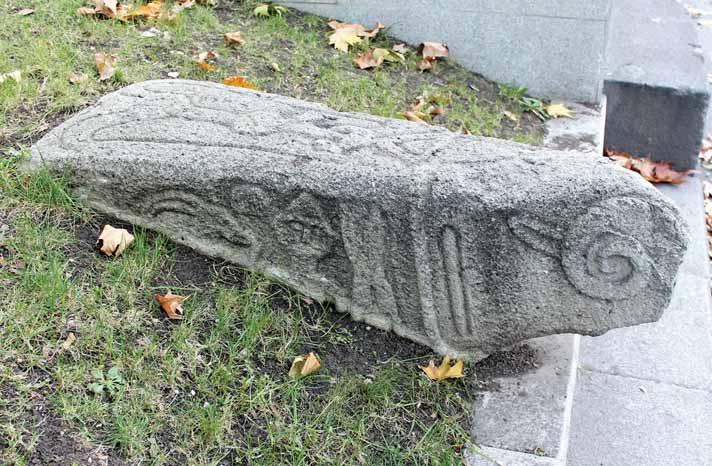
28
A gravestone with a depiction of a bow and arro
A gravestone with a depiction of a plough
A sculpture of a ram
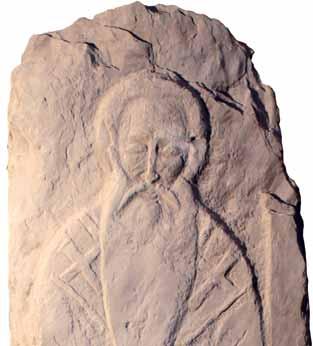




29
The Crypt of Bishop Parthenoz of Kharchashani.
th century
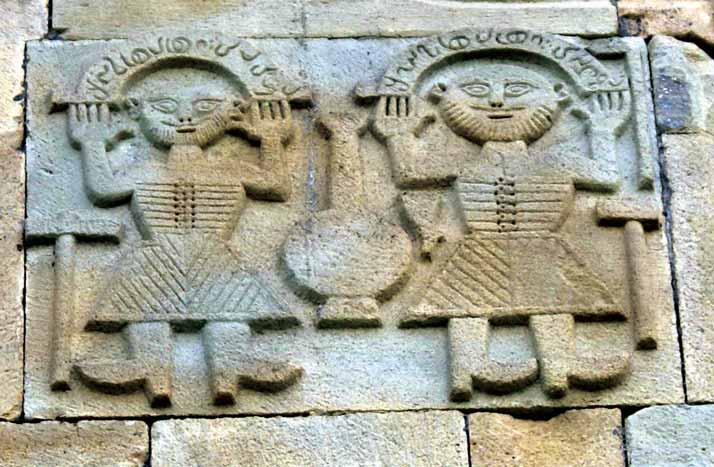


30


31
A gravestone with a lily ornament
A relief composition portraying three men


32
A gravestone with a depiction of a wine jar
A gravestone with a scene of a feast
a
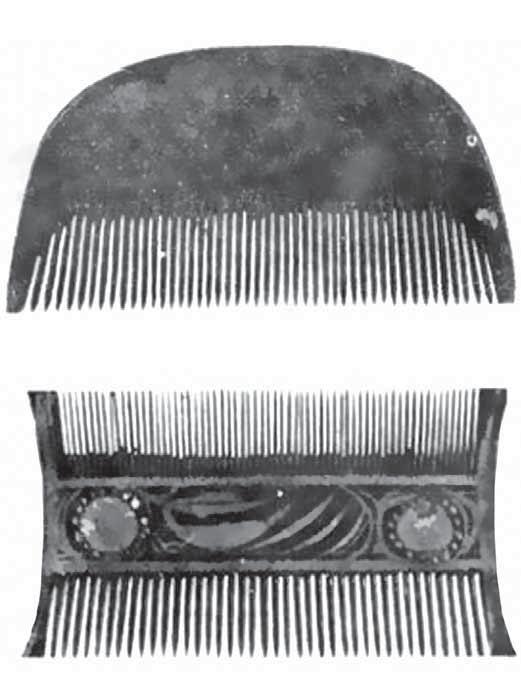
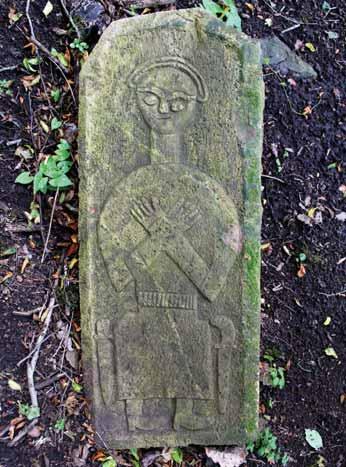


33
a depiction of a man with his arms crossed over his chest
relief depiction of a man with his arms crossed over his chest




34
a comb and A gravestone depicting a set table
A relief composition of a gravestone depicting a man with a weapon and a horse


35
A man with a wine jug
Men with weapons and a horse
A hunting scene


36
A gravestone with a composition of a set table




37
A gravestone with the
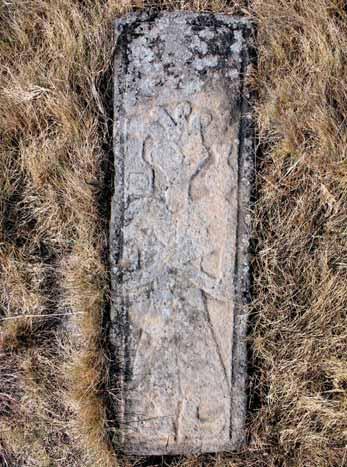


38
A tomb chest with a depiction of a man
A tomb chest with a relief depiction of a man
The composition of The Glory of the Lord
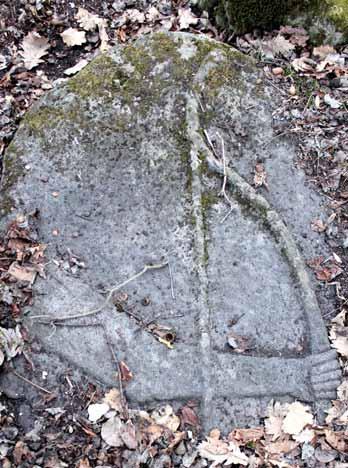
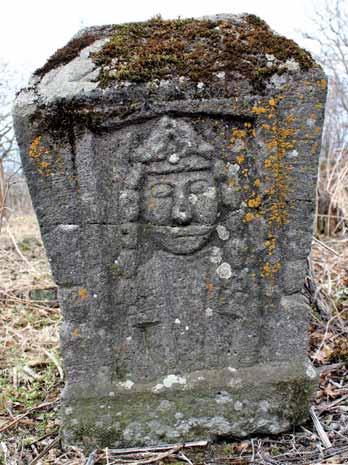

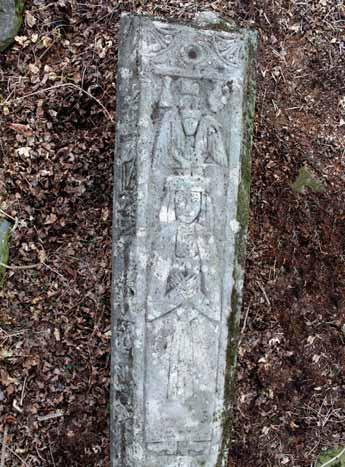
39
a depiction of a warrior’s arm with a bow and arrow
A depiction of a woman from the chest up
A depiction of a man from the chest up
A tomb chest with depictions of a woman and an angel



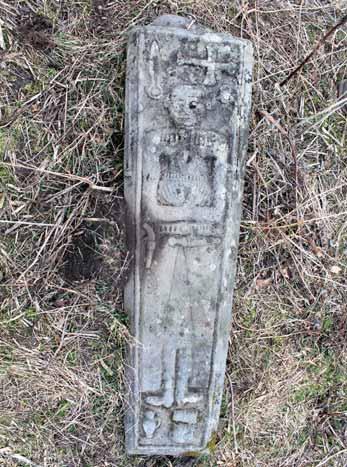
40
tomb chest with a depiction of a woman and her weaving tools. Detail A tomb chest with a depiction of a woman and her weaving tools
A woman with an infant dressed in chokha-akhalukhi with a belt and dagger, and a military weapon



41
A haut-relief depiction of a lamb on the side facet of the tomb
A haut-relief depiction of a horse on the side facet of the tomb The tomb with
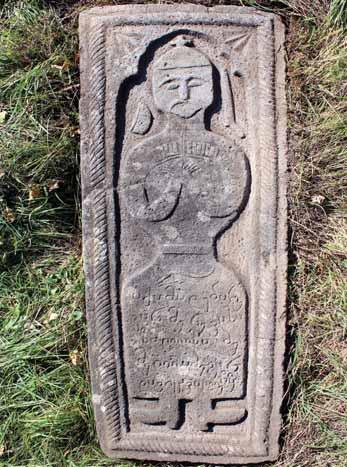



42
A tomb chest with a depiction of a young man
A young man with
A gravestone with a woman wearing a crown
A gravestone with a woman wearing a crown



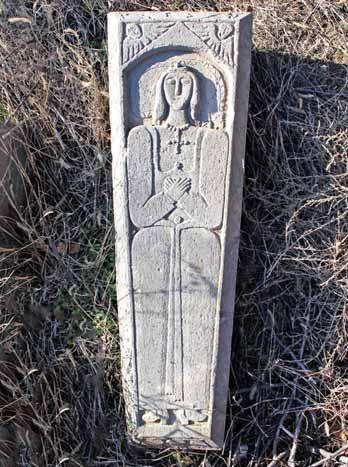
43
A woman dressed in European clothes
A woman dressed in European clothes
A woman with a chikhtikopi headdress
A woman in her wedding dress

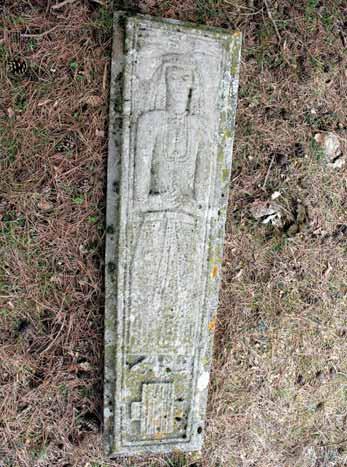
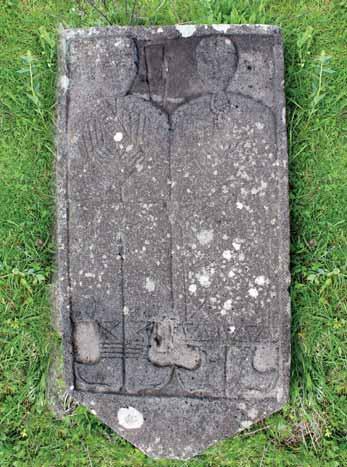
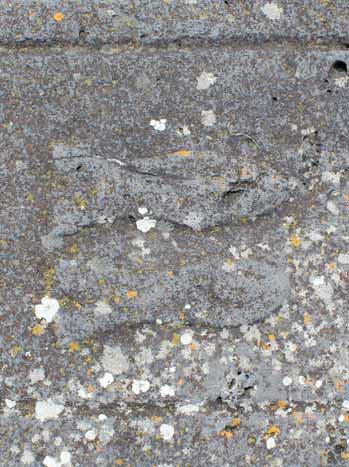
44
A gravestone with a depiction of a man depictions of a woman, loom and weaving tools
A tomb chest with depictions of two men
A gravestone with depictions of fishes

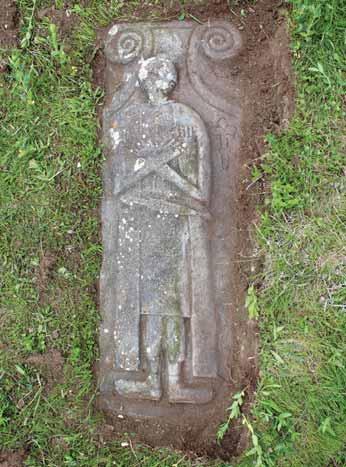

45
A tomb chest with
A gravestone with a depiction of a man
A gravestone with

46


47
A decorated gravestone
A gravestone with a depiction of a horse

48
A man holding a drinking horn at a set table.

49
A woman holding a mirror and an umbrella

50
A gravestone with relief depictions of a horse and a ram


51
A gravestone with relief depictions of a deer and a ram
A gravestone with relief depictions of a deer and a ram

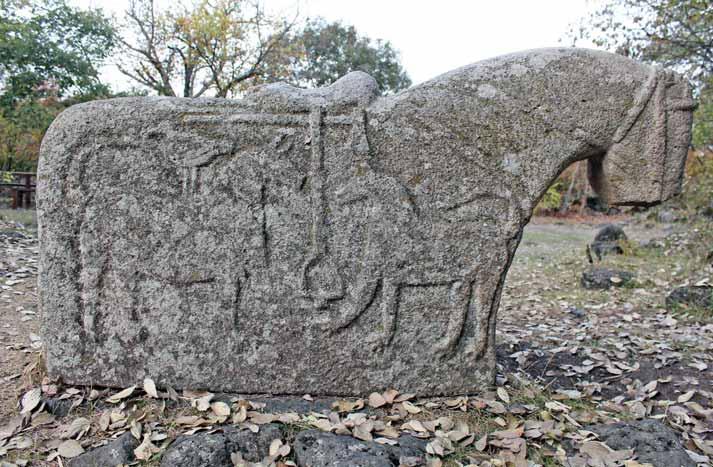
52
A sculpture of a horse with carved depictions of a human being, military weapons and household tools
A sculpture of a horse with relief depictions of animals




53
A sculpture of a ram with a relief depiction of a human being with arms crossed over the chest
A gravestone with depictions of a human being and a lion
A memorial monument with a relief composition displaying a man with a cross, a lion and a rider on a horseback


54
A sculpture of a ram with a depiction of a human being
A sculpture of a horse



55
A tomb chest with the depictions of a man and a plough A tomb chest with the depictions of a human being and stars
A tomb chest with a depiction of a plough with the bulls attached to it
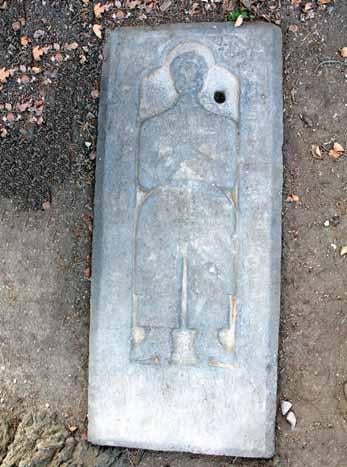


56
A tomb chest with a relief depiction of a man A woman in her wedding gown
A sculpture of a saddled horse

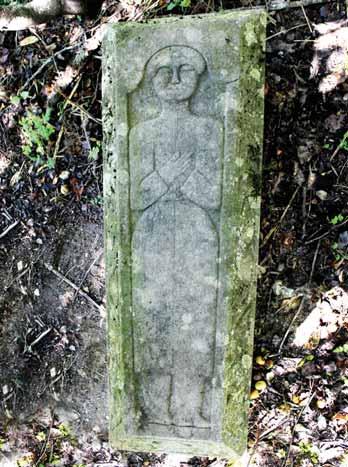


57
A bride with a wedding crown the depiction of a man with his arms crossed over his chest
A gravestone with a relief depiction of a man A tomb chest with the depiction of a woman


58
A gravestone with a relief depiction of a man equipped with military weapons
Relief depictions of a man and a ram on the side facet of the tomb
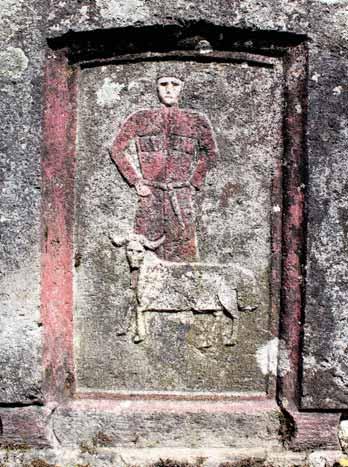



59
a man and a ram on the side facet of the tomb
A gravestone with a relief depiction of a seated woman
A relief depiction of a woman sitting at a table Relief depictions of a man and a ram

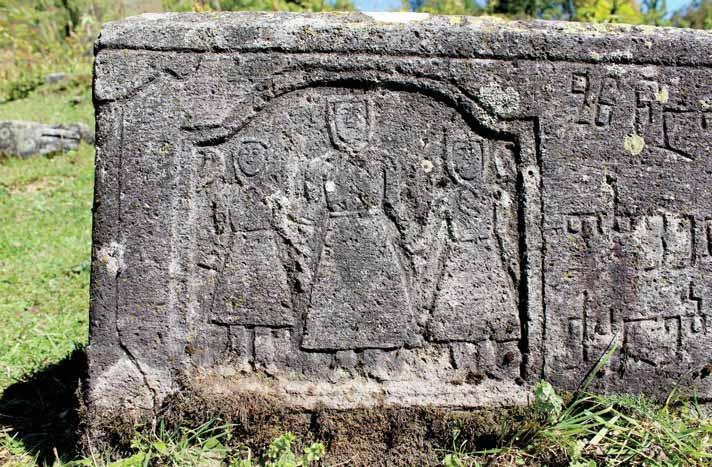
60
A man with a bridled ram
A woman with her daughters



61
A woman at a spinning wheel
A depiction of a husband and wife
A woman with a travel bag and an umbrella
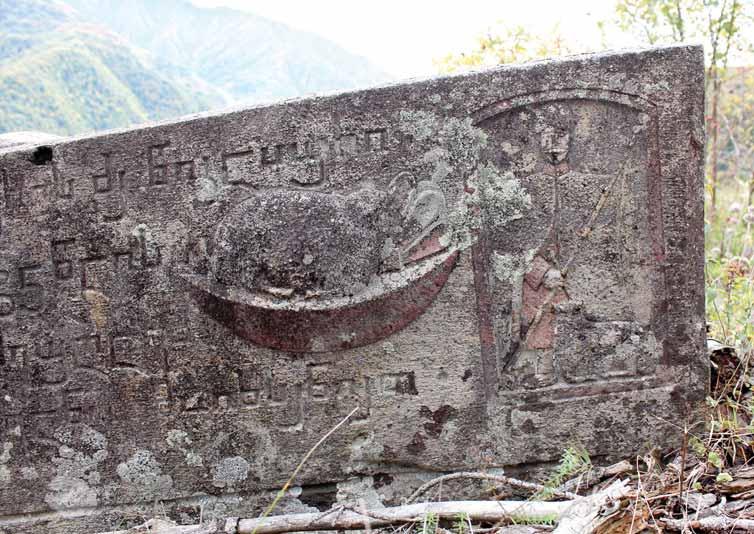

62
A lamb on a paten and a man dressed in a felt cloak by a sheep
A depiction of a man surrounded by doves. Detail



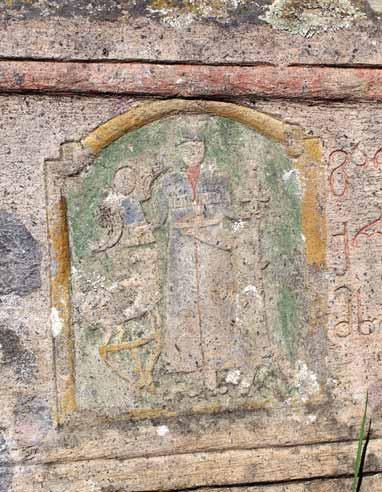
63
A man with a belt and dagger, a bull and a ploughshare A relief depiction of a man and a ram
A lamb on a paten a cross and an angel, a ram on a paten


64
Lambs on a paten
A lamb on a paten and a man
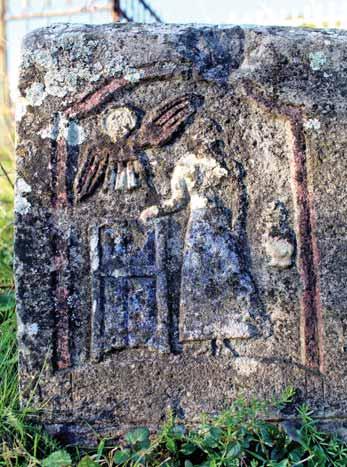


65
A woman at a loom, a relief depiction of an angel
A woman holding an umbrella by a loom
A depiction of a woman sitting at the table


66
A relief depiction of a man standing by a table
A gravestone with depictions of a mother and her child



67
A tomb chest with a depiction of a man
A gravestone with depictions of a mother and her child
A gravestone with



68
a relief depiction of the scene called St George’s Miracle of the city of Lasia
Relief depictions of a lamb and an angel
A gravestone with depictions of a cross, angels and rams


69
A haut-relief sculpture of a lamb
A haut-relief depiction of a lamb

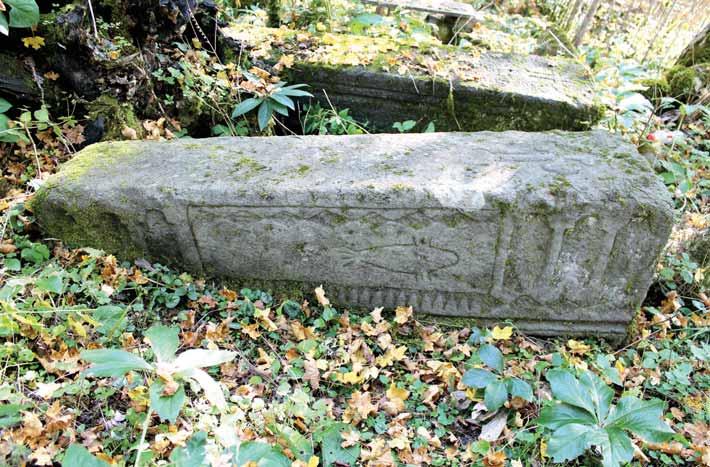

70
a man with his arms crossed over his chest
A depiction of a fish on a gravestone
Gravestone décor. Detail



71
relief compositions depicting shawm players and a man at the table holding a drinking horn
A gravestone displaying depictions of three men
a depiction of a man with his arms crossed over his chest


72
A sculpture of a saddled horse
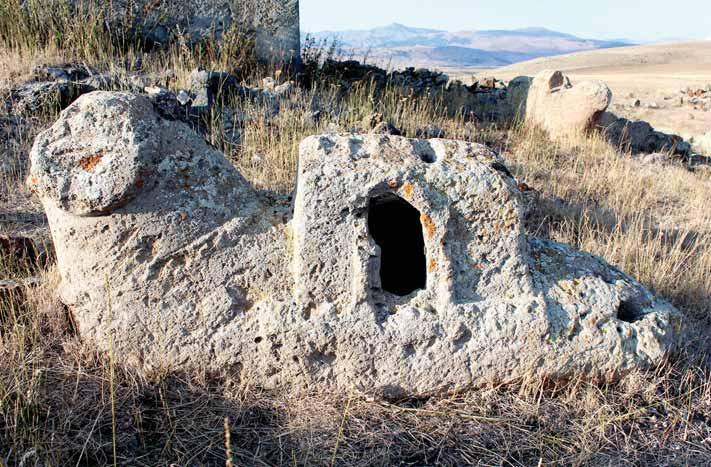

73
A sculpture of a ram with a Church model on its back
A sculpture of a horse with a depiction of a musician



74
A tomb chest with a depiction of a human being
The décor of a tomb chest
A tomb chest with a depiction of a human being
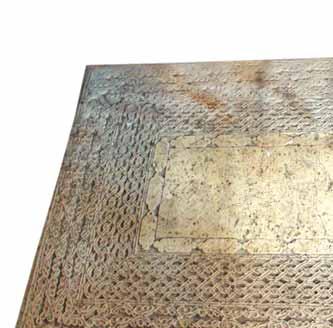




75
The gravestone of Rostom, the Duke of Racha
Gravestone. An angel holding the Gospel A gravestone with a haut-relief depiction of a young woman

76
A gravestone with a floral decor

77
A gravestone displaying the depictions of a man with a moustache, a woman with a chikhtikopi headdress, and a young man



78
A gravestone with a haut-relief depiction of a human head
A gravestone with a haut-relief depiction of a human head
A cross on a gravestone with depictions of two people from the chests up

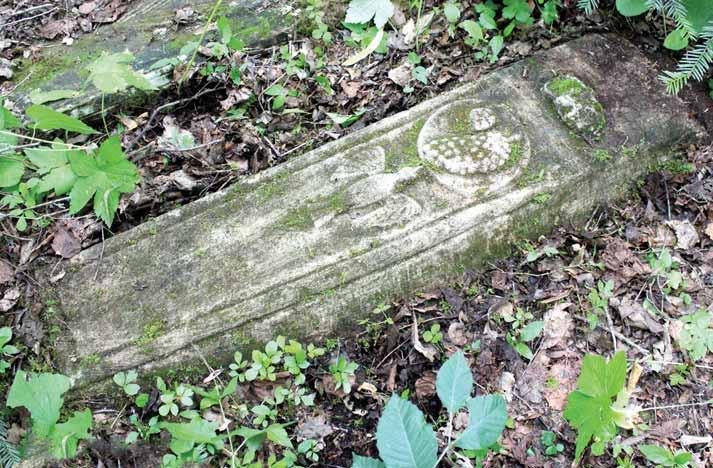

79
A gravestone with a depiction of a man with his arms akimbo
A gravestone with depictions of a dove, grapes and prosphora
A cross on a gravestone with a relief depiction of an angel



80
holding a censer and a scroll, depictions of a lamb and a skull
The gravestone of Giorgi Inasaridze
A gravestone with a Neo-Baroque style décor




81
A gravestone with a female figure
A gravestone with a half-length depiction of a woman
A gravestone with depictions of floral ornaments, a dove and borjgali



82
A gravestone with depictions of a cross, angels and lambs
A gravestone with a relief depiction of a man standing
A gravestone with a floral ornament


83
A gravestone with a haut-relief depiction of a woman and a floral décor

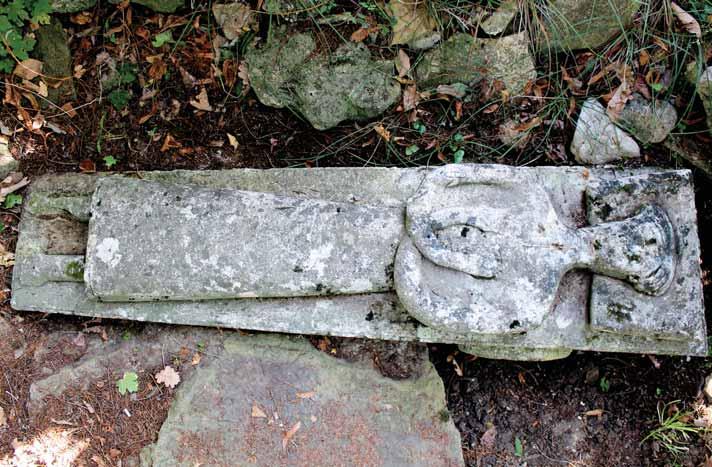
84
A gravestone with depictions of a cross, angels and lambs
A gravestone with a haut-relief depiction of a man

85
The depiction of an angel on a cruciform headstone



86
A gravestone with depictions of a weeping angel and the departed person
A gravestone with relief depictions of fishes The depiction of burial rite




87
A tomb chest with depictions of a cross and angels A memorial monument with depictions of a cross and angels
A gravestone with a haut-relief depiction of a man and a floral décor
 161. Khizabavra. Grave monument
SAMSON LEJAVA
161. Khizabavra. Grave monument
SAMSON LEJAVA
THE GRAVESTONE - AN EXPRESSION OF GEORGIAN CULTURAL WORLDVIEW
distinguished by its multi-functionality, specific structure, and its manifold ideology. terms of shape formation, gravestones are minimalistic thanks to their condensed figurative representation: has no definite pattern; it is intensive and grants monumentality to the pieces of work. Two principles arecholy caused by the transitory nature of this world and a heartbroken tone of voice may be heard in some
Although the complaints about the imperfection of this world are obvious (echoing the views of
inhabiting the eternal kingdom after death. The life adventures of all people including the distinguished and the common ones are told briefly.
Visual suggestions, which grasp the essence of things, gain special meaning in the artistic structure ofnaturalistic resemblance of the usual appearance of things may be pointing to an even deeper perception
The world of gravestones cannot tolerate falsehood, ambition, fake pathos, and meaninglessness of presentation. In all its sincerity, it tries to convey the idea of standing in front of God and employs the spectator in a dialogue with one another . The departed talks to us from the other world and even asks for
per se means conservation of the body until the second coming of Christ.
The anthropomorphic archetypal character of depictions, which places them above portraits, and their procession from their first parents, Adam and Eve, are essential. The silence reigning over them bears the
show details, although there are some particular elements, such as their clothing and accessories, which demonstrate the belonging of the depicted people to a certain class or subculture. However, their general humanity outweighs it.
Gravestones also carry a dividing character. They present a certain gate, or a crossroad, a point of intersection, where the worldly and eternal meet.
As is illustrated in the famous short film The Resurrection by Goderdzi Chokheli that presents the world of memorial gravestones in Mtiuleti.
89
A general likeness of the departed is often depicted with a moderate concretization on the main surface of the tomb. Like the old Egyptian images, the face and body are shown frontally, while the arms are is rhythmically well balanced and perfectly centred.
The anthropomorphic aspect, which involves the depiction of the human head, arms, body, and legs, is
, reminding us of the old church reliefs where the gaze which radiates the inner faith in the salvation of the departed. The ones who moved to the other world beg forgiveness from the ones who are left in this world, which suggests that it will be considered a charity on part of the inhabitants of this world if they remember the ones who have passed away and say a prayer for their souls.
The laconicism of depictions manifests the simplicity and uncomplicatedness of the master of gravestones as a person of few words; Even the epitaphs are marked with the same attitude: their laconicism is almost isomorphic to the structure of pictorial depictions. Gravestones display a strange blend of
Although it is also part of oral folklore . We also see a difference here: while the content of depictions is essentially detached from the worldly realm, the epitaphs tend to describe the bitterness of the world who see it, grant your forgiveness. You, wretched death, set a trap for me at such an early age, separated me from this world, I was buried here and left behind my home full of tears, I am buried with bitterness, I Farewell, my parents, who grant me forgiveness, I am going to heaven to face the heavenly King, theyare not only considered constant companions of human beings, but they have a much deeper function: the reference is made to who we are dealing with; it portrays the person to whom the final respect is paid: such are the representatives of either upper or working classes: they are all made equal before God! Such are the ploughman and the shepherd, warrior and a craftsman (smith, stonemason, potter, carpenKinto, Karachogeli, so-
E. Chelidze, The Sign of the Life of Kartli, , Literatura da Khelovneba,
90
.
Indeed, the display of professional tools often sheds light on the profession of the departed, but here we need to clarify one thing: depictions of dishware such as a cup or a jug do not necessarily mean that the departed was a potter; or when we see a sheep, it does not necessarily follow that we must be standing by the tomb of a shepherd, because it may, first of all, mean a sacrificial lamb. Therefore, it is thus avoiding superficial conclusions
It is the haven for the departed with its apotropaic style décor. The anthropomorphic depictions which often cover almost the whole surface of tombs undoubtedly dominate the area and thus attract special attention. As about the ones on side facets (which may beciple of relief carving seems to dominate. Using the relatively simple, yet attractive means of depiction, The depictions of animals, unlike the representations of anthropomorphic images, at least sometimessimplicity also offers its way of creating a sense of wholeness ultimately outweighing the preoccupationple the enlarged head, focus on accentuated eyes, or the emphasis on the gaze charged with divine spark,
Proportions of depictions are sometimes relative, the other times shortened or elongated in a stylized completing one another.
Ornament as a frame introduces a sense of order. It is generally accepted that the meaning of floral décor is linked with the ideas of eternal life and resurrection claiming a place in paradise.
The epitaphs sometimes follow the Mkhedruli script of the manuscripts dated to the late feudal period, over the unfairness of this world which find even richer analogies in Georgian literary works. Their poet(One to the shape of the tree of life; the images of the sacrificial lamb and a bull are undoubtedly loaded with
91
A. Shanshiashvili, The Personality Types of Old Tbilisi and the Contemporary Portraits, Historical Tbilisi, Cultural Aspects,
E. Nadiradze, The Memorial Culture of Georgia,
of guardian angels are appropriately depicted in right places: the pictorial reference to Golgotha is also worth noting. We should pay attention to the dome-like sacralised outline, suggesting heaven, also the
perceivable and charged with shared desire, while the astral figures point to enlightenment and divine -
. Thanks to similar depictions the departed are no longer considered left on their own.
The stonemason is not only a conveyer of this symbolism, but he is familiar with the fundamental Christian semantics, as a churchgoer and a receiver of Holy Communion. After all, the ones resting here
nostalgia is a distinguishing feature precisely of the German Enlightenment and the thought of Schelling in classical German philosophy with its kinship to Romanticism . However, this strong Christian tradition in Georgia is not only retained but also demonstrated in gravestones with all its fresh nuances and it th century when Georgia lost its independence and the autocephaly of its church wasological spirit of unblemished Christianity manifests its utter purity.
There is no doubt that the Georgian clergy, according to E. Nadiradze did their best to make sure that the faithful would not forget the fundamental image of the authentic world. Even the sermons of Bishop Gabriel Kikodze are of immense importance in this regard. However, first of all, it is important that much in the process of revival in the church life was preserved not by the art fabricated by the Russian Empire but by the authentic folk Georgian art so that it manifested a living creative openness while encountering various novelties. th th century were obstructed by the vulgar and low-grade Communist Regime, which proved to be oppressive to cultural values. Ultimately it is gravestones that stood as guardians of our centuries-long Christian tradition in the corners
It is noteworthy that in terms of portrait scale, in these monuments we often see architectural elements carved across the surfaces. The décor of church architecture and epitaphs are in many ways similares and ornaments on gravestones occupy a large area of the tomb, the reliefs or ornaments in church architecture are concentrated at important points. The ornament on gravestones also becomes significantly simplified, although it still retains the major signs of the church’s architectural décor.
Besides, while the church reliefs display Jesus Christ, the Mother of God and the company of saints with ktetorsportant as the ones who share and follow the Christian teaching. They are perceived as imitators of saints
92
J. Burduli, The Gravestones of Mtiuleti Region, MA Dissertation, A. Kutateladze Tbilisi State Academy of Arts, Tbilisi, Matsne,
despite the accompanying display of items from their daily worldly lives. Therefore, a certain reflection of
The methods of applying depictions to the surface are rather specific. The surface here is like a ground formation and permeates all depictions. The church relief, first of all, grows out of the surface; it is carved but is still an inseparable part of the wall; in its broader meaning, it is an inseparable part of the sculptural body turned into the model of the world of the church – only in relativity, it is autonomous.
The depictions of gravestones are absorbed into the bosom of the tomb. They are legible but on the account of the substantiality of the principal stone. The primary material of the stone itself is abundantly as a soil-like source or a begetter of all things. On the whole, the depictions arise from the bosom of the stone.
In the end, such a paradigm flows from the Christian vision, for which human being is the most impor-
One has to highlight also that in our reality church buildings also create an impression as if they are grown out of the earth. The unquestionable evidence for this is the monastery of the Holy Cross in Mtskheta which crowns and connects the energy of the mountain as axis mundi. In the painting by Tengiz Mirzashvili Meskheti Landscape the whole body of the church seems like an essential part of the earth in its pictorial presentation . According to this vision, the sandstone of the church building seems to be transforming into a metaphor for earth . The whole paradigm essentially carries the biblical meaning and applies to the archetype of Adam.
Such a deep meaning is undoubtedly observed among the gravestones, which share the spirit of church architecture and Early Christian stelae .
It is essential that in the depictions on gravestones the passing of this world (indeed the gravestones do not escape entropy, the damage caused by time and natural disasters, and the transient nature of this separation from one another but encounter and agreement. linear formation of the fundamentally untouchable whole surface when the continuity of the surface ishaut-relief carving with its occasion-
It should be added, that in all the five approaches, the simplified schematism makes unquestionablethe church of Sapara monastery displayed with an almost classical order, in which the depictions, most
93
ACADEMIA
by great diversity beginning from the conventional minimalistic signs to the well-built depictions using harmonious and elegant proportions. However, the main thing is that the sustained worldview of the spiritually pure and clinging to the Truth is crucial to this diversity.
On the whole, it becomes clear that both the figurative depictions of tombstones and the decoration reveal the deep connection to the church decoration and the placing of semantic accents on it through various rules of formation of shapes. It is true that in the gravestones of the later period we may observe -
the body outlined as a parallelepiped or triangle, arms crossed over one’s chest are depicted as stylized strip-like forms. Throughout such conventionalism, separate features gain their recognizability only in . The feet of the departed are often depicted either pointing outward from the centre or they are both put in a lateral or handed down to us from the Sasanian Iran. Such diffusionism is not secure either, since even the children’s paintings can show similar generalized forms, which certainly proves the archetypal nature of the images, the ones with open eyes remind us of the figures from the ancient East (e. g., Sumerian sculp.
A certain anti-gravitational impression links these figures with the Middle Ages, yet here they are reliefs are somehow relevant, but even then, their stability is prevalent. The feeling of the super-cosmic atmosphere is increased by the images of angels in the scenes presented on the other side of the torso: they are more pictorial and demonstrate the feeling of rising above the quotidian reality as crucial (Fig. who discerned their connection with the ancient Eastern culture . He seems to be referring to ancientness with medieval works of art (in our times it is possible to speak about the late feudal period or even
It is noteworthy to mention the visual techniques, attractive for their affordable simplicity and outweighs the complication of the primary configurations, as pointed out by G. Khoshtaria about N. Pirosmanashvili
Tsiskari, ACADEMIA
V. Kotetishvili, Georgian Folk Poetry, I. Khuskivadze, The Medieval “Folk” Mural Paintings of Georgian Churches,
94
balance. The general outlines of the features which look like a nose, lip and eye, are almost anonymous and carry the element of shared humanity. However, at the same time, full of concrete ingenuity, effective liveliness and is artistically intense.pectedness, but it must be emphasized that the above-mentioned is realized in the inner space of solid,perfectly creative and constantly thinks of the quality, which he takes with great responsibility. Here too,
In this approach (where the age and hierarchical differences are not particularly emphasized, and the the diversification and innovation within the canonical norms. It is also important to note how credibly the craftsmen manage to convey the essential features through non-mimetic or less mimetic means of
The world of gravestones is ultimately considered autonomous not only about the sacred art. It has th th cc. First of all, here we must remember the repertoire of the décor-like ornamentation, which makes us think of the significanttic system. Gravestones are individual, but by many typical features, they are closely linked (technique . In a broader sense, certain elements in its décor, especially the astral figures remind us of monumental central pillars , traditional furniture and the decorative motifs of a Colchian Oda The resemblance of the figures to the figurative, stain-like depictions on a blue table cover design is noteworthy, although they are even more refined and purified . Despite its urban character, the blue table cover is very close
. An indirect kinship with the ornaments of old-fashioned carpets can not be denied either – especially when it comes to the border frames surrounding the tombs.
th th , Essays on Georgian History, Ancient
95
Art Today, S. Lezhava, M. Kiladze, K. Giorgobiani, Colchian Oda-Houses in Racha, N. Brailashvili, The Blue Table Covers, Essays of the Georgian National Museum of Fine Arts,
The décor of an oda-housealization of silhouettes is observed in them analogically to gravestones, seen in the motifs of a ram, deer, bird and the tree of life, which like the central pillar is distinguished by focusing on what is fundamental.
There is no doubt that special similarity is discerned in the stonework and decorative content of stone fireplaces . Here too the motifs of the tree of life pointing towards both the zoomorphic and higher realms provide the same ground for them. Besides, it is acknowledged that a fireplace absorbs and trans-
heaven, which is a perfectly recognizable motif among the gravestone images. Both of them address the cleansing elements such as fire and water. The element of earth is depicted more often in gravestones, while the air guides the transparent tracery of the oda-house. It feels like the whole cosmos is united with the interconnectedness of these primordial elements found in the above-listed manifestations of spiritual culture.
Here we should single out one aspect: while a person living inside the hall based on the threefold unity of the hearth-pillar-crown, never forgot and even longed for the space of the paradise lost, the departed, in a semantic sense, is finally perceived as protected within the similarly sacral space of the tombs. This means that the quest for the divine realm was simply crucial in our culture both in this world and the world beyond.
In this respect we must consider the note made by Longinoz Sumbadze about the single root for the two versions of the three-step crown-like roofs in the highlands of Georgia: in particular, he referred to the roofing system for sacred sepulchres and places of worship and the crown roofing system for hall
the higher realm, which contains the same meaning, as the crowning arches. Therefore, it becomes clear that both in the crown and arched shapes on gravestones, we can observe at least an indirect confirmation for Giorgi Chubinashvili’s profound theory regarding the archetypal connection between the darbazi
Astral and solar motifs posed to be the most important for gravestones as well as for rural folk the material and tangible roughness of earth. The cosmographic motifs already introduce the super-material, almost a plasm energy, which manifests in the gracefulness of the central pillar, in the rays coming through the tracery on the balcony of the oda-house, in the peculiar mystical radiance emanating from brought about by the transforming power of décor, while the particular and sensual side is not neglected either. Material and spiritual are often bound together, and so are the dwellers of the earth and the world
central pillar of which shows the same minimalism analogous to that of the old desks and ritual dollstions made by I. Surguadze are interesting . We should add here that the human being itself, which is the crown of the universe, carries a special status – it is created as a bridge, a binder, a mediator between two worlds. It is also essential that the gravestones manifest full equality between women and men (which follows the Christian tradition of The Knight in the Panther’s Skin), in other words, the gravestones are undoubtedly fundamentally Christian.
Materials for Studying the Ethnography of Lechkhumi, N. Ghoghoberidze, The Catalogue of Georgian Dolls, I. Surguladze, The Symbolism of Traditional Georgian Ornament,
96
its breathing surface and adjustment to the space is presented in such a way that it never disappears even under the tinted areas and responds to the general sense of levitation. Here the contrast of light and shade increases on the surface and according to V. Beridze, it reflects the non-rigorism of Georgian architecture. The element of earth as a source of life and at the same time the container for the body after one’s death is a surprisingly capacious and trustworthy phenomenon. It is precisely the earth, the concept of which emerges into the worldview of Georgians at least from the culture of Shulaveri Gora
phenomenon is perceived as a shelter and resting place for the departed. In some epitaphs, you may en-
the sacrificial ritual for the productiveness of the earth discovered by G. Chitaia .
The cult of the ancestors is replaced by the custom of respecting their memory in the gravestones of
It is also without question, that the vast world of gravestones is also permeated with a mystical mood along with authentic simplicity. They combine honesty with mysteriousness; sincerity with enigmatic character; accessibility with remoteness; being here with being transformed and passed away; closeness with distance, which contains a positive, yet moderate tension.
The world of gravestones leads one to think about the vanity of this world and the meaning of life. They are also characterized by a sense of timelessness. Besides, gravestones are also distinguished by multidimensional perception. They can convey one’s biography in a compact and condensed presentation.
If we broaden the areal of problems, we shall see that gravestones can guide us throughout the history, as a single link in a chain of generations. Besides, it also offers a type of theology revealed through its visual and material form, by which it becomes a continuation of the iconic art of the church.
The very laconic and monumental images of the relatively early, but developed feudal era, studied selected precisely and clearly in a purposeful, differently projected form can accommodate almost com-
The independent sculptures of rams and horses, despite them being adopted into our culture, first of all, project Christian symbolism; Moreover, the figures displayed on them resemble church reliefs and sharing the view of Eldar Nadiradze. Here we should add that while the figures of horses look like they are double-sided reliefs, because the plasticity of the horse is not evident from the front at all, we cannot say the same about the sculptures of rams, the heads and horns of which are plastically accentuated. According to Eldar Nadiradze, the ultimate simplicity of the form reveals within the unity of the wholetian eras we have countless diverse depictions of rams. This tradition as manifest in the gravestones of modern times continued rather specifically and it highlights the theme of the sacrificial lamb. As for the depiction of a horse: in this respect too, our tradition is fairly strong. It is considered that the importance of a horse-rider is especially prevalent in the interior house décor in Svaneti, where the depictions of
97
O. Japaridze, A. Javakhishvili, The Culture of The Earliest Agricultural Population on the Georgian Territory, The Bulletin of the Georgian National Museum, ”, Dzeglis Megobari,
to Shalva Amiranashvili , we may see in these depictions a remote reflection of Mithraism. The tradition of horse races dedicated to the cult of the departed is also reflected in the old traditions of Georgian
It is also worth considering how the sculptural shape later replaced the gravestones with flat surfaces
standing in real space, but, as E. Nadiradze notes, sometimes they look like standing reliefs because the frontal perception is still prevalent. Most of them still reveal sculptural steadiness (including a certainform, in terms of plasticity; it may be slightly conservative, yet, it is a result of essential inner movements
The name of the outstanding master Ioakob Nikoladze should be mentioned, there is no doubt that he European sculpture in Russia, and later he studied at the workshop of August Rodin.
And yet, is it possible to observe any similarity between the traditional gravestones and the art of Ioit may be possible. Ioakob Nikoladze’s Grieving Georgia according to his student, Vakhtang Kotetishvili, is eclectic. Indeed, the principles of French memorial sculpture strongly affected by individualism do not coincide with the earnest allusions to Georgian church architecture (while eclecticism is alien to the infact that the relation to churchiness in the art of Ioakob Nikoladze is perceived in terms of a haven in his not be forgotten that relief, as an artform, proved to be the closest for Iakob that found a reflection in his theoretical legacy . We already highlighted the principal feature of gravestones – the quality of their church-likeness.
the tombs at Vake cemetery is presented in the form of the church (including a niche decorated with festhe church as decisive remains intact.
Indeed, the Russian Empire did its best before the Russian revolution to forcefully replace our church traditions and our sense of freedom with the Ober-Procurator’s ideology, but the complete profanation of Empire. However, the violent Communist government tried to undermine the importance of the church in Tumanishvili, proved to be the backbone of Georgian culture.
Sh. Amiranashvili, The History of Georgian Art, bas-relief Sabchota Khelovneba,
98
humility, although gradually kitsch-like elements started infiltrating it. It was only the ornament that tried to retain its rather impoverished and unilateral role in Georgian cultural heritage for a long time under the Soviet regime.
Since the Tzar’s Russia it was not the stone more organic to our aesthetics, but the wealthier looking marble, which gradually became widespread, especially in church interiors (such as Kashveti church used by the aristocracy and clergy. The practice of depicting the coat of arms on them referred to their unblemished nobility, and bilingual inscriptions on the stones were also common. They had a modest appearance compared with the later ones made in Soviet times, which looked more ambitious, pompous and vulgar.
the movie Extraordinary Exhibition. The systematic order of traditional modest-looking gravestones was soon replaced by framed photographs on graves, and a great deal of diversity was developing gradually. foreigners, thanks to their vast financial resources created massive and decorated sepulchres, claiming pseudo-immortality, and sometimes carrying a seal of gigantomaniaagus of a merchant of the first guild Arshak Minaevich Girgidov mentioned by M. Javakhishvili. In Soviet-era, however, his name was introduced into the space of trade by M. Javakhishvili’s novel Givi Shaduri
David Turashvili’s novel The Jeans Generation claims that in the times when land ownership was taken away from Georgians, the pseudo-monumental marble tombs gave to Georgians an illusion makof the people who sought monasticism as is revealed in the memorial inscription on the tomb of David
Naturally, epitaph culture went through a gradual, although inevitable decline followed by its ultimatevakhishvili’s novel Givi Shaduri is still enormously interesting. The protagonist of the novel turned into an traditional rite of blessing. However, he still has not forgotten the myrrh of a dove or the grace of a lamb.
This was followed by an infiltration of similar declining tendencies in the fretwork of Colchian oda as well as in decorations of fireplaces, in the chonguriand even in gravestones virally taken over by the images of replaced by the vulgar pseudo-democracy of the proletariat. This reminds us of the establishment of the cult of Stalin and Beria in the highly acclaimed traditional polyphonic songs ultimately resulting in the fundamental defilement of musical polyphony: degeneration of each sphere in our culture is bound to affect the others, which are fundamentally linked to one another. We should also confess that even before the Revolution not only the Bolsheviks but even the much more tolerant Social Democrats including Chola Lomtatidze as honourable as he was, unfortunately, contributed to the creation of a comfortable atmosphere for holding people in captivity by aggressive proletarian ideology. However, Chola Lomtatidze outstanding thinker, undoubtedly a Christian at his heart, yet failing to grasp the essence of Christianity
99
because of his generally critical and sceptical attitude. Such approaches were the signs of turning away from the way paved by Ilia Chavchavadze. trust in the new political doctrine yielded with incredible naivety and prevailed among the intellectual circles and maybe even among common people, who gradually demonstrated almost infantile belief in these worldly failing to demonstrate any criticism against political demagogy. Loyalty to essential Christian teaching became more and more forgotten and its profound -
men, professional artists, sculptors and architects tried to grant certain symbolism to memorial monuments, which were no longer all-embracing. The former profound correctness emphasizing universal relion personal virtue and social standing, be it of a scholar, artist, public figure, etc. the genial simplicity of the poet; Akaki Tsereteli’s memorial made by David Kakabadze with admirable a direct link to although still related to the tradition, was created by Giorgi Ochiauri who managed to march the general and essential features of old gravestones with the vision of a contemporary artist. The author presented the brave spirit of Guram Rcheulishvili as immensely profound.
The tradition of making gravestones counts many centuries, although the ones produced in modern th th the signs of spiritualized art typical to the Middle Ages both in the form and in general worldview, on the other hand, through certain features they join the features typical to modernity to that of the traditional ones. Novelty in them is sometimes revealed slightly and the other times it is more obvious, however, the point is that gravestones respond to the challenges of modernity with their unblemished adequacy. Many features of gravestones contained a great potential for new creative findings in the future and carried the
The similarity of gravestones to the art of Niko Pirosmanashvili is very important and considerable, which was first noted by Niko Berdzenishvili . Outside the more retail space, it was precisely gravestones, in which he saw the resemblance to Pirosmanashvili’s art. It is commonly accepted that Pirosmanashvili’s art agrees with material and visual folklore and even more with gravestones. However, the essential differences need to be highlighted: the individual anonymous stonemasons either in terms of their worldviews or their skills cannot be equalled to Pirosmanashvili’s capacity for containing the Georgian identity, however, this does not apply to the phenomenon of gravestone per se. Pirosmanashvili is highly distinguished in this respect, but at the same time, he is by no means an individualist, since he is focused on the universality of his nation, which, in the words of Shalva Amiranashvili, he conveys withrepresentations of rams, almost the size of the Golden Fleece; powerful super monumental lions, bulls, and elevated feeling governing the atmosphere of gravestone decorations. -
Capacity for simplicity and authenticity and so on. Observation of all these features convinces us that the N.
100
Berdzenishvili, Issues in Georgian History,
broad world of folk art was even more native and precious for Nikala because he carried similar features in himself .sion, openness and sincerity, non-rationalized profundity, heuristic way of combining elements, espeinnocence and other specific features are shared by both gravestones and Pirosmanashvili’s legacy. The phenomenon of gravestones throughout the whole visual folklore stands the closest to the art of Pirosmanashvili who, as is well-known, used to work together with the members of the Sighnaghi guild of gravestone masons. Here Nikala’s vision embraces the peak of a harsh, relieved and at the same time concentrated, schematic, laconic and intensive monumentalism. The role of the background is essential as the soil from which the figures are born and which sometimes even confluences with them. It is mostSuch earthy background naturally grows into the depictions, only when their structures are fully shown
In this respect, we must add that in its wholeness the large world of gravestones is not inferior to that of the Pirosmanashvili’s and maybe present even greater depths of inner vision. An enormous amount of information is offered about what kind of culture we are dealing with: if we observe the costumes of different classes on the gravestones preserved in Tbilisi, which was a rural area in those days, and also in other cities, it becomes possible to identify and communicate their attribution to different social classes and groups, the vast variety of themes on the gravestones in villages, in particular, say a great deal. Let us firm loyalty say about the non-nomadic agricultural culture – what they say is crucial!
In this sense, an impressively wide panorama confirming the establishment of culture and civilizationonization; stonemasonry or wood carving; armament; transport or technical equipment; a comprehensive
The visual codes of gravestones shed light on although territorially local, also universal creative po-tions find a certain kinship with avant-garde and may even be inspiring for professional avant-garde artwhose traditional relief and gravestones greatly influenced others and as a result of this, he produced a creates an impression as if they have been transformed from gravestones into pictures. In the process of them plays an important role and the graphical presentation of the play of shade and light on the surface . Here we should add that Lado Gudiashvili
Spektri, D. Tumanishvili, Letters, Essays, S. Lezhava, M. Gachechiladze, K. Kintsurashvili, T. Belashvili, Alexandre (Shura) Bandzeladze
101
He presented them in a strangely enigmatic manner (The illustrations of The Tiger and a young fellow by of gravestones conveys a much more and more profound message based on his multi-layered and deep,ities to penetrate the unknown, while the master of gravestones does not seek or strive towards anything, fundamental involvement in constant emergence and establishment of the universal space in culture, he is a conveyer, a carrier and even an identifier of the spiritual vision of one’s own and the world’s culture by disclosing in it what is credible and fundamental.
In this respect, neither can Pirosmanashvili’s art be considered avant-garde painting, although his art inspired ad interested the artists such as Mose Toidze, Ilia Zdanevich, Kirill Zdanevich, David Kakabadze, Lado Gudiashvili, Shalva Kikodze, Mikhail Le Dantu, Larionov, Malevich, and even Picasso.
Giorgi Khoshtaria pointed out that avant-garde painters are certainly familiar with the brave use ofture, however, I should add here that the deformations, unusual and strange elements in their arts indeed of subjectivism, the goal of grasping the essence of the world often slips out of their hands, which makes their way truly agonizing. For Pirosmanashvili, on the other hand, this problem is completely alien. He, as often hardly accessible to even the most outstanding avant-garde artists. The all-embracing picture of hisPirosmanashvili, appear as conveyers of the Christian faith thanks to their refusal to employ some salto mortale or tricky and juggling playfulness. For such a vision all conventions only encourage and secure the fundamental primordial symbolism and, in this case, their use is deliberate, which was emphasized by outstanding scholar Dimitri Tumanishvili.
It is true that in the Post-Soviet period, in terms of gravestone decorations, Christian symbolism was more or less recovered, but due to a big gap, this process is still not fully completed, which requires funpart of professional sculptors, which found a certain shelter in the space of memorial culture.
It is very important, although it poses a different problem that our sculpture scarred by Soviet ideol-her research in this area. It is not a secondary either that David Kakabadze also introduced himself as atradition and silent minimalism – is a recognizable reality for the world of gravestones.
In the end, it still needs to emphasize that the basic feature of medieval relief sculpture is essential for T. Dadiani, E. Kvachatadze, T. Khundadze, Medieval Georgian Sculpture,
102
gists such as S. Bedukadze, V. Bardavelidze and E. Nadiradze . The material contains information about stonemasons including the masters of gravestones such as Iagor, Ivane and Simon Burduli, Maratia and Ioseb Jashiashvili, Sosiko Kurtsikashvili, Sandro Aliashvili, Vakho Melandze, Tato Qerdikashvili, Vakhtang Maisuradze, stonemasons – the families of: the Khuroshvilis, Khechuashvilis, Khizanovs (perhaps formerstonemasons: Kurashvilis, Alavidzes, Mushkudianis, Giorbelidzes, Kibostanidzes, Tvaradzes, Davitulianis. K. Lazaridi was fluent in Georgian, and his father was perfectly familiar with Georgian terminology; Saba in Turkish and not in Greek. It seems that they were called Greeks because their ancestors were Christians. It is considered that maybe it was not a Hellenic group, but some of them might have even been Chanian-Lazians: According to G. Chitaia, the traces of Chanian-Lazian material culture are found in the derives from the ancient Kartvelian population of the black sea coast, the Megrelian and Chanian name the content of terminology and moved it to Hellenic ethnicity. It is also considered that in many parts of th at Georgian art and architecture as their guide, which is credibly evidenced by gravestone ornaments. Therefore, it is without question, that Georgian culture is the organizing and guiding drive in this case as well. works, I met a stonemason from the Burduli family, an elderly master, who mastered profoundly the nuances of Christian culture, the ones, which are illustrated by the symbolism of gravestones.
Materials for the Ethnography of Georgia, Enimkis Moambe, , Shida Kartli (Ethnographic Study), Folk Stonemasonry in Algeti Gorge, Dzeglis Megobari,
103 * * *



104
A depiction of a man on the pedestal of a grave monument The sculpture of an angel on a church model


105
A gravestone with a depiction of a woman
A gravestone with

106



107
A tomb chest with a depiction of a man
A gravestone with architectural décor
A gravestone with relief depictions of a man and a ram
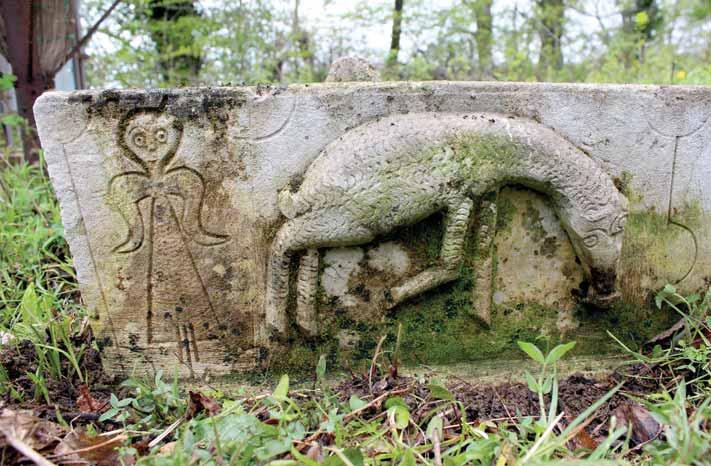

108
A gravestone with depictions of an angel and a ram
A tombstone relief – a man holding a cross in his hand
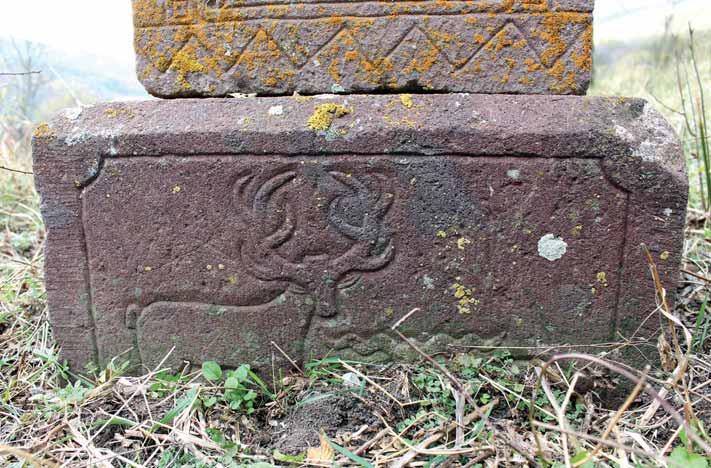

109
The pedestal of a grave monument with depictions of a deer and a ram
A depiction of an angel on a gravestone
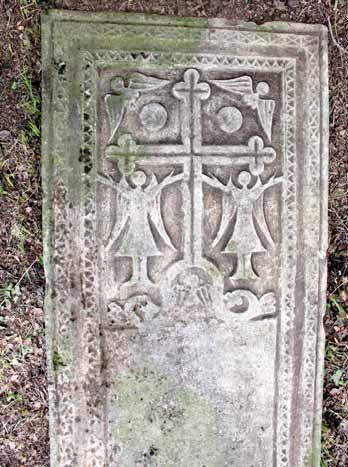


110
relief depictions of a cross and angels
A gravestone relief – a man holding a cross in his hand
A tombstone with a depiction of a woman

111
A tomb chest decorated with depictions of a cross, the moon and stars
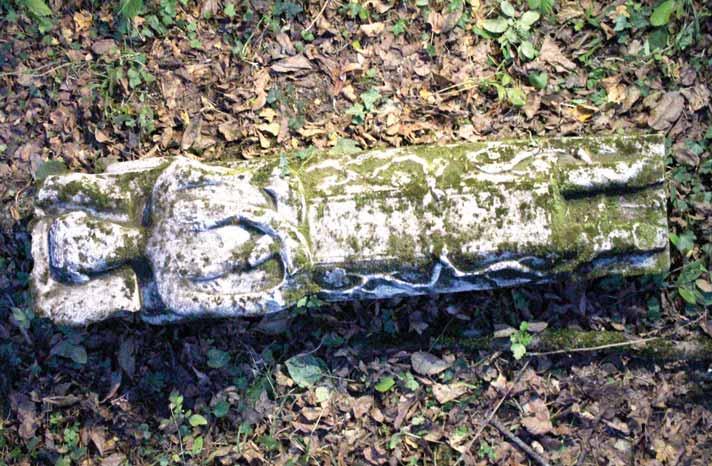
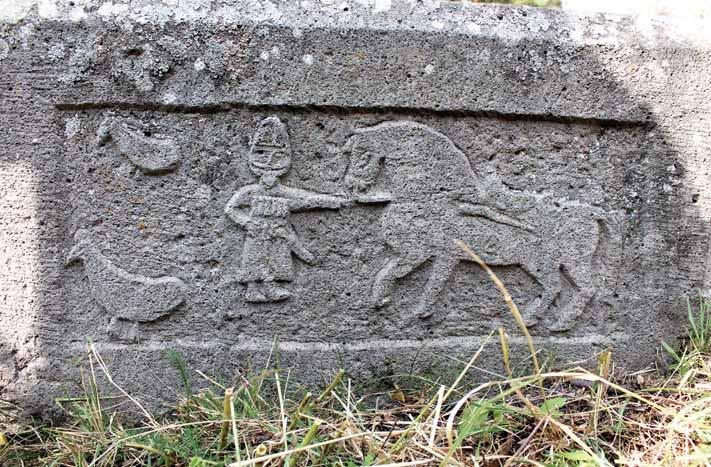
112
A gravestone with a depiction of a man with his arms crossed over his chest
A gravestone with relief depictions of a man, a horse and birds



113
A gravestone with a depiction of a man
A tomb chest with depictions of a man and military weapons
a haut-relied depiction of a man with his arms crossed over his chest




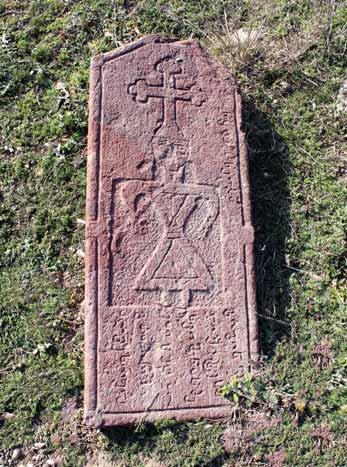
114
A tomb chest with a depiction of a woman
A sculpture of a ram with depictions of military weapons and animals
A tomb chest with a relief depiction of a man



115
Gravestones with the depictions of a woman and a man
A sculpture of a ram with relief depictions of human beings
A tomb chest with a figure of a woman and angels

116
A grave monument with a haut-relief depiction of a human head
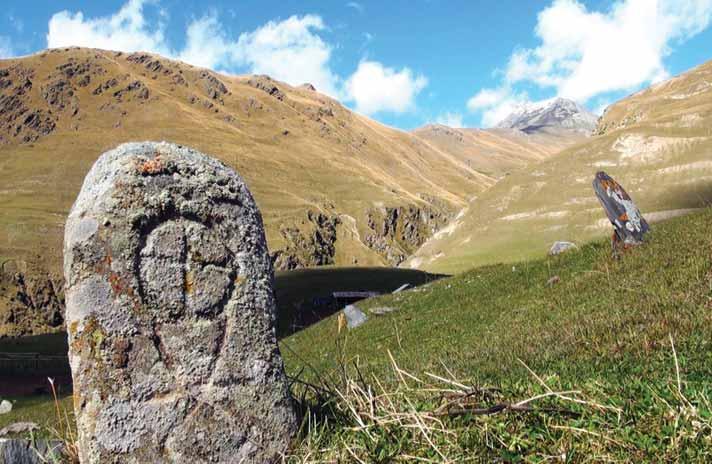

117
A gravestone with
A tomb chest with a cross, borjgali and a four-petaled flower
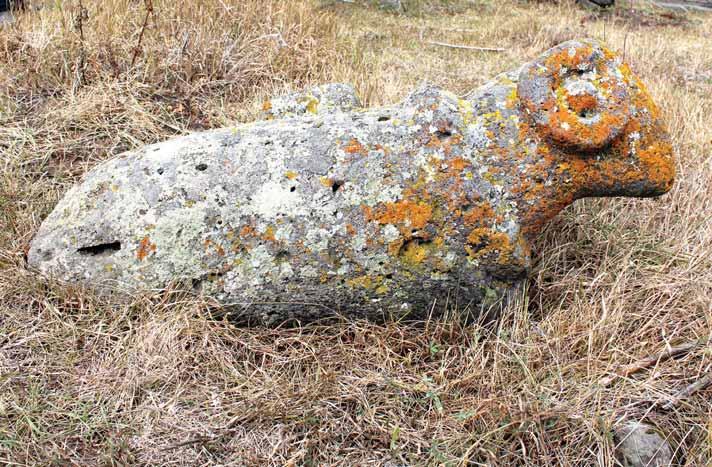

118
A sculpture of a ram
A tomb chest with a depiction of a plough

119
A sculpture of an angel



120
A grave monument with a depiction of a saddled horse
A gravestone with a depiction of a church building
a haut-relief depiction of a woman and a floral décor


121
The gravestone with depictions of a ram and a man
 MANON LILUASHVILI
MANON LILUASHVILI
ARCHITECTURALLY DESIGNED FUNERARY MONUMENTS TH TH CENTURIES: BALDACHINS, SEPULCHRES, CHURCH MODELS
The funerary monuments preserved in the villages and cities of Georgia attract attention in many ways and present a rather remarkable picture. It is important to highlight their historical value and their distinct characteristics. Not all of them have indeed survived intact to the present day, and yet the typological diversity of graves is profound and the ones that are architecturally elaborated – baldachins, sepulchres and church models, deserve special attention. The previous paper was dedicated to them.
Baldachins1
The Old Georgian language indicates baldachins mostly with words such as gavalaki kubo chardakhi baldachin or a canopy. According to Sulkhan-Saba Orbeliani, a gavalaki is a kind of palanquin or a seat . With the same meaning, we encounter it in the Georgian translation of the Old
. The word kubo it can mean throne, canopy, and also the free-standing stone or wooden baldachin . Later, the word chardakhi was adopted from the Persian language. It has several meanings in Persian, one of them being a memorial building over the grave standing on four arches ( The meaning of Georgian chardakhi is somewhat close to the Persian and means a domed construction resting on columns, yet it does not have a memorial function word chardakhni refers to canopies standing over tables, which Shalva Kvenipneveli the Duke of Ksani
. it is precisely due to the four-column baldachin standing over the table that . In modern times chardakhi may also mean a pavilion-like construction erected over an icon case and resting upon four thin silver-plated columns. Baldachins of various functions with four or more columns were widely distributed in different times and cultures . Georgia also had a centuries-long tradition of their use. These small, simple constructions,
Georgian Antiquities,
The interpretation is slightly different in later editions. See Sulkhan-Saba Orbeliani, The Georgian Dictionary, Sulkhan-Saba Orbeliani, The Georgian Dictionary, I. Abuladze, The Dictionary of the Old Georgian Language, The Georgian Dictionary,
Explanatory Dictionary of the Georgian Language, Chardakhi in GeorgianRussian Dictionary, Georgian Antiquities, M. Bulia, M. Janjalia, Kutaisi, See more in J. Bogdanovic, The Framing of Sacred Space, The Canopy and the Byzantine Church
123
open on all sides, used to be erected mostly over altar tables and episcopal or royal thrones . It seems they were introduced into cemeteries sometime later in the Middle Ages. As a rule, those graves were inside the church buildings and belonged to high-ranking secular figures or clergy, although we also sides. Nikoloz Vacheishvili links the architectural peculiarities of this construction to the burial cult and th-century building of the Holy Sepulchre in Jerusalem, which was open, with arches . It is likely that the baldachin memorial monuments are also linked to the Holy Sepulchre iconographically, while their predecessors should probably be identified with the phenomenon of earlier chapels built on top of crypts.
Burial of Jesus, where we see a baldachin resting on four columns above the body of Christ in the tomb. Such compositions spread especially widely F th c . and in any case not later than that. According to the inscription, the building was built by Demetre’s . I could not find the stone tile with the western gate - apparently inserted into the wall. Estate Abashidze and his wife Nariobi are mentioned in the inscriptions of the south-western aisle of the Ubisi church as well as on different items donated to the church as they are well known historical figures . Yet we know nothing else about Demetre Abashidze. The baldachin is inbuilt in the north-western part of the surrounding aisles of the church dated to later
Georgian Antiquities
Convivium Supplementum
Georgian Antiquities and Mesopotamian origin on the one hand and on the other she sees the great influence of the architecture of Iranian
Collection of Academic Works, Khelovnebatmtsodneoba (Art Criticism), The East and Caucasus, th th Zeglis megobari V. Beridze, The Georgian Architecture of the 16th-18th cc., a relief was carved depicting a right hand in a gesture of blessing (V. Silogava, The Lapidary Inscriptions as a Historical Source, published with slight alterations by M. Brosset and E. Takaishvili, (M. Brosset, Rapports sur un voyage acheologique dans la Georgie et dans L’Armenie
We also see their depictions on the Ubisi Tryptich (T. Sakvarelidze, The Georgian Goldsmith design of the 14th-19th cc. Part th th
124
times, . The baldachin, situated under a single, sloped roof, is surrounded by walls on three sides and is open, with an arch, only towards the south. The church is mainly built with broken stone, yet the constructionally significant areas (such as
fragment of which has survived to the present day. The fragment displays a row of about three leaves sitting on the shelf of the cornice and the three-petalled flowers – lilies are placed on the torus border so that they are arranged head to foot, sequentially. The edges of the side facets of the tombstone under the baldachin are also decorated with the depictions of crosses surrounded by diamond-shaped frames, and
The windows, rounded on both sides in the drum of the dome, are also noteworthy. They are finished with unembellished borders. Similarly shaped windows, rounded on both upper and lower ends, are found
The first two precede the construction of the baldachin. It is commonly known that the building of the the Abashidze family church when he made the unusually shaped windows in the drum of the dome of the Demetre Abashidze’s baldachin. It is obvious that a long gap between the dates when these two buildings were built negates the possibility that they were built by the same builder.
F . The construction during their lifetime, and was pre-planned as a tomb, and painted and . This is confirmed by the Mkhedruli inscription on the back of the icon of the Mother of God, inscribed on their orders: and zeal, embellished you with gemstones and pearls and placed you in your church in the aisle sheltering . The baldachin is placed against the western wall of the church in the southern part
on the north side have tall, sharp-cornered bases and capitals. The capitals on the south are rectangular and surrounded by a torus moulded border on the inner edges, with a wall built up between them. The depictions . It is standing near the sanctuary, in the southern transept of the church and
V. Beridze, The Georgian Architecture of the 16th-18th cc., Kvali, Essays from the History of the Gelati Monument Gelati (guide)
Gelati Monastery in Times of the Exarchate, Gelati 900, Architecture, Painting, Treasure, The Life of Kartli, The Kingdom of Imereti (1462-1810)
M. Nikoleishvili, Epigraphic monuments of Kutaisi Museum,Works of Kutaisi State Museum,
P. Zakaraia, Architectural Ensemble of Ananuri, Sabchota Khelovneba (Soviet Georgia),
Ananuri,
125
. The rectangular open construction is a canopy resting on four columns with battered corners; the canopy is finished with a gabled roof. The architectural and artistic resolution of the building is closely linked with the contemporary principles of church architecture of the time and likewise shows the influence of Iranian architecture. Slightly ogee-shaped arches are decorated by a twisted ornament. The corners of the capitals of the columns are decorated with three branch stalactites, while the cornice is embellished with a border
ornamental repertoire of late medieval Georgian art. It embellishes numerous gravestones or buildings th th
The columns of the structure are similar to the bell tower of Anchiskhati church, which was built a dates of construction lead us to think that both buildings might have been built by the same artel or by the same master.
th c. One of the
. According to A. Muraviov’s Mtskemsi
the world remember the untimely passing of the Supreme Judge of Georgia Edisher, the son of Duke Giorgi, also the brother of Duke Otar, and a nephew of the king and of the royal prince Domenti of Kakheti, who passed away too early, and who was considered by them as a great one, famous and successful, appointed, a man filled with divine love as well as perfectly accomplished in worldly matters. I, his spouse Anakhanum Abashidze, left without a son, built these four columns and a dome on our graves. We completed our lives, yet remained without a son, who was not granted to us, for only five daughters were granted to us by the merciful one, who decided not to show further mercy upon us. He allowed me to part with the sweet soul and body, and left me wretched. I had the protection of my brother-in-law, duke Otar, an apple of my eye, who grieved for his brother. Those days are also over. I am wretched since God never gave us a son and the name and memory of this outstanding man is going to be lost. I, poor Anakhanum, thought in vain to be remembered on this edifice, rather than to rely on the remembrance of posterity. For the sake of God, whoever hears about his goodness, or finds out about it now, remember us, if you come here for the Divine Liturgy, remember us in the Holy Sacrament, those who do not take part in The
Architectural Ensemble of Ananuri th th cc. and it is assumed that its emergence is linked with the crusades (D. Tumanishvili, N. Natsvlishvili, D. Khoshtaria, Construction Masters in Medieval Georgia, church and refectory of the Samghereti Monastery, in the palace at the site of former city of Rustavi, and so on. (I. Tsitsishvili, Mimomkhilveli in Dzeglis Megobari, Construction Masters in Medieval Georgia, frame of the Ancha Icon of the Saviour by Beka Opizari – in the background décor behind the depictions of the Mother of God and St John the Baptist (T. Sakvarelidze, G. Alibegashvili, Georgian Metalwork and Painted Icons I think the reappearance of the lily motif in Georgia in the late Middle Ages must have occurred in a different way, although this is a topic for different research. According to Vakhtang Beridze, its origin is linked with folk art, particularly with woodcarving (V. Beridze, Georgian Architecture of 16th-18th cc.,
126
. Therefore, its construction date should be placed . According to Platon Ioseliani and Dimitri Bakradze, the grave was
visited the monastery, the cover was already hung on the wall. The author refers to it, among other items, and quotes its Mkhedruli inscription, according to which the cover was made by Tamar Andronikashvili, . A small rectangular brick construction is situated in the south transept, on the right of the sanctuary and adjoined to its walls. The canopy, which is standing on a relatively tall platform, and is covered with plaster, is open only on two sides: with two arches over three columns in the north, and one in the west. The vault is divided into three equal segments. Those on the corners have cylindric shapes, while in the middle, initially, there was a pendentive dome. Only a small part of the dome has survived to the present day, although it is visible in the photograph made by Theodor Kühne in . th by his widow, Ekaterine Chavchavadze . Indeed, the elegant, marble construction of eclectic style, uniting Renaissance and Baroque elements, is a square plan baldachin covered with a groin vault and standing on a low, smooth platform. It is open, with arches on three sides, while the fourth side is adjoined to the wall. A bilingual epitaph in Georgian and Russian is inscribed on a marble tile attached to the same wall . Ionic capitols embellish round columns standing on rectangular bases. The vault
E. Takaishvili, Archaeological Travels and Notes, th c. as the date for the baldachin (J. Bogdanovic, The Framing of Sacred Space, The Canopy and the Byzantine Church Archaeological Travels And Notes, Essays, at the museum in Telavi. th th th c., Saistorio Moambe, (Historical Bulletin), Tomb covers: Studies of the Georgian State Museum of Art, I. Meunargia, The Final period of the Principality of Mingrelia and David Dadiani: Materials and Documents, edited by
Ancient Georgia, The Collected Works of the Historical and Ethnographic Society of Georgia, epitaph is covered by an icon at present.
127
displays a half-length depiction of a man. At present all four torsos have their heads broken away, but they are recorded on an old photograph, which also reveals other lost details such as a low metal cross
tile right below the epitaph. The grave monument eclectic in style and richly decorated may have been made outside Georgia. th c. is found in Kutaisi – it is a grave of an with dressed stone and covered with a spherical brick dome open with arches, with four faceted columns
with a zigzag border above the arches, and the pediments above the border are finished with moulded cornices. Similar decorative motifs are typical of the buildings built or repaired by Greek stonemasons th th c. (e. g. Tsereteli palace in Skhvitori, the Church of St George in Sujuni and the Church of the Mother of God in Martvili, etc. It seems that the building was also completed with a small dome. It has not survived to the present day save for its rectangular base. Under the baldachin, we have quite a tall chest tomb. Its sides and the slightly raised edges of its main surface are decorated with braided and floral ornaments. Presumably, a marble stone with an epitaph was initially inserted in the central part of the stone. The baldachin seems to be made by Greek masters, which becomes evident by the construction methods and the use of a zigzag-like motif, borrowed from their usual repertoire.
Also, we ought to mention the two presently ruined buildings outside the Georgian borders. One of
. The descriptions by various authors, and old photographs, reconstruct the image of the structure . It was a square canopy standing on a relatively tall pedestal and four round stone columns. The interior was covered with a barrel vault made of brick. A small dome
. The décor of the drum of the dome consisted of a moulded arcade flowing over the tops of the windows. The capitals of the columns were decorated with the same ornament. The baldachin churches, and embellished with the depictions of angels, crosses and other figures. Here on the sky in the . He also informs us that the inscriptions on the tombstone were inscribed in Khutsuri and Mkhedruli scripts as th th
The Cultural Legacy of the Pontic Greeks in Georgia, Tbilisi, Georgian Antiquities,
Bedi Kartlisa (The Destiny of Kartli), Dzeglis Megobari, Droeba
The Post-Byzantine Monuments of the Pontos
128
Ermil-Efendi, City of Trebizond
well as in Greek . A marble tile with an epitaph was placed on the surface of the grave. There is a theory arguing that the Georgian inscriptions belonged to the spiritual director of the king - Iase Kanchaveli .
carved fretwork and the dome standing on the roof with Georgian architecture, but he also notes that in structural terms, one can find closer parallels in Verona and Bologna than in Georgia . As a possible prototype, he refers to the baldachin standing near the Chrisokefalos Church of the Virgin Birth in Trabzon, its similarity with the grave baldachin of Solomon II.
Guria, Mamia V, located within the enclosure wall of the church of the Archangel Michael in the village
and faced with dressed stone; four columns built with dressed stone are bonded together with arches and iron blocks; the construction is covered with roof tiles. The inscription was made in Greek, but it is
Attention should be given to the grave of a rich inhabitant of Tbilisi, the merchant Nikoloz Bozarjiantz, . The funerary monument is likely to be dated to the beginning of th c. The square-plan building, faced with grey dressed stone, is a canopy standing on four thick columns and finished with a pendentive spheric dome, surmounted by a metal cross. The richly decorated th c., which are placed over the pairs of round pillars standing inside the supporting columns. However, some distinct architectural motifs such as woven pillars sitting in the bevel corners of columns, Armenian Revival style. This is not accidental, considering the ethnic origin of the owner of the grave The outer surface and internal area of the arches are decorated with a floral ornament. The fretwork
The inscriptions, with slight variations, are published by several authors. See: T. Khuskivadze, The Last King of Imereti, Solomon II, Historical Account, Kvirila, The City of Trebizond, , newspaper Sakhalkho Purtseli The Post-Byzantine Monuments of the Pontos The Georgians in the Ottoman Trebizond,
King Solomon who dwell inside this grave. My former good fortune and beauty were stolen from me and I am left naked and wary in this grave, a successor of the tribe of David, from the Bagrationi family, the son of Archil, King Solomon of all King of Imereti, Solomon II, Historical Account, Akaki Tsereteli, Trebizond, (Traveller’s Notes) , newspaper Samshoblo, A. Bryer, D. Winfield, S. Ballance, J. Isaac, The Post-Byzantine Monuments of the Pontos
Droeba, Droeba, Iveria, th and the beginning th Architecture and Identity: Church Construction Work in Tbilisi (1801-1918), edited by D. Khoshtaria,
129
covers the upper right-angled areas above the arches as well as the curvilinear outline of the attic on the
The two constructions in the churchyard of the church of the Archangel Michael in Historical Khevi, in the town centre of Stephantsminda, are worthy of mention. In the west of the Church, within a few
. The constructions can hardly be called baldachins. they share a common feature, namely, the open arcade structure in the lower part of the baldachins. monument must have been built after the death of Mikheil, in the lifetime of Elizabeth, at the end of the
The memorial monuments for the Kazbegi family look very much alike. Both are built with a greyishpink, finely dressed stone. The building material is local andesite from Khevi, distinguished by its high quality, and which was widely used in construction from the Middle Ages on (the same stone was used for building the Holy Trinity Church in Gergeti and its bell tower of both constructions is cruciform, with short arms and an intersecting vertical canopy covered with walls in the lower area are open, with pairs of semi-circular arches resting upon faceted pillars. There are also differences: on the inside, the grave of Gabriel Kazbegi is covered with a flat vault consisting of segments, while in the monument for Mikheil’s and Elizabeth’s tombs we find a pendentive dome. The columns are also designed differently: The rectangular bases of the eight faceted columns of the first construction, and their capitals, are decorated with semi-circular elements consisting of a border and a stalactite-like motif in the corners. The four faceted columns of the other construction are decorated with narrow decorative arches, and the areas under the corners of the rectangular capitals are decorated with small details, consisting of three cylindrical shapes. Embellishments of capitals th and the th centuries.
The planning and structure of these monuments should be emphasized. The constructions with the analogy in Georgia neither at that time nor earlier. Such a design is typical of some Ottoman tombs – türbes (e. g. the türbe th speak about links between them if we allowed that the tombs of the Kazbegi family were built by Greek masters, and yet there is no reason for such a presumption – the tombs of Stephantsminda show no signs of a Greek stonemason’s work, there are no traces of either their building methods or the repertoire of their decorative motifs. It is more likely, that both monuments were built by local masters.
It is interesting to note that the draft project for the Mtatsminda Pantheon proposed by Anatoly Kalgin
The Description of the Historical and Cultural Monuments of Georgia Akhmeta, Dusheti, Tianeti, and Kazbegi Regions, round. The church also referred to as dedicated to the Mother of God, yet, as the inscription on a marble stone informs against the wall.
T. Sanikidze, The Architectural Ensemble of Gergeti,
130
of the Kazbegi family. It presents a cross-in-square construction standing on a tall platform and is finished with a dome on a narrow four faceted drum and pyramid roof, while all four walls of the building are open with pairs of arches . The similarity between the unfulfilled project and the grave monuments leads us to think that the authors must have been inspired by the memorial monuments of the Kazbegi family while working on the Mtatsminda project.
Finally, I should mention the now ruined grave monument of the first Christian King Mirian and Queen
Konstantine Bagration-Mukhraneli and others . A Church-like building was standing in the south-western . As far as is possible to judge through a dome. Its eastern and northern walls were open in the lower part, with arches resting on pairs of round marble pillars. Three open arches were on the eastern side (the middle one was wider and taller than those decorated with little ball-like ornaments and rectangular capitals at both ends. In the middle of the eastern of a Georgian historical style, although its direct prototype is not identified. It is worth noting that it is one of the first grave monuments clearly demonstrating an attempt at using a Georgian Revival style I think, even such a brief review of memorial baldachins is enough to uncover their architectural diversity th th c., probably as a result of postByzantine influence. Its dissemination in modern times though should be linked to the general tendencies towards a Europeanization of architecture. Yet, in particular cases, we may distinguish between the local and regional traditions of construction established since earlier times and, on the other hand, a Georgian Revival style.
Sepulchres
According to Sulkhan-Saba Orbeliani, Akldama . These small family burial chambers are in most cases the final resting place of nobility or clergy . As written sources witness,
See the project in Sakhalkho Purtseli, , Architecture and Identity: Construction of churches in Tbilisi (1801-1918), Tbilisi, Mtskemsi, Tbilisi – Ortubani, Kintsvisi, Samtavro Convent of St Nino, M. Bulia, M. Janjalia, The Old Cities of Georgia: Mtskheta, Georgian Antiquities,
About the grave monuments designed in a Georgian style see: D. Khoshtaria, The Georgian Style and the Imperial Architects, Sulkhan-Saba Orbeliani, The Georgian Dictionary,
Bulletin of the Georgian State Museum, tombs shaped like Kvevri
131
it was a common practice for some to prepare their own sepulchres and tombs during their lifetimes. .
the times of antiquity and the early Christian period include two main types of tombs – a single sepulchre and a single sepulchre with a dromos However, a double-sepulchre has also survived to the present day. It has a small compartment in place of a dromos. A grave known as belonging to Asparug Pitiakhshi was placed within the main cell
We may remember the sepulchres of Bagineti and Mtskheta st nd century. It is built with dry-stacked masonry using sandstone. The rectangular building is covered with a roof supported by a semi-circular
edges, is faced with dressed panels of different sizes. It is finished with a pediment with a simply-shaped cornice. The door is cut into the middle, surrounded by jambs. The other three walls are flush against the walls of a ditch and are not faced. The sepulchre is covered with a gable roof covered with two types of roof tiles.
Two sepulchres, one in each of the neighbouring villages Tsilkani and Dzalisa th th centuries, reveal a certain kinship. These two constructions are built with finely dressed stone and both are burial chambers, with semi-circular vaults supporting their roofs. Each has a staircase descending into it from the east – the so-called dromos . Yet there are some differences between the two: the dromos is twofold in Dzalisa – there is both an open and an enclosed one. The Tsilkani sepulchre is supported with cobblestoned walls on the outside. According to the Greek inscription on the western wall inside the chamber, it was built by Tikas and the monk Pharanuses .
About them see: G. Gobejishvili, The Tumulus Culture of Bedena, The Graveyards of Trialeti, catalogue 3, The Opulent Graves of Antiquity in Algeti Gorge, A. Davitashvili, Hellenistic Graves in Mtskhetijvari, The Late Bronze Age Tombs from Javakheti, Grave Types and Burial Customs in Ancient Georgia (Graves With Threshing Boards ), Hellenistic Graves from the Sites of Former Cities, The Life of Kartli, rd nd millennium BC may
consist of vertical round logs standing tightly to one another and supported on wooden planks. The rafters are supported on their sides by earth, while on their central area they are supported by two wooden poles, inverted and dug into the ground, Dzeglis Megobari Bulletin of the Academy of Sciences of Georgia, Dzeglis Megobari, The Tumulus Culture of Bedena, A. Apakidze, Cities and Urban Life in Ancient Georgia, The Bulletin of the Academy of Sciences of Georgia, Cities and Urban Life in Ancient Georgia,
The Bulletin of the Georgian SSR Academy of Sciences, Sepulchre in Mtskehta, Cities and Urban Life in Ancient Georgia, Dzeglis Megobari, th
A. Bokhochadze, N. Mirianashvili, Dzalisi Burial Vault,
The Bulleting of the Academy of Sciences of Georgia,
132
Similar style two-chambered burial constructions periodically emerged in different parts of Georgia in
th th cc . The construction of the Tianeti’s Sioni sepulchre, built with dressed travertine stone, is very close to their architectural style . The Zhinvali tomb, with an ogee th c. The sepulchre with a dromos in Kavtiskhevi village belongs to the late Middle Ages, with the squinches supporting its brick dome
The architectural peculiarities date the building to the late Middle Ages . It is considered to be a Muslim sepulchre, but it remains unknown for whom it was built. An octagonal building is built on a circular
of brick and is covered with a roof supported by a dome-like vault. Some of the edges between the facets are rounded. The area above the facets is framed with arches made from bricks. Beneath the arches, our attention is drawn to two types of stonework – horizontal and zigzagged, alternating after every facet. the gates of the Batonis Tsikhe etc. There is a rectangular aperture of a door on the eastern side. The floor is about three meters below the ground level. In the interior, a ledge is placed against the lower area of the wall. A small niche is placed in the southern wall, while in the north a somewhat ogee door is situated on the level of the floor. It seems that there was a hole in the middle of the dome for letting light through, yet it is now filled in with stones.
. As we learn from the bilingual epitaph in Russian and in Georgian inscribed upper areas. Their decoration consists of brick-work décor. The corners of the building are highlighted by
considered to be the earliest source of the history of monasticism in Georgia, since it mentions the father superior and a , Architectural Legacy, th
Studies in Georgian Archaeology, Dzeglis Megobari,
R. Ramishvili, Archaeological Monuments in Iori Gorge, I, Sioni, Dzeglis
O. Saneblidze assumed, on the ground of the discovery of clay pipes, that the construction could have initially been a Dzeglis Megobari,
letters addressed to Marie Brosset, Historical Bulletin
The building is now standing in the garden of Shota Rainauli’s house.
th c. (The Description of Historical and Cultural Monuments of Georgia, 1-II, Telavi Municipality,
The Descriptions of Historical and Cultural Monuments of Georgia, 1-I, Gurjaani, Dedoplistskaro, and Kvareli Municipalities,
133
crosses and rhombuses. Single depictions of crosses are also sitting in the upper part of each corner. The building is completed with a simple cornice and a pyramidal dome, consisting of step-like layers of
north. The building is surmounted by a semi-spherical, pendentive interior dome. The pendentives under the dome are bowed inwards and framed by a bow arch. Similar designs of the spaces below domes th th . The technical quality of the stonemasonry of the building is not particularly advanced, and yet, architecturally th c, Kakhetian architecture. of God in the village of Odzisi. According to its architectural peculiarities, the tomb ought to be dated to th c. at the northwest of the church. In later years it was turned into a bell tower, although its original each have a tall arched window. An arched niche is placed on each side of the apertures in the southern and northern walls. The roof interior is formed into a semi-spherical dome. The area separating the dome and the square underdome is formed of stepped pendentives. Nowadays, the interior is divided by a wooden construction into two levels. As the photograph shows, the building was initially covered with a small eight-faceted, spherical dome. An arched window was cut through the wall of each of its facets. In the process of changing the building into a dome, the small dome was demolished, a larger canopy was put in its place, and a staircase leading to it was attached to the north-eastern side. Therefore, the initial architectural image of the sepulchre was significantly changed.
. It is Most of the modern sepulchres are found in the capital of Georgia. Apart from being the final resting . It th th centuries Georgian Architecture (squinch and pendentiveArchitectural Heritage, The Descriptions of Historical and Cultural Monuments of Georgia, Akhmeta, Dusheti, and Tianeti regions, E. Nadiradze, Grave Monuments in Imereti, Gantiadi, love and unshakable loyalty to him and I also chose my own eternal resting place, together with him in this quiet and holy M. Bulia, M. Janjalia, The Old Cities of Georgia, Tbilisi
Architecture and Identity, Church Construction in Tbilisi, (1801-1918), edited by D. Khoshtaria,
134
passed away. It is likely, that it was at that time that Ana Tsitsishvili, the wife of P. Barathashvili, decided to build this sepulchre, and commissioned the project to one of the leading architects of Tbilisi at that time. The small building, surmounted by a spherical dome, follows the intended project almost precisely. faced with dressed white and greyish stones is decorated with green marble décor. It is distinguished by an advanced level of stonemasonry skill. As Maya Mania supposes, the artistic refinement of the marble stone must belong to the workshop of Angelo Andreoletti
. The construction was dedicated to an Armenian merchant designed in the style of Art Nouveau. The rectangular planned sepulchre is faced with dressed stone and covered with a stone slab. The architectural image of the building is created by the curved shapes and Georgian ornaments as well – on the door jambs and friezes. The use of fretwork borrowed from the participation and desire of the stonemason Neophite Agladze. Near the Ananov family sepulchre at Vera cemetery, there is also another richly decorated sepulchreth c., belonged to the family of Ivane Yuzbashyan according to the inscription. The person mentioned in the inscription was probably a wealthy inhabitant of Tbilisi: I. Yuzbashyan . The two-storey building, surrounded by an enclosure deceased’s ethnic origin. The ground floor is a sepulchre, while the top floor is a chapel. The majority of three-section arcade. A fretwork cross is contained in it, with an Armenian inscription underneath, which semi-circular arch decorated with a moulded ornament. The second floor is a chapel in a rectangular plan, pinkish stone. Pairs of semi-columns, with bases and capitals at the ends and decorated with beads and built upon them. This motif was widely used in the Armenian church architecture of Tbilisi on buildings th th century .
M. mania, European Architects in Tbilisi, Sabchota Khelovneba
Newspaper Droeba, Sakhalkho Purtseli, Iveria, Knight in the Panther’s Skin were printed on the wrapping papers of each sweet (newspaper Iveria, th th
135
. I shall not consider the details . He might have been referring to these two buildings, but this is only a supposition. th th centuries. However, for whom it was built is
arched entrance, a portico is arranged, decorated by two columns carved from stone, with Corinthian capitals. An entablature lies on the columns, finished with a triangular pediment. A shortened version of words from St Matthew’s Gospel is inscribed in Old Slavonic on the frieze included in the entablature. The words translate
Another chapel was also standing in the Roman Catholic section of Kukia Cemetery. Sophia Schmitz, the widow of a Polish Pharmacist Wilhelm Schmitz built the chapel in memory of her late husband. The building has already been discussed at great length and therefore, there is no need to address it any further. I shall only mention that the Baroque style, richly decorated construction was built by the
In the end, I should mention a later construction outside Georgia, built at the Doulab Christian Cemetery in Tehran. The building presents a sepulchre with a burial crypt underneath and was dedicated to Minadora .
The Georgian Revival style building was probably constructed according to the architectural drawing by the Russian architect Nikolai Markov, who was raised in Tbilisi and later moved to Iran . A squareshaped sepulchre surmounted by an octagonal dome is partly inserted below ground, which makes the
pairs of torus moulded half-columns. The central arch is taller and wider compared to the side ones. On
The saw-toothed motif, which decorates the borders of the windows of the dome is rarely encountered in Georgian architecture, but the floral ornament on the cornices of pediments and the capitals, which thth
Architecture and Identity, Church Construction in Tbilisi (1801-1918), th th
Sabchota Khelovneba, Architecture and Identity, Church Buildings in Tbilisi (18011918),
The Georgians at the Doulab Christian Cemetery in Tehran, edited by Sakartvelos Respublika, Architecture and Identity: Construction of Churches in Tbilisi (1801-1918),
136
It is noteworthy that through its general structure and artistic décor, the sepulchre reveals a certain kinship with a small cruciform-shaped church built above a square-shaped chapel in Martvili in the th th cc. famously belonging to the Chikovani family. I think the architect of this sepulchre might have , although the two are not entirely identical and the
the sepulchre has an octagonal false dome sitting above the semi-circular vault; Two floors here are merged and thus it is partly inserted below ground, which changes the proportions and appearance of the
Samegrelo, his homeland, thus also bringing the presence of Georgian identity to a foreign land.
Church models
for different purposes in Christian art. Georgia also has a centuries-long tradition of producing such church models. Most of them appear on liturgical items, acroteria, and gravestones. Embellishing tombs with church models apparently began in the Middle Ages. They come in different varieties and occupy a special
into two groups: free-standing, and models erected on the back of ram sculptures; she notes immediately that the types of churches depicted are also distinct. We have the domed (whether cruciform or cross-in. The following monuments
numerous cases, the church is so generalized that only a dome or a gable roof is visible on the back of the ram sculpture
The tradition of decorating churches with three-dimensional sculptures continued to modern times and th th centuries are preserved in
As a rule, the models are surmounted with either metal or stone crosses, many of which are now lost. The models do not depict one specific church. They repeat the general structure of the church building, showing the main characteristics such as windows, doors, and niches. Sometimes they are embellished with moulded elements and sculptural figures. The scope of the iconography of the reliefs is mostly limited to general Christian motifs, which is directly linked to the function of the monument. Symbolic and
Perception and Representation of Architecture in Medieval Georgia, edited by M. Didebulidze and D. Khoshtaria, Tbilisi,
Material Culture of the Epoch of Shota Rustaveli, The Bulletin of the State Museum of Georgia, According to Eldar Nadiradze’s observation, the doorway on the side of the ram, which sometimes even has a metal door
Religion,
137
or the pedestal. Sometimes inscriptions are engraved on marble tiles and inserted in the facets of the monuments are sometimes found not just in the same cemetery but also in different villages or even parts of the country. They are often built identically, albeit with different decorative motifs. th century onwards their form and décor reflected new tendencies which were emerging in the urban architecture of Georgia in that period. These new tendencies indicate the growth of interest in historical styles and eclecticism. According to the wish of the commissioners, the graves are decorated with shapes and elements typical of the Neo-Renaissance, Neo-Baroque, and Neo-Gothic architectural styles. Since the beginning of the
Three major types of church models should be distinguished among the ones made in modern times: different regions, are in fact very similar. Both are carved from single stones and represent a cruciform and arches. The depictions of crosses are attached to the centres of some of the window casings on the and an epitaph spread across two of its facades. In modern times we no longer find church models standing on the backs of sheep (at least so far as I displayed on the apse and the drum of the dome. The window openings in the model in Chibrevi are also finished with carved window frames. facades of the church models are completed with pediments. The facades are adorned with floral and depiction of a human being is carved within the pediment. Windows are demarcated with recessed rectangular areas and triangular pediments above them. It should be noted that one of the tomb chests
A third group consists of those church models which stand on four-faceted pedestals. Usually, the pedestal or vertical monuments or maturi . According to Niko Chubinashvili, a maturi . According to Ioseb Grishashvili, however, maturi is an Armenian word and means a small church standing on a grave . It is difficult nowadays
Gantiadi, Memorial Culture of Georgia, Georgian Dictionary with Russian Translation, I. Grishashvili, Urban Dictionary, (archival material),
138
th century and maybe even earlier, it had a broader meaning and did not mean merely a particular type of a gravestone .
It is worth considering that the models standing on tall pedestals, with their structure and symbolic meaning, display a link with stone crosses, which were widespread in Georgia in the Early Middle Ages . The significant element in the construction of stone crosses is their three-part composition. The semantic meaning of stone crosses is well known: the pedestal is considered to represent Golgotha, while the pillar, the upper part of which is decorated with an arcade, stands for the Lord’s tomb. The pillar is then surmounted by a cross . The reference to the Holy Sepulchre using an architectural motif, i. e., an arcade, is replaced by a three-dimensional depiction of a church, which probably refers to a Christian Church in general as well as to the Holy Sepulchre. Therefore, we may consider stone crosses to be the earliest antecedents of this type of gravestone.
inscribed into marble tiles, which are inserted in the facades of the church model. This third type is the most distinct among church models, with its contrasting variations. The grave monuments where the three-dimensional depictions of churches are open from three sides should be and it is rather like a four faceted canopy
Neo-Gothic and Neo-Baroque architectural forms, is richly decorated with moulded décor. The other two monuments in Kursebi, similar to one another, are also abundantly decorated. One of them is more striking because of the sculptures of angels carved at the corners of the facets of the canopy. It is one of their works in different parts of Georgia. As a rule, the stonemasons do not write their names in inscriptions,
The word maturi is mentioned in the will of David Agmashenebeli (Typikon of Shiomgvime Monastery
Anamki, maturi Studies in Ethnology, It seems that maturi also referred to a grave sculpture. An article in the newspaper Iveria speaks of erecting maturi in Iveria, Alas, O World… describes maturi as a marble sculpture of an angel (Z. Arsenishvili, Alas, O, World… (Kakhetian Chronicles),
About stone crosses see K. Machabeli, Early Medieval Georgian Stone Crosses, K. Machabeli, Early Medieval Georgian Stone Crosses, On the Origins of Georgian Christian Art, maturi
For the History of Georgian Material Culture, The Memorial Culture of Georgia,
139
. The name of the . The Islamic name implies that the workman might have been an Anatolian Greek. I am acquainted with some other which was made by Philipe Gugava for his son . We know nothing about these named masters, and yet it seems like they considered themselves not as ordinary workmen, but as professional masters, and the inclusion of their names in epitaphs was obviously done on their initiative.
The general observations on the church models and gravestones of modern times confirm that most of them were constructed by ordinary stonemasons. According to ethnographic records, as early as in the th c. the names of stonemasons were well known, and they passed on their artisanship to made by them were transported to neighbouring villages . The gravestones were mostly made within the guilds of the stonemasons. There were numerous such guilds in the cities or villages of Georgia. For their main function was the carving of gravestones .. The imGuild . It seems that the guild also united ethnic Greek stonemasons. It is commonly known that Greeks th thample, in Algeti Gorge, the stonemasons from the village Iragi were famous for their fine fretwork and culturally sophisticated gravestones th c., but it inevitably reflects th c. also. Tsikhisjvari village was distinguished in the Borjomi Gorge, where stonemasonry was the main occupation for the Greek population. The gravestones they made were used by the .
The church models discussed in this section form a significant source for the study of a range of aspects of the culture and lifestyle of Georgia in recent times. Their direct observation reaps ethnographic data and clearly witnesses the continuation of the tradition of stonemasonry in Georgia in modern times and through the early Soviet period.
, Materials for the Ethnography of Georgia,
E. Nadiradze, The Memorial Culture of Georgia, Dzeglis Megobari, Materials for the Ethnography of Georgia, Matsne,
S. Bedukadze, Folk Stonemasonry in Algeti Gorge,
E. Nadiradze, Stonemasonry and gravestones in Shida Kartli, Shida Kartli (Ethnographic Research),
140


141
The dome of the baldachin over the tomb of Demetre Abashidze
The tomb of Demetre Abashidze



142
The painting of the baldachin

143

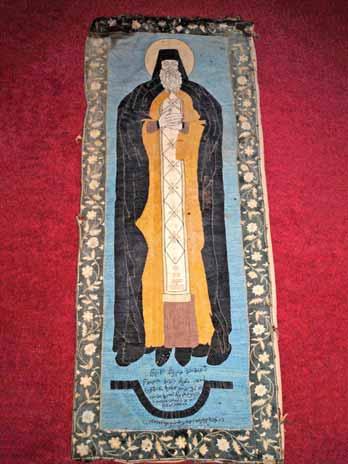

144
The tomb of St Zenon




145
A tomb baldachin
God in Martvili. The tomb canopy of David Dadiani
The tomb of King Solomon II

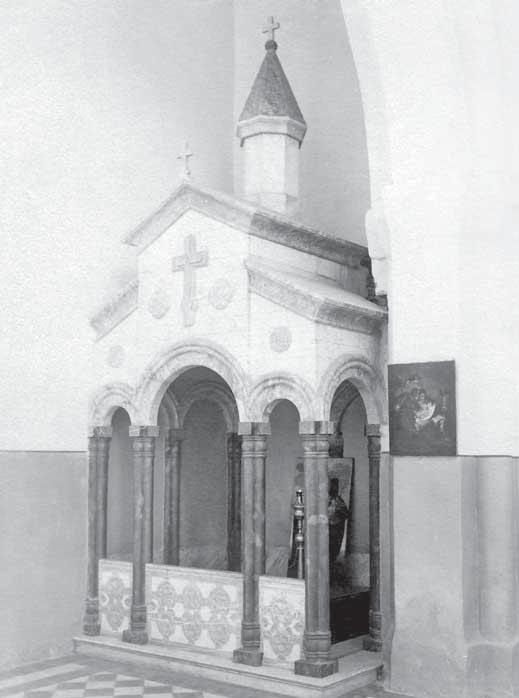


146
Cemetery. The tomb baldachin of Nikoloz Bozarjiantz
Stepantsminda. The gravestone of M. Kazbegi and E. Tarkhnishvili
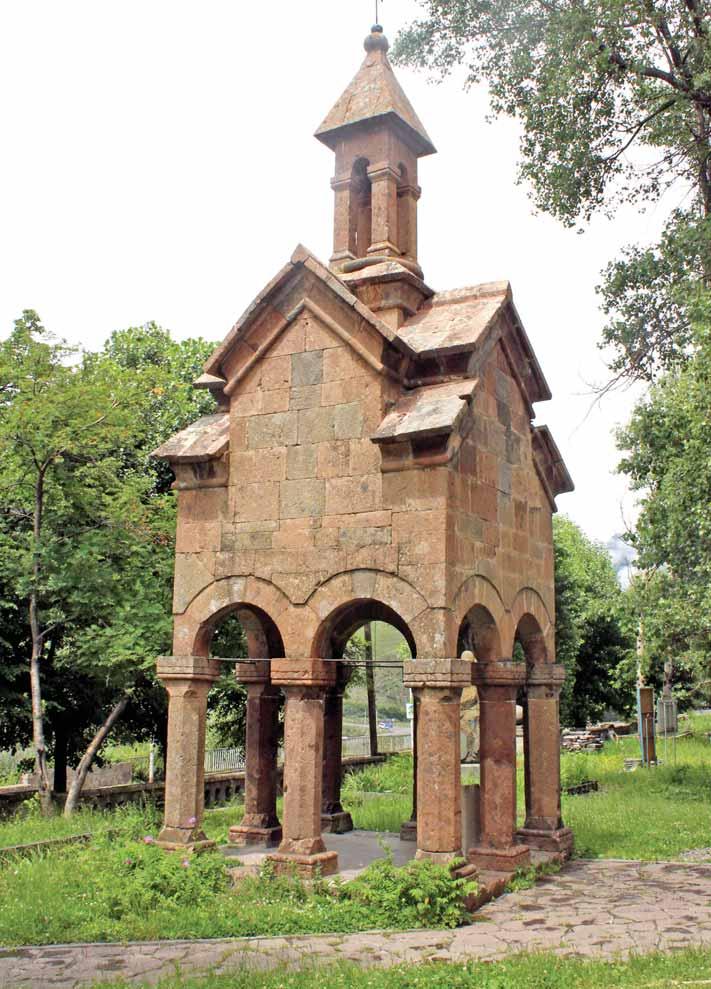
147
The gravestone of Gabriel Kazbegi
A sepulchre


148
The sepulchre of Svimon Shalikashvili


149
A sepulchre later turned into a bell-tower


150
An inscription on the sepulchre of Simon Abdushelishvili

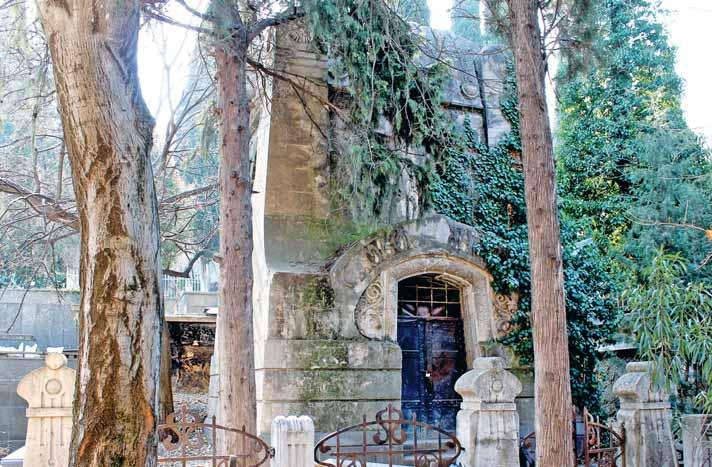
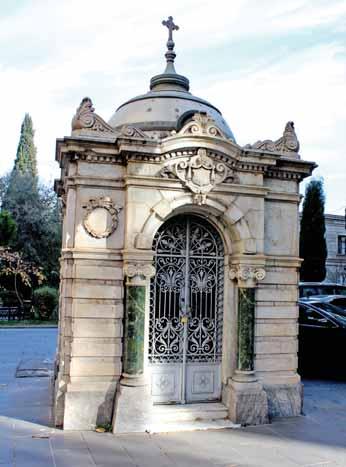
151
Cemetery. The sepulchre of the Ananovs.
The Baratashvili family mausoleum
Cemetery. The portal to the sepulchre of the Ananovs


Cemetery. the sepulchre of the Yuzbashyans
Cemetery. A sepulchre

152


153


154
A sculpture of a ram with a Church model on the back
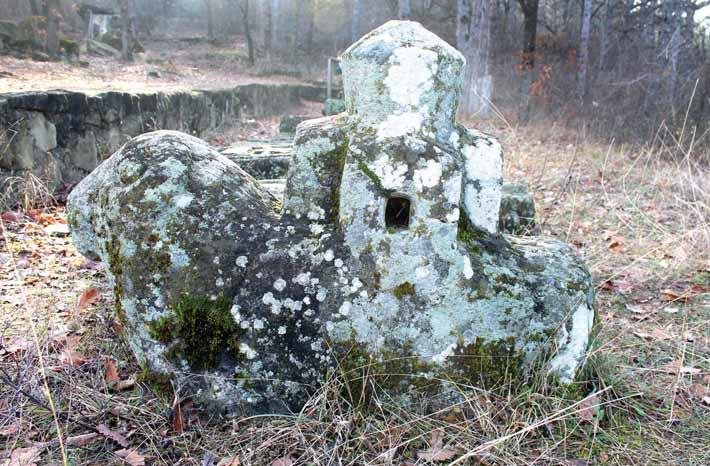

155
A sculpture of a ram with a church model on the back
A sculpture of a ram with a gable roof on the back


156
A sculpture of a ram with a dome on the back
A church model with a dome
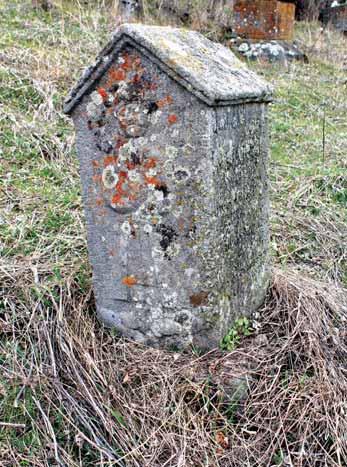


157
A church model with a dome
A tomb chest with
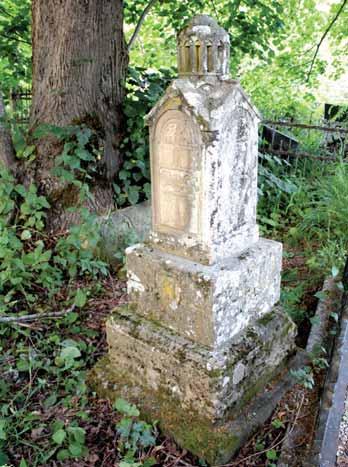



158
A tomb chest with Tomb chests with church models




159
A church model open on three sides

160




161
The master’s inscription on the pedestal of a gravestone
A church model open on all sides
254. The churchyard in Katskhi. A grave sculpture. The photograph was taken in the 1980s
 MANON LILUASHVILI
MANON LILUASHVILI
GRAVE
STATUES IN
GEORGIA AT THE END TH TH CENTURY
European-style, three-dimensional sculptures form a distinct group among the grave monuments of of the Georgian art of the Middle Ages, although it never developed as an independent field and was always intrinsically attached to sacred architecture. After the Russian occupation of Georgia, and from th century, in particular, a new type secured its place in the design of memorial monuments – a style of sculpture in the round fully related to the European tradition. Memorial sculptures are found in Europe dating from antiquity and gained special popularity from the Renaissance onwards. , or at least to his workshop. The monument is standing inside a small cave carved within the enclosure wall of the church of Mamadaviti. The Mkhedruli inscription above the arched roof of the entrance of the cave is only partially legible. The statue, erected on a black marble pedestal, depicts a weeping, kneeling woman . Following the construction of this monument , European style sculptures did not appear on graves for a few more decades. It is commonly known that neither the squares nor streets of the cities were embellished with three-dimensional sculptures .
Their emergence is evidence that a new artistic taste had become embedded in the memorial culture. As in other countries, the sculptures carved from marble or other stones are inspired by classical European art. The most common types in our country are sculptures depicting a grieving woman, holding a wreath in her hand by a half-column or cross, and sculptures depicting winged angels, by convention having the standing on individual graves may each carry a distinct and unique meaning, but common to all of them by the drapery of their clothes. It seems that such sculptures were not manufactured in Georgia at this early stage. They were imported prestigious and were usually erected on the graves of members of famous or wealthy social groups. It is noteworthy that such statues are mostly found on the graves of children or young people, indicating the reverence.
L. Shanidze, Georgian Soviet Scultpure, The Georgian Sculpture of the 20th c. (Transformation of Form and Function), kvali, Drosha, Newspaper Droeba
163
Ruisi. The marble statue in Khobi was originally standing on the grave of Colonel Samson Shervashidze
dressed in ancient-style clothes. The head is broken away, and the wings and hands are also partly broken. The iconography of the statue is somewhat atypical, as the sculptures of angels on graves are usually given the faces of either children or women.
The marble monument standing in the yard of the Church of the Transfiguration in Ruisi stands on the a bended knee, on a rock set on a three-step pedestal. His face is resting on his folded hand. A similar, yet Zemo Bari. According to Shota Agladze, the statue was made by Parthen Agladze in Baku at the end of the th c. for his brother’s grave, but he was unable to put it on the grave, and the statue is now preserved at
Among the sculptures of angels with child’s faces, we encounter both standing figures and figures tall pedestals, are dressed in knee-length dresses, the hems, collars and sleeves of which are decorated with ornamental lacework.
The figures of kneeling angels typically hold their palms joined in front of their chests in a gesture of little formal education. Besides, the monument of Sachkheuri, erected on the grave of Xenia Managadze The kneeling angel here, instead of holding his palms together, is holding an open scroll in front of his chest, while in his left hand he holds a small cross.
Most of the figures of angels with women’s faces are standing. Such statues are erected on the graves is placed beside a large cross erected on a rock. The pedestal of the sculpture displays the carved inscription with an acrostic farewell poem by Akaki Tsereteli, where the first letters of each line make up the forename and surname of the departed . In the second case, the angel himself is holding a cross decorated with flowers.
Reports about the sculpture were obtained from Oni Local Museum.
Gh merto maghalo shen ganusvene
E rtgulsa shensa. qristes mimdevars
N etar hkav igi ukunisamde!
T kbili sheasvi aq simtsariT mkvdars!
O khvrit da cremlit gamotarebuls,
164
The sculpture of an angel with a woman’s face, standing and holding flowers in front of her chest, in the churchyard in Katskhi village. According to some reports, the parents of the departed commissioned
The sculptures of young women are characterized by a greater diversity of design. In their depictions, their faces and their postures show profound sorrow and grief. The figures of women are most often depicted standing by either a column cut in half or a cross. Women, with their heads bowed and holding wreaths, are either leaning upon the column or the cross, or they are holding it with one hand. We may
Sometimes the sculptures of standing women hold only a wreath or a tree branch in their hands. We
Among the sculptures of grieving women, the monument on the grave of Ilia Chavchavadze stands out for its cultural and historical importance. The grave monument was made by sculptor Ioakob Nikoladze and we will styles and Georgian Revival architectural style. The French media of that time highly valued the bronze .
The figures of grieving women are sometimes seated, sometimes kneeling on one knee. Such her head bowed, and embracing the cross with both arms. The monument in Nukriani, however, consists of a lateral depiction of a seated woman, holding a wreath in one hand and resting her face on her folded right hand.
R iskhva aride maghlit ufalo.
A braamisa tsiagsa shina
B ina miudzgven shen dzalta-dzalo.
A ha mkitkhvelo! es tsru sopeli
SH uris budea da ugnurebis!...
I tsodet. ambobs amas vinc lod qvesh
DZE vs, ambobs, da tvvit ar ekurebis!...
N. Gengiuri, The Late Medieval Buildings in Kakheti and Kartli (Materials of Expeditions of 2004-2005),
The inscription is no longer legible on the gravestone. Information about it was provided by Eleonora Gelashvili. For the history of the monument see: E. Kiknadze, Ioakob Nikoladze, Theatre and Life,
165
. All we know today of this stolen statue is derived from head covered by a headscarf, and her hands holding flowers and resting on her lap. A poem by Dominica of the pedestal . Christ in the churchyard of the Church of the Nativity of the Mother of God in Borjomi, erected on a
At his feet is a depiction of his traditional emblem, the eagle. The statue formerly stood on the grave of someone named Baindurashvili , at the Roman Catholic cemetery in Kutaisi, but it is now preserved at the Kutaisi Historical and Ethnographic Museum . The inscription DELIN FRÈRES, PARIS inscribed on the octagonal pedestal of the sculpture, informs us that the work was produced at the famous workshop of the brothers Delins in Paris, which produced thousands of sculptures using ready-made patterns, at the th th centuries. This statue is indisputably made at that time by the same process. . These monuments depict the writers from the chest up and are placed on pedestals decorated with Georgian ornaments. The the sculpture, the head faces forward. The initial version of the monument, as illustrated in the sketch, . monuments in which the emerging Georgian Revival style is apparent. The observation of surviving monuments indicates that the production of European-style sculptures th th centuries. We know very little about the masters workshops functioned in Tbilisi. The two most prestigious of these were located at the place known today as David Agmashenebeli Avenue. The Italian sculptors who owned them were Angelo Andreoletti,
The photograph was published in the newspaper Sakhalkho Gazeti gazeTSi: saxalxo gazeTi, suraTebiani damateba
And ceased is the laughter with tears, pain and joy fully blended, Indebted to thee, may all Georgia disdain to forget thee, Raindi, Spektri, Newspaper Iveria, Sabchota Khelovneba, the case of Dimitri Kipiani. The project concerning this monument is preserved at the Central Historical Archive of Georgia, Georgian Calendar for 1905
166
Bernardo Vila and Antionio Rizzi. The workshops produced gravestones and other sculptural and architectural décor intended for a variety of purposes. This is evidenced by an advert for A. Andreoletti, which displays different types of grave memorials. As the newspaper Iveria the monument for the grave of Nikoloz Baratashvili was made from stone brought from Algeti, at the
. The monument was , although now it is in the pantheon of Mtatsminda. As Natalia Gengiuri notes, this monument was likely made at the same workshop in Tbilisi which produced the above-mentioned sculptures in Melaani and Mejvriskhevi . They resemble one another almost perfectly. Apart from marble workshops, where professional craftsmen were employed, it seems like local masters in villages also attempted to follow the new fashions, and produced statues inspired by European
that the craftsmen who carved them were less qualified in creating three-dimensional sculptures. I have already mentioned three such works. It is worth considering that many of them probably vanished
head, depicts a woman seated on a chair holding a lock of hair in her folded right hand, while she holds a small wreath in her other hand, which is placed on her lap. The posture and clothing of the figure attract attention. A lace surrounds the hem of the long dress, while the blouse is especially decorated grave sculpture , which is now missing. It is worth mentioning that we encounter a number of graves intact.
. It displays an angel with wings and the face of a woman, leaning against the vertical rock, and holding an incense burner in its left hand. It is obvious that he imitated European masters while creating his own variation. compared with typical European works. She is holding a wreath in her right hand and leans with her left elbow on the surface of a pillar cut in half. Her head is resting on the palm of the same hand, as an the stonemason Ioseb Tkemaladze , about whom nothing is known.
Newspaper Iveria, According to the newspaper Tsnobis Purtseli, it was planned to replace the lyre with the depiction of Pegasus, while the newspaper Iveria claimed that the plan was to replace it with the bust of the poet, although none of these plans has been carried out, (newspaper Tsnobis Purtseli Iveria Newspaper Iveria, Mtatsminda, N. Gengiuri, Late Medieval Buildings in Kakheti and Kartli, (Materials of the expeditions of 2004-2005), Ibid,
E. Nadiradze, The Memorial Culture of Georgia,
167
. This is a depiction of a standing woman, which at present is secured within the concrete step added recently to the pedestal. The legs of the statue are missing and the head of the sculpture is also severely damaged. The facial features and hair are not discernible, although the traces of paired braids flowing down her back to the level of her waist are still visible. The woman, dressed in a long dress, is depicted with her arms crossed over her chest. The
rendering of the body, its almost block-like construction, the posture with arms crossed over the chest, and the braided hair, recall the depictions of women carved on tomb chests. Therefore, it may be said that in this work, the European influence is discernible only in a rather general way.
An interesting bust from the Gochoura cemetery in Kutaisi reflects the artistic and aesthetic changes
woman dressed in Georgian dress and chikhtikopi was first placed on a tall pedestal open on all sides, but now it has fallen. An eclectic approach is created by the combination of the new form of the grave monument and the traditional Georgian dress.
The grave statues discussed in this article represent a significant element of the heritage of Georgian th th century. Despite their greater or lesser artistic merits, they all are valuable as an illustration of the introduction of new themes and artistic forms in grave monuments.
168
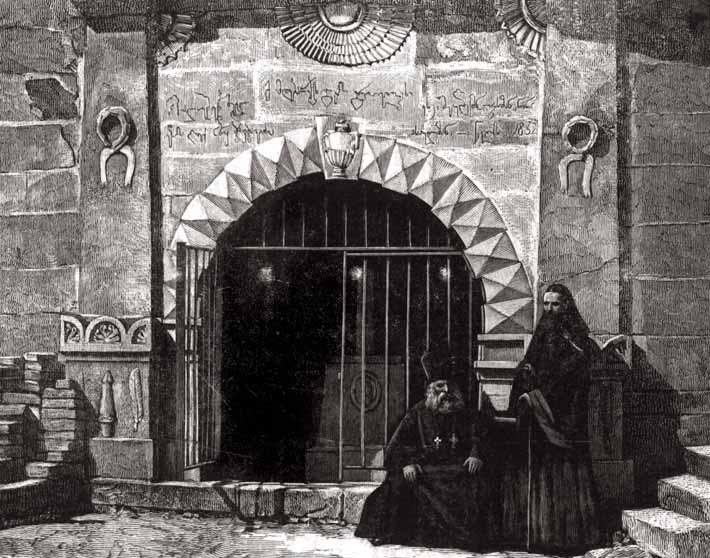



169





170

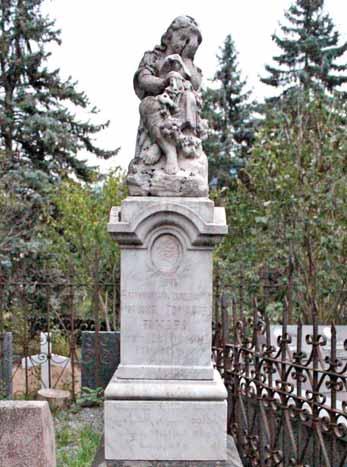
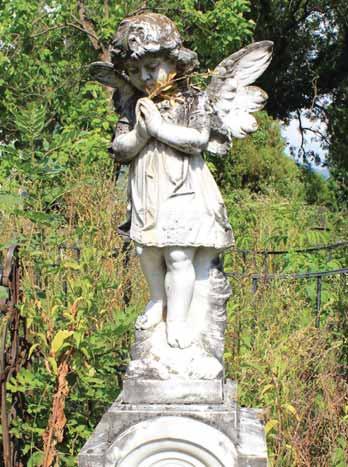

171



172
A grave sculpture of an angel
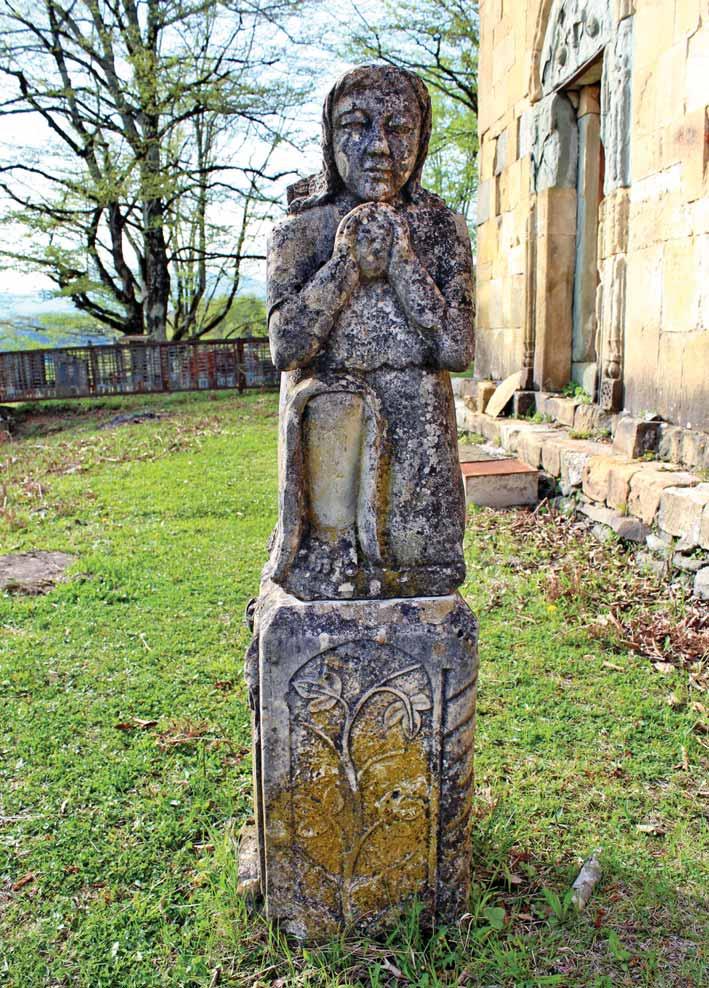
173


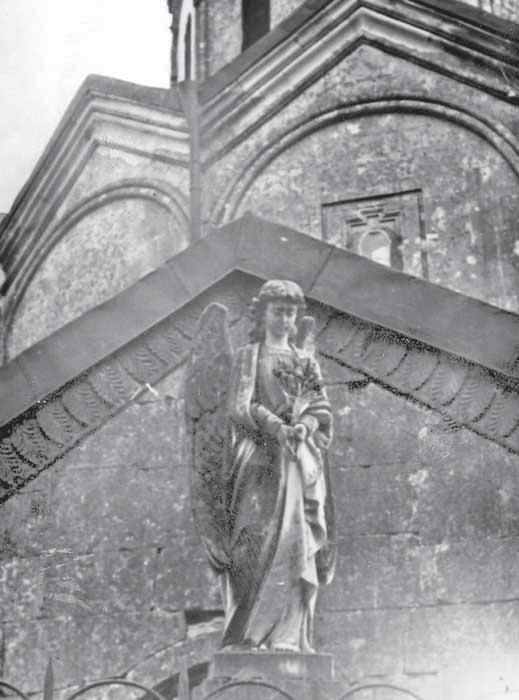

174


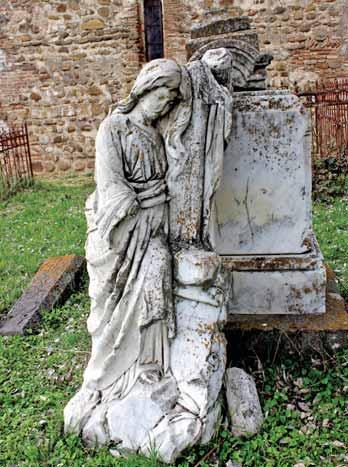

175
A grave statue
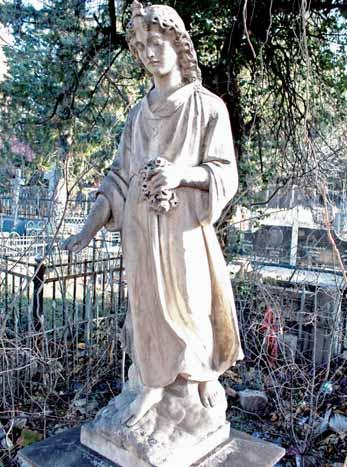



176
The statue for the grave of Maria Badalova

177





178
the Mother of God in Borjomi. The sculpture of Christ St John the Baptist from the Roman Catholic Cemetery in Kutaisi.


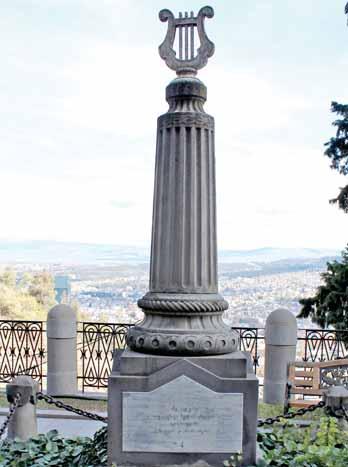

179


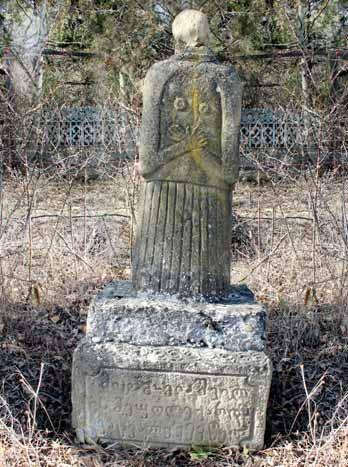
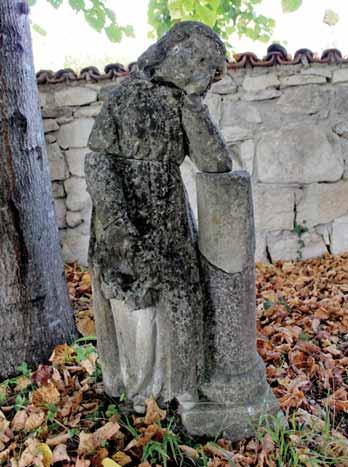
180
A grave sculpture
A grave sculpture
Mito Gogiashvili and his wife

181
 293. Akhalsopeli (Bza). Grave monument
GIORGI PAPASHVILI
293. Akhalsopeli (Bza). Grave monument
GIORGI PAPASHVILI
GRAVESTONES, EVERYDAY LIFE AND MATERIAL CULTURE TH TH CENTURY GEORGIA
th and the
th centuries, one needs to study the peculiarities of both the contemporary life and the material and its prevalent socio-cultural background, within which a process of intensive secularization of Georgiaters or clothes, but also labour, tools and ornaments . Therefore, the gravestones preserved in many historical areas of Georgia are immensely important and abide in a mutual relationship with material culture works . Despite this, these monuments are bearers of immensely significant information – throughout the centuries they have been creating a visual record of the life of the people, both spiritual and material. Theyisting with the traditional fields of the arts, to which they are more or less related by the common use of materials and visual symbols on the one hand, and by the illustration of purely utilitarian elements on the th c. was usually determined by the medieval traditionsth cc. are produced during a period more or less from the end of serfdom in directly linked with the formation of new artistic traditions such as academic painting and photography, combined with the influence of the social and economic reforms of the period. In the monuments of the th c., which mainly follow the schemes formed in previous centuries with no alteration, almost nothing is special, either in artistic or iconographic terms. Along with the increased ubiquity of gravestones decorated with images, we also witness a general decline in the artistic level of craftsth c. Therefore, the study of gravestones, which in the past was generally carried out from the perspective of history and ethnography, holds considerable interest for us in terms of the history of visual symbology. th thcesses of modernization, Europeanization, and urbanization of village culture were taking place in Geor-
Gantiadi, Matsne Dzeglis Megobari,
183
In marking the chronological boundaries of the fine arts, one should highlight that simultaneously with th and teaching career, while photography gained its foothold at the opening of the first permanent atelier
th century, European style academic painting and photography were spread across Georgia by both local and foreign masters, although initially, it was a privilege enjoyed solely by the upper social class. Earlier, in the first half of the same century, the dominant group within the painting was the Tiflisi school Bagrationi royal family. Gradually, it became possible for people of different social classes to have painted or photographed portraits of themselves, their family members or the people they admired. Slightly later, and so the genre of ethnographic photography emerged. Previously, visual records of ethnography took the th century, and especially during its last third, gravestones erected in cities and villages, became increasingly widespread. Gradually, it became prestigious for all social classes to have a photograph, and even family photo albums during their lifetimes, and. I think it would not be unreasonable to discern a certain principle of hierarwould commission their painted portraits in their lifetimes, to render their memories eternal. Photographs were more or less accessible for everyone, while gravestones, as already mentioned, carried the only image after death, and therefore acquired a sacral meaning. In a sense, this could be seen as a continuation Ktetor . It is mostly prompted by Eastern use of relief or sculptural images of the departed on their gravestones th century carry any pagan tries to replace the body of the departed with the image, where the soul will find its rest and continue its absence , formerly the privilege of kings and nobility, turned into a genS. Kvaskhvadze, Giorgi Maisuradze: At the Origins of Georgian Realistic Painting, Ars Georgica (www.georgianart.ge M. Tsitsishvili, Georgian Portrait Painting of the 18th-19th cc.
Georgian Secular Miniature: 16th-18th centuries, The Late Medieval Folk’ Mural Paintings of Georgian Churches, E. Panofsky, Tomb Sculpture. Four Lectures on its Changing Aspects from Ancient Egypt to Bernini H. Belting, An Anthropology of Images: Picture, Medium, Body Classic Essays on Photography, Edited by Alan Trachtenberg, New
184
eral by displayed symbols of religious belief and socioeconomic status.graphs: both show frontal depictions of human beings, usually depicted with all those items which were precious to them during their lifetimes, including weapons, labour tools, awards, precious or unusual accessories, clothes or household items, and items associated with the identity, character, and the habits of the departed. and culturally, to depict guitars and sewing machines as rare and precious items of daily life, and pre-picting professional tools, the depiction of a musical instrument emphasizes the prestige and commitment with which they raised their daughter, educated her and gave her into marriage with honour and dignity. The tradition of giving a dowry to a woman, like her radical relocation and her move into a newvealed especially in the relationship between regions separated from one another by a great distance. In our case, it manifests in different shapes and iconographic elements of the gravestones, which somehow brought from a different region or by other similar factors an inclination toward light-heartedness and revelry but also stand as visual representations of supplicath th drink are left on the grave so that the poor could be fed in the name of the departed, or that a stranger passing by could raise the glass and honour the departed. In fact, there is no region in Georgia where we faith and nurtured to become social habits. It is significant that the objects which people in Javakheti region usually refer to in the local folk slang include clothes, weapons, or other objects which were used by the living (as de-share for a ploughman, an anvil for a smith, a gun and various weapons for a hunter or a soldier, a cotton spinning wheel and sewing machine for a housewife, etc . These items from everyday life are directly linked to the departed, the lives they lived, and their occupations, and are even considered to be inseparable from them after they passed away since they have acquired symbolic meanings, and constitute links between this life and the life after death. Some scholars consider the depictions of material objects on gravestones such as dishware, weapons, and food to be visual symbols transformed from everyday life,
Metsniereba, Tbilisi, Enimkis Moambe, Froni Gorge, The Kavtura Gorge, Borjomi Gorge,
S. Khositashvili, The Wedding and Burial Customs, in Samtskhe-Javakheti (Ethnographic Essay), N. Abesadze, Craftsmanship and the State of Craftsmen in the Cities of Georgia (the second half of the 19th c. and the beginning of the 20th c.) Trialeti,
185
and note that Christianity, while preserving a memory of the tradition of carving objects on stone tombs
It has been proven ethnographically that according to old customs, young people were buried in wedusually means a newly wedded woman in the folk tradition. Stones shaped into cradles were oftentraveller Baron De Baye is particularly interesting, as it includes his photograph taken contemporaneoussymbolize the eternal cycle of life and death come back home and change into mourning garments. In different parts of Georgia, both men and women would keep wedding dress and Chokha-Akhalukhi be buried . All this, which is related to the dress code of the departed and the widow, emphasizes the the soul is united with the eternal world.
Apart from clothing, the other elements found in these images of immortality are household tools and military weapons. To understand their significance, it is interesting to consider several observations concept regarding their use in the life after death. The tools and weapons here are direct reflections of the professional occupations of the departed people… Apart from the tradition, it would be inappropriate per se, people, but it is also a matter of fact that even today we encounter cases of not only putting personal items, creating an echo of the pagan worldview and customs. This could form a subject of study for modern social and cultural anthropology. I think here we are dealing precisely with images and acts perceived as symbols, which have a function more social than sacral, and in the way, these are revealed through the and occupation of the departed, and as symbols of their earthly ministry, giving hope to other people for their own salvation. Epitaphs, including words describing the occupations of the departed, which are not
Materials for the Ethnography of Georgia, Translation from French, the
International Conference Pirosmani and Georgian Culture, Proceedings Tradition and Modernity, Ethnography / Ethnology of Georgia
E. Nadiradze, The Symbolism of Memorial Monuments
186
always attached to the depiction but sometimes enjoy an independent significance,can be distinguished only by their appearance. By mentioning the person of the departed in an epitaph, a verbal portrait.
The abovementioned depictions contain important information about different social classes, and theirstone images and material culture, it is worth noting, with E. Nadiradze, that apart from the labour tools characteristic of different regions (in this particular case the scholar considers the topic of the ploughmen between the sizes of the plough necessitated by the peculiarities of the soil and terrain, or the numberpicted on many gravestones, and can be found embellishing almost any monument – especially on those professional life of the departed, he would present a saw, a pair of compasses, a carpenter’s scribe, awas taken indoors in the studio, is holding a whip – a characteristic attribute and is wearing a special same can be said about the depiction of a woman, who may be depicted either in paintings or in photo-thtume; later, however, we see bandoliers either across the chest or wrapped around the waist, and also a gun and a sword, which are objects of a more professional kind. Besides, even though we frequently see professional accoutrements and depictions of animals on many gravestones without any depiction of the departed, we cannot say that they are always related to household activities: the image of a sheep as the lamb of God, found in many parts of Georgia, signifies the quest for the salvation of the soul of the departed, rather than that the departed was a shepherd. Also, a saddled horse without a rider may not necessarily mean that the departed was a soldier.
Ph. Ariès, The Hour of Our Death, Knopf E. Nadiradze, The Symbolism of Memorial Monuments
187
It is also important to note that apart from the above-mentioned peculiarities and the shared elements emerging from within the general socio-cultural environment, the gravestones differ according to their ethnic, regional and confessional particularities. It is also worth paying attention to the fact that pleni-
tion of a human being. Among the works with which I am familiar, only one gravestone formed as a model church at the Roman Catholic cemetery in Vale displays a small, relief-carved image of a human beingis understandable if we keep in mind that often several villages or even the whole region were served by the same stonemasons. In the process of compiling the entries of the descriptions of gravestones, it was found that two such gravestones in the villages of Chashleti and Kisoreti had the same master, whose family name was Bandzaladze.
The main distinguishing features of the gravestones in the Roman Catholic villages in Samtskhe are the depictions of the bishop’s crozier, mitre, thurible, chalice and other items carved on large, low andizabavra, distinguished by their generally Georgian iconography and style of masonry. We must presume that in this case, the clerical insignia and church equipment did not have a direct influence on the design divide into two groups – those with a silhouette of a human being, with the turban headpiece folded around the head, and verses from the Q’uran covering the body as a symbol of faith, and those others which are merely decorated with floral motifs. The first group seems to be invariable, and this style was probably introduced by the Ottomans during the late Middle Ages; we can discern minor variations only in the manner of stonemasonry. On the other hand, the floral decoration for both Christians and Muslims from a simple flower to a large, multi-stem, fruit-bearing plant . It is worth noting that the use of the vine motif, commonly known as the tree of life is widespread in the décor of the medieval gravestones in Georgia, which points to the continuity of the tradition. The tombstone in the Village of Gantiadi, near
As mentioned above, the people of different ethnic origins or confessions often shared the same, similar or only slightly adapted traditions of decorating tombs. In a multi-cultural region, such as Samtand Armenians. The Greeks and Armenians were brought here from the Ottoman Empire after the RusIslam who chose to move to the Ottoman Empire . Although the author does not address these gravestones directly, it is still obvious that the newly settled ethnic groups would come across local traditions th c. onwards, they would partly follow and partly transform. The
Ottoman ornamental décor of the graves at the Jewish cemetery in Akhaltsikhe, and the monuments of the Armenian settlers during the Russo-Turkish war, which are slightly different from the Georgian tombs etc.
T. Ghudushauri, The Memorial Culture
E. Takaishvili, Archaeological Expedition to Kola-Oltisi and Changli in 1907,
188
Another important issue concerning gravestones is the depiction of clothing, which has been documented by these material monuments, along with ethnographic portraits in painting and photography. It than and Georgian styles, especially in women’s clothing . The peasant clothing common at the end of the century, however, is similar to the clothing of the lower classes living in the city, in both its pattern and decoration. Minor differences according to the region are readily observed, even in the photographs andmonly known, was the last to pass out of use in various cultures . Most often, the departed are depicted on their gravestones dressed in full, almost festive attires and such monuments, due to their relatively fine preservation status, give us an almost full impression of the traditional clothing of the time. However, since the focus of our interest is presently drawn to the representational character of the depiction andsenting their souls as they face the final judgement, while at the same time presenting their identities in rather conventional ways.
There are a few traditional gravestones with depictions of the nobility, which differ from the gravestones of wealthy citizens only slightly, while according to their artistic qualities they fit perfectly into the general trends, without emphasizing the social status of the departed in any way. One among them is the displays the full-length depiction of a man dressed in a flounce-sleeved tunic-akhalukhi and wearing a tall papakha in the yard of the Church of St George in the village of Kvibisi in Borjomi Gorge. A man is depicted on the surface dressed in chokha and“accordion-fold” boots, which were fashionable at the time both cases, attention is drawn to the details of the body and accessories carved in great detail (although no evidence that a different rule was applied to the tombs of the nobility. The paucity of the tombs of the nobility may be caused by the fact that the graves of the Georgian noble families serving as members of the imperial military or civic service, according to the Russian-European customs of the time, display long pictorial element at this time is limited to the family coat of arms and the motif of grieving angels (Fig. -
th . This thesis is true in principle, but beginning from and the same may be said about the capacity for decorating gravestones.
Ts. Bazerashvili, Georgian Clothing, Shida Kartli,
S. Makalatia, Borjomi Gorge,
189
In different parts of Georgia, the ritual of lamentation included, with slight variations, the tradition of displaying the clothes, weapons, tools and personal items of the departed, which is confirmed in the description of the wake of King Erekle II not only among the nobility, but also among the liberated peasants, and this fact is reflected in the decorations of a multitude of gravestones. The symbolism of the depiction of a riderless horse is also noteworthy. This was adopted from the customary funerary procession, where a saddled horse covered with black fabric and a gun hanging on its saddle was led behind the coffin. Prior to the procession, during the wake, the horse was tied to the door of the house or sometimes even by the head of the coffin – the custom considered to be specifically Caucasian
be tied to the hand of the departed on the day of the burial . Usually, the horses are depicted in this concases, is spread across a different facet from where the depiction of the departed is placed, in this way
th c, in PshavKhevsureti, Kakheti, Kiziki, Guria and Samegrelo, it was customary to bury different items together with the departed by placing them in the coffin . In Eastern Georgia priority was given to food, tobacco, drinks, bread, combs, mirror, nuts, and silver coins; In Kakheti, if the departed was a man, they would put a bottle of wine and a knife in his coffin, while a knife, needle and threads would be put into the coffin of a woman.
displayed on gravestones along with crosses, doves, angels and candles, thus indicating their significance. * * * th th centuries, gravestones and memorial culture, in general, were reflected in contemporary painting and photography. Gigo Gabashvili produced several paintings on the subject, such as The Festival, also known as The Churchyard Cemetery at Dawn
held on the feast days of the Church in eastern Georgia, where people prayed, got married, and baptized their children. The festivals often acquired a special significance, because they gathered relatives settled in different regions who had not seen one another for a long time, and here they ought to honour their dead ancestors.
Blessing of a Tombparted together with a priest; the painting differs from the paintings by Gabashvili due to its sense of intimacy, and it obviously conveys the personal emotions of people. A similar painting is At the Grave of One’s Own Child
In the unique and somewhat grotesque drawings by a self-taught artist living in Tbilisi, Vano Khojabegov, called A Groom Dancing on his Father’s Grave and A Groom Dancing on his Parents’ Grave (Fig. is dancing there in front of his companions and shawm players. Such a bizarre action depicted in the art would have remained unintelligible without the novel Givi Shaduri written by Mikheil Javakhishvili in Iveria,
190
T. Ghudushauri, The Customs Related to the Departed Tsnobis Purtseli
son would climb up on the tomb of his father and would dance there holding a clay jar, with a baghdadi (a zurna. By doing so he trampled down death with life, kicked the eternal non-being with temporal being, preferred an enclosure to the open field, fa. The painting depicts a specific ritual, when a newly wedded man brings the good tidings of his happiness to his parent, and thus emphasizes the link between the past generations and the continuity of life.
The prevalence of photography and gravestones carrying depictions of human beings, both emerged another, as photography depicted one’s real likeness in a lifetime, while the generalized image on theer, European style obelisks would include a special place in which an oval-shaped photograph could be
Any aspect of material culture could be recorded on gravestones, and therefore it is not surprising that photography is another sphere loaded with information. Photographs often depict the same, similar, orple of the combination of themes is found in the depictions of ram and human beings, which are often encountered in tombs and photographs, and in the paintings of Niko Pirosmanashvili and others , (Fig.
Niko Pisormanashvili’s approach to traditional tombstones is particularly interesting; the artist never depicted the funerary theme as a principle content of his painting, but his creative work, is also nourished by this stream, alongside other sources of inspiration . Throughout the period when he worked, the tradition of decorating gravestones was alive and active, and the artist himself witnessed this tradition and according to some sources, even took part in the decoration of some tombstones – according to the contemporaries in his native Sighnaghi he inscribed images on the tomb at the request of stonemasons
To the present day, the gravestones which were created with the involvement of Pirosmani have not been identified. In general, certain recurrent patterns are observed in many parts of Georgia, where depictions found in different villages, especially those of human beings, are almost identical, and Kiziki and Mirzaani to the depictions on gravestones, through features such as the block-like appearance of shapes, the generalizing flatness and the parallel appearance of different planes (the surfaces of figures and items are being represents a social type rather than an individual person. * * *
th century, the religious idea is reduced to the mundane, and the eschatological vision is replaced by the emotions and feelings of a human being, hidden beneath religious
M. Javakhishvili, Jaqo’s Dispossessed; White Collar; Givi Shaduri, Ars Georgica (www. georgianart.ge
Ars Georgica (www.georgianart.ge
191
. This was particularly well demonstrated by Goderdzi Chokheli in his short film Resurrectionple and the elderly tell the filmmaker how they lived and passed away, how they are related to him, what bothers them in their eternal dwelling place and what they lack.served their altered but still constant forms over many generations, up to the time of making this film. In of the century. Only the artistic quality indicates that the tradition is beginning to fade away, a process creativity.
In the process of understanding the relationship between the human figure and the material world, observations of depictions on gravestones in different epochs allow us to follow the developments and changing characteristics of these gravestones: The earliest stage presents separate monumental depictions, perceived as subject-symbols, such as the depictions of a bow, sword, arrow, crook and other objects, a more material significance because they refer to the occupation of the departed by displaying the group of items associated with it. Later we see the full-length depictions of human beings in death (with closed
th c., human beings are depicted as being in direct physical contact with the depicted items – they are armed, or working at their crafts, or from generalized conventionalism to daily concretism, and from symbolism to illusory representation.in the relationship between the human figure and the material world. The first among them (the ram -
From this, we may make a sound inference as to why traditional gravestones disappeared from our character of any monument of material culture is conditioned by the social practice based on religious should seek the reasons for the disappearance of such monuments among the weakened local traditions facing resistance from global influences. The ideas embodied in gravestones ultimately die when their related rituals and customs no longer underlie society as connecting bonds, uniting spiritual and material
192
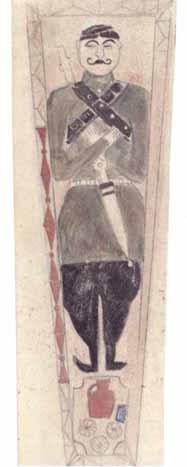


193
Depictions of a guitar and a sewing machine on a gravestone
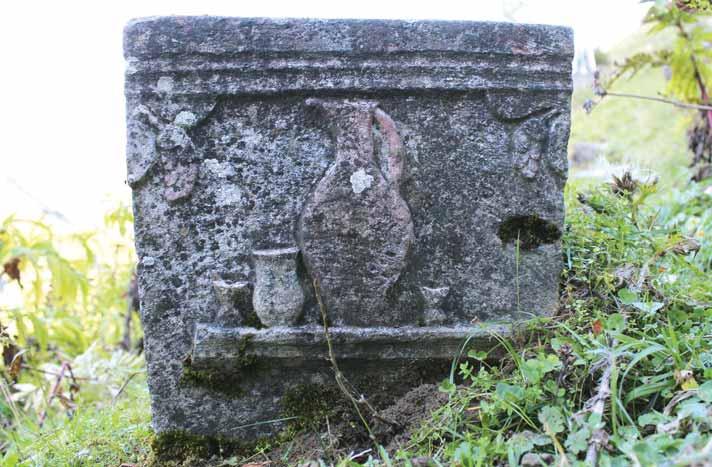
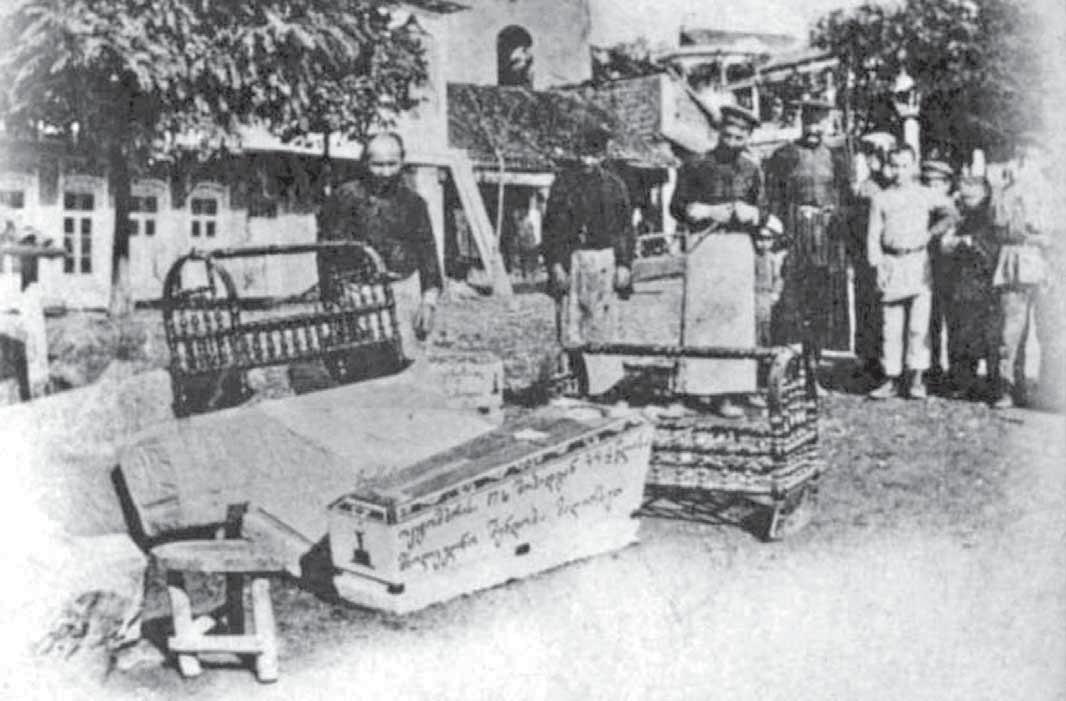
194 th c.
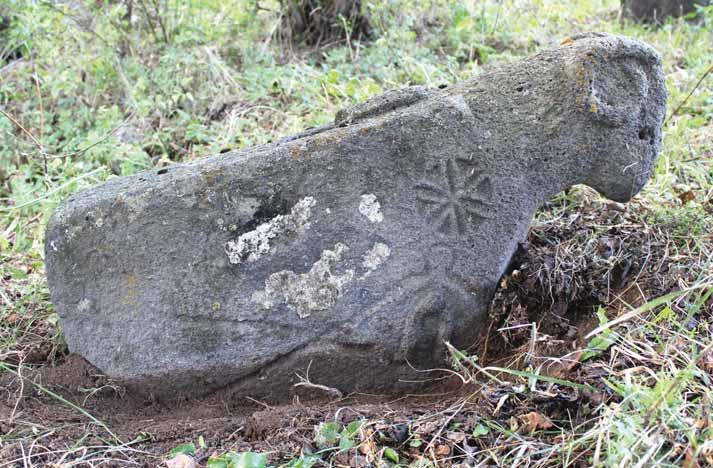

195
A Ploughman
A sculpture of a horse decorated with



196
A tomb with a relief depiction of a man
Depictions of a horse and tools on the side facet of a tomb

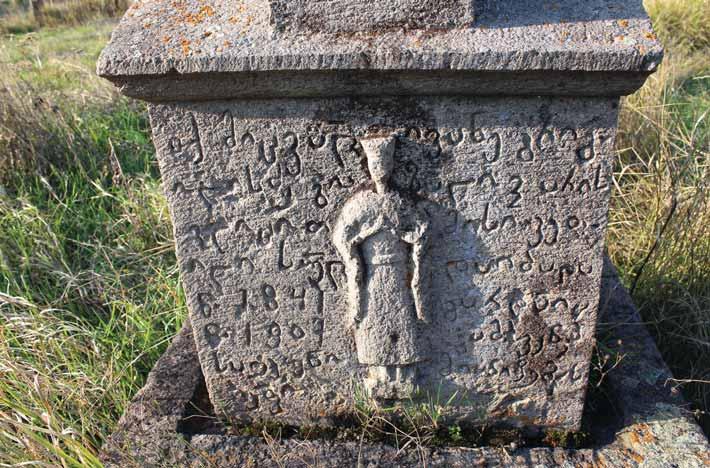

197
A church model
A gravestone with



198


199
th c.
King Erekle II


200
th c. th c.




201



202
the depictions of a man and a ram th century

203
A man holding his hand akimbo


204
A sculpture of a ram decorated with the depictions of the smith’s tools
The photograph of the gravestone of Iliko Dzotsenidze

205
 Ude, the old cemetery
Ude, the old cemetery
NODAR ARONISIDZE
INVENTORY OF GRAVESTONES
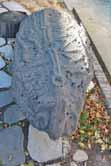

TBILISI
1. Churchyard of Anchiskhati Basilica, Tbilisi, 150×77×10 _ A composition with many components is depicted on the surface of the tomb. A large part of the composition is not clearly visible. We see a long plough all along the edge of the surface. All its details and the twelve bulls attached to it are clearly visible. We also see a small but full-length, frontal depiction of a human being, a mirror, a comb, a smoking pipe, an anvil, a hammer, a shepherd’s crook, a wedge, a horse and other smaller elements, which cannot be identified.

2. The churchyard of Anchiskhati Basilica, Tbilisi, 200×92×15 _ Depictions are placed on the back of the sculpture of a ram, showing a twisted torus-moulded shape on one half of the whole area and a mesh-like, crosshatched depiction on the other. The sculpture of the ram is rather unique, in that it is lying down. The feature that makes it possible to identify the species of the animal is the curled horns on one end. The area of the back is divided into two equal sections by a long border, decorated with torus-moulded and circular segments.


Epitaph: A two-line Asomtavruli inscription with abbreviations is found on the back of the ram around the head area. It has been published as read somewhat differently by various scholars. Here is a version by E. Nadiradze verified by V. Silogava, which reads: “Christ, have mercy on the soul of Father …”1. It should be noted that according to the summarized theories of scholars, analogies and the paleographic study of the inscription, the mentioned gravestone belongs to the 12th-13th centuries.
1 E. Nadiradze, “The oldest example of a zoomorphic monument from Javakheti”, Khelovneba [Art], N 3-4, 1993. Here I should also quote the epitaph as read by L. Melikset-Beg “Christ, have mercy on the soul of Engate [Erasti]” (L. Melikset-Beg, Megalithic Culture in Georgia, Tbilisi, 1938, p. 105).
207
3. Open Air Museum of Ethnography, 180×63×100 _ The tomb is designed as a sculpture of a ram, carved out of a monolith. The animal is identified by its broadly carved, curled horns around the area of the head. We also see the elongated snout of the ram, and its mouth, indicated by a simple line. A halter is wrapped around the neck of the ram and a small church model is sitting on its back. The roof of the church is decorated with a series of grooves.

4. Open Air Museum of Ethnography, 120×35×85 _ The gravestone is in the form of a sculpted ram, carved out of a monolith. The animal is identified by its curled horns around the area of the head. A large church model, with a low, sloping roof, is sitting on the back of the animal. A small rectangular hole is cut into the wall of one of the facets, which indicates a doorway.

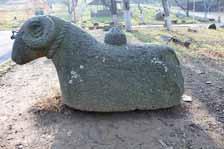

5. Open Air Museum of Ethnography, 72×76×30 _ An arm holding an undrawn bow by its grip, is depicted on the main surface of the tomb. Under the arm, we see a sword and a large arrowhead. Different areas of the surface are decorated with circles and circular bosses.

208
6. Open Air Museum of Ethnography, 170×88×34 _ A two-wheeled cart is depicted on the main surface of the tomb. The upper part of the surface is framed from one side of the composition by a pair of twisted borders. The whole area of the surface is covered by the depiction of the cart, spread along the vertical axis, with a wheel on both sides. Different areas of the surface are embellished with rectangular and circular protrusions, while in the upper corner of the tomb we see a cross and a circular object which cannot be identified. This may have been a container for collecting rain water for ritual purposes.


7. Open Air Museum of Ethnography, 175×60×38 _ The only depiction is found on the main surface of the tomb, where we see a horizontal section with a steep gable roof decorated with lines, and torus-moulded segments between the lines, thus imitating roof tiles. The horizontal “corpus” probably represents a sepulchre – this view may be supported by the fact that the soles of the departed’s feet are visible on the lower facet. The feet are displayed in such a way that they seem to protrude from beneath the sepulchre.
8. Open Air Museum of Ethnography, 177×70×22 _ A generalized motif of architectural décor is placed on the surface of the tomb. We see a pair of torus-moulded pilasters with circular and rectangular details at both ends _ a decorative element typical for the Georgian architecture of the Middle Ages. In one place, circular motifs are observed, ranging along the line of the pair of torus-moulded pilasters.


209
9. Open Air Museum of Ethnography, 127×65×28 _ A composition consisting of various elements is displayed on a section of the surface of the tomb. In the central area, we see an undrawn bow. Around the bow, we see ornamental motifs carved with a very thick torus moulding. We see rectangular and circular protrusions of different sizes, the function of which cannot be identified. On the upper part of the tomb, we see a horizontal board with a hole on top. It is difficult to identify the purpose of this board, although, considering the broader context of the images, we might suppose it to be an archery target. The composition is surrounded by a torus-moulded border, randomly decorated with small hemispheres.


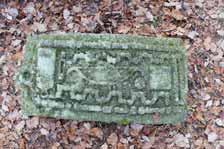
10. Open Air Museum of Ethnography, 60×28×45 _ Images are carved on the sculpture of a horse, although severe damage makes it difficult to perceive the full picture. The sculpture is broken in half, and one of the parts is missing. The surviving part displays the front of the horse – we see a bridle, saddle and stirrups coming down from the saddle. On one of the flanks of the animal, we see a large axe, and on the other, some unidentifiable objects– one of these may be a bandolier, and the other a pistol or a dagger.

11. Kojori, Tbilisi, 155×54×32 _ A full-length, frontal depiction of a woman is displayed on the surface of the tomb. We see her highly individual, stylized hairstyle, her long dress decorated with buttons, and a medallion on her chest, earrings and shoes with heels. The woman has her arms crossed over her chest in accordance with Christian custom. The depiction is surrounded by a double frame. The internal border is finished with a trefoil arch above her head, while a floral ornament is used as the outer frame, covering the bevel-cut edges.
Epitaph: Different inscriptions on different facets are readable in fragments: “at the age of 25 on July the 4th, grant me forgiveness…”, “I am grateful on behalf of Datiko…”.

210
12. Kukia Cemetery, Tbilisi, 120×43×25 _ A figurative composition is placed on the surface of the tomb showing a fulllength, frontal depiction of a woman. Different facets display decorative elements, while the edges of the main surface are covered with floral ornaments. Among the elements of clothing, we can see her shoes with heels, a chikhtikopi headpiece, hair flowing down from it, and a long dress decorated around the chest area and buttoned up. The dress is decorated with wave-like, engraved lines around the waist and the hem. The woman has her arms crossed over her chest in accordance with Christian custom, while the half-length depictions of two angels are observed above her head, inside the ogee-arched header of the border.
13. Kukia Cemetery, Tbilisi, 144×50×38 _ A composition found on the main surface of the tomb shows a full-length, frontal depiction of a woman covering the whole area. Decorative elements are observed on different facets of the tomb, while the edges of the main surface are decorated with floral ornaments. Among the details of the woman’s clothing, we see her chikhtikopi headpiece, with her hair flowing down from it, her cross necklace, a long dress fastened with a belt with long fringes, and shoes with heels. The woman has her arms crossed over her chest in accordance with Christian custom. The half-length depictions of two angels are carved above her head inside the ogee-arched header of the border.
Epitaph: Long Mkhedruli inscriptions are placed on side facets of the tomb, which are illegible.
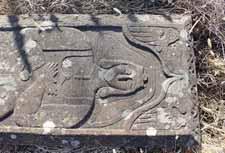


14. Kukia Cemetery, Tbilisi, 72×46×55 _ Depictions are found on the main surface of the tomb, although they are not clearly visible due to severe damage. The stone is broken almost in half, and its lower part is missing. The surviving segment displays a full-length, frontal depiction of a man, from which now we can see only the remaining upper half, his robe, hat, distinctive hairstyle, and a handlebar moustache. The edges of the main surface must have once been decorated with floral ornaments. The chokha, buttoned up to the neck, is emphasized with linear elements. The man has his arms crossed over his chest in accordance with Christian custom.
Epitaph: The content of the four-line Mkhedruli inscription on the side facet of the tomb is illegible due to severe erosion.

211
15. Kukia Cemetery, Tbilisi, 110×42×46 _ A full-length frontal depiction of a woman is carved on the surface of the tomb. Among the elements of her clothing and décor, we see her highly distinctive, wavy hairstyle, her earrings and her long dress tightened around the waist area and fastened with a belt. We see her shoes with heels, and the hem of the dress decorated with lace. The woman has her arms crossed over her chest in accordance with Christian custom. The edges of the surface of the tomb are decorated with floral motifs. The border fitted to the head and hairstyle of the figure also accommodates the half-length depictions of two angels.
Epitaph: A three-line Mkhedruli inscription is placed on the side facet of the tomb. The content could not be read.

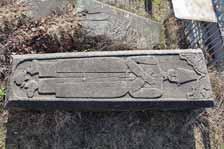
16. Kukia Cemetery, Tbilisi, 180×60×45 – A composition consisting of many elements is displayed on the main surface of the tomb. The main motif is a tall chalice shaped with three steps and a curly plant grown up from it. On the upper area of the tomb, above the plant, there is a moulded cross with a hammer and scissors placed at its sides. The upper edge of the surface is finished with a trefoil ogee-arched border, in which includes half-length depictions of two angels. The edges of the surface are decorated with floral ornaments.

Epitaph: The three-line Mkhedruli inscription on the side facet of the tomb cannot be read.

17. Kukia Cemetery, Tbilisi, 140×52×52 _ A full-length, frontal depiction of a man is displayed on the main surface of the tomb. The man has his arms crossed over his chest in accordance with Christian custom. We can see his clothes and some décor – his tall cylindrical hat, his mantle, open in front, trousers, and shoes with heels. We can also see his shirt buttoned up to the neck, and a belt around his waist decorated with a floral clasp. The man has a distinctive handlebar moustache. The edges of the surface are covered with floral elements. The area above the man’s head is surrounded by a trefoil ogee border which incorporates half-length depictions of angels. At the man’s feet, we see a lily-like flower. The upper facet of the tomb displays a cross with the sun and moon at its sides – the edges of the composition are finished with images of candles held in tall candlesticks.
Epitaph: The four-line Mkhedruli inscription on the side facet of the tomb is illegible, while the upper facet displays a

212
18. Kukia Cemetery, Tbilisi, 183×63×75 _ A full-length, frontal depiction of a woman is displayed on the main surface of the tomb. We see her long dress, long cape, shoes with heels, her hair, divided in the middle, and her cross necklace. The hem of her dress is decorated with linear elements. The woman has her arms crossed over her chest in accordance with Christian custom. The edges of the surface are filled with floral décor, while a triple arch above her head contains half-length depictions of angels.


19. Rustaveli Ave. N14-16, Tbilisi, 143×42×50 _ Depictions are placed on different facets of the ram-shaped sculpture. The area of the ram’s back carries a stylized representation of a fish and abstract geometrical motifs. The side of the ram is decorated with figurative compositions – on one side we see a jug, a full-length, frontal depiction of a man with arms akimbo, a lateral depiction of a horse, an object, which is possibly a mirror, and other unidentifiable objects. The other flank of the animal displays a full-length, frontal depiction of a man and a gazelle, scissors, a knife and possibly a comb placed beside the man. The curled horns around the head make it possible to identify the sculpture as a ram.


20. Sh. Amiranashvili Museum of Fine Arts, Tbilisi, 150×50×64 _ A large, full-length, frontal depiction of a man is displayed horizontally on one flank of the sculpture of a ram. The man has his arms crossed over his chest in accordance with Christian custom. We see his long, one-piece robe, the greatly exaggerated palms of his hands and his face with a long handlebar moustache. A cross with arms of equal lengths is carved by his head. The other flank of the ram displays a large axe, a shepherd’s crook, and below them, we see figures which are likely to be a horse and a wolf, presumably standing facing one another. The animals are depicted from a lateral view. The horse is saddled and we can see its knotted tail. The features that identify the shape of the sculpture as a ram are the curled horns around the area of the head, carved with haut-relief


213
21. Sh. Amiranashvili Museum of Fine Arts, Tbilisi, 117×41×55 _ Depictions are placed on the side facets of the tomb, while the upper and lower areas are fully covered by ornamental décor. One facet displays a frontal depiction of a man holding a cross in one hand, and with the other, a bridle of the horse standing next to him. We see his sword, dagger, chokha-akhalukhi, a distinctively individual hairstyle, and a very striking part of the face, where his eyes are emphasized by concentric circles. On the upper part of the cross, we see a ball placed on a small vertical object. The man is depicted to the level of his knees, his legs below the knees are not depicted. As part of the composition, we see a saddled horse standing on its back legs, depicted from a lateral view. The tail of the horse is knotted. A rectangular object is carved between the figures of the man and the horse, which could represent _ a comb. The composition is surrounded by a double torus moulded border on three sides.


2
are placed on different areas of the sculpture of a horse. We can see the eyes, mouth, bridle, and something like a military chamfron. A saddle is fitted to the horse’s back, from which an axe is hanging on one side and a flask on the other. On one flank of the horse is an independent composition comprising a pair of animals facing one another, although erosion makes it impossible to see the depictions clearly. On the same flank, we see a relief depiction of a dagger. The other flank contains further elements. We see a fulllength, frontal depiction of a man holding a drinking vessel in one hand. We see part of his head, drawn conventionally, and his long, one-piece garment. An animal is depicted next to him in lateral view, and a further depiction on his other side cannot be identified.


214
2. Sh. Amiranashvili Museum of Fine Arts, Tbilisi, 135×35×86 _ Depictions
23. Sh. Amiranashvili Museum of Fine Arts, Tbilisi, 96×32×46 _ Depictions are placed on the side facets of the tomb. Considering the limitations of the museum display stand, we can see only one side, on which different compositions are depicted under the three decorative arches. The middle arch is relatively taller than those on the sides. The arches are resting on the capitals of columns. The middle spandrel contains a full-length depiction of a man sitting on horseback. We see his chokha-akhalukhi, hat, possibly a quiver, hanging from the man’s hand, and a falcon sitting on his left arm. The horse is depicted in movement. We see its bridle, a knotted tail, a saddle and an axe hanging over the saddle. Behind the composition, we see a lateral depiction of a horse surrounded by an arch and tied to the column. The first spandrel is divided into two levels – the upper one displays a depiction of a man holding a ladle in one hand and a jug in the other, while in front of him we see a bowl and a plate depicted from an aerial view. We see his long, one-piece dress, a belt wrapped around his waist, his handlebar moustache and a feather and floral motifs placed vertically on his head.
24. Sh. Amiranashvili Museum of Fine Arts, Tbilisi, 162×74×33 _ A two-wheeled cart is depicted on the surface of the tomb. The cart is depicted in a disassembled state -the two wheels and a mesh-like chassis between them. At the edge of the surface, we see a bullwhip, several spherical objects and a rectangular board-like element, which is hard to identify.

25. Sh. Amiranashvili Museum of Fine Arts, Tbilisi, 84×18×72 _ Depictions are placed on the flanks of the sculpture of a ram, showing a bas-relief depiction of a shepherd’s crook on one side, and on another side, depictions of an axe, a sword and sheep-shears, placed one above another. The elements that make it possible to identify the sculpture as a ram are found around the area of the head – the typical snout and curled horns. The ram is decorated with a twisted halter around its neck and a dome-shaped motif on the back, which may suggest a church model.





215
26. Sh. Amiranashvili Museum of Fine Arts, Tbilisi, 178×66×26 _ A highly generalized depiction of a man is found on the surface of the tomb. The man is depicted only from the waist up. On both sides of him, we see different kinds of weapons – a bow and an arrow on his left, while a sword in a scabbard, a spear and a small shield are depicted on his right. Only the area of his head has slightly more detail, but his nose and eyes are rather generalized.
27. Sh. Amiranashvili Museum of Fine Arts, Tbilisi, 139×37×88 _ Depictions are placed on the flanks of the massive sculpture of a ram. On one side, we see the full-length, frontal depictions of two people, while the other side displays a lateral view of a man on horseback, and a lateral view of a deer, sheep-shears and a shepherd’s crook. Of the two human figures displayed together, that on the left is definitely a man. He is holding a scythe and is in the process of mowing the grass. The other person, judging from the individual hairstyle and different elements of the clothing and the headpiece, may be a woman – she is holding both hands spread apart and raised. She holds an object in each hand– these may be buckets for carrying water. It is possible to identify the sculpture as a ram by the curled horns around the head.





28. Sh. Amiranashvili Museum of Fine Arts, Tbilisi, 188×67×56 _ Decorative elements resembling a gable roof are carved on the back of the sculpture of a ram. The slopes of the roof are decorated with different ornaments and almost identical figurative elements are visible on both surfaces. On one side we see a lateral depiction of an animal and a full-length, frontal depiction of a ram’s head. We see his long chokha, and a belt with a dagger around his waist. The man is holding the head of the animal with one hand and with the other hand he is clutching the dagger. On the other slope of the roof, another animal is depicted with a man on horseback behind it. In front of it, we see a figure, possibly an angel holding a cross. The horse rider is wearing a pointed hat and has a sword raised in one hand.
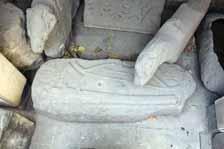
216
29. Sh. Amiranashvili Museum of Fine Arts, Tbilisi, 150×64×23 _ A composition showing work tools is depicted on the surface of the tomb. On one of the edges, a Georgian type of forge bellows, divided into two parts, is shown from an aerial view, and next to it and lined up in a row, are depictions of a hammer, a forge tongs and a dagger. The right edge of the tomb displays a cube-shaped object, which, most probably represents an anvil. The images displayed in an orderly manner on the surface of the tomb represent the tools used in a smithy.

30. Sh. Amiranashvili Museum of Fine Arts, Tbilisi, 112×31×68 _ Depictions are displayed on the side facets of the tomb, among which only one facet is accessible due to the arrangement of the museum display. The facet is surrounded by twisted borders on three sides. Inside the frame on the left side, we see a full-length, frontal depiction of a man holding a cross with one hand and the bridle of a horse with the other. We see his long, decorated chokha-akhalukhi, an individual hairstyle, a pistol and a dagger. The right side of the tomb is fully dedicated to the lateral, full-length depiction of a saddled horse, shown in movement while rearing. We see its stirrups, saddle, bridle and a knotted tail. Different parts of the tomb are decorated with ornaments.

217
31. Sh. Amiranashvili Museum of Fine Arts, Tbilisi, 117×41×55 _ Compositions with many elements are depicted on side facets of the tomb. On one side we see a full-length, frontal depiction of a man holding a jug in one hand and a cup in the other. We also see a drinking horn, a funnel, a jug and a kula (a different type of a wooden jug), displayed in a row along a horizontal line. Two rectangular shapes with recessed centres are displayed on the same surface – it is impossible to identify them, but they may be chest boxes. Circular and egg-shaped elements are depicted alternately on rectangular protrusions, which may suggest a representation table with loaves and eggs placed upon it. Below the depiction, we see panduri (a traditional Georgian three-stringed musical instrument). The depictions are shown from different angles. The other side of the tomb is also covered with a complex composition. In the very edge of the right corner, we see a lateral, full-length depiction of a moving saddled horse, which has an axe and a saddlebag hanging across its saddle. A full-length, frontal depiction of a man is placed on the central area of the surface – in one hand he is holding the bridle of the horse and a with the other, a spear. A bow is visible near the man, along with a quiver and a comb. We see the details of clothes and a highly generalized, exaggerated head and facial features. On the left edge are the depictions of a gun, a string bag, a bandolier and two more elements, which cannot be identified. These are gathered in a single group. The front and back areas of the tomb are decorated with ornamental borders, while the side facets are surrounded by rectangular and circular torus-moulded borders on three sides.

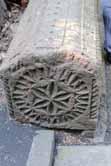
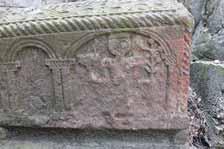

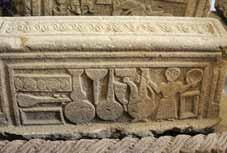


final arch on the right is a full-length, frontal depiction of a man, which cannot be seen clearly because of severe damage. We can only trace its outline, part of the face, the hat and the exaggerated shape of his eyes. On one side next to the figure is the image of a tall plant, while on the other side a man is holding an object, which cannot be identified

218
32. Ivane Javakhishvili Tbilisi State University Garden, 148×35×70 _ Depictions are placed on different sections of the sculpture of a ram. We see an architectural model with a gable roof on the back of the ram, with the slopes decorated with grooves. On one flank of the ram, we see a shepherd’s crook and the motif of curled horns is displayed in the area of the head.
33. Vera Cemetery, Tbilisi, 73×36×27 _ Depictions are found on different parts of the tomb – the surface and the edges are fully covered with floral and geometrical ornaments. The upper and lower facets of the tomb display circular motifs, in the centre of which a star is carved, surrounded by engraved triangles and rhombus-like shapes. On the side facet, we see a relief depiction of an arcade supported on seven pillars. Each pillar is standing on a base with steps and has a moulded capital. In the
34. Vera Cemetery, Tbilisi, 80×36×30 _ A figurative composition is found on the main surface of the tomb, showing a fulllength, frontal depiction of a male, with arms crossed over his chest in accordance with Christian custom. The edges of the small tomb are covered with floral ornaments. The details of the clothing and décor cannot be seen clearly due to severe erosion. We can see the area of his head, a belt wrapped around his waist, the legs of his trousers, and his shoes with heels. Information given in the inscription explains why the tomb is so small – the departed was a child.
Epitaph: The three-line inscription on the side facet of the tomb is read only in fragments: “under the tomb rests the body
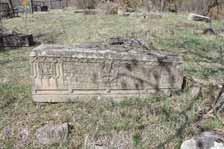
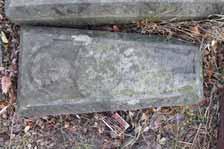
35. Writers’ House of Georgia, Tbilisi, 180×58×14 _ An arm holding a bow, and unidentifiable circular and triangular motifs, are depicted on the surface of the tomb. We also see a cart depicted from an aerial view and its wheels from a lateral view. The surface of the tomb contains several depictions of different shapes and sizes, the meaning and function of which cannot be identified.
SHIDA KARTLI
36. Biisi, Gori municipality, 163×42×60 _ Artistic and conceptual representations are displayed on the side facets of the tomb. The surface of one of the facets is divided into three relief “compositions”. On the right side, we see a flower surrounded by a rectangular frame, a dove descending from heaven is displayed in the middle surrounded by a moulded frame, and on the left side, we see a half-length figure of an angel contained within a richly moulded frame. Candles are depicted on both sides of the angel, outside the frame. The frame with the angel and candlesrestst on an arcade, where we can see traces of red paint in the segments between the columns supporting the arches. A similar composition is displayed on the opposite facet of the tomb, where, near the angel, is a full-length frontal depiction of a man holding a candle or a lamp in one hand and holding his other arm akimbo.
Epitaph: Inscriptions are found between the depictions displayed on one of the facets, which state that Shaliko Topchishvili, son of Isaka, who was born in 1907, died very young in 1928.



219
37. Chachubeti, Kaspi municipality, 153×41×41 _ The depiction is found on one of the facets of the multi-step grave stele showing a full-length, frontal depiction of a man. We see his long, one-piece robe tightened at the waist by a belt and his shoes with heels. The man has his arms crossed over his chest in accordance with Christian custom. The area of the head is characterized by its extreme generalization, although the hat is decorated. The depiction is surrounded by a moulded border, finished with a pediment in the upper area. The stele is richly decorated with architectural and floral motifs. Epitaph: The content of the Mkhedruli inscription spread across the different facets of the grave stele is illegible.


38. Gori, the churchyard of the church of the Archangel, Gori Municipality, 176×79×39 _ A full-length frontal depiction of a woman is carved on the surface of the central part of the tomb. A figurative composition is contained within a frame of torus-moulded, simple and twisted borders, decorated with floral ornaments in the corners. Different details can be distinguished in the depiction of the woman, such as her moulded crown surmounted with a cross, and her long, and one-piece dress with floral lace along its hem. Her dress is narrowed at her waist, she is wearing a cross necklace and a belt, the ends of which are flowing down all the way to her feet. The woman is depicted with her arms crossed over her chest in accordance with Christian custom and is dressed in a long gown.
Epitaph: A five-line Mkhedruli inscription is placed on the lower area of the tomb’s surface, which reads: “I, Ketevan, a daughter of Tevanant Ivane, beg your forgiveness, 1840”. Another two-line inscription on the side facet is written paradise it showed, Unclear! So dim my eyes became.”




39. Gori, the churchyard of the church of the Archangel, Gori Municipality, 109×32×33 _ Depictions are found on different areas of the tomb – the central area of the main surface displays a full-length frontal depiction of a woman. We see her one-piece, long dress and her shoes with heels. On both sides of her dress, small images of birds are engraved. The woman is depicted with her arms crossed over her chest in accordance with Christian custom. The upper area of the tomb displays a cross of complex design, placed on a raised rectangular tile. The side facets of the tomb are decorated with geometrical and architectural motifs carved in haut-relief.
Epitaph: A three-line Mkhedruli inscription is placed on the side facet of the tomb. Only fragments are legible, which inform us that the departed was a woman.

220
40. Gori, the churchyard of the church of the Archangel, Gori Municipality, 160×36×47 _ Depictions are found on different parts of the tomb – the central area of the main surface displays a full-length frontal depiction of a man. We see his chokha-akhalukhi, hat, a belt decorated with imprints, and shoes with heels. The man is depicted with his arms crossed over his chest in accordance with Christian custom. The upper area of the tomb is embellished with a cross of a complex design placed on a raised rectangular “tile”. The side facets of the tomb are decorated with haut-relief depictions of geometrical and architectural motifs. Half-length frontal depictions of angels are carved in the middle sections of these facets, contained within simple borders.
Epitaph: A three-line Mkhedruli inscription is carved under the depiction of the man, although the content of the verse remains undeciphered. However, the other inscription on the side facet reads: “Remember me O Lord, the one who is resting under this tomb, who separated from this world at the age of twenty-three… O reader, grant me forgiveness, Ioseb Naskidashvili, son of David, passed away on December Six in 1…9…”.


41. Gori, the churchyard of the church of the Archangel, Gori Municipality, 148×38×42 _ Depictions are found on different parts of the tomb – the central area of the tomb’s surface displays a full-length, frontal depiction of a woman. We see a long, one-piece dress decorated with a lace-like element around the hem, shoes with heels and earrings. The woman is depicted with her arms crossed over her chest in accordance with Christian custom. The relief carving is rather low. The upper part of the surface displays a cross of complex design. The side facets of the tomb are decorated with haut-relief depictions of geometrical and architectural motifs.
Epitaph: A four-line Mkhedruli inscription is placed under the depiction of the woman. It reads: “Mariam, the daughter of Alexa Avazneli”. On the side facet, we read: “this ephemeral world chose this for me, separated me from my peers, did not take pity on my youth, it picked me, I gave up my life in innocence at the age of 20 in 1906”.

221
42. Gori, the churchyard of the church of the Archangel, Gori Municipality, 103×33×42 _ Depictions are found on different sections of the tomb – the central area of the main surface displays a highly generalized, full-length frontal depiction of a man. The man is depicted with his arms crossed over his chest in accordance with Christian custom. The upper area of the surface contains a cross of complex design, by the upper beams of which we see two half-length figures of angels. The side facets are embellished with haut-relief depictions of geometrical and architectural motifs.
Epitaph: Under the arms of the cross, we see the date of death of the departed _ 1897. A three-line Mkhedruli inscription is carved on the lower area of the image of the man, which informs us that “Ivane son of Zakara.. passed away as an innocent infant at the age of two”.


43. Gorijvari, Gori Municipality, 166×49×52 _ Depictions are found on different sections of the tomb – the main surface displays a full-length frontal depiction of a man. We can discern a hat, with a triangular peak and a protruded element flowing down from it, his long cape and shoes. The man is depicted with his arms crossed over his chest in accordance with Christian custom. The upper area of the surface displays a cross of complex design.
Epitaph: The side facets of the tomb and the bevel-cut edges are embellished with Mkhedruli inscriptions, but only a small fragment is legible, which reads: “You, who are the possessor of young people, idle, deceptive, evil and eternally ruthless one, you cut me off unexpectedly, you the destructive one, I, Mikhail…”


44. Gorijvari, Gori Municipality, 105×38×46 _ Depictions are found on different areas of the tomb _ the central area of the main surface displays a full-length frontal depiction of a woman. We see her long, one-piece robe and shoes with heels. The woman is depicted with her arms crossed over her chest in accordance with Christian custom. The upper area of the tomb displays a cross of a complex design placed on a raised rectangular tile. The side facets of the tomb are embellished with haut-relief depictions of geometrical and architectural motifs.
Epitaph: A three-line Mkhedruli inscription on the side facet reads as follows: “Here rest the bodies of Marusia and Tamara, daughters of Abrama the messenger.” We might have assumed that the tomb contained two graves, but an inscription on a separate tomb next to this memorial confirms that Tamara daughter of Abrama is buried there.

222
45. Gorijvari, Gori Municipality, 41×40×106 _ Depictions are found on different surfaces of a medium-height grave stele. The middle area displays a half-length frontal depiction of an angel placed within a depiction of a wreath. On the side facet of the same level, a full-length frontal depiction of a man is carved within a simple border. We see his long, onepiece robe, hat, belt wrapped around his waist and shoes with heels. His facial features are carved conventionally like the head of the angel, where the image of a halo is conveyed by a saw-toothed outline. The surmounting header of the stele is composed of architectural motifs where an arch is holding a depiction of an egg.
46. Gostibe, Kaspi municipality, 210×60×65 _ Depictions are found on the middle section of the medium-height grave stele composed of three parts. We see a long depiction of a plough carved inside of a border headed with an ogee arch. The plough is depicted in great detail. We can clearly see its different parts. The two-step base of the grave stele is left almost unrendered. The surmounting header-capital, however, is decorated with floral elements. All the facets of the grave stele are embellished with an ogee arcade motif.
Epitaph: Mkhedruli inscriptions are distributed across three facets of the grave stele, which can only be read in fragments: “Here rests the body of Makhare Kavtarashvili, who passed away on June … in 1909 at the age of 50. Readers, pray to God for his forgiveness. This stone was erected by his wife Zitandar”.





47. Goruli, Gori municipality, 154x38x? _ Depictions are found on the area of the tomb’s surface showing a full-length frontal image of a woman. The tomb is inserted into the construction of the wall in the interior of the church building. The woman has one of her arms raised, in which she is holding a rectangular object, possibly a comb or a box engraved with initials. Her other arm is clinging to her chest. We see her knee-length dress, her moulded shoes with heels, her stylized facial features and a saw-toothed semi-circle around her head conventionally representing her hair. Two jugs of different mouldings, three eggs and unidentifiable circular shaped objects are depicted in a row under her figure.
Epitaph: A four-line inscription on the upper part of the surface reads: “O [Christ], remember the woman, Darejan”.

223
48. Noste, Kaspi municipality, 132×49×34 _ Depictions are found on the middle area of one of the facets of a three-step grave stele, showing a full-length frontal depiction of a human being. We see a long, one-piece robe, a hat and shoes. generalized, half-length, frontal depiction of a human being is depicted with linear engravings. Borders decorated with triangular, rhombus-shaped, vertical and horizontal carved elements decorate different parts of the stele, including its capital. Architectural and geometrical ornaments are also found on the surmounting segment of the stele, and on the capital of the base of the cross. Epitaph: Fragments of Mkhedruli inscriptions are traceable on different facets of the stele: “…in September 1922, may the reader grant us forgiveness” – the date most probably refers to the date of death. We find some grieving texts written in the rhythm of poetic verse: “What have I done to offend thee, oh, death…”



49. Ormotsi, Gori municipality, 138×37×35 _ Depictions are found on the upper facet of the tomb displaying a sculpted church model in haut-relief technique. In spite of severe damage, we see the drum of the dome, with its windows, and the segments of the roof both the conical dome and the sloping roof of the sides. The doorway is marked with an opening, which must have served as a hollowed-out niche for holding a candle. A window with a semi-circular header is also placed on each side of the door.
50. Ormotsi, Gori municipality, 142×36×39 _ Depictions are found on different parts of the surface of the tomb – including the full-length, frontal depiction of a man dressed in chokha-akhalukhi holding his arms akimbo. We see his hat, shoes with heels, his belt with a dagger wrapped around his waist, and a sword. We also see different accessories of chokha. Above the man’s head, there is a variation of a flowering cross with three eggs carved symmetrically above the arms of the cross. Two doves are carved side by side on the upper edge of the tomb, holding a circular element in their beaks. Side facets display floral motifs, architectural decorative elements and a saddled horse, with a man holding the horse by a rope tied to its bridle. The tomb is surrounded from two sides by twisted, torus-moulded borders.



Epitaph: On the side facets of the tomb, we read: “passed away at the age of 30, Gabriel Mar[ua]shvili, son of Luarsab, may the reader grant me forgiveness” and on the main surface we read: “on November 15 in 1899”.
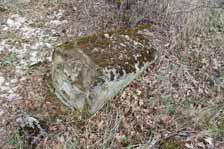
224
51. Ormotsi, Gori municipality, 140×37×38 _ Depictions are found on the surface of the tomb, showing a highly generalized, full-length, frontal depiction of a woman. The elements of the décor are utterly conventional. We can only distinguish a long dress, with a rectangular outline emphasized on its lower area. The carving of the head is stylized and simplified. A large moulded cross is depicted above the head of the woman. Side facets are decorated with architectural and floral elements.
52. Pavnisi, Kaspi municipality, 245×79×67 _ The depiction is placed on one of the facets of the grave stele – a full-length, frontal depiction of a man is carved. We see a knee-long tunic tightened by the belt at the waist, trousers and shoes with heels. The man has his arms crossed over his chest in accordance with Christian custom. The head in particular is highly generalized. He wears a hat and is depicted with rather exaggerated ears and nose. The depiction shows a rectangular element attached to his shoulder, which can hardly be identified. The depiction is surrounded by a moulded border, finished with a pediment in the upper area. The stele is richly decorated with floral and architectural details. Epitaph: A Mkhedruli inscription is spread across different surfaces of the grave stele. It reads: “Vaso Sultanishvili, son of Beso, I was 27, passed away in 1927, left three orphans, O readers, have mercy on me!”
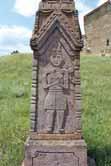


53. Sasireti, Kaspi municipality, 158×51×51 _ The only depiction is found on one of the facets of the three-step grave stele, showing a full-length, frontal depiction of a woman. We see her long dress, buttoned up vertically, while the lower part of the dress is decorated with a saw-toothed ornamental lace. We also see her shoes with heels, her characteristic hat and a handbag hanging on her arm. The depiction is highly generalized and is carved using linear engraving. The woman has her arms crossed over her chest in accordance with Christian custom. The depiction is surrounded by a torus moulded border surmounted by an arch.

Epitaph: “Here rests Gva…raela daughter of Gaba … at the age of 17, whoever passes by, grant your forgiveness”.



225
54. Sasireti, Kaspi municipality, 182×56×54 _ The depiction is found on one of the facets of the grave stele showing a full-length, frontal depiction of a woman. We see her chikhtikopi headpiece, parts of her “hatched” hairstyle and a long dress narrowed at the waist area, with a belt wrapped around it. The hem of the dress is decorated with a sawtoothed ornament. The woman has her arms crossed over her chest in accordance with Christian custom. The depiction is surrounded by an arched border. The grave stele is headed with a moulded capital, which was probably surmounted by a cross.
Epitaph: From all the Mkhedruli inscriptions carved on different sections of the grave stele we can read only a small fragment: “spouse of Bezhitashvili … at the age of 24… this wretched one…”

55. Sasireti, Kaspi municipality, 188×60×58 _ A depiction is found on one of the facets of the grave stele, consisting of several steps. A full-length, frontal depiction of a woman is carved on one of the facets of the stele. We see her hair depicted by engraved lines, her skirt and a blouse narrowed at the waist area and buttoned up. The woman has her arms crossed over her chest in accordance with Christian custom. The depiction is surrounded by a moulded border, and different parts of the stele are decorated with floral and architectural elements.
Epitaph: Mkhedruli inscriptions placed on a section of the base of the stele are illegible due to severe damage, and only a small fragment can be read: “I passed away in December 1909”.


56. Tskhaveri, Kaspi municipality, 155×40×42 _ The depiction is placed on a small, tile of the grave stele showing a hautrelief full-length, frontal depiction of a man. We see his trousers, shoes, hat and a knee-length tunic with pockets on the chest. The man has his hands lowered and is holding a revolver in one of his hands. The depiction is surrounded by a moulded border on two sides, while in the lower area, moulded candle holders are displayed on the sides of the steps on the decorated base.
Epitaph: The inscription on the side facet of the grave stele reads: “[passed away] on August 26, in 1935, Erekle Karkuzashvili, son of Mamuka, at the age of 18, I departed as a joyless lad”.



226
57. Telatgori, Kaspi Municipality, 175×58×58 _ Depictions are found on the middle area of the three-step grave stele, on one of the facets of the stele, showing a full-length frontal depiction of a man surrounded by a moulded border. We see his long, one-piece robe, his shoes with heels and his hat. The man is depicted with his arms crossed over his chest in accordance with Christian custom. He is holding a sceptre-like object in one of his hands. The generalized, figurative depiction is executed with linear engravings. Different parts of the stele including the base and the capital-header are decorated with triangular and rhombus-shaped figures. Architectural and geometrical ornaments are also found on the surmounting segment of the stele, and on the capital of the base of the cross.


Epitaph: Fragments of inscriptions found on different facets of the grave stele read as follows: “in 1932 passed… Shakro Gogil[i]shvili at the age”, “May my wretchedness never permit you to find rest for the remainder of your life”.

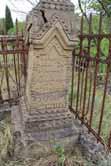
58. Telatgori, Kaspi Municipality, 170×60×63 _ Depictions are found on the middle area of one of the facets of a threestep grave stele showing a full-length frontal depiction of a woman surrounded by a moulded border. We see her long, one-piece robe, her shoes with heels and her stylized headpiece resembling a kabalakhi, with its ends flowing down on the sides, appearing to be either braids or earrings. The woman has her hands lowered. The generalized, figurative depiction is executed with linear engravings. Different parts of the stele, including the base and the capital-header, are decorated with triangular and rhombus-shaped figures. Architectural and geometrical ornaments are also found on the surmounting segment of the stele, and on the capital of the base of the cross.
Epitaph: “Kharatishvili Iza, daughter of Mikheil, born in 1900, I passed away in …93, and left three children behind”. It is likely that the date of birth is inscribed in error since the artistic and technical execution of the grave does not correspond to the techniques and styles used in gravestones produced in 1993.
227
59. Tvaladi, Kaspi Municipality, 145×65×45 _ Depictions are found on different sections of the grave stele – the rectangular base is left unrendered, while the body of the stele is richly decorated with architectural, geometrical and floral elements. A hollowed-out niche to hold a candle is carved into the main facet of the stele, above which we see a bird “descending from above”. The upper area of the stele is surmounted by a capital, embellished with pediments, their corners decorated with floral ornaments. The generalized half-length frontal depictions of human beings or angels are displayed on the middle areas of the side facets. The surmounting segment of the stele and the base of the cross are embellished with a wreath only from the central facet.
Epitaph: The long Mkhedruli inscriptions on various facets are illegible. All we learn is that the departed was a man who passed away at the age of 28 in 1919.
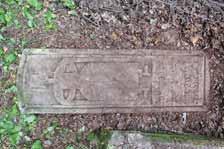



60. Tvaladi, Kaspi Municipality, 90×48×38 _ Depictions are found on the area of the surviving pillar, richly decorated with architectural, geometrical and floral ornaments. A hollowed-out niche for holding a candle is carved into the main facet of the stele, above which we see a bird is carved “descending from above”. The upper area of the stele is surmounted by a capital embellished with pediments; their corners decorated with floral ornaments. The generalized half-length frontal depictions of human beings or angels are displayed on the middle areas of the side facets. It is noteworthy that two similar surviving stelae of this type are inbuilt side by side, within the protective wall.
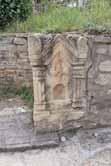
61. Zemo Nichbisi, Mtskheta municipality, 145×65×67 _ Depictions are found on a section of the tomb’s surface, showing a full-length frontal depiction of a man surrounded by a simply moulded rectangular border. We see his long, one-piece cape, with its sleeves flowing down to the knees, his shoes with heels, a hat with a braid– possibly part of its décor. The conventionally. The tomb is surrounded by a thick torus-moulded border.
Epitaph: An inscription is placed on the lower part of the tomb’s surface: “This tomb Kandelaki… son of Makhvila, whoever sees it, please grant forgiveness, (1856)”.

228
62. Zemo Nikozi, Gori municipality, 69×40×164 _ Depictions are found on the upper part of the medium height, two-part grave stele. A “rock-like” moulded stele is erected upon a relatively small rectangular base. The main facet displays an almost full-length, lateral depiction of a woman. The stele is carved as a single monolith and is divided decoratively into steps. In the central area, an almost haut-relief depiction of a woman is sculpted – we see one of her hands raised, her long hair flowing down, and an object resembling a staff in her hand. A depiction of a sheep may have been carved on one of the facets, although it is unclear now due to severe damage.
Epitaph: The fragmentary reading of the existing Mkhedruli inscriptions tells us that the name of the departed was Alexandre and the dates of his birth and date were 1870/9-1918.





KVEMO-KARTLI
63. Abrameti, Tetritskaro municipality, 78×32×35 _ The only depiction is found on the main surface, showing a full-length, frontal image of a woman surrounded by a simply moulded, ribbon-like border. We see her long, one-piece dress with a belt around her waist, her individual hairstyle, Aladdin-style shoes with heels and a cross hanging around her neck. The woman is holding her arms crossed over her chest in accordance with Christian custom.
Epitaph: Inscriptions are placed on the side facet only, but severe damage makes them illegible.
64. Bolnisi, St Elijah’s Hill, Bolnisi municipality, 70×47×25; 70×47×? _ Artistic and conceptual representations are displayed on the surviving small fragment of a rectangular tomb, probably showing part of the head and waist of a man. Only a fragment of a severely damaged tomb has survived, from the upper part of the tomb. The surface of the gravestone probably carried a full-length, frontal depiction of a man, from which only a small part of his head and his waist survived. A very generalized “portrait” is discernible, as is a rope belt, a small section of the lower part of his clothes, decorated with lines and an extremely characteristic three-petal-shaped hat. The man has his arms placed on different levels of his chest. It seems that the gravestone must have been framed with a simple torus moulded border. The lower part of the gravestone
the Aladdin-stye shoes The depictions are carved with medium height relief and its technical execution is characterized by
229
65. Bza, the churchyard of the Church of St George, Tetritskaro municipality, 185×70×40 _ The only decoration on this grave of a non-standard shape, is a generalized architectural motif found on its main surface. A pair of torus-moulded lines carved on the main surface of the tomb are finished with circular and rectangular decorative motifs at both ends.
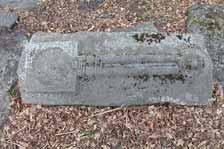
66. Bza, the churchyard of the church of St George, Tetritskaro municipality, 190×75×? _ Elements of decoration are found on the surface of a non-standard-shaped tomb. We see a long sword, three small kopi and an arm holding a bow. The human arm is depicted up to shoulder level. The ends of the bow are stretched in an arch-like shape.
67. Bza, the grave of the churchyard of the church of St George, Tetritskaro municipality, 180×75×23 _ Images are found on a non-standard shaped gravestone surrounded by a semi-circular torus-moulded frame. Inside the frame, we see a staff with its top divided into two segments, with a protrusion and circular-shaped segment placed on each side. Depictions on these small circular shapes are no longer visible.



68. Bza, the churchyard of the church of St George, Tetritskaro municipality, 155×50×60 _ Depictions are found on different facets of the tomb including, carved on the main surface of the tombstone, a full-length frontal depiction of a man dressed in chokha-akhalukhi. The man, equipped with a dagger on his belt and a pistol, is wearing a hat and the images of a cross and a sheep shears are carved in a horizontal line above his head. The lower part of the surface displays a jug, glass and a plate. On the upper facet of the grave, we see a haut-relief depiction of a sheep and snare pole on the edge of the frame. The man is depicted with his arms crossed over his chest according to Christian custom.
Epitaph: Mkhedruli inscriptions are found on the side facet of the tomb, although severe damage makes them illegible.
230
69. Bza, the churchyard of the church of St George, Tetritskaro municipality, 165×45×40 _ Depictions are found on different facets of the tomb including a relief carved, full-length, frontal image of a woman wearing a chikhtikopi headpiece. We see her dress, her braids flowing down from the chikhtikopi, her bag and her shoes. A cross is carved above the depiction, as are the images of a thimble, knitting needle or possibly an awl, a loom, and a few other objects which cannot be identified. An image of scissors is carved separately, near the edge of the border. The woman is depicted with her arms crossed over her chest according to Christian custom.



70. Bza, the churchyard of the church of St George, Tetritskaro municipality, 155×55×45 _ Depictions are found on an area of the surface of the tomb showing a full-length, frontal depiction of a woman. We see her braids flowing down from her chikhtikopi headpiece, her cross necklace, her long, one-piece dress and her shoes. The woman is holding an infant clinging to her chest. Two half-length depictions of angels are carved above the woman and infant, while below them we see a jug and next to it, a portrait of a person. The main surface of the tomb is surrounded by a simple border, and its edges are decorated with a geometrical motif. Epitaph: The inscriptions carved on the side facets of the tomb cannot be read due to severe erosion.
71. Bza, the churchyard of the church of St George, Tetritskaro municipality, 170×50×55 _ Depictions are found on an area of the tomb showing a full-length, frontal depiction of a woman. We see her chikhtikopi headpiece with braids flowing down from it, a cross necklace, a one-piece dress, a belt with long hanging ends, and shoes with heels. On the upper part of the tomb, above the woman’s head, we see a half-length figure of an angel with elongated, moulded wings, while above the angel we see a jug and two other objects, which cannot be identified. The surface of the tomb is surrounded by a simple border and its edges are decorated with floral and geometrical ornaments. The woman is depicted with her arms crossed over her chest in accordance with Christian custom.
Epitaph: Moss and lichen growth make the inscriptions on a side facet illegible.
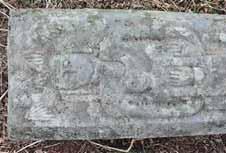


231
72. Bza, the churchyard of the church of St George, Tetritskaro municipality, 160×45×55 _ Depictions are found on different facets of the tomb. Several compositions contained within frames are placed one above another, including a conventionally depicted, highly stylized image of an angel, a cross, sheep shears, a gun and a crook. On the upper facet of the tomb, a half-length frontal depiction of a man is carved. We see his hat and his bandoliers zig-zagged across his chest. The depiction is surrounded by several steps of simply moulded borders. Epitaph: Mkhedruli inscriptions located on the edges of the tomb and side facets are fragmentary and illegible.
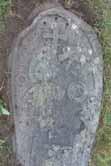



73. Bza, the churchyard of the church of the Mother of God, Tetritskaro municipality, 145×62×35 _ Depictions are found on the section of the tomb’s surface showing a full-length, frontal figure of a human being surrounded by other motifs and images. These appear to be the base of a loom, a circular star-like segment, another circular object and a long-necked jug. Some of these objects cannot be clearly identified. The surface of the tomb is surrounded by a simple torus-moulded border, inside of which we see a figurative depiction of a human being with open and lowered arms.
74. Dashbashi, Tsalka municipality, 168×70×15 _ Depictions are found on the surface of a non-standard-shaped tomb displaying a composition consisting of many elements. In the centre, we see a full-length, frontal depiction of a human being depicted in motion, and several objects depicted around his figure, including a simply shaped cross, a doublenecked jug, sheep shears, circular objects, and several rectangular segments, which can hardly be identified. The function of a massive rectangular object in the lower part of the tomb is unknown. The surface of the tomb is surrounded by a simple border. The figure is holding his/her hands extended in different directions.
232
75. Dashbashi, Tsalka municipality, 130×52×25 _ Depictions are found on the back and sides of the sculpture of a horse. We see a sword, a gun, possibly a pistol, a saddle, parts of the stirrups, rounded elements, like drawstring pouches hanging on them with their strings tied at the top. A pair of military goggles is shown on the horse’s head, while a short, moulded stirrup is seen at its rear. We see several other small elements which cannot be identified.





76. Dashbashi, Tsalka municipality, 155×74×? _ Depictions are found on the surface of the tomb, comprising a composition with many elements. Three human figures are displayed in the upper area, one of which is significantly larger than the others. Underneath these is what appears to be a depiction of a horse. Two bulls are depicted on the edges of the tomb, attached to a plough. The plough is long. It follows the vertical axis of the tomb all the way through and is carved in detail. Different parts of the bulls and the plough are depicted from different angles, and beside them, we see a circular wheel, which may be symbolizing either a bullock cart or mill wheel.
77. Dashbashi, Tsalka municipality, 151×42×17 _ Depictions are found on an area of the surface of the tomb, showing a full-length, frontal depiction of a man. Various unidentifiable spherical elements are seen by his feet and head. Relief depictions of a knife and a sword in a vertical position are carved on each side of his waist. The man is depicted with his arms crossed over his chest in accordance with Christian custom.
233
78. Dashbashi, Tsalka municipality, 115×60×10 _ Depictions are found on an area of a tomb of a non-standard shape. The centre of the composition is a full-length, frontal depiction of a man armed with a sword. Among the elements of the composition, we see a gun, drinking horns, a drinking vessel of zoomorphic shape, a bandolier and parts of a disassembled plough and bullock cart, presented from both aerial and lateral views. The composition includes agricultural and craftsman’s tools, such as a hammer and a wood-splitting wedge. Several objects are carved on the surface which cannot be identified. The man is holding a sword in one hand, while he holds the other raised by his chest.

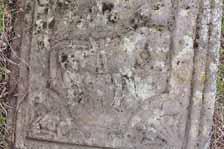
79. Didi Toneti, Tetritskaro municipality, 119×52×23 _ Depictions are found on different facets of the tomb – several compositions are displayed one above the other. The first of these shows a lateral view of a saddled horse. A full-length, frontal depiction of a man is depicted above the horse. The man is holding a cross in his raised hands. A crook and a gun are carved beside the man, while the corners of the torus moulded frame are decorated with floral motifs. On the upper facet of the tomb, there is a haut-relief figure of a sheep.


80. Didi Toneti, Tetritskaro municipality, 128×60×? _ Depictions are found on the surface of the tomb where a complex composition is presented – a full-length, frontal depiction of a man is depicted in the centre around which we see a drawstring pouch bag, a comb, a saw-toothed object, a gun and other objects which cannot be identified. The man’s hands are lowered, and the tomb is surrounded by a simple, two-tier, torus-moulded border. A crescent-shaped outline is carved above the head of the man. The tomb is now inserted within the wall of the church.

234
81. Didi Toneti, Tetritskaro municipality, 120×57×? _ Depictions are presented on the surface of a tomb showing a fulllength, frontal depiction of a woman. We see her chikhtikopi headpiece, her braids flowing down from it, her long, onepiece dress, narrowed in the area of her waist, and shoes with heels. A three-petal, ogee-shaped frame is decorated with half-length figures of angels in the corners. The woman is depicted with her arms crossed over her chest in accordance with Christian custom.
Epitaph: Fragmentary inscriptions are displayed on the section of the woman’s dress, where we read: “I am a wife of Taktakiant [Ma]te [and a daughter] of Ioseb Gabadze […] bride Kekela begs your forgiveness. 1702”.
82. Didi Toneti, Tetritskaro municipality, 148×46×56 _ Depictions are found on an area of the surface of the tomb showing a full-length, frontal depiction of a man dressed in chokha-akhalukhi. We see his belt with a dagger around his waist, his shoes, a hat and sheep shears depicted beside his waist. In the lower part, we see a saddled horse depicted from a lateral view and circular and cylindrical elements near the man’s head. A crook for catching the sheep and a sword, both are depicted at the edge of the frame. The lower facet displays a haut-relief image of a sheep. The man is depicted with his arms crossed over his chest in accordance with Christian custom.
Epitaph: Only a supplicatory element is legible from the inscription on the side facet.




83. Didi Toneti, Tetritskaro municipality, 156×45×35 _ Depictions are found on the area of the surface of the tomb showing a full-length frontal depiction of a woman. We see her chikhtikopi headpiece with her braids flowing down from it, her cross necklace, a long, one-piece dress, a belt with long waistbands and shoes with heels. In the lower part, we see a loom, a pair of scissors and a weaving tool. The woman is depicted with her arms crossed over her chest in accordance with Christian custom. The surface of the tomb is surrounded by a two-tier torus-moulded border.
Epitaph: The Mkhedruli inscriptions on the side facets are illegible.

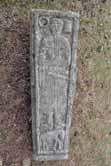
235
84. Didi Toneti, Tetritskaro municipality, 140×60×20 _ Depictions are found on the non-standard, rectangular surface of the tomb, showing a full-length frontal depiction of a woman. Among the haut-relief details of the figure, we can distinguish her individual hairstyle, her shoes and her long, one-piece dress narrowed around the waist area and tied with a belt. The woman is depicted with her arms crossed over her chest in accordance with Christian custom.
85. Didi Toneti, Tetritskaro municipality, 93×35×40 _ Depictions are found on different areas of the tomb – the surface and side facets display full-length frontal depictions of two men. We see their hats, chokha-akhalukhis, their belts, and shoes with heels. The depictions are surrounded by a rectangular frame and both are depicted with their arms crossed over their chests in accordance with Christian custom.
Epitaph: The contents of the Mkhedruli inscriptions carved on side facets and the edges of the main surface are illegible.
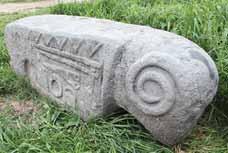
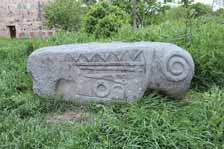




86. Dmanisi Sioni, Dmanisi municipality, 170×45×60 _ Depictions are found on the side of the sculpture of a ram – we see its decorative details carved on its sides, while the head has curled horns. On the area of the front shoulder, we see a small full-length frontal depiction of a human being, with a semi-circular, halo-like element around his/her head. The departed is depicted with arms crossed over the chest in accordance with Christian custom.
87.
150×40×50 _ Depictions are displayed on the side of the sculpture of a ram. The details carved on the animal consist of zigzag and rhombus-shaped decorative motifs on its flank, while the head has a pair of curled horns. On one of the side facets, we see a pair of scissors, a hoe, a copper jug, a crook and several circular objects.
236
Dmanisi Sioni, Dmanisi municipality,
88. Gokhnari, Tetritskaro municipality, 170×48×25 _ Depictions are found on the surface of a tomb of non-standard shape, showing a long sword, a few bosses and a staff. The tomb is surrounded from three sides by a semi-circular, arch-like torus-moulded border.

89. Gokhnari, Tetritskaro municipality, 175×40×27 _ Depictions are found on the surface of a tomb with a non-standard shape. A short torus moulded shat, finished with a circular header, proceeds from the point where a pair of arches intersect. Its header is decorated with geometrical, rhombus-shaped, engraved elements. Small bosses are placed on a vertical line at both ends of the tomb’s surface.
90. Gokhnari, Tetritskaro municipality, 183×38×32 _ Depictions are found on the surface of a non-standard-shaped tomb, showing an arm holding an undrawn bow. The arm is depicted up to the shoulder. The ends of the bow have an equal thickness and form an arch shape.

91. Gokhnari, Tetritskaro municipality, 181×43×23 _ Depictions are found on the surface of a non-standard-shaped tomb displaying a long sword, a large arrowhead, several small bosses and an arm holding an undrawn bow. The arm is depicted up to the shoulder.


237
92. Ghoubani, Tetritskato municipality, 164×50×63 _ Artistic and conceptual representations are displayed on different facets of a rectangular tomb chest including one showing a full-length, frontal depiction of a man dressed in chokhaakhalukhi. From the elements of his appearance, we observe his personalized hairstyle and high-ankle shoes with heels. The surface of the tomb, which is framed with a simple border and a sloped edge decorated with an ornamental frame, contains the half-length figures of angels depicted in the upper corner. In the lower part of the side facet, we see a small depiction of a man mounted on horseback, surrounded by a simple frame. We can see a man, the horse with a saddle and stirrups, the crest of which has some hatching decoration. We also see another small object, which the man is holding in one of his hands. The horse is depicted in lateral view in motion, while the rider is depicted frontally, at half-length. Epitaph: The inscriptions are displayed on side facets of the tomb. It is impossible to read them fully. The fragments reveal the following content: “A good judge, a loving father and loyal to his wife and children”, “woe to me, how cruelly has the tormentor treated me, why did it attack me, I said, and it fell upon me, I was sitting, and it collapsed under me and the bird of my life flew away…”

93. Ghoubani, Tetritskaro municipality, 166× 74× 38 _ Artistic and conceptual representations are displayed on the surface of a rectangular stone, showing a full-length, frontal depiction of a woman. From the elements of her appearance, we recognize her chikhtikopi headpiece, a braid flowing down from it, conventionally drawn shoes with heels and a onepiece dress, the hem of which is vertically “hatched”. The woman holds her arms crossed over her chest in accordance with Christian custom. The surface is framed with a simply moulded flat border, while the upper corners are covered with half-length depictions of angels. Epitaph: on the side and bottom facets of the stone Mkhedruli inscriptions are written, the content of which is unreadable. Only the date of death is readable – 1885.




238
94. Ghoubani, Tetritskaro municipality, 184× 80×30 _ Artistic and conceptual representations are displayed on a section of the surface of a rectangular tombstone, showing a complex-shaped cross, a highly generalized depiction of the palm of a hand, and the depictions of rays in the upper corners, contained within an arch-like segment. The corner elements seem to portray the half-length depictions of angels. A double frame surrounds the surface of the tomb – the inner area is surrounded by a chain of embossed semi-circle elements, while the border of the tomb has a torus-moulding.





Epitaph: A six-line Mkhedruli inscription is inscribed on the surface of the tomb, consisting of graphemes with complex outlines. The fragments of the epitaph read: “I, Kitesi, Sulsanashvili, son of Sulsani, a peasant living in Ghoubani, dwell inside this grave, I passed away on February 11 in 1882, I was 44. You, who read this, I ask you to grant me forgiveness”.
95. Ghoubani, Tetritskaro municipality, 153×56×64 _ Artistic and conceptual representations are displayed on a section of the surface of a rectangular tombstone, showing a full-length, frontal depiction of a woman. From the elements of her appearance, we can observe her shoes with heels, her chikhtikopi headpiece, a braid flowing down from it, and a long, one-piece dress, decorated with ornamental tailoring around her chest area. The belt around her waist is covered with a floral ornament, and it flows down to the very hem of the dress. The lower part of the dress is also hatched vertically. She is holding her arms crossed over her chest in accordance with Christian custom and a cross necklace is hanging around her neck. The bevel edge surrounds the tomb as an ornamented border. The upper corner areas inside the border are covered with half-length depictions of angels.
96. Gomareti, Khizanaant Sakdari Church, Dmanisi municipality, 133×72×35 _ Depictions are displayed on the surface of the tomb, showing frontal images of two men, carved side by side. In both cases, we see a hat, a long, one-piece gown and Aladdin-style shoes with low heels. One of the figures is equipped with a gun and a bandolier, while the other one is without a weapon, and has a cross hanging on his chest. Both are depicted with their arms crossed over their chests in accordance with Christian custom. The tomb is surrounded by a rectangular, fillet-moulded border.
239
97. Gomareti, Khizanaant Sakdari Church, Dmanisi municipality, 145×55×? _ Images are found on the surface of the tomb, where a full-length frontal depiction of a man carved in haut-relief is dressed in chokha-akhalukhi. We see his long, one-piece mantle, shoes, and belt with a dagger and a pistol. The background shows a small moulded cross, while the upper part of the tomb is decorated with wound, volute-like elements. The man is depicted with his arms crossed over his chest in accordance with Christian custom.

98. Gomareti,
_ Depictions are found on the area of the tomb’s surface where a full-length, frontal figure of a woman is carved. We see her chikhtikopi headpiece, her flowing braids, a long, one-piece dress decorated with carved lines around the chest area, and shoes. The objects carved on the side facet of the tomb cannot be identified – it may be either a cradle or a chest. The woman is depicted with her arms crossed over her chest in accordance with Christian custom. The tomb is surrounded by a border of low torus moulding.
99. Gomareti,
_ Depictions are found on different sections of the tomb including the one on the main surface which is almost completely eroded. A side facet shows two bulls of different sizes placed on opposite sides. A yoke is depicted between the bulls, while the rest of the long plough is depicted on one side of the composition.



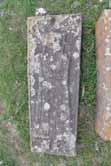

240
Khizanaant Sakdari Church, Dmanisi municipality, 157×65×41
Khizanaant Sakdari Church, Dmanisi municipality, 148×48×33
100. Gomareti, Khizanaant Sakdari Church, Dmanisi municipality, 150×67×20 _ Depictions are found on a section of the tomb’s surface, showing a full-length frontal depiction of a man dressed in chokha-akhalukhi. Among his equipment, dress and embellishments we see a long, one-piece mantle, hat and shoes, a belt with a dagger, a sword beside him, and a pistol. Under the figure of a man, a shepherd’s staff and a haut-relief depiction of a sheep are carved. Another haut-relief depiction of a horse is carved on the side facet of the tomb. The man is depicted with his arms crossed over his chest in accordance with Christian custom.
101. Gomareti, Khizanaant Sakdari Church, Dmanisi municipality, 140×50×? _ Depictions are found on a section of the surface of a tomb, showing a full-length, frontal depiction of a woman. We see her chikhtikopi headpiece and her braids flowing down from it, her long, one-piece dress, a buttoned belt around her waist, and shoes with heels. The hem of the dress is decorated with short engraved lines. The man is depicted with his arms crossed over his chest in accordance with Christian custom. The surface of the tomb is surrounded by a fillet-moulded frame.
102. Gomareti, Khizanaant Sakdari Church, Dmanisi municipality, 182×67×37 _ Depictions are carved on a section of the surface of a tomb, showing a full-length frontal depiction of a man dressed in chokha-akhalukhi. Among his equipment, clothing and décor we see his hat, his cross necklace, shoes with shoelaces, his belt with a dagger and sword and pistol beside him. Below the man, we see a haut-relief depiction of a ram. A figure of a saddled horse on the side facet is also carved with a similar technique. We also see a shepherd’s crook, a jug, sheep shearss, a gun, a half-length figure of an angel, a moulded cross and a few objects, which cannot be identified. The man is clutching his dagger with one hand and is holding the other hand by his chest. The surface of the tomb is surrounded by a simple torus-moulded border.


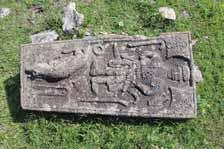




241
103. Gomareti, the churchyard of the church of St George, Dmanisi municipality, 120×65×15 _ Depictions are found on a section of the surface of a tomb, showing a full-length frontal depiction of a man dressed in chokha-akhalukhi. We see his individual hairstyle, his long, one-piece mantle, the belt around his waist, and shoes with heels. The man is holding an open book in his hands and a saddlebag is carved by his feet.
Epitaph: A six-line Mkhedruli inscription is carved on the surface of the tomb, the content of which is illegible. The fragmentary reading of the epitaph suggests that the departed must be a priest called Solomon.

104. Gomareti, the churchyard of the church of St George, Dmanisi municipality, 113×38×40 _ Depictions are found on a section of the surface of a tomb, showing a full-length frontal depiction of a man dressed in chokha-akhalukhi. We see his hat, a belt around his waist and shoes with heels. Under the figure of a man, we see an aerial view of a ram, while under the ram we see work tools such as an axe, hoe, saw and two other unidentifiable objects. The man is depicted with his arms crossed over his chest in accordance with Christian custom. The surface of the tomb is surrounded by a rectangular frame.


Epitaph: Inscriptions are carved on the edges of the tomb – only the date of death is legible -1927.
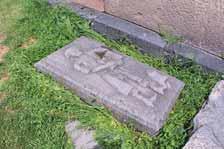
105. Kosalari, Tetritskaro municipality, 120×60×30 _ Artistic and conceptual representations are displayed on a section of the surface of a ledger stone, showing a full-length, frontal depiction of a woman. From the elements decorating her clothes, we see a long, one-piece dress with embellishment around the chest area, also two long braids flowing down onto her shoulders and different objects depicted around the woman. The most identifiable among the small objects are a comb and a mirror. It is likely that the object depicted in the lower left corner may be a weaver’s loom. The woman keeps her arms crossed over her chest in accordance with Christian custom. The stone is framed with a simple torusmoulded border.
Epitaph: Inscriptions are found on the area of the woman’s dress. We can distinguish only several lines of the Mkhedruli inscription. Yet, because of the severe damage to the graphemes and their outlines, we cannot read the content of the text.
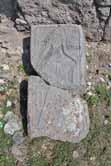
242
106. Zemo Bolnisi, Bolnisi municipality, 127×62×40 _ Depictions are found on different sections of the tomb. The side facet displays a decorative ogee-shaped arcade surrounded by a torus-moulded border. Each arch contains a different element. One facet has five ogee arches resting on pillars and moulded capitals, while inside the arches we see different varieties of water pitchers and jugs. In one of the arches we see a circular shape, which may represent some tableware; the same motif decorates the other side facet, where four semi-circular arches are displayed with the images of human beings inside three arches and a jug and a water pitcher in the fourth. The human beings are depicted sitting on the floor with crossed legs; one of them is pouring wine from the jug, and the other two are depicted in different positions.
107. Zemo Bolnisi, Bolnisi municipality, 130×46×27 _ Depictions are found on the surface of the tomb, showing a fulllength frontal depiction of a human being. A jug, sheep shears and other unidentifiable elements are observed around it. The departed, whose clothing identifies her as a woman, is depicted with her arms crossed over her chest in accordance with Christian custom.
Epitaph: It is impossible to figure out the content from the several Mkhedruli graphemes displayed on the surface of the tomb.







108. Zemo Bolnisi, Bolnisi municipality, 151×28×46 _ Geometrical and floral ornaments are displayed abundantly on all the surfaces of the tomb. On the side facet of the tomb, we see a composition with many figures. Full-length frontal depictions of three people are displayed side by side. Beside the figures we see three jugs, a plate and a drinking vessel. The edges of the side facets are decorated with twisted, ornamented and coupled torus-moulded borders. On the lower facet of the tomb, we see a small depiction of the tree of life.

243
109. Zemo Bolnisi, Bolnisi municipality, 135×40×35 _ Artistic and conceptual representations are displayed on different sections of a rectangular stone. Due to severe damage, only small fragments of depictions are discernible on a side facet of the tomb. We see a full-length frontal and rather generalized depiction of a human being holding something in one hand, while the other hand is missing. Beside the figure,e we see fragments of a jug, a comb, a bowl arranged in a horizontal line, and a slightly inclined depiction of another jug above the bowl. The surface of the tomb may have been decorated with two bevelled edges carved with lines resembling grooves between slabs. Epitaph: On a side section of the stone, next to the depictions, we can trace the fragments of a three-line Mkhedruli inscription. Severe damage makes it impossible to read its content, only the following is legible: “Remember [soul] of your servant Mamkana, Amen …”.
110.
are displayed on different facets of a
majority of the images are depicted on the side facets of a vertically elongated stone. One





framed with a complex torus-moulded border includes elements of feasting and celebration – we see a jug, a funnel, a karkara (a Georgian wine jug), a plate, a bowl, barbecued meat put on skewers and different foods placed within small frames. On the other side of the tomb, presented like a frieze, we see a fulllength frontal depiction of a man holding a spear in one hand and a gun in the other. We also see a lateral depiction of a fully saddled horse with a decorated crest and a tail knot. An axe, spurs and a water flask decorated with a spiral ornament are attached to the horse’s saddle. From the clothes of the man, we can distinguish a single piece garment, and a belt with a dagger around his waist. The depictions on the left and right of the surface are unidentifiable, although we can recognize a small model of a house, a comb and possibly a mirror. The depictions are contained within a complex moulded frame. On the upper and bottom facets of the tomb, we have a niche and a relief depiction of a cross.

244
Zemo Bolnisi, Bolnisi municipality, 120×49×48 _ Artistic and conceptual representations
rectangular-shaped, elevated tombstone. The
facet
111. Zemo Bolnisi, Bolnisi municipality, 46×55×21 _ Artistic and conceptual representations are displayed on the surviving small fragment, apparently showing part of a man’s head. The surviving fragment was formerly the upper area of the tomb. The surface most likely displayed a full-length, frontal depiction of a man (only part of the head of which has survived). On both sides of an extremely individualized portrait of the man we see a mirror, a comb and possibly a chest. We see carved objects looking like circles, rectangles and combs, which are relatively well preserved. The surface of the tomb may have been framed with a simply moulded border with a flat surface decorated with one spiral of a knotted ornament at both ends of the border.
112. Zemo Bolnisi, Bolnisi municipality, 75×29×30 _ Artistic and conceptual representations are displayed on a section of a rectangular stone, showing a full-length, frontal depiction of a man. From the elements of his clothes, we can see a crescent moon-shaped hat, his Aladdin-style shoes with heels, a one-piece garment and a belt around his waist. On both sides of the man’s head, we see a comb and a mirror. The gravestone is framed with a flat border of simple moulding. The man is depicted with his arms crossed over his chest in accordance with Christian custom.


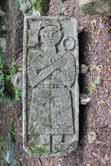

113. Zemo Bolnisi, Bolnisi municipality, 88×37×18 _ Artistic and conceptual representations are displayed on the surface of a rectangular stone, showing a full-length, frontal depiction of a man. Among the elements decorating his clothes we can recognize his stylized hat and shoes, long, one-piece garment, and a belt around his waist. At his sides, we see a dagger and a pistol. The gravestone is framed with a simply moulded border. The man is depicted with his arms crossed over his chest in accordance with Christian custom.

245
114. Manglisi, Tetritskaro municipality, 140×72×27 _ Artistic and conceptual representations are displayed on a section of the surface of a rectangular tombstone, showing a full-length, frontal depiction of a woman. The relief carving is relatively high. From the elements of the clothes’ design, we can see a long, one-piece dress, which is decorated around the chest area, and is buttoned. We see a conventionally outlined pair of shoes with heels, a chikhtikopi headpiece and braided hair flowing down below it; we also see a belt with a buckle and the hem of the dress decorated with lace. The woman is depicted with her arms crossed over her chest in accordance with Christian custom. The deliberately elongated arms and exaggerated shape of her palms are worth noting. The stone is framed with a double border, consisting of torus moulding ribbons, which terminates in an oval shape in the lower section.
Epitaph: forgiveness”. A three-line Mkhedruli inscription is found on the side facet of the tomb which reads: “I, the handmaiden of God Maka Changovi, daughter of Tevrore, resting in this tomb, passed away on [this very] day, May 3, in 18[…].
115. Manglisi, Tetritskaro municipality, 152×80×60 _ Artistic and conceptual representations are displayed on a section of the surface of a vertically elongated, rectangular tomb chest, showing a shepherd’s staff. Carving is present in the form of engraving on the surface and is characterized by its simplicity. The vertically erected staff is finished with a horizontally stretched double hook, while its bottom is sharpened and moulded.
Epitaph: Mkhedruli inscriptions are displayed on a section of the surface around the engraved depiction, reading as follows: “Remember, resting in this grave [Archpriest] Demetre of Manglisi.


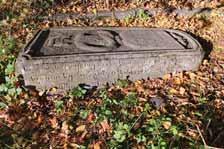

116. Marabda, Tetritskaro municipality, 168×73×? _ Depictions are found on the area of the surface of the tomb, where instead of figurative or ornamental images, a four-line Mkhedruli inscription against a smooth surface forms the main embellishment of the tomb. The outlines of the letters, their distribution across the tomb’s surface and the technique of their carving is fitted to the surface in such a way that it forms a kind of “verbal décor”. The surface is surrounded by a torus-moulded border.
Epitaph: In the four-line Mkhedruli inscription on the main surface of the tomb we read: “Remember O God and have mercy upon David son of Tve, of noble birth (along with Tamaz) who passed away in 1863.
246
117. Marabda, Tetritskaro municipality, 138×44×? _ Depictions are carved on a section of the surface of a tomb, showing a full-length frontal depiction of a man. We see his long, one-piece gown tied by a belt around his waist, his Aladdin-style shoes and a distinctive hat, the unique features of which are four raised peaks with rounded ends. The depictions of a jug and two other shapes, which cannot be identified. The surface of the tomb is surrounded by a simple torus-moulded border. The man is depicted with his arms crossed over his chest in accordance with Christian custom.
Epitaph: Inscriptions are not found, although the gravestone and the tombs around it are thought to be the graves of the famous brothers Kherkheulidze, as mentioned in some studies.

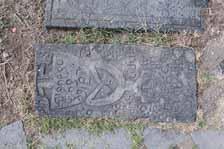


118. Marabda, Tetritskaro municipality, 181×63×? _ Depictions are carved on a section of the surface of a tomb, showing a full-length, frontal depiction of a man. We see his long, one-piece gown, tied with a belt at the waist, his Aladdinstyle shoes and personalized hairstyle or a hat. On one side of the man’s head, we see a drinking horn and on the other side, a jug. The legs of the man who is depicted frontally, are displayed from a lateral view. The surface of the tomb is surrounded by a thick border composed of floral ornaments. The man is depicted with his arms crossed over his chest in accordance with Christian custom.
Epitaph: Inscriptions are not found, although the tomb and the other tombs surrounding it are thought to be the graves of the famous brothers Kherkheulidze.
119. Marneuli, Churchyard of St. George’s Church, Marneuli municipality, 95×44×10 _ Artistic and conceptual representations are displayed on a section of the surface of a rectangular stone, showing a full-length, frontal depiction of a human being. From the decorative arrangements of the clothes, we see conventional representation of the shoes and a onepiece garment with a wide lower hem. The whole area around the depiction is fully covered by Mkhedruli inscriptions, written rather carelessly. The gender of the depicted person cannot be identified – the portrait features suggest that it may be a man, although the elements of the gown make it impossible to decide with confidence. The person is depicted with arms crossed over the chest in accordance with Christian custom.
Epitaph: The thirteen-line Mkhedruli inscription on the surface of the stone is only legible in fragments, because of its disorganized nature. We see only an introduction and the final part of the commemorative-supplicatory prayer. The areas in the lower corners refer to the age of the departed – 48.

247
120. Marneuli, Churchyard of St. George’s Church, Marneuli municipality, 170×62×30 _ Artistic and conceptual representations are displayed on a section of the surface of a rectangular gravestone showing various depictions. A section on the left edge of the tomb is covered with a full-length, frontal depiction of a man, who, according to the heavily characteristic elements of his garment might be a clergyman, although the shape of something on his head (which could be either his hair or a hat), fails to confirm this idea. The man holds his arms crossed over his chest in accordance with Christian custom. In addition, the surface of the tomb also displays carved reliefs of the lateral view of a horse, a sword, jugs and drinking horns, depicted side by side. We see another half-length, frontal depiction of a man on the surface, with his arms wide open. The stone is surrounded with a simple torus moulded border. Epitaph: Mkhedruli inscriptions were written on the upper part of the surface, although they have been intentionally damaged.




121. Marneuli, Graveyard of the Church of St. George, Marneuli municipality, 118×44×12 _ Artistic and conceptual representations are displayed on a section of the surface of a rectangular ledger stone, showing a full-length, frontal depiction of a woman. She is dressed in a one-piece dress with widened hem, her shoes with heels are shown, and we see her tall neck and her braids flowing down on both sides. The section of the face is left featureless with only its shape outlined formally. The woman keeps her arms crossed over her chest in accordance with Christian custom. The grave is framed with a simple torus-moulded border.
122. Partskhisi, Tetritskaro municipality, 134×44×77 _ Artistic and conceptual representations are displayed on a side of the sculpture of a ram; the composition is very vague. We can distinguish a full-length, frontal depiction of a man holding his hands in a gesture of prayer. Next to the figurative depiction we see a lateral representation of an animal, the species of which cannot be identified. The head of the sculpture of a ram is sharply defined, with curved horns decorated with hatching and a small illustration of a tail at the back. We see a cross carved on the chest of the ram.

248
123. Patara Gomareti, Dmanisi municipality, 145×55×19 _ Artistic and conceptual representations are displayed on the surface of a rectangular ledger stone with a pointed end in its lower part. The surface shows a full-length, frontal depiction of a man. From the elements of his representation, we see a one-piece, long garment, a formally drawn shape of shoes with ‘Aladdin’ toes, and various objects depicted around the figure. On the sides of the man’s waist, we see a pistol and a dagger, while on the sides of his shoulders a whip and a crook are visible. Above the man’s head, a cross of complex shape, is carved. The man is depicted with his arms crossed over his chest in accordance with Christian custom. The surface of the stone is framed with a pair of twisted, torus moulded borders. At the upper end of the ledger stone a headstone is placed, decorated with niches designed for holding candles.



124. Patara Gomareti, Dmanisi municipality, 162×67×27 _ Artistic and conceptual representations are displayed on different sections of a non-standard, rectangular ledger stone. On the side facet of the stone, we see a haut-relief depiction of a horse equipped with saddle and stirrups. The central part of the stone displays a full-length, frontal depiction of a man dressed in chokha-akhalukhi and wearing a belt with a dagger around his waist. From his features we recognize a personalized hairstyle, a long mantle and a sword, on left the side of his back – we can see only part of the sword-hilt and the top of the sheath. The man is holding his pipe in one hand and a whip in the other. Objects such as a saddlebag, a drinking horn, a cross and a long plough are depicted in an unsystematic order, and identification of several objects is impossible. The surface of the stone is framed with a double-grooved border.

249
125. Patara Toneti, Tetritskaro municipality, 153×46×46 _ Artistic and conceptual representations are displayed on the surfaces of the two facets of a three-part grave stele. The front facet displays a full-length, frontal depiction of a man dressed in chokha-akhalukhi. From the elements of his representation, we can recognize his Aladdin-style shoes with heels, his belt with a dagger and a bandolier stretched diagonally across his chest. Next to the depiction we see a long gun placed in a vertical position. The man, whose hands are lowered, is contained within a moulded border. On the side facet of the stele, we have relief depictions of a sheep, a wool-clipper and a jug. The stele is surmounted with a wide capital, decorated with a border of small triangles.
Epitaph: The three-line Mkhedruli inscription inscribed on the base of the stele is unreadable – the fragments of the graphemes tell us that the text must have contained the surname of the departed and his birth date.




are situated side by side within the
were erected in 1920s and are characterized with identical typology. The structure of each is as follows: a massive, moulded base, with the body of the stele standing upon it, a column, and a finishing capital with a surmounting massive stone cross. Two of the three graves belong to men and the other to a woman. The frontal depictions are almost fulllength, save that the legs are missing. All of them hold their arms crossed over their chests in accordance with Christian custom. From the elements decorating their clothing it is possible to distinguish certain signs referring to the genders of the depicted persons. In the case of the woman, it is an embellished dress, a cross necklace worn around the neck and a personalized hairstyle. For the men, it is a belt with a dagger, while a hat is worn in both cases. Many stelae of the same artistic presentation and execution are observed in the same cemetery, where the distinctive feature for men’s graves well distinguished. The similar sizes of the stelae, their general proportions, artistic presentation and ornamental and figurative depictions lead us to think that the stelae are made by the same craftsman or at least by single workshop. Epitaph: The inscriptions are written on different areas on different stelae. However, most are found on the bases. Apart from the texts that identify the gender, occupation, and marital status of the departed, as well as the explanatory or supplicatory lines (usually inscribed using the Mkhedruli script), it also provides the most significant piece of information. The epitaph on one of the graves of a man reads: “the readers, I beseech your forgiveness, the price of the stone – 1500 M” (probably Maneti).
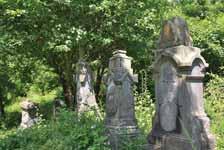
250
126. Pitareti, Tetritskaro municipality, 235×45×43;190×44×42;192×45×45 _ Three stelae
127. Pitareti, Tetritskaro municipality, 142×43×34 _ Artistic and conceptual representations are displayed on different facets of a rectangular tomb chest, including one showing a full-length, frontal depiction of a man dressed in chokhaakhalukhi. From the elements depicting his appearance we can see his belt with a dagger worn around his waist, and a revolver hanging from the belt, his personalized hairstyle and a conventionally depicted pair of shoes. The man holds his arms crossed over his chest in accordance with Christian custom. On the side facet of the tomb, we see the depictions of a saddled horse, an axe, a saw, a pitchfork and an adze depicted side by side in a horizontal line.

128. Rekha, Tsalka municipality, 200×59×60 _ Artistic and conceptual representations are displayed on a section of two facets of a four-section obelisk column. The front facet shows a full-length, frontal depiction of a man wearing a chokhaakhalukhi. From the elements of his clothing, we can recognize his shoes with heels, a hat, his belt and the cartridges of his bandolier carved on his chest. The man, who is depicted with his arms crossed over his chest in accordance with Christian custom, is surrounded by a simply moulded frame. A decorative motif of a flower bouquet in a vase is visible on the lower area of the surface. The stele is finished with a wide moulded capital, which was probably surmounted with a cross.





129. Samshvilde, Tetritskaro municipality, 170×39×83 _ Artistic and conceptual representations are displayed on different sections of a large sculpture of a horse. On the back and head areas of the horse we see depictions of spurs, stirrups, saddle and a hanging axe. Both sides of the horse are decorated with crudely carved objects. On one side we see a fulllength, frontal depiction of a man and a jug, a drinking horn, a dagger, a gun, a bandolier, a sword, a cross, a crook, a comb and a few small fragments of other objects, which are hard to identify. The other side of the sculpture is decorated with lateral depictions of two animals facing one another, of which the left one must be a horse, while the right one is unrecognizable. We see a lateral depiction of a bird on the back of the sculpture.

251
130. Tbisi, Tetritskaro municipality, 73×22×5 _ Artistic and conceptual representations are displayed on a section of the surface of a rectangular ledger stone showing a full-length, frontal depiction of a woman. From the elements of her appearance, we can recognize her hairstyle, a long, one-piece dress and a stylized depiction of her shoes and heels. The woman has her arms crossed over her chest in accordance with Christian custom. We see the depictions of a comb and possibly a mirror carved side by side on the lower part of the tomb by the woman’s feet. The surface of the tombstone is framed with a simple torus-moulded border.
131. Tbisi, Tetritskaro municipality, 75×31×? _ Artistic and conceptual representations are displayed on a section of the surface of a rectangular ledger stone, showing a simple depiction of a cross and a highly generalized depiction of a leaping animal, both framed with triangle borders from two sides. The gravestone is inbuilt in the floor of the interior of the church; its surface is framed with a double grooved border.
132. Tsveri, Dmanisi municipality, 153×57×20 _ A full-length, frontal depiction of a man is displayed on the surface of the tomb. We see his hat with a small cross on it, his chokha-akhalukhi, including bullet pouches, a belt around his waist, and shoes with heels. A small model of a plough is depicted on the lower area of his chokha. The man has his arms crossed over his chest in accordance with Christian custom. Two elements near his head cannot be clearly identified –they may be a pistol and a bandolier. The depiction is surrounded by a double frame _ the inner frame is finished with a trefoil arch at the head area, while the outer frame is a twisted, torus-moulded border.
Epitaph:A five-line Mkhedruli inscription is placed on the lower part of the man’s chokha: “Here I rest, Revaza Meladze, son of Zalik…, I passed away …”.



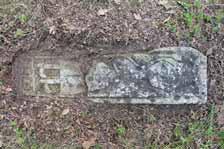
252
KAKHETI
133. Khashmi, Sagarejo municipality, 132×52×23 _ The surface of a tomb displays a full-length frontal depiction of a woman with her hands clasped and holding a small cross. She is wearing a long dress with a belt around her slender waist, with tassels decorating the central area. Her distinct hairstyle is striking, with a richly decorated crown resting upon her head. The surface of the tomb is surrounded by a torus moulded border, which becomes a broken-line design in the upper part.
Epitaph: A five-line Mkhedruli inscription is inscribed, in a rather cursive style, in the lower area of the surface. It reads: “Have mercy O Lord, on [Zenobieri], the daughter of Egnate Nakhutsrisshvili … in 1852”.
134. Kvemo Magharo, Sighnaghi municipality, 183x48x45 _ Artistic and conceptual representations are displayed on the side facet of a rectangular tomb chest, which displays full-length frontal depictions of three people, placed horizontally along the side facet of the stone. They are placed in such a way that, were the facet vertical, they would appear to be standing above one another. Each figure is slightly smaller than the one to its left. The first two depictions are of women, while the last depicts a man. It is likely that the tomb is the resting place for three people. Each of them has their hands lowered and different elements of the decoration of their clothes are visible.
Epitaph: The epitaphs are carved on the side facets of the stone, yet it is impossible to read their full contents. Surviving fragments of the inscriptions consist of a few graphemes suggesting some names and surnames. The only continuous line reads as follows: “Mariam, daughter of Mikheil passed away at the age of 36 in 1912”.
135. Maghraani, Akhmeta municipality, 61×22×23 _ The surface of the tomb displays a full-length frontal depiction of a woman, with her hands lowered. Her hair is flowing on both sides to the level of her shoulders, she is wearing shoes with heels and the top of her dressed is buttoned up.
Epitaph: Inscriptions are illegible due to severe damage, although the date of the death _ 1912 – can be seen clearly.




253
136. Pshaveli, Telavi municipality, 68×25×24 _ The surface of the tomb displays a full-length frontal depiction of a man, with his hands both lowered and spread. He is wearing a buttoned shirt, a strip-like belt, a hat and shoes with heels. The surface of the tomb is framed with a smooth ribbon-like border.
Epitaph: The side facet of the tomb displays a two-line Mkhedruli inscription, which is not fully legible. Only a single fragment can be read, as “Remember Lord, Levan …”.


137. Sagarejo, 118×46×42 _ The surface of the tomb chest displays a full-length, frontal depiction of a woman with her arms crossed over her chest. The upper part of her dress is decorated, and the hem is embellished with a linear-engraved depiction of lace. We see her chikhtikopi with a braid flowing down from it, her veil is thrown back from her head, a cross is hangs on her chest, her legs are stand apart, and she wears shoes with heels. She has a belt around her waist, with long buckles. Half-length depictions of angels are displayed in the upper corners. The image of the woman is framed by a double border. One border surrounds the edge and is decorated with a floral ornament, while the other one surrounds the surface of the tomb like a ribbon, which forms a decorative arch in the upper area.
Epitaph: Separate fragments from the three-line Mkhedruli epitaphs inscribed on the side facets of the tomb are legible, but the overall content is barely comprehensible.

138. Zemo Machkhaani, Dedoplistskaro municipality, 176×175×17 _ The surface of the tomb displays a full-length, frontal depiction of a man dressed in chokha-akhalukhi with a personalized hairstyle. He is depicted with his arms crossed over his chest in accordance with Christian custom. Among the elements decorating his clothes we see wide trousers and a belt around his waist. The stone is framed by a decorative border, finished with a three-petal arch in its upper part. Small floral ornaments are depicted in the corners near the man’s head.
Epitaph: On both sides of the image of the man we see single-line inscriptions, while a three-line inscription is inscribed on the lower part of the tomb. The damage to the inscription renders the surname of the departed almost illegible _ someone with the surname Chanashvili, the son of Gogli has passed away at the age of 50 in 1908. The epitaph ends with a supplication for the commemoration of the soul of the departed.
254
HERETI
139. Alibegro, historical Hereti, Qakh District – The full-length, frontal depiction of a man is displayed on the surface of a tomb; the man has his arms crossed over his chest in accordance with Christian custom. The man is dressed in chokhaakhalukhi with a belt and dagger around his waist along with a long sword. We can distinguish his hairstyle, his shoes with heels and the chokha with bullet pockets (gazyrs). Above the man’s head, the half-length depictions of angels are contained in the corner areas and the surface of the tomb is surrounded by a border of plaited floral ornaments. The lower facet is also embellished with a floral décor – small depictions of candles sitting on candle stands are placed between foliage motifs.
Epitaph: A three-line inscription on the side facet reads: “I am Mose Aslamazov, son of Ivane, I passed away on March 22 in 1887, at the age of 50, the readers I ask your forgiveness”.


TUSHETI
140. Parsma, Akhmeta municipality – The grave monument is shaped as a vertically erected headstone and displays an engraved anthropomorphic composition. The small depiction of a human being is highly generalized. We can see conventionally suggested facial features – eyes are reduced to simple dots, the mouth and nose are simply marked by vertical and horizontal engraved lines, the fingers of the palms are also suggested by hatched strokes and the body also consists of a few lines, including the legs and an arch-like engraved outline around the head.

255
MOUNTAINS OF EASTERN GEORGIA
DUSHETI
141. Dusheti, Dusheti municipality, 155×109×94 _ Artistic and conceptual representations are displayed on different facets of a grave stele. Two episodes of the life of St George are contained within a moulding frame. While the composition as a whole is dedicated to St George piercing the dragon, we also find depicted a damaged representation of a woman, which should be taken to be an image of the miracle at the city of Lacia. The composition is colourful – we see red, yellow, light and dark blue colours. Tinted figures of angels appear on all sides of the triangular pediment crowning the headstone. On one of the facets one can trace a small, heavily damaged composition; it depicts the Mother of God holding the infant Jesus – the composition is vibrantly coloured.
Epitaph: the inscriptions are divided on the different faces of the column, from which we learn that Elizabeth, wife of Grigol Tujishvili, passed away on July 13, 1908 at the age of 34. The text commemorating her soul is presented in a poetic style. Besides, the epitaph contains a supplicatory epilogue intended for the reader.

142. Observatory, Dusheti municipality, 161×62×18 _ Artistic and conceptual representations are displayed on the surface of a non-standard rectangular ledger, presenting an eight-line inscription in the Mkhedruli script. Above the inscription, on the triangular section of the ledger stone, are displayed the depictions of a saw, a carpenter’s plane, an anvil, a ruler and a pair of drawing compasses (positioned slightly to one side), all organized within a single composition in an orderly manner. Above the tools depicted, we see a simply shaped cross and two small holes. The grave is framed with a wide border.

Epitaph: the eight-line inscription in Mkhedruli script on the surface of the ledger is a type of poetically expressed supplication, in which we read that Ivane, the son of Ioseb of the Urtana family passed away on May 4, 1863, leaving a daughter: “I left a daughter, take a good care of her my brother…”. The epitaph ends with a supplicatory epilogue intended for the reader.


256
143. Odzisi, Dusheti municipality, 140×45×47 _ Artistic and conceptual representations are displayed on the surface of a rectangular tombstone, presenting a full length, frontal view of a man. The pictorial elements describe a long, onepiece a garment, cross hanging around his neck and a censer, which he is holding in one hand. A hat is implied around the head area while in the upper part of the composition we see a decorative cross that stands like a crown around the head of the departed and the half figures of two angels, which fit into the upper corners of the stone. The man’s figure is enclosed within a rectangular frame.

Epitaph: A two-line inscription in the Mkhedruli script is carved on the side facet of the tomb, which mentions Giorgi Baqaqtur, the son of Ivane, who passed away in October 1902.

GUDAMAKARI
144. Chokhi, Dusheti municipality, 106×35×32 _ The images are displayed on different facets of the tomb chest. The side facet presents a two-figure composition surrounded by a moulded cross. We see full-length, frontal depictions of a woman and a child. Inside of the same frame, next to the depictions of the woman and the child, we see a long candle set in a candle holder. The depiction of the woman is significantly taller than that of the child. She is wearing a onepiece, long dress with a belt wrapped around her waist and a veil knotted under her chin. The shorter figure of the child is standing on a bench and is holding a two-petal flower. The main surface of the tomb displays a moulded cross.
Epitaph: The two-line Mkhedruli inscription on the side facet informs us that the departed was honoured (by the dedication of the tombstone) by her brother and her husband. The epitaph contains a supplicatory note addressed to the reader.


257
145. Dumatskho, Dusheti municipality, 98×36×35 _ Depictions are visible on different facets of the tomb chest – the side facet displays a composition consisting of three figures surrounded by a moulded frame. Of the full-length frontal depictions of three women, the one in the centre is relatively tall, and is holding hands with the other two. All three wear one-piece, long dresses, headscarves knotted under their chins and simply outlined shoes. They all are holding handbags, umbrellas and other, unknown objects in their hands. The main surface of the tomb displays a large moulded cross with half-length depictions of angels by its arms.
Epitaph: A three-line Mkhedruli inscription is written on the side facet of the tomb. It mentions a mother, who passed away together with her children at the age of 26. The epitaph contains a supplicatory prayer for the soul of the departed.


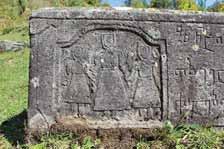
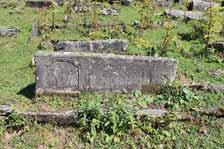
146. Dumatskho, Dusheti municipality, 139×44×41 _ Depictions are presented on different facets of the tomb chest. The side facet displays a full-length, frontal depiction of a man dressed in chokha-akhalukhi. We see his hat, his belt with dagger wrapped around his waist, and a pair of shoes. Surrounding the depiction of the man we see a half-length depiction of a ram, a pair of drinking horns, a jar, a sheep-shears, a flail and other, small decorative elements. The other composition embellishing the tomb is placed in the lower area and consists of the depictions of two rams facing one another and a figure of an angel above these. The main surface of the tomb displays only a simply shaped cross.
Epitaph: A three-line Mkhedruli inscription on the side facet of the tomb is damaged, and yet we can discern the date of death as May 25/26 in 1920. A prayer for the soul of the departed is also legible.
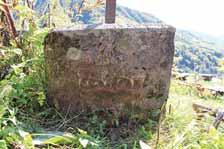

258
147. Dumatskho, Dusheti municipality, 123×32×40 _ Depictions are displayed on different facets of the tomb chest. The side facet shows a composition consisting of two figures surrounded by a moulded frame. The full-length frontal depictions of a woman and a man are carved, possibly depicting a wife and a husband holding hands. A flagon and a sewing machine are depicted by the depiction of the woman, within the same frame. Outside the frame, we see a jar and a reclining lamb, perhaps representing the Lamb of God. A similar depiction of a ram is carved on the opposite facet. The main surface of the tomb displays a large moulded cross.
Epitaph: The three-line Mkhedruli inscription on the side facet of the tomb gives the precise date of the death of the departed – March 15, 1932. The epitaph explains the meaning of the depictions; we know that the woman who passed away at the age of 30 was honoured (by the making of the tombstone) by her husband Kote, who, at the end of the text asks the reader to grant forgiveness to his wife and to remember her soul in prayer. The inscription on the main surface of the tomb is illegible.
148. Gamsi, new cemetery, Dusheti municipality, 146×45×50 _ Depictions are found on the different facets of the tomb chest. The side section displays a full-length, frontal depiction of a woman, carved inside a moulded frame, while several elements, displayed next to her, can no longer be identified. Among the elements of the woman’s clothing, we can distinguish her mantle, veil and long, one-piece dress, painted in red. Another relief, also surrounded by a frame, is carved on the upper facet of the tomb, which displays a half-length depiction of an angel holding a censer, while in the side and lower areas we see a carved candle holder and a jar tinted in red. Only a simply shaped cross is depicted on the main surface of the tomb.
Epitaph: A three-line Mkhedruli inscription, written with broken grammar, is severely damaged and is difficult to read. We find several graphemes identifying the departed – the name Markoz is included. The epitaph contains a supplication for the soul of the departed.





259
149. Gamsi, new cemetery, Dusheti municipality, 139×49×49 – Depictions are found on the different facets of the tomb chest. The side facet displays a full-length, frontal depiction of a man dressed in chokha-akhalukhi and holding a billhooked axe and sickle. This depiction is surrounded by a moulded frame. Another relief, also surrounded by a frame, is depicted on the upper facet of the tomb, showing a half-length depiction of an angel holding a censer, and surrounding it we see a candle holder, a grape cluster, and below these, a ram. The lower facet displays another composition, which includes relief depictions of a deer and a ram, standing facing one another. Only a simply shaped cross and gun are visible on the main surface of the tomb.


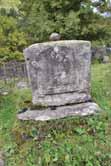

Epitaph: A three-line, poorly written Mkhedruli inscription shows severe damage, which makes it even more difficult to read its content. However, the fragments are sufficient to show that the text contains a supplication for the soul of the departed.
150. Gamsi, old cemetery, Dusheti municipality, 125×40×50 _ Depictions are displayed on different facets of the tomb chest. Two compositions surrounded by moulded frames are presented on a side facet. One of them depicts a three-domed church model and a floral branch next to it, while the other depiction shows a full-length, frontal depiction of a woman with lateral depictions of birds on eachside. She is wearing a one-piece, long dress decorated with vertically carved lines, and has a small cross hanging around her neck. The woman has her arms crossed over her chest in accordance with Christian custom. Different facets are embellished with the depictions of crosses, half-length depictions of angels, and floral and geometrical figures.
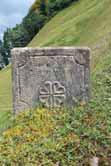
Epitaph: A three-line, poorly written Mkhedruli inscription is displayed on the side facet of the tomb, which has a supplicatory character, and asks the reader to remember the soul of the departed.

260
151. Makarta, Dusheti municipality, 121×34×42 _ Depictions are displayed on different facets of the tomb chest. The side facet shows the full-length, frontal depiction of a man dressed in chokha-akhalukhi, surrounded by a frame. The frame also includes the lateral image of a ram or antelope, standing inside a vessel shaped like a three-stepped chalice. The man is holding the horns of the animal in one hand and a gun in the other. We see his hat, his belt with dagger around his waist, and bandoliers across his chest. The composition includes a cross and small, three-petal motifs inserted between the antelope’s horns. The lower and upper facets of the tomb show a depiction of the cross and a composition with a ram and deer facing one another.

Epitaph: almost the whole area of the side facet of the tomb is covered with a three-line Mkhedruli inscription. We learn that a man who passed away at the age of 32 was interred by his wife Martha and their son Vasili on July 17. Apart from this, the epitaph contains a supplicatory epilogue addressed to the reader.
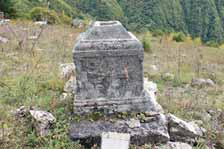
152. Maqartha, Dusheti municipality, 60×45×70; 53×42×10 _ Depictions are presented on one of the facets of a grave stele, showing a full-length, frontal image of a man dressed in chokha-akhalukhi. No details are visible. The composition must have been tinted in different colours, but now only the blue colour of the man’s clothing is preserved. The stele is surmounted by a cross carved from single stone, with an image of the crucifixion on it – the frontal figure of the crucified Jesus is depicted in the centre and is accompanied by half-length depictions of angels at both ends of the horizontal beam, and a depiction of a dove emanating rays in the upper area of the vertical beam.



Epitaph: the content of the inscriptions distributed all over the body of the stele is illegible, although the fragments of the inscription refer to a supplication for the soul of the departed.

261
153. Maqartha, Dusheti municipality, 122×35×37 _ The images are placed on different facets of the tomb chest _ the side section shows the full-length, frontal depiction of a man dressed in chokha-akhalukhi. We see his hat, a belt and a dagger wrapped around his waist, bandoliers across his chest, shoes, and a long gun, which he holds in one hand. Figurative depictions are surrounded by the images of a crescent, stars, two long candles and the figure of a ram, standing on a multi-step pedestal. The man is holding the ram by its horns, between which an image of a cross is inserted. Simply shaped crosses are carved on the main surface of the tomb and on the upper facet. The tomb must have been painted in colours, but today only small fragments of red, yellow, light blue and darker blue paint can be seen.


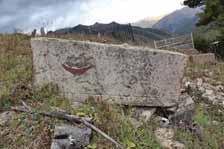


Epitaph: A four-line Mkhedruli inscription is written on the side facet of the tomb, from which we learn that Davit Tsiklauri, son of Beria Tsiklauri, passed away in November 1918 and his tomb was commissioned by his parents and his brothers – Giorgi and Stephane. The epitaph contains a supplicatory epilogue addressed to the reader.
154. Maqartha, Dusheti municipality, 128×43×51 _ The images are displayed on different facets of the tomb chest. The side facet displays a full-length, frontal depiction of a man wearing a felt-cloak (nabadi), surrounded by a frame. We see his tall shepherd’s hat, one shoe, and a flail (or possibly a shepherd’s crook) in his hand. Carved below the man’s figure is a lateral depiction of a reclining sheep. Outside the frame, a lamb is depicted lying down and placed on a crescent shaped vessel, representing the Lamb of God. The main surface of the tomb displays a simply outlined cross. The depictions must have once been painted in colours, from which only the shades of red and yellow are noticeable. Epitaph: A three-line Mkhedruli inscription, spread across the side facet, informs us that Elizbar Tsiklauri, son of Bera passed away at the age of 35 in 1927, and he was honoured (through the dedication of this tombstone) by his wife Nino. The epitaph contains a supplicatory epilogue addressed to the reader.
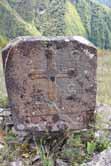
262
155. Maqartha, Dusheti municipality, 89×36×42 _ The images are presented on different facets of the tomb chest. On the side facet we see a frontal depiction of a human being surrounded by a circular frame. The frame is decorated, and the half-length depiction of a human being is holding the arms crossed over the chest in accordance with Christian custom. The main surface of the tomb displays a cross of a simple design.
Epitaph: Mkhedruli inscriptions are inscribed on the main surface of the tomb and on the side facet. The four-line inscription on the main surface, and the three-line inscription on the side facet inform us that the gravestone belongs to the graves of a brother and sister who died at an early age in August 1901. We can read the name of the boy – Giorgi Tsiklauri who was probably 9 at the time. The epitaph contains a supplicatory epilogue addressed to the reader.

156. Maqartha, Dusheti municipality, 128×40×36 _ The images are displayed on different facets of the tomb chest. The side facet presents a full-length frontal depiction of a man dressed in chokha-akhalukhi surrounded by a moulded frame. We see his hat, belt with a dagger, bandoliers across his chest, and his shoes. The man is holding a gun with one hand and in the other hand he is holding a ram or an ewe depicted standing on is hind legs and shown from a lateral view. Above the animal, next to the man, we see a half-length frontal depiction of an angel, spreading his wings in different directions. The main surface of the tomb carries the depictions of a sword, a dagger, a gun, and a whip. Additionally, there will once have been a cross on the tomb, although only the foot of the cross survives today.

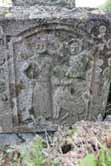

Epitaph: Mkhedruli inscriptions spread across different facets of the tomb are mostly commemorations of the departed in the form of poetry, from which we learn that the person passed away in November 1918. Due to severe damage and the poor grammar of the text, it is difficult to read the content. The epitaph contains a supplicatory epilogue addressed to the reader.

263
ERTSO-TIANETI
157. Tetrakheva, Tianeti municipality, 149×50×34 _ Artistic and conceptual representations are displayed on the surface of a rectangular gravestone, showing a full-length frontal depiction of a man. The pictorial elements display a stylized garment, a personalized hairstyle or a hat, which creates a crescent shape around his head; his shoes can also be traced. The man is depicted with his arms crossed over his chest in accordance with Christian custom. The surface of the grave is partially framed by a simple border.
Epitaph: It is impossible to read the inscriptions in the Mkhedruli script on the side facet of the stone.


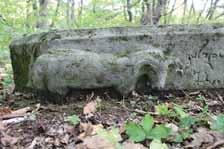



158. Tetrakheva, Tianeti municipality, 153×43×35 _ Artistic and conceptual representations are displayed on the various sections of a non-standard rectangular stone, including a full-length frontal depiction of a man dressed in a chokhaakhalukhi. From the elements depicting his clothing we can distinguish a hat, a belt with a dagger, a one-piece mantle and the suggestion of a pair of shoes. The objects depicted around the male body include: a whip, a gun, a pair of sheepshears, and a small, simply shaped cross. On a side facet we see the depiction of a lateral view of a saddled horse; on the other side there is a bull, the body of which is depicted in profile while its head is turned towards the viewer. One hand of the man is lowered, while the other is placed near his chest.
Epitaph: from the two-line inscription in the Mkhedruli script, divided on both side facets of the rock, we learn that the “shepherd” Malaqia died at the age of 38 on May 6, 1890. It is noteworthy that the attributes shown by pictorial elements reveal his profession, which is also confirmed by the epitaph.
159. Tianeti, Tianeti municipality, 70×60×25 _ Artistic and conceptual representations are displayed on the surfaces of a pair of rectangular tombs, which show full-length frontal depictions of a man and a woman. From their appearance we can observe their personalized hairstyles, elements of the customary dress and shoes, and their hands, which are lowered. The man is wearing a belt around his waist.
264
160. Zhebota, Tianeti municipality, 145×52×52 _ Artistic and conceptual representations are displayed on the surface of the rectangular stone, showing a full-length frontal depiction of a woman. The pictorial elements show her cross hanging around her neck, her stylized garment with a lace embellished with simple ornaments. The surface of the stone is framed with a moulded border and its bevel-cut edge is decorated with a floral ornament.
Epitaph: It is impossible to read the Mkhedruli inscriptions on the facets of the stone.



161. Zhebota, Tianeti municipality, 148×50×51 _ Artistic and conceptual representations are displayed on the surface of the various sections of a rectangular stone, showing a full-length frontal depiction of a man dressed in simple clothes. The pictorial elements allow us to see his hat, his belt and an indication of shoes. We see various objects around his body: a simply shaped cross, a hammer, a pair of pliers and a type of a screwdriver. Two objects are depicted on the upper part of the stone, yet it is impossible to identify them. However, one may possibly be an anvil and the other, a chisel. The man is depicted with his arms crossed over his chest in accordance with Christian custom.
Epitaph: on the side facets of the rock, we can read the three and four-line Mkhedruli inscriptions, which are composed in a style of formal poetry. The epitaph mentions Nikoloz Saghirashvili, the son of Mathe (Matthew), who passed away on May 9, 1927. It is important that the attributes depicted by the pictorial elements and the profession of the deceased referred to in the epitaph (“I was a worker of hard work, a master of iron and wood, who wrestled with them intently till the moment of my own death”) fully correspond.
265
MTIULETI
162. Arakhveti, Dusheti municipality, 144×45×58 _ Depictions are found on different facets of the tomb chest – we see two relief compositions displayed on the side surface of the tomb. One of them is surrounded by a moulded frame and depicts a full-length, frontal depiction of a man dressed in chokha-akhalukhi. The man is wearing a belt with dagger wrapped around his waist, and one hand rests upon the dagger. A large copper jug is placed by the man’s feet. A decorative motif of a berry plant is visible in the corner near his head. Outside the frame we see a figure of an animal standing on a crescent-shaped dish. The main surface displays only a cross of simple design, and a sickle.

Epitaph: A four-line Mkhedruli inscription on the side facet of the tomb informs us that the departed was “Datika Bakriuli, son of Giorgi” who passed away at the age of 23 in 1924, and his brother, Nikua “honoured” him (by commissioning this stone for him). Besides, the epitaph contains a supplicatory text for the soul of the departed.



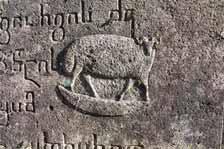
163. Arakhveti, Dusheti municipality, 137×49×58 _ Depictions are placed on different facets of the tomb chest – we see a relief composition spread across the lower part of the tomb, which consists of two rams standing facing each other from either side of a large cross. The composition is surrounded by a moulded frame. The highlights of the composition are the half-length depictions of angels above both arms of the cross, and a vivid, up-and-down sense of movement is created by the manner in which their wings have been carved. The main surface of the tomb depicts a cross of simple design with a figure of an angel above one of its arms. We see the spears of the crucifixion in the side areas next to the cross. Epitaph: A four-line Mkhedruli inscription on the side facet of the tomb tells us that “in 1911, in this grave, rests Ivane Burduli Gurdua, son of …, passed away on December 5, O reader, grant me forgiveness”.

266
164. Kvesheti-Sefe, Dusheti municipality, 113×33×33 _ The only depiction is found on the side facet of the tomb chest. The depiction is surrounded by a moulded frame. The frame and the composition were painted, but now we can see only small spots of blue, red and yellow paint. The composition involves several elements including a full-length, frontal depiction of a woman, leaning on a cradle with one hand. An angel is depicted above the cradle, with his wings spread in different directions.
Epitaph: Different Mkhedruli inscriptions on various facets of the tomb are severely damaged. The fragments tell us that the departed was only 16 in 1911/13. Additionally, the epitaph contains a supplicatory note addressed to the reader.


165. Kvesheti-Sefe, Dusheti municipality, 125×38×38 _ Depictions are placed on different facets of the tomb chest –the main surface shows the haut-relief image of a cross. A single figurative composition is found on the side facet, surrounded by a moulded frame. The elements of the composition were painted in different colours. We can trace spots of yellow and red paint, which are severely eroded today. The composition is built around a vertical axis and displays the full-length, frontal depiction of a woman and man leaning on one another. We can distinguish the details of their clothing – the man’s hat, his chokha-akhalukhi painted in red and the woman’s headscarf, dress and blouse with closed neck. It is interesting to note how the woman and the man are depicted next to each other, because the man is depicted slightly to the front of the woman so that the woman’s lower right hand is not visible behind him. This brings in the concept of perspective.


Epitaph: The four-line Mkhedruli inscription on the side facet tells us that a married couple Giorgi Buvhukuri son of Ioseb and his wife Nino, daughter of Adam passed away in 1919. The epitaph also informs us that “Giorgi was 35 and Nino was 32. I, their daughter Maro honoured them by erecting this tomb”.

267
166. Muguda, Dusheti municipality, 187×63×65 _ Depictions are placed on different areas of a three-step grave stele. One of the facets displays a full-length, frontal depiction of a man dressed in chokha-akhalukhi and wearing a belt with a dagger around his waist. Different areas of the figure are tinted in different colours. The stele is surmounted with a cross cut out of a single stone, with a crucifix carved on it. On the side areas next to the cross, half-length figures of angels are carved and a medallion-like depiction of a star is placed above the man’s head. A similar composition is displayed on the other side of the same monolithic cross. Compositional elements and structure are also similar. We encounter various small details on the stele, such as a jug, a comb, a table, a teapot and other decorative elements.

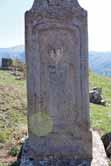

Epitaph: in the fourteen-line Mkhedruli inscription spread across two facets of the tomb we read: “Sleep my unforgettable son, Giorgi, in the bosom of immortality, we shall also reach the blessed day when we shall find our place of rest together with you”. The nine-line inscription on the third facet tells us, that the departed Giorgi Gigauri, son of Mose, passed away in the 19th c.
167. Muguda, Dusheti municipality, 118×40×50 _ Depictions are placed on different sections of the tomb chest – we see a relief composition in the centre of the side facet which shows a full-length, frontal depiction of a “woman with an infant” surrounded by a frame. We see the details of her clothing _ her long, one-piece dress and a headscarf. The depiction of the baby is rather schematic and no details can be distinguished. The main surface of the tomb displays only a cross of simple design.
Epitaph: The six-line Mkhedruli inscription on the main surface and a side facet of the tomb informs us that “Nino Aptsiauri, daughter of Simon, wife of the son of Sulia Kavraria” passed away in 1906. Additionally, the epitaph also contains the following information: “I left a three-year-old daughter and a sick mother-in-law. O reader, grant your forgiveness”.

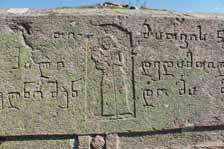

268
168. Muguda, Dusheti municipality, 105×34×44 _ Depictions are found on different facets of the tomb chest, but only a cross of simple design is placed on the main surface. The composition on the side facet of the tomb is surrounded by a moulded frame. The central area of the relief composition depicts a woman with a headscarf, with her palms clasped near her abdomen and holding a candle. On one side from her we see a tall candle holder and a small jug, while on the other side we see an animal standing in a chalice shaped as a multi-stepped vessel. Another figurative depiction is displayed on the upper facet of the tomb, showing a half-length figure of an angel with a ram kneeling in front of him. The lower facet of the tomb is decorated with a depiction of a deer surrounded by a frame. The deer is standing in a “field” and is tied to the torus moulded border.


Epitaph: The four-line Mkhedruli inscription on the side facet informs us “Sofio Gigauri, wife of Mose” passed away at the age of 60 in 1929 and was “honoured” (by commissioning this stone) by her brother-in-law Tevdore. Additionally the epitaph contains a supplicatory note addressed to the reader for “remembering the soul of the departed”.
169. Muguda, Dusheti municipality, 126×40×45 _ Depictions are placed on different areas of the surface of the tomb chest. The main surface displays a cross of simple design and a composition carved below the cross, which depicts weapons and military accoutrements. The depictions of a dagger and a gun diagonally intersecting each other form a single compositional element and a shepherd’s crook is erected next to them. On the upper semi-circular part, we see a hand coming out of a sphere and directed towards the weapons and military accessories. A lamb standing in a chalice-like vessel and a ram in a reclining position are carved on the side facet of the tomb. A similar figure of a reclining ram is carved on the lower facet of the tomb.
Epitaph: The severely damaged four-line Mkhedruli inscription on the side facet informs us that a young man was killed in a flood at the age of 20 in 1922. His name is illegible.


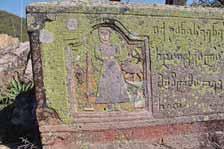

269
170. Muguda, Dusheti municipality, 132×41×48 _ Depictions are found on different areas of the tomb chest – the main surface of the tomb displays only a cross of simple design. The only figurative composition decorating the tomb is displayed on the lower facet of the tomb, showing a highly skilled depiction of a deer surrounded by a moulded frame. The animal is depicted from a lateral view and in motion. It is tied to the edge of the frame with a rope.
Epitaph: the fragmentary reading makes clear that the son died in 1924. The epitaph contains an inserted text with the following words: “I was the only child, newly married, I ask you brethren, to always be merry and also remember me, may each of you grant me a single forgiveness”.
171. Pasanauri, Dusheti municipality, 144×48×58 _ Artistic and conceptual representations are displayed on the upper and lower facets of the gravestone. The lower facet is occupied by the depiction of a circular five-petal flower motif, while the upper facet shows a medallion with the frontal half figure of a man with his hands lowered. Even though there are no clear signs indicating the gender of the person, yet three circular and a cross shaped medallions in the area of the chest of the figure lead one to believe that the departed must have been a military officer.



Epitaph: Although it is impossible to read the precise content of a two-line Russian inscription on the side facet, we may still say that the presumed date of the man’s death should be identified as 1900.


172. Tsinamkhari, Dusheti municipality, 208×58×58 _ The images are displayed on a single facet of a grave stele, showing a full-length frontal depiction of a man dressed in chokha-akhalukhi and surrounded by a moulded frame. We see his belt with dagger wrapped around his waist, and his hat and his shoes. The composition is painted in different colours–the frame shows traces of red paint, the background is yellow, and the man is tinted in either blue or black. The upper, surmounting part of the stele is embellished with a cross carved from a single stone.

Epitaph: An eight-line Mkhedruli inscription carved on one of the facets of the stele identifies the name, gender and age of the departed, and it contains a supplicatory epilogue addressed to the reader – Niko Aptsiauri, son of Makharobeli, as known from the text, passed away before his time, at the age of 16, and his tomb was made by his brother and his parents.
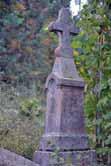
270
173. Chargali, Dusheti municipality, 100×40×45 _ Artistic and conceptual representations are displayed on a section of the rectangular surface of a chest tomb, portraying a full-length, frontal depiction of a man. From his appearance we may distinguish his one-piece chokha and robe, his trousers, his moulded personalized hairstyle, and shoes with heels. On the upper section of the figurative depiction, we see half figures of two angels almost forming a halo around the man’s head. The surface of the stone is framed by a border with a bevelled edge, decorated with a floral ornament. The man is depicted with his arms crossed over his chest in accordance with Christian custom.
Epitaph: The tomb inscriptions are traced across two side facets, one of which is unreadable, while the two-line inscription in the Mkhedruli script on the other side tells us that the late “grandpa Fadiuri, the son of Marmazan [has passed away at the age of] 60 years from his birth”.
174. Chargali, Dusheti municipality, 92×30×25 _ Artistic and conceptual representations are displayed on a section of the rectangular surface of the tomb chest, where a small cross is depicted erected on a pedestal. A jug and a cup are carved under both arms of the cross, while the half figures of angels are depicted in the upper corners, which also fill up the spaces in the corner angles. The stone is surrounded by a geometric, ornamental frame.
Epitaph: We find here a three-line inscription in the Mkhedruli script, which contains many linguistic errors. The epitaph mentions Natela, the daughter of Betsina, and the wife of somebody called Ivane Gura; part of the tomb with information about her birth and death has most probably subsided below ground.
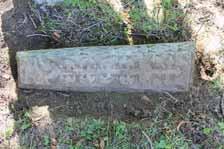



271
KHEVI
175. Juta, Kazbegi municipality, 100×30×40 _ Depictions are found on different facets of a tomb chest. The side surface displays only one, very small ram. It is depicted in a rather archaic manner – the body parts are remarkably disproportionate; the horns are enlarged, and the details are only vaguely suggested. A similar style is employed in the almost haut-relief depiction of a man riding a horse, found on the upper facet of the tomb, which also creates an impression of archaism by its generalized and suggestive style of carving. The figure of the horse is carved in higher relief than the figure of the ram. This style of carving, which is nearly haut-relief, is not at all typical of the local area and is something of an exception. It is no coincidence that no inscriptions are found on the tomb, which together with other stylistic details, leads us to think that the tomb may be relatively older.

176. Juta, Kazbegi municipality, 150×55×45 _ Depictions are found on different surfaces of the grave stele, including the full-length, frontal depiction of a man surrounded by a moulded frame on the central facet. The man is wearing a chokhaakhalukhi with a hat, and a belt with a dagger. His one hand is holding a bull by its horns. Under them we see a wheel of what may be a plough, on which the bull is standing on two legs. Raised textures indicate the arable land beneath. Different areas of the stele are decorated with floral and geometrical motifs painted in different colours. The stele was once surmounted by a cross, and on the remaining lower area now we can only see a pair of feet suggesting that there was a crucifixion carved on the cross.



Epitaph: From the Mkhedruli inscriptions on different facets of the stele we learn that Mindia Arabuli, son of Apareka passed away in 1922. Besides, the parts of the epitaph written in verse appear on different areas of the stele. In one of them we read “You lived to the age of 30, enjoying the title of a hero in Juta, but now you are entrusted to the earth and your family is grieved by the misery.”

272
177. Karkucha, Kazbegi municipality, 140×52×52 _ Depictions are placed on different areas of the tomb chest – we see two relief compositions, one of which is surrounded by a moulded frame and depicts a full-length frontal depiction of a man dressed in chokha-akhalukhi with a belt and a dagger wrapped around his waist. The man is holding a cross placed on a tall candlestick with one hand, and a ram with the other. The animal is standing in a chalice-like vessel. There is another, smaller composition on the upper facet, surrounded by a circular frame. The frame is decorated, while the depiction of a standing ram inside it is highly stylized. The main surface of the stone is left blank.
Epitaph: The three-line epitaph reads “passed away at the age of 63, on December 19, in 1920, we, his sons honour him, visitors, please grant me forgiveness”.

178. Sno, Kazbegi municipality, 206×56×51 _ Depictions are found on different areas of the grave stele. The figure of St George on horseback is displayed in the middle area, while the stele is surmounted by a cross of a complex design cut out of a monolith. In all the four corners around the centre of the cross, where the beams intersect, small floral motifs are placed. It is noteworthy that a relief composition of the crucifixion was carved on the cross, but it is now almost fully faded. Only the central figure of the crucifix is vaguely visible. One of the facets of the stele presents the scene of St George piercing the dragon. The figure of the woman standing in front of the saint depicts the princess from the “miracle of the city of Lacia”. The young woman tamed the dragon by the grace of [God and with the assistance of] the saint and tied it up with her girdle. The upper left corner displays a figurative depiction covered in clouds, which presumably aims to portray heavenly powers (an angel or God). The composition must have been painted in colours, but severe damage has scoured off the paint.




Epitaph: Inscriptions on different areas of the grave stele are not clearly legible. We can figure out that the name of the departed was Ioseb.
179. Sno, Kazbegi municipality, 159×53×62 _ The only depiction is found on the side facet of the tomb showing a horse attached to a two-wheeled cart, and a man sitting on the cart and holding a whip in his hands. The composition is surrounded by a simply moulded frame. The depictions were likely painted but severe erosion has washed away the colours.
Epitaph: The Mkhedruli inscriptions on the side facets are illegible. All we know is that the departed was called Giorgi and he passed away in 1910.


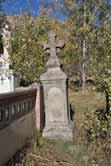

273
IMERETI

180. Amashuketi, Kharagauli municipality, 158x40x38 _ Artistic and conceptual representations are displayed on different areas of a rectangular tomb. The main surface displays a cross of complex design, standing on a base. The cross is surrounded by various geometrical elements and other ornaments decorating different areas of the tomb’s surface. A full-length, lateral haut-relief depiction of a ram is carved in the middle of the side facet of the tomb. We can see the curved horns of the ram, tail, part of the face and the body with a textured surface, suggesting the detail of its fur. The side facets of the tomb are decorated with small decorative arches carved with bas-relief technique. The upper facet displays an arch with grapes hanging around it, while the birds eating them are depicted from an aerial viewpoint.
181. Amashuketi, Kharagauli municipality, 177x50x120 _ Artistic and conceptual representations are displayed on different areas of the gravestone. The tomb is a combination of two different types of grave stone _ we see a horizontal, rectangular, elongated ledger stone with a grave stele erected on its upper side. The surface of the ledger is surrounded by a decorative border with floral ornament, inside of which we see the depiction of a cross. On a side facet we see a half-length depiction of an angel along with decorative motifs while the other side facet displays a ram or ewe carved with haut-relief sheep’s fur is carved in a way that it defines its texture. Depictions are displayed on different areas of the surface of the grave’s stele. The front facet shows a moulded cross, while a side facet presents a full-length frontal depiction of a man with his arms spread wide and holding a cross in one raised hand. The figurative carving is generalized – we see conventionally suggested shoes with heels and a long, one-piece garment. The upper area of the body of the stele is decorated with a decorative arcade, inside of which we see segments tinted in blue.
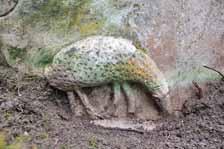



274
182. Banoja, Zestaphoni municipality, 180×67×10 _ Artistic and conceptual representations are displayed on a segment of the surface of a rectangular gravestone, showing two similar relief compositions on both the upper and lower parts. In these compositions the stylized full-length figures of angels are carved on both sides of a flourishing cross – the depictions are presented frontally in the upper part but in the lower part they are presented laterally. A slightly extended version of the composition is displayed in the upper part of the gravestone, where, unlike in the lower part, half-length figures of angels are added to both corners. In the lower part of the composition the angels’ positions with respect to the cross identify the scene as The Elevation of the Holy Cross. The surface of the stone is surrounded by an ornamental frame.
183. Chikha, Sachkhere municipality, 23×90×90 _ The first part of this large multi-step obelisk is its two-step base, on which an open baldachin-like model is standing with openings on all sides. We see above it a small faceted ledge; a model of the church dome is situated higher up together with its drum and roof. The obelisk is abundantly decorated with different ornaments all over its columns, base and capitals, as well as on the inside of the arches, on the pediments and on other areas. The upper part of the pediment is decorated with small, embossed hemispheres. Besides, the inner surfaces of the pediment are embellished with a relief border of a saw-tooth ornament.



Epitaph: Inscriptions displayed on the facets of the obelisk base are carved on a marble stone. We have five and ten-line epitaphs in the Mkhedruli script, one tile of which is solely dedicated to lamentation and mourning, although it is not perfectly legible, while the other inscription tells us that on December 25, 1905 “the servant of God, Ivane Nadiradze, son of Onise”, who was born in March 1880, passed away.

184. Chikha, Sachkhere municipality, 167×41×33 _ Artistic and conceptual representations are displayed on the surface of a rectangular ledger stone, where a vertical rectangular “board” displays depictions. The centre of the composition contains a cross, the beams of which have three-petal finials. In the edges of the horizontal beam, we see the full-length frontal depictions of angels. It should be noted that the three-petal edge of the lower beam of the cross merges with the beaks of two birds depicted on both sides of the cross, both holding the same piece of food with their beaks. The ledger gravestone is framed with smaller torus moulded borders, the corner segments of which are decorated with abstract ornaments.

275
185. Chikha, Sachkhere municipality, 184×52×29 _ Artistic and conceptual representations are displayed on the surface of a rectangular ledger stone, where a vertical rectangular “board” displays depictions. The centre of the composition contains a cross, the beams of which have three-petal finials. Above and below the cross we see the full-length frontal depictions of human beings with open arms and a depiction of a bird. A small ledge is intended for holding a candle. We see decorative segments made up of abstract figures around all the depictions. The surface is framed with wave-like and torus moulded borders.

186. Chikha, Sachkhere municipality, 160×41×25 _ Artistic and conceptual representations are displayed on the surface of a rectangular ledger stone, where a vertical rectangular “board” displays depictions. The central image of the composition contains a cross, the beams of which have three-petal finials. Above and below the cross we see a variation of the borjgali motif on one side and a four-petal foliage motif on the other. We see small carved lines, which create a certain kind of divider between the depictions or segments. The surface of the ledger stone is framed with wave and torus moulded borders.
187. Chognari, Samtredia municipality, 30x34x11 _ Artistic and conceptual representations are displayed on a vertical slab of a small grave stele, where the central facet is embellished with an embossed cross, with lateral depictions of birds placed in the angles between its upper arms. The birds are pointing downwards and touch the centre of the cross with their beaks. It is likely that the figurative depictions were also present in the corners of the lower area of the cross, but the section is subsided below ground and therefore the composition is not fully discernible. Inscriptions and floral décor are found on the back of the stele.
Epitaph: The content of the inscription on the back of the stele is unreadable. We can only see a date – 1814, but it is unknown whether it is the date of birth or death.


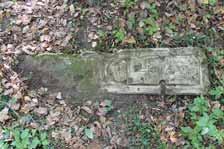

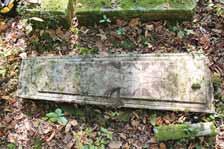
276
188. Chognari, Terjola municipality, 175×53×16 _ Artistic and conceptual representations are displayed on a section of the surface of a rectangular ledger stone, showing several depictions. The central figure of the composition is a flourished cross with a simple moulding, accompanied by a foliage motif on both sides. In the upper corners formed by its horizontal beams, half-length figures of angels are sculpted, while under it a relief bird’s eye view of a ram is depicted. One should note a round, plate shaped section, the surface of which is further divided into segments – it looks like the plate was intended for holding different types of food. The ledger stone is framed with a border of embossed triangles.
Epitaph: Inscriptions are found in the lower part and occupy half of the surface of the grave, yet, it is impossible to read most of it – we can read only two lines in the Mkhedruli script, which inform us that the departed was a woman.
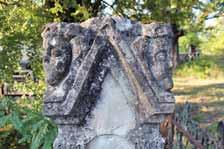


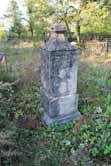


189. Chognari, Terjola municipality, 165×57×57 _ Artistic and conceptual representations are displayed on different areas of a small, three-step stele. On one side we see grapes and pomegranates depicted across two surfaces so that they are attached to the branches of a tree. This medium-sized carving of the tree may represent “tree of life”. We see another similar depiction above it where a tree covered with leaves contains a small full-length lateral depiction of an angel on one of its many branches. Similar motifs, although without angels, decorate the other facets of the stele – they are framed with a simple border.
Epitaph: A heavily damaged eight-line inscription in the Mkhedruli script is observed on a facet of the stele, which tells us that on June 18 in 18[...]5 Solomon Lanchava, son of Ivane, passed away. The epitaph contains the supplicatory prayer for the departed at the beginning and the end.

190. Chognari, Terjola municipality, 147×58×44 _ Artistic and conceptual representations are displayed on the upper section of a medium sized three-step stele and on the corners of its pediment, displaying various “portraits”. All four portraits in the corners are carved with moderately high relief and are distinguished by their high level of generalization. It is possible to interpret such depictions as figures of angels. The gravestone consists of a horizontal ledger stone and a stele raised slightly above the upper part of the ledger. The construction of the stele is highly geometric, well ordered, with balanced proportions and decorative elements.
Epitaph: Inscriptions are found on a small section, inside the arch of a niche. From the text we learn that the departed was called Nina, was the daughter of Samson Levidze and wife of Alexandre Lakidze, and she passed away in 1930.
277
191. Chognari, Terjola municipality, 160×56×54 _ A small sized headstone is erected vertically and bears a niche-like aperture. Artistic and conceptual representations are displayed on different sections of the middle and upper parts of the stele. We see a full-length frontal depiction of a man, the details of which are not clearly visible: we see his arms crossed over his abdomen. A cornice is moulded above the depiction and a base is moulded below. Above the cornice we see a crown-like head piece, finished with a four-petal motif. Depictions of a ram, a human being, a bird and an angel are vaguely traced on its smaller facets.
192. Chognari, Terjola municipality, 147×38×34 _ Artistic, conceptual and figurativerepresentations are displayed on different sections of a rectangular gravestone. A full-length frontal haut-relief depiction of a woman is observed on the upper facet of the stone. The depiction is small and fills the whole surface. Above the depiction of a woman, half-length frontal depictions of two angels are depicted on the edge of the stone on both sides of a simply moulded cross. The surface and side facets of the stone are decorated with floral ornaments, while, on a rectangular extension raised from the edge area in the middle of the stone, we see an aerial view of a ram laying down. Epitaph:A two-line inscription in the Mkhedruli script on the surface of the tomb is severely damaged, yet it informs us that the name of the departed was Minadora Grigolia and that she passed away in 1908.
193. Chognari, Terjola municipality, 115×30×36 _ Artistic, conceptual andfigurativerepresentations are displayed on different parts of a rectangular gravestone. A small, full-length frontal depiction of a woman carved in haut-relief is located on an upper facet. Her figure fills the entire length of the surface of the stone. She is situated between two cypresses, trees the shrubs of which are facing one another. Above her figure on the cut edge of the stone, we see halflength frontal depictions of two angels placed on both sides of a simply moulded cross. The surface of the stone and its sides are decorated with floral ornaments.


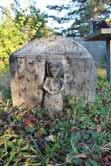


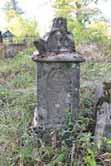
Epitaph: severe damage the rest of the inscription is unreadable. It should be noted that the small size of the girl’s depiction is consistent with the content of the epitaph.

278
194. Chorvila, Sachkhere municipality, 174×53×207 _ The gravestone is a combination of two different types – Here we have a rectangular, long and fairly massive tomb chest, with a vertical obelisk raised upon it, decorated with different geometric and figurative motifs. A Golgotha Cross is carved on the surface of the rectangular stone, the finials of which are in the three-petal decoration. A part of the obelisk is a depiction of a church, and displays a highly generalized fulllength frontal depiction of a man, with a bird sitting on his head. The man’s clothes are depicted using carved lines;

decorative motifs.
Epitaph: mourning character, while from the other part we learn that on April 2 in 1900 at the age of 25 years “from his birth” Vasil, son of Beso Demetrashvili passed away. Besides, the epitaph also contains a supplicatory note addressed to the reader.

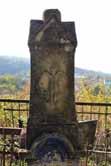
195. Chorvila, Sachkhere municipality, 180×51×20 _ Artistic and conceptual representations are displayed on a section of the surface of a rectangular ledger stone showing different kinds of rectangular and circular elements. We see an embossed image looking like a coat of arms on the segment, on which we can distinguish a relief cross with the beams ending with three-petal shapes. On both sides of the cross, full-length frontal images of angels are depicted. The surface of the cross is decorated with little holes. On both sides of the horizontal beams of the cross, on the main surface of the ledger stone, carved depictions of birds are displayed. In terms of the manner of execution, they resemble the figures of angels. The surface of the ledger stone is framed with a simple torus moulded border. Epitaph: Inscriptions are displayed on the lower part of the surface – the surviving six-line Mkhedruli epitaph is almost unreadable.

279
196. Didi Jikhaishi, Samtredia municipality, 176x65x122 _ Artistic and conceptual representations are displayed on different parts of a composite gravestone. The tomb consists of a combination of two different types of gravestones – a horizontally elongated ledger stone and a stele erected on its upper part. The surface of the stone is surrounded by several borders decorated with geometrical ornaments. Inside of the border in the upper area if the stone we see a moulded, flourishing cross with carved angels in all the four angles around the centre of the cross. A half-length depiction of an angel is placed within the decorative semi-circular arc of the base of the cross. Also, half-length depictions of angels are placed diagonally facing down the upper beam of the cross, while two full-length frontal depictions of angels are carved under the arms of the cross with their wings lowered and their hands stretched out to the sides. In the lower part of the surface there is a circular design made from a floral motif. Each of the three facets on the lower part of the stele display an angel. These angels are of similar design. The depictions are engraved – they are depicted as full-length frontal depictions and they all have their arms spread wide, while their wings are lowered. A canopy-like candle holder, open on three sides, is carved into the upper part of the stele.
Epitaph: Only a few graphemes have survived from the Mkhedruli inscription on the surface of the ledger stone.

197. Ghaniri, Samtredia municipality, 64x38x10 _ Artistic and conceptual representations are displayed on different areas of a grave stele. The stele itself is presented in the form of a cross, the front side of which displays a relief depiction of a wreath decorated with foliage elements. The wreath is raised up from the surface of the cross and creates a kind of circular frame for the stele. At the point of the intersection of the arms of the cross, inside the wreath-like frame, we see a half-length frontal depiction of a human being with arms crossed over its chest. The figurative depiction consists of a half body below which we see a vessel-like object with a layered, saw-toothed edge. This object may represent a baptismal font in which the depicted human being is placed. Considering the shape, size and design of the gravestone, we may conclude that the memorial marks the resting place of an infant.
Epitaph: The inscriptions on the back of the cross are unreadable due to severe damage.



280
198. Ghaniri, Samtredia municipality, 70x40x12 _ Artistic and conceptual representations are displayed on different areas of the grave stele. Th stele itself is presented in the form of a simple cross, the front face of which is embellished with a relief “wreath” decorated with floral elements. The wreath is raised up from the surface of the cross and creates a kind of circular frame for the cross. At the point of the intersection of the arms of the cross inside the wreath-like frame, we see a half-length frontal depiction of a human being with arms crossed over its chest. The figurative depiction consists of a half body underneath of which we see a vessel like object with a layered, saw-toothed edge. This object may represent a baptismal font in which the depicted human being is placed. Considering the shape, size and design of the gravestone, we may conclude that the memorial marks the resting place of an infant.
Epitaph: The inscriptions inscribed on the back of the cross are unreadable due to severe damage.
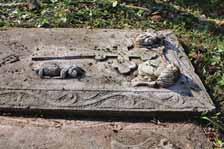



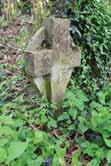

199. Ghaniri, Samtredia municipality, 176x50x15 _ Artistic and conceptual representations are displayed on the surface of a rectangular ledger stone showing a depiction of a man contained within a frame consisting of a decorative arcade. The depiction is presented as a “portrait” – we see part of the face and a moustache. The lower part of the portrait is left uncarved, and contains a long inscription in Mkhedruli script. The area is fully surrounded by a border made from geometric ornaments.
Epitaph: A long Mkhedruli inscription on the surface of the tomb is unreadable save for a few graphemes. It’s content cannot be understood.

200. Gumbra, Zestaphoni municipality, 178×60×11 _ Artistic and conceptual representations are displayed on a segment of the surface of a rectangular gravestone, showing a relief cross in the upper area of the stone. Above the arms of the cross are stylized frontal depictions of half-length figures of angels. A haut-relief image of an aerial view of a sheep or a ram is carved beside the lower vertical beam of the same cross. The grave is surrounded by a border, embellished with a floral ornament. The faces of angels are carved in an almost haut-relief technique.
Epitaph: The lower part of the ledger surface is filled with a nine-line inscription in the Mkhedruli script, part of which is damaged and is unreadable. A partial reading of the epitaph demonstrates that the departed is somebody whose family name was “Minadze, the son of Nikoloz”, who passed away “at the age of 65 in 1910”.
281
201. Gumbra, Zestaphoni municipality, 134×48×5 _ Artistic and conceptual representations are displayed on a segment of the surface of a rectangular gravestone, showing a moulded cross in the upper area of the stone. Below the arms of the cross there are stylized, frontal depictions of the full-length figures of angels. The grave is surrounded by a border with a saw-tooth ornament. A large six-petal flower is contained within a simple frame in the lower part of the ledger’s surface.


Epitaph: The severely damaged ten-line inscription in the Mkhedruli script fills the middle of the ledger surface. Due to the crude shaping of letters and deterioration of the structure of the stone, it is impossible to read the content of the inscription. Only fragments of the text are visible, which indicate the date of birth of the departed _ 1881 and refer to his identity as possibly Andria Chikhladze. In addition, the last part of the epitaph contains a supplication.
202. Gumbra, Zestaphoni municipality, 148×55×46 _ Artistic and conceptual representations are displayed on the front surface of a vertical, obelisk, which carries the principal and unique depiction of this gravestone. The upper part of the body of a woman with angel’s wings is embellished with her long hair, moulded and spread around over her shoulders. Her facial features are depicted in great detail, as are the details of her wings. The body is depicted standing up, and the main part of her body is covered with inscriptions, below which we can see small parts of her feet. The upper section of the monument is crowned by a moulded triangular pediment, while the bottom of the stele is a decorated base.


Epitaph: Inscriptions with many lines in the Mkhedruli script, mention a student with the name Sergo who passed away at the age of 25 in 1910.It also mentions his grieving mother Anastasia, daughter of Gegechkori.

203. Gumbra, Zestaphoni municipality, 50×10×39 _ Artistic and conceptual representations are displayed on the surface of a small cross carved from a single stone. The middle of the cross and its horizontal beams are fully covered with inscriptions, while the upper part displays an exaggerated and conventional “portrait” of a human being with a special emphasis on the eyes and nose. At the point where the horizontal and vertical beams intersect, two figurative depictions are presented on top of one another – the upper one is a ram lying down, the body of which is depicted by linear waves, while the one underneath is a carved bird, holding a grainy plant in its beak.
Epitaph: The horizontal beam of the cross presents a four-line inscription in the Mkhedruli script, which is displayed using letters with rather complex outlines – “here rests in peace Sergo, the son of Ivane [Gureshidze] who passed away in 1916”.

282
204. Zeda Bertisa, Tkibuli municipality, 196×50×50 _ Artistic and conceptual representations are displayed on different parts of the obelisk, including the middle area, where the depiction of a man and a pair of fish contained inside simply moulded frames are preserved. Besides the decorative motif, depictions of fish with similar connotations are displayed on other segments of the obelisk’s body. The full-length frontal depiction of a man is distinguished by its small size. The elements of his garment and other decorations are almost unreadable due to the extremely generalized and stylized nature of the depiction of his body. The man is stretching one of his hands horizontally to one side, while he holds the other arm akimbo. The bottom of the obelisk is a three-step base, while its top is finished with a heavily decorated domed canopy openings on three sides, in which an area is reserved for holding a candle.
205. Zeda Beretisa, Tkibuli municipality, 170×41×27 _ Artistic and conceptual representations are displayed on different sections of a rectangular stone with all its facets decorated with floral-symbolic and small geometric-architectural motifs. The surface of the tombstone is filled with lace-like floral décor, among which we can distinguish a flourishing cross and a star contained within a circle. On side facets we see arch-like architectural motif-elements surrounding the stone like a border.

206. Itkhvisi, Tkibuli municipality, 263×74×64 _ Artistic and conceptual representations are displayed on different sections of an obelisk including on its middle area, where we see the Cross of Golgotha, false corner capitals, decorative motifs and half-columns decorating the corner areas of the body of the obelisk. A printed portrait of a man is contained within a floral wreath depicted on the surface of one of the facets. A flower vase is placed on top of the capital crowning the obelisk.

Epitaph: Two large sections of a multiline inscription in the Mkhedruli script inscribed on the side facets of the obelisk are composed in the form of poetry, and retell the story of the treacherous murder of the departed, while the seven-line epitaph on the front tells us that Alexandre Tsereteli, the son of Eftvime, was treacherously murdered in 1907.



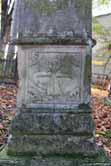

283
207. Itkhvisi, Tkibuli municipality, 152×42×37 _ Artistic and conceptual representations are displayed on the different sections of the surface of a rectangular stone. The surface is fully filled with the almost haut-relief carving of the fulllength frontal depiction of a man. A “pillow” around the area of his head and his personalized hairstyle are noteworthy. On both side facets of the stone, we see small full-length frontal depictions of a man raising a cross with one of his hands and small figures of rams of different shapes. Animals are presented in a lateral view and in motion, while the depictions of men are extremely generalized, and all we see is that they have one hand raised. The body of the man depicted on the horizontal surface of the stone is depicted with his hands crossed over his chest according to Christian custom.





208. Kisoreti, Tkibuli municipality, 127x30x34 _ Artistic and conceptual representations are displayed on different parts of the two-step grave stele. Floral and foliage motifs and a full-length depiction of a ram carved in aerial view with medium relief, are distributed across the base and facets of the stele. A haut-relief sculpture of a woman is carved from a single monolith. We see a figure of a woman kneeling on one knee with long flowing hair, a long dress and wings on her back, which are broken away altogether. In the front of the stele, we see part of her knee, while the back shows the sole of her foot. The woman has her palms kept together at her chest and she is holding a circular shaped object. The head and face are carved with great details. Epitaph: From the eight-line Mkhedruli inscription placed on the base of the stele we learn that “here rests the handmaiden of God, Theodosi, daughter of Giorgi Managadze [wife of Lomtadze] who passed away at the age of 58 in 1927”.

284
209. Kisoreti, Tkibuli municipality, 140x64x24 _ Artistic and conceptual representations are displayed different areas of the grave stele which is probably part of a two-part composite gravestone. The horizontal ledger stone is missing, which may have fully subsided below ground. We only see the body of the stele, which has a rectangular shape and is of medium height, surmounted by a dome. The facets of the stele are embellished with geometric and floral motifs, while its central area is open on one side with a semi-circular arch, with space inside for holding a candle. Below the candle holding recess, we see a small box-like extension to the wall resembling an open drawer, which was probably intended for holding water and was used for ritual purposes related to funerary customs. On the same facet in the pediment area, under the dome, we see a full-length frontal depiction of a man.
Epitaph: A Mkhedruli inscription is distributed across the different facets of the church model, which reads: “Under this stone I rest, Mose Lomtadze, son of Simon, who passed away too soon, leaving behind my beloved parents, wife and my only daughter”. In the inscription placed on the base we read: “born in 1854, passed away in 1882, at the age of 28, whoever reads this please grant your forgiveness, since this bitter verdict is also your due”. Besides this, we also have an inscription, which identifies the master who made this grave: “craftsmanship of Sophrom Bandz[a]l[a]dze”.
210. Kursebi, Tkibuli municipality, 191×60×59 _ Artistic and conceptual representations displayed on the monument are preserved only in the middle area of the obelisk, where we can see architectural (columns, capitals) and floral motifs. The rectangular moulding base of the obelisk is crowned by a small model of an open canopy with openings on all four sides and finished with a dome surmounted by a cross. It is significant that small figures of angels are sculpted in all four corners above the canopy. The drum of the dome is decorated with a false window motif. The surmounting cross is carved from a single piece of stone.

Epitaph: The two-line inscription in the Mkhedruli script inscribed on one of the facets of the obelisk gives us the name and surname: Mikheil Bezhuashvili.
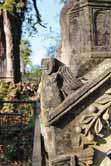




285
211. Kursebi, Tkibuli municipality, 197×65×63 _ Artistic and conceptual representations displayed on the monument are preserved only in the middle area of the obelisk, where we see architectural (columns, capitals) and floral motifs. The rectangular moulding base of the obelisk is crowned by a small model of an open canopy with openings on all four sides, and finished with a dome surmounted by a cross. It is worth noting a figurative composition carved on one of the facets of the gravestone base, using a medium-relief technique. A symmetrical composition is contained within the rectangular border _ the frontal depictions of angels with their hands raised are presented on the side areas, while between them we see a horizontally extended figure of the departed, laid in the tomb. The surfaces of the carved depictions of angels and the departed are ornamented with etched lines. The drum of the dome is decorated with false window motif, while the surmounting cross is carved from a single piece of stone.
Epitaph: Four-line inscriptions are inscribed in the Mkhedruli script on two facets of the obelisk. The inscriptions tell the story of the departed in the form of poetry.
212. Kursebi, Tkibuli municipality, 175×60×18 _ Artistic and conceptual representations are displayed on the surface of rectangular ledger stone, showing several depictions carved in relief – the images of two angels and a cross are displayed in the upper area. On both sides of the flourishing cross, we see lateral views of stylized figures of angels. The lower part of the composition is filled with the full-length frontal depiction of a woman carved in haut-relief. A depiction next to the woman, possibly of a ram, has been damaged. The gravestone is surrounded by a torus moulded border.
Epitaph: Inscriptions are displayed on the lower part of the surface of the ledger stone. They tell us that the departed was Simon Berekashvili, son of Lasha, who was born in 1879 and passed away in 1900.

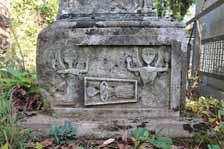

286
213. Kutaisi, Gochoura cemetery, 200×73×70 _ The obelisk consists of many parts – the first part is a base with several steps, upon which stands an open, canopy-like architectural structure. Columns are multifaceted, and their bases and capitals are moulded. A common capital or pediment is resting upon the open arches of the obelisk and is decorated with floral and architectural ornaments. There had originally been a half-length bust of a woman placed on top of the obelisk; this is now placed on the ground nearby. The female bust is sculpted and the features of her face, head and the fragments of her clothes are executed in great detail. We see clearly her chikhtikopi headpiece with all its details, her braids flowing down from it, the wave-like carved areas decorating her clothes, and a circle-shaped object hanging around her neck and tied to her chest, which could be a watch. The woman keeps her hands joined in front of her stomach so that her palms are not visible.

Epitaph: Inscriptions are displayed on the lower part of the base on an inserted marble tile, where we read: “Here rests in peace the handmaiden of God Babiline, daughter of Karaman Kakhaia, wife of Amton Ganigrava, who passed away at the age of 27 on January 28 in 1907”.

214. Kutaisi, Mtsvanekvavila Cemetery _ The headstone has come down to the present day with its images altered, and now its artistic and conceptual elements are found only in the photograph printed on a metal plate.The photo portrays an elderly man with grey hair, with lots of objects situated around him. It seems that the man may have been a smith, since most of the surrounding objects on the photograph are made of metal. There are large bowls, pots and a distilling vessel. Besides, smaller objects with different functions are also observed. It is significant that the man is depicted at the moment of manufacturing one of the objects.

287
215. Kutaisi, Sapichkhia cemetery, 333×95×94 _ The obelisk is standing on a base with several steps decorated with small figures. It is a conventional two-tier segment, the lower rectangular part of which is decorated with depictions while the upper one looks like a kind of tower-shaped roof covered with faux tiles. Artistic and conceptual elements are displayed on the lower part of the “tower”, where one surface is decorated with realistically carved half-length figures of angels. On one of the facets, we see a large flower pot holding different kinds of flowers. Epitaph: An inscription inscribed on a marble tile inserted into the column tells us that on March 20 in 1906 “the lieutenant colonel Gigo the same as Uflisa Machavariani, son of Dimitri” passed away at the age of 69 years “from birth”.

216. Mandaeti, Tkibuli municipality, 160×56×25 _ Artistic and conceptual representations are displayed on different sections of the surface of a gravestone – the surface is fully filled with the full-length frontal depiction of a man with haut-relief carving. The details of the décor are perfectly visible – we see a hat, a chokha-akhalukhi and the depictions of two birds carved at the side areas. A “pillow” around his head is worth noting. On one of the side facets of the stone, we see the small full-length frontal depiction of a man raising a cross with one of his hands; on the other side facet of the tomb there is a haut-relief sculpture of a ram. The animal is depicted in motion, and from a lateral view. The figure of a man is extremely generalized and he has one hand raised. The figure of a man on the surface of the stone, however, is depicted with his arms crossed over his chest in accordance with Christian custom. The tomb chest is placed on a base consisting of a single step surrounding the outline of the rectangular gravestone.
217. Mghvimevi, Chiatura municipality, 155×38×35 _ Artistic and conceptual representations are displayed on different sections of a rectangular gravestone including a moulded cross depicted on a flat surface, the lower area of which is decorated with ornaments. Side facets of the tomb are decorated with geometrical and floral ornaments, while on one side we see a depiction of an animal, carved usinghaut-relief technique. It is impossible to identify the species of animal precisely, which is depicted in a lateral view and in motion, since the section representing its head, its slightly elongated snout, its eyes and ears carved in outline and its rounded nose could represent several different species. On the upper side of the animal’s head, we can see a carved full-length frontal depiction of an angel holding his arms akimbo.






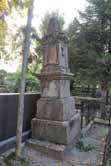
288
218. Mghvimevi, Chiatura municipality, 102×40×40 _ Artistic and conceptual representations are displayed on the surface of a type of stone formally referred to as a two-tier stele. Inside a rectangular frame we see, placed sequentially, a pair of fishes, a bird, images of borjgali, a traditional Georgian symbol) and a full-length, frontal depiction of a human being with open arms raising a large cross with one of his hands. The stele is standing on a moulding base and is crowned with a capital heavily decorated with geometrical and architectural motifs. All its parts are separated from one another by different types of frames and borders, while a rectangular niche intended for holding a candle is found on one of the facets. Epitaph: A lower facet of the stele is completely filled with a seven-line inscription in the Mkhedruli script, which is unreadable.
219. Nadaburi, Kharagauli municipality, 177×43×32 _ Artistic and conceptual representations are displayed on different sections of a rectangular gravestone. The edges of the surface are framed with foliage ornament, inside of which we see, one above the other, a fish, a bird, a star-borjgali inscribed within a circle, a large Golgotha Cross with three-petal finials, an embossed image, which is impossible to identify, and then another “star-borjgali”.Side facets stand out by their abundant décor, consisting of geometric and floral ornamental lines. One of the side facets contains a haut-relief carving of an animal and of a full-length frontal depiction of a human being standing in front of it. The human being is depicted with his arms stretched out – one hand is raised and the other one looks like it is feeding the animal. The depiction shows him wearing a long, one-piece garment with a textured surface.






220. Nadaburi, Kharagauli municipality, 173×44×202 _ The gravestone is a combination of two different types – we see a rectangular long massive tomb chest and a stele standing on it, heavily decorated with different geometric motifs. The surface of the horizontal ledger stone is decorated only with a moulded Golgotha Cross, with three-petal finials on its beams. A side facet of the same stone displays a haut-relief is distinguished by strictly geometrical, well-ordered and well-balanced decorative motifs, which are surmounted by a model of a domed church building. A rectangular niche finished with a horseshoe shaped arch intended to hold a candle, is located on one side of the model.
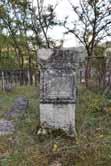
289
221. Nadaburi, Kharagauli municipality, 183×43×45 _ Representations are displayed on both surfaces of the two-tier stele. We see moulded frames laid out in rows on different areas of the stele. One of them contains the image of a hammer and a sickle. The stele is standing on a moulded base and it is surmounted by a heavily decorated capital, embellished with geometrical-architectural motifs, parts of which are separated from one another by different frames and borders. The surmounting element is a male bust cut under the neck. The man’s head is slightly turned left – one can observe his conventionally depicted facial features, hairstyle and ears.
Epitaph: inscriptions in the Mkhderuli script are inscribed on the sections of the body of the stele. From them we learn that Giorgi Gelashvili, son of Nikolozi, passed away at the age of 21 in 1936.




222. Nebodziri, Kharagauli municipality, 160×44×42 _ Artistic and conceptual representations are displayed on different areas of a gravestone. The surface is nearly fully filled with an almost haut-relief, full-length frontal depiction of a man, the details of which are not clearly visible. A “pillow” around his head and a distinctive hairstyle are both worth noting. A small-sized, full-length frontal depiction of a man is displayed on a side facet of the stone – he is holding a cross in his raised hand; there is also a raised haut-relief depiction of a lateral view of an animal in the moment of motion. The depiction of a man is extremely generalized with one hand raised. The man is depicted with his arms crossed over his chest in accordance with Christian custom.


223. Nebodziri,
municipality, 68×24×23 _ Artistic and conceptual representations are displayed on different parts of a rectangular gravestone – a simply moulded cross is depicted in the centre of the surface while at both ends of the long surface we see pairs of circled, star-like segments. Side facets of the tomb are decorated with haut-relief depictions of sheep, each resembling one another. On both sides we observe the lateral view of moving sheep facing one another.
Epitaph: We can trace horizontal lines on the surface of the stone, presumably intended for inscriptions, although no epitaph has been inscribed.


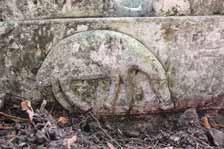
290
Kharagauli
224. Tseva, Zestafoni municipality, 168x42x24 _ Artistic and conceptual representations are displayed on different sections of a rectangular tomb. The surface displays a moulded cross placed on a rectangular raised board, above which a lateral depiction of a bird is carved, on top of a candleholder. On the upper area of the side facet of the tomb we see a haut-relief sculpture of the lateral view of a ram or ewe depicted in motion. The surface of its body is engraved with




process of grazing, while behind it, a full-length, frontal depiction of an angel is engraved. On the opposite facet, we see a full-length frontal depiction of a man holding his arms spread wide, and holding a cross in one raised hand. This greatly generalized figure is contained within two circular segments – we see a fragment of his exaggerated face and purposefully elongated arms. The side facets of the tomb are embellished with flowing floral ornaments.

225. Ubisi, Kharagauli municipality, 171x47x52 _ Artistic and conceptual representations are displayed on different areas of the surface of a rectangular tomb chest. A full-length frontal depiction of a woman is carved in haut-relief on the main surface of the tomb. From the elements of the design, we see her shoes on heels and her long hair flowing down on her shoulders on both sides. In the middle of the depiction, we see two rectangular recessed areas looking like settings for tiles that are now missing. The surface of the stone is surrounded by a floral ornamental border and twisted borders. On one side facet we see a half-length, frontal, haut-relief sculpture of an angel, which is severely damaged, while the other side facet displays what may be a haut-relief sculpture of a ram, although it could possibly represent a bear. The relief carvings of both depictions are relatively high, the animal is depicted in a lateral view in motion, and while eating. The relief sculptures of an angel and of the animal are depicted on opposite facets. The woman on the main surface is depicted with her arms crossed over her chest in accordance with Christian custom, while her head is resting on the haut-relief carving of a pillow.

291
226. Zestaphoni Museum 53x42x62 _ Artistic and conceptual representations are displayed on different areas of the grave stele – the central facet displays a moulded cross with full-length lateral depictions of angels carved under its arms and placed on small decorative bases or “hills”. The wings of the angels spread in different directions, and both are turned towards the cross and are holding the cross in one hand. On both ends of the horizontal beam of the cross there evidently had been two birds depicted in lateral view facing the centre of the cross, although only one bird is still intact and the other is missing due to a severe damage. The composition is contained within a decorative frame. The grave stele is placed on a thin, slab-like base on which a full-length depiction of a ram is sculpted. Floral-decorative elements are visible on the side facets and the back of the grave stele.
RACHA
227. Ambrolauri, 197×83×12 _ Artistic and conceptual representations are displayed on the section of a rectangular gravestone showing a depiction of a tree and inscriptions contained within a thick decorative border. The area inside the border consists of two parts, the lower one showing a commemorative prayer inscribed using the small Mkhedruli script, while the upper part displays a depiction of a tree embossed on a rectangular recessed background. Epitaph: The twenty-five-line Mkhedruli inscription looks rather complex in terms of its inscription technique, which makes it impossible to read the whole text. The main part of the epitaph is written in first person. The departed “tells” about his own identity, from which we learn that knyaz (prince) Zurab, son of Machabeli, passed away in 1845. Besides, the epitaph also provides some details about the identity of the departed and at the end we read a commemorative prayer addressed to the reader.



292
228. Barakoni, Ambrolauri municipality, 242×137×6 _ A rectangular, long, ledger stone is placed within the church building at floor level. Only the surface is visible and thus artistic and conceptual representations are displayed only as inscriptions on the surface of the stone, completely framed by two heavily decorated, wide borders on all four sides. The frame consists of two layers – the outer layer is made up of a rhythmic chain of geometric and floral elements, while the inner layer looks like a braided abstract ornament. An ogee arch on top of the inscription area inside the frames is also decorated with another floral frame on the top, which continues with a string of small rectangles, each ending with smaller beads on both sides. The ogee arch is also decorated with the same motif. The decorative frames, the ogee arch and the inscription in the centre of the stone create a single undivided artistic image on the gravestone. Epitaph: The Mkhedruli inscription on the surface of the stone informs us that the departed is “the commissioner of the construction of the church, the knyaz (prince) of Racha, who passed away in 1766”.2 It is worth noting that the inscription does not specify any further details as to the identity of the person, and yet he is certainly Rostom, the prince of Racha who ordered the construction of the church, which was built by a master stonemason, Avtandil Shulaveri, in 1753.
229. Chibrevi, Oni municipality, 152×52×39 _ Artistic and conceptual representations are displayed on a section of the surface of a rectangular gravestone showing a full-length frontal depiction of a man. The small depiction is displayed on the upper part of the surface and occupies a very small area. We can see vertical, almost continuous engraving lines depicting the fabric of his garment. The man is holding his arms akimbo. The surface of the stone is framed with a torus moulding frame.

230. Chibrevi, Oni municipality, 103×28×5 _ Artistic and conceptual representations are displayed on a section of the surface of a rectangular ledger stone showing an aerial depiction of a dove pointing towards a bunch of grapes, contained within a circular frame in the upper area of the surface. The dove is holding on to that segment of the circle, which is embossed from the surface. The composition is contained within the simply moulded frame of the surface of the ledger stone. Outside the frame of the upper area there is another depiction which is hard to identify, although it may be an aerial view of a ram.
2 It is worth noting that the date given in the inscription, marking the death of Rostom, the prince of Racha is incorrect. It leads us to think that the mistake was made in the process of inscribing the text. Historical sources confirm that Rostom lived until 1790. See M. Rekhviashvili, The Kingdom of Imereti, (1462-1810), Tbilisi, p. 215.



293
231. Jvarisa, Ambrolauri municipality, 95×31×41 _ Artistic and conceptual representations are displayed on the middle and upper sections of the three-level stele. It should be noted that the gravestone is cast of metal. One of the facets of the stele shows a full-length frontal and haut-relief depiction of an angel. The figure of the angel with crossed arms is cast in a mould – the small sculpture is almost fully raised from the surface and has sharp outlines of various elements, including the drapery of the angel’s clothes. The stele is finished with a flat, metal, moulded cross.
Epitaph: The four-line inscription of the headstone reads: “Sleep my unforgettable Varlam, in the bosom of innocence, the blessed time will also come for me one day, and I shall dwell with you”.

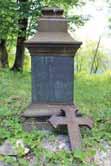


232. Jvarisa, Ambrolauri municipality, 50×40×135 _ Artistic and conceptual representations are displayed on different sections of a rectangular stone. A small cross is depicted on the surface of the stone, with the three-petal finials on its beams. We also see a haut-relief element, which is unidentifiable – it may be either a crown or a small bag. One of the side facets of the tomb is decorated with a floral motif presented as a “vine tree” and covers the whole area of the surface. Many interwoven branches grow out of a single root, with bunches of grapes hanging upon them. Another relief depiction is embossed on an upper facet, where we see a full-length frontal depiction of a man contained within
clothes of the man are also clearly visible showing his long chokha-akhalukhi Epitaph: The three-line Mkhedruli inscription on the surface of the stone, despite severe damage, informs us that in 1908, presumably at a very early age, someone passed away whose surname is Giorgadze and his grave was made by his relative whose surname was also Giorgadze.


294
233. Khirkhonisi, Oni municipality, 171×52×128 _ The gravestone combines two elements – a ledger stone, and a vertical stele erected on it, decorated with different floral and geometrical motifs. The ledger stone is decorated with a single cross. A stele in the image of a church sculpture is erected on the upper part of the ledger stone and it is surmounted by a church dome. A relief cross is depicted on a side facet of the church sculpture. The only figurative depiction we see on one of the facets of the stele is of a dove looking downwards, carved in bas-relief. The dove is touching a triangular “segment” below it, which may represent food.




Epitaph: A six-line Mkhedruli text is inscribed on the surface of the ledger stone. The inscription is severely damaged, but its fragment informs us that the departed was someone called Lida and she was the wife of someone whose surname was Japaridze. Additionally, the epitaph ends with the supplicatory prayer to the Lord.
2
likely that
displayed a half-length,
295
34. Khirkhonisi, Oni municipality, 51×46×139 _ Artistic and conceptual representations are displayed in the middle level of the three-level stele, showing a complex moulding depiction of a “flowering cross” decorated with floral elements. The edges of the cross are surrounded by torus moulded borders, while the ends of the beams are shaped with the three-petal motif. The surmounting part of the stele is a figurative depiction, which cannot be reconstructed because of heavy damage. It is
it
haut-relief depiction of a human being holding a board or a book around the chest area. We can observe the hands, part of the body and clothes.
235. Kvatskhuti, Ambrolauri municipality, 112×97×268 _ The obelisk headstone consists of three levels. We see a massive two-step base, the main middle part, and a heavily decorated, moulded header-capital. It is worth noting that the artistic style and the manner of executing the details of the headstone is in full accordance with European style. The middle part of the obelisk based on the two-step moulded base displays a marble tile surrounded by a floral-foliage decorative frame. A supplicatory prayer is inscribed in the Mkhedruli inscription on the tile. The header area, which apart from its own moulding, is also heavily decorated with floral elements, reveals obvious links with the Art Nouveau architectural style of façade decoration.
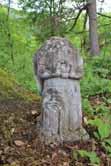
Epitaph: An eleven-line Mkhedruli inscription placed on the marble tile informs us that “Here rests the body of Seit Saganelidze, son of Kikola, born in 1878 and departed on February 25 in 1911. No, I shall not forget you brother until the thread of my life unravels completely. Your love be remembered in this heart of mine – Aphrasion”. The most important inscription is read on a smaller marble tile on the side facet, which says: “mastery of Davita Kakriashvili, son of Ivane”. This is one of those rare cases, where the maker of the gravestone is remembered.

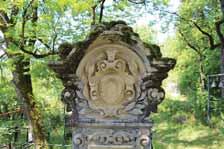

236. Kedisubani, Ambrolauri municipality, 28×25×56 _ This stele gravestone is a medium height free-standing sculpture of an angel. The gravestone intended as a three-dimensional sculpture, is nevertheless more fully developed on the frontal aspect. We can see part of the angel’s wings, his hands joined together by his chest (he is holding something)
standing on a rectangular base. A section of the back of the sculpture is solely dedicated to the drapery of the lower part of his clothes and the details of his wings.

296
237. Kviriaketsminda, Ambrolauri municipality, 164×57×143 _ The tombstone is a combination of two different types – we have a rectangular, long and quite massive block and a vertical stele standing on its upper end. The stele is heavily decorated with floral ornaments. The horizontal block is decorated with a single moulded cross. Another single cross is displayed on the front facet of the base of the vertical stele. On the side facet of the base of the stele we see a circular frame embossed in high-relief with a human portrait contained within it, the facial features of which are carved with scratched lines. Heavily geometrized, well-ordered and well-balanced decorative elements, whether floral or geometric, create a sharp contrast with the carving technique of the portrait.

238. Kvemo Zhoshkha, Ambrolauri municipality, 44×40×14 _ A small, low, headstone in the shape of a cross is carved out of a single massive rock. Artistic and conceptual representations are carved on the surface of only one facet showing the depiction of a cross with a four-winged angel in its centre, where the beams intersect. Another relief cross is carved on the central facet of the cross-shaped headstone, the ends of which are moulded with three petal shapes. The halflength depiction of the angel with four wings and a partial depiction of the face in the centre appear at the point of the intersection of the beams.
Epitaph: The back of the cross headstone contains a five-line Mkhedruli inscription, which is unreadable due to severe damage. From the readable fragment we learn that the departed was someone with the surname “Kifiani, son of Luarsab”.
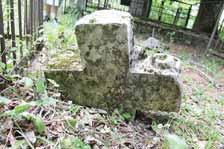




239. Kvemo Zhoshkha, Ambrolauri municipality, 40×45×13 _ A small, low stone is carved in the shape of a cross from a single massive rock. Artistic and conceptual representations are displayed on one surface only, showing an engraved cross in the middle and half-length frontal portraits embossed on both sides. The portraits appear to be of men, but severe damage makes it impossible to identify them clearly. An important detail is displayed on the upper facet of a horizontal beam where a small shallow hole is made, possibly for holding water for sacred purposes.
Epitaph: It seems like the back of the cross had inscriptions which faded away and only several Mkhedruli graphemes are readable.
297
240. Labechina, Chkvishi, Ambrolauri municipality, 226×119×19 _ Artistic and conceptual representations are displayed on a section of the surface of a ledger stone, divided into several different frames. The edges of the stone are decorated with an outer border with engraved geometric / braided ornaments on it, and an inner border with a torus moulding, also decorated with thin, engraved, linear floral elements characteristic of medieval architecture. Inside the torus moulded border there is a further flat border covered with Asomtavruli inscriptions on all four sides. Within that is yet another embossed border decorated with engraved, linear, abstract ornaments. Inside all the frames we see a moulded cross, made up of embossed lines decorated with ornaments. Three beams of the cross, with intersecting small lines at their ends, create depictions of three independent crosses, while the whole depiction is based on motifs characteristic to Eastern style façade décor. The whole surface of the background of the cross is embellished with braided floral elements spreading out like a lace around the whole area.
Epitaph: An Asomtavruli inscription surrounds the surface of the ledger stone like a frame, which after decoding the abbreviation, reads as follows: “God have mercy on a great sinner Inasaridze Giorgi, this is my resting place forever; Here I shall dwell, for I have desired it, blessed is the path on which I travel, I beseech you, Oh God, glory be to you!”3


241. Seva, Oni municipality, 67×63×168 _ A medium sized stele, carved from a single rock, consists of two parts. We have a small base and a sculpture of a domed church erected upon it, the façades of which are decorated with various details. Artistic and conceptual representations are found on its facets. The only figurative depiction here is a half-length frontal depiction of an angel, stretching its wings horizontally across the surface of the base of one of the façades. The drum of the dome has narrow tall windows, which are themselves decorated with little holes imitating latticework. Different parts of the church sculpture are embellished with decorative elements, especially the pediments, the arches decorating all the façades and geometric elements decorating the angular details. On one of the facets, we trace the remains of several colour paints, which makes us think that the headstone must have been tinted with different colours.


3 Mikheil Alavidze, “Concerning the identity of Giorgi Inasaridze”, The Works of the A. Tsulukidze State Pedagogical Institute of Kutaisi, Vol. 9, p.124.

298
242. Shua Bari, Oni municipality, 64×73×210 _ A medium sized stele headstone consists of three major parts – we see a massive two-step base, the body of the stele, its header capital and a severely damaged surmounting sculpture which appears to be a seated woman. Artistic and conceptual representations are displayed on different levels of the facets of the obelisk. We see the Golgotha symbol on the lowest level of the base – the skull and crossed bones. On the upper level of the base an ewe or a ram is depicted inside a simply moulded frame, which we may perceive as either a “symbol of heaven” or an image of a “sacrificial lamb”. On the surface of the body of the stele we see a depiction of a hand holding an incense burner, and Mkhedruli inscriptions displayed on both sides. Above the crowning capital there is an independent female sculpture, which is damaged to such an extent that almost nothing is discernible – the sculpture is sitting sideways, when observed from the front of the stele. On a different facet we see a floral décor and a medal of merit above it.
Epitaph: The Mkhedruli epitaph of the grave informs us that “Here rests Rostom Chikhladze, son of David. He was born in 1830 and passed away in 1901. He was awarded with a neck medallion for his loyal service to the church. Reader, I beseech your forgiveness”.




243. Sori, Oni municipality, 190×69×18 _ Artistic and conceptual representations are displayed on a section of the surface of a ledger stone, showing a cross with complex moulding, which is contained inside of a rectangular carved frame. Small decorative elements are embossed on different sections of the frame on both sides of its vertical lines, and in its upper and lower corners. In the upper corners are miniature depictions of angels. It is difficult to fully discern them due to their small size and the low level of the carved relief. A small part of a head is observed above the horizontally stretched, fan-shaped depiction of wings. The cross has a complex moulding and it consists of the flowing lines of a torus moulding, creating a form of braided floral base in the lower area.
Epitaph: The inscription commemorating the soul of the departed is placed on the lower part of the surface inside a rectangular frame, although it is impossible to read its content due to severe damage.
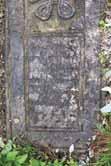
299
244. Tskadisi, Ambrolauri municipality, 104×23×140 _ This stele headstone consists of three independent gravestones incorporated into a single edifice. One rectangular and two square stone blocks of the same height are placed on a horizontally stretched base carved from a monolithic rock. Artistic and conceptual representations are displayed as the crowning segments of the stele, placed on top of the above mentioned stone-work. Three vertically stretched blocks are sitting in a row side by side, each of them finished with moulded capitals and with a human portrait carved on each. The left one depicts a male portrait – we can distinguish parts of his hair, ears, mouth, eyes and a nose. The portrait features of the two women next to him are different. One of them is wearing a chikhtikopi headdress with French-plaited hair emerging from it on both sides, while the other woman has her hair tied up. All three portraits have common proportions, and they all are holding an open book in one of their hands. The books, decorated with inscriptions, are placed around their chest areas below the face, and in all three cases we can see part of the palm, holding the book from underneath. The relief carving of the depictions is relatively high and aims at attaining similarity with the original of the portrait as much as possible – all three images carry unique individual features and depict strong character traits. Above the “portraits” of the steles we see header-capitals which must have originally been crowned with surmounting crosses. Epitaph: We see numerous Mkhedruli inscriptions on the common base of the grave as well as on the books held by the “portraits”. The unsystematic arrangement of graphemes, their asymmetric and disorderly outlines as well as the small script, make it impossible to read the content of the epitaph.
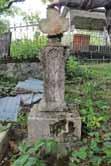

245.
municipality, 136×49×45 _ Artistic and conceptual representations are displayed only on the front facet of the stele and they are dedicated to the full-length, frontal depiction of a woman. The carving of the relief is slightly higher than medium. We can distinguish the arms of the woman placed in front of her abdomen, the twisted lines of her hair parted in the middle and flowing down her shoulders on both sides, lines minimally displaying the drapery of her clothes, and a cross necklace hanging on her chest. Her feet are ledged out under a larger flat surface below her waist. Different parts of the stele use architectural and floral ornaments _ on the back of the stele we see a tall flower filling the whole area of the stone, finished with a semi-circular arch on top. The top of the stele is finished with a moulded capital and a surmounting cross with rounded beams, carved from a single stone.
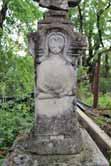


300
Zemo Krikhi, Ambrolauri
LECHKHUMI
246. Chashleti, Tskaltubo municipality, 20×12×37 _ The gravestone is partially preserved – comparing this to similar stones we may infer that there must have been a ledger stone beneath the candle holder niche that survives today. Artistic and conceptual representations are displayed on the back of the niche, showing a full-length depiction of a woman. Most likely the ledger stone is fully subsided below ground and the front of the niche is decorated with various geometric ornaments carved on its the corners, which is finished with a semi-circular arched header. The back facet shows a cross-shaped external border inside of which a female figure is embossed from the lowered background to the same level as the frame. We can see generalized facial features of the woman, lines depicting the details of her hair, and clothes, arms and feet, which are all severely damaged. The cross-shaped frame, finished with a semi-circular arch on top, is fitted to the shape of the woman’s body.
247. Chashleti, Tskaltubo municipality, 175×37×134 _ The gravestone combines two different types: we have a horizontally stretched rectangular ledger stone, and a vertically standing stele erected upon it, decorated with different floral and geometrical ornaments. The horizontal ledger stone is decorated with only a single moulded cross. The stele standing on its upper part is in the shape of a church surmounted by a dome. The corners of the stele, and its different parts, are decorated with architectural motifs. The only figurative depiction we encounter is in the pediment area of one of the facets, showing a male “portrait”. The church sculpture and its details are well articulated and expressed. The drum of the dome and its windows are particularly remarkable, as is the façade of the church and a niche contained in it, which also appears as an entrance to the church. The niche has a practical function – it is a candle holder, framed with a torus moulded border – the arched header on top is semi-circular, and the pediment with the portrait is precisely placed on top of it. It should be noted that the portrait and the geometric realization of its side areas is close in style to the compositions with half-length depictions of angels.
Epitaph: Inscriptions are placed on the surface of a ledger stone, yet we have so far been unable to decipher these.

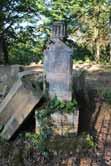


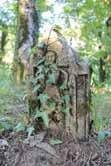
301
248. Chashleti, Tskaltubo municipality, 170×35×136; 175×40×135 _ A pair of gravestones located side by side are of the “composite” type. In both cases we have a rectangular ledger stone and a stele standing upon it, decorated with various floral and geometrical ornaments. The ledger stones are decorated with a moulded cross and depictions of a bird in a small frame below them. In both cases, the steles shaped as church sculptures are standing on the ledger stones and their tops are surmounted by church domes. The corners of the steles and its different parts are decorated with architectural motifs. The only figurative depiction is displayed in the pediment area of one of the facets showing a “portrait” of a man. The drums and windows of both domes are similar, as are the façades and their niches in lower areas. These niches have practical functions as they serve as candle holders. They are surrounded by torus moulding frames finished with semi-circular arches above which are the portraits. It should be noted that the portraits and the way their side areas are executed geometrically, is very close in style to the compositions of half-length depictions of angels. Epitaph: The inscriptions are displayed on ledger stones. A four-line Mkhedruli inscription on one of the stones reads: “Here rests Aghati, daughter of Nikoloz Managadze at the age of 17 years from her birth”. The epitaph on the other grave is almost identical, except the missing name and age of the departed: “Here rests … daughter of Nikoloz Managadze at the age of … from her birth”. And the most significant inscription is found on the lower part of the grave: “Handiwork of [Soph]roma [Bansh]aladze”.


249. Derchi, Tskaltubo municipality, 164×52×67 _ Artistic and conceptual representations are displayed on a section of the surface of a rectangular gravestone. The stone is framed with borders of a simple, torus moulding, which surround a large area covered with a Mkhedruli inscription of a commemorative prayer. On the upper part of the stone, we see small, full-length, frontal depictions of two angels on both sides of a cross – the composition is contained within a simple flat frame with a depiction of a small cross sitting on top of a pediment – suggesting that the outline of the frame echoes the shape of the church façade.

Epitaph: The ten-line Mkhedruli inscription is heavily damaged, which makes it impossible to read the content. We remember me when you come into your kingdom”. The ending is a prayer for forgiveness and a supplicatory prayer addressed to the reader.


302
250. Nakuraleshi, Tsageri municipality, 50×37×113 _ Artistic and conceptual representations are displayed on the lower area of a multi-step stele consisting of a single massive block. We see decorative-ornamental elements on the upper part of the obelisk, which is open like a baldachin and stands above the main block of the stele. A depiction of a sewing machine on one of the facets surrounded by a torus moulded frame should be noted. In the vertically extended section next to area with a sewing machine image, we see a depiction of a guitar raised up on a recessed background.
Epitaph: Different sized Mkhedruli inscriptions are inscribed on all of the four facets of the base, yet, the complexity of the outlines of letters and the damage they have suffered make it impossible to read the text fully. Fragments of the text tell us that the departed was someone called Olga (Modiska), daughter of Niko, born in 1895 and passed away in 1922. Another fragment reads: “she spent her days of spinsterhood well, remaining with her brother to the last day”.

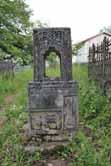
251. Sachkheuri,
municipality, 23×20×71 _ A
is in the form of a medium sized, three-dimensional, free-standing sculpture of an angel. Even though the composition is intended to be a three-dimensional sculpture, frontal depiction is still prevalent. We can see the wings of the kneeling angel, his


of
his chest like a waving banner, which covers the larger part of the angel’s body. The sculpture is placed on a rectangular base. The angel is holding a cross in one hand while the other is holding the scroll with inscriptions. Sharply carved details are observed throughout the hair and wings.
legs, including the foot. A scroll with an inscription on it is stretched diagonally
Epitaph: Inscriptions are found on the upper part of the two-step base of the obelisk. The epitaph tells us that the mourning text of the “bitterly grieved” parents states that the girl was “their only child who had not yet come to know this life”. Apart from this, the epitaph includes the parents’ supplication addressed to the reader. It is significant that the artistic presentation of the grave and the information given in the epitaph support one another.

303
Tskaltubo
stele headstone
facial features, hands and one
his
across
252. Sachkheuri, Tskaltubo municipality, 89×89×194 _ This medium sized stele consists of two parts. We have a multi-layered base and an image of a domed church, with a façade decorated with details. Artistic and conceptual representations are engraved on its various facets. The dome of the church is noteworthy: it has tall, narrow, windows and triangular pediments above each window, with embossed header frames. The only figurative depiction here is a small “portrait” of a man and a lateral depiction of a bird in the pediment area of the upper side of one of the façades. The bird is sitting on top of the torus moulded frame, under the upper corner of the pediment. The artistic presentations on the stele include various segments showing decorative elements. Epitaph: Inscriptions are displayed on a marble tile inserted in the principal façade of the obelisk – the eight-line Mkhedruli inscription is severely damaged, but the fragments of the text inform us that the departed, Vasil Managadze, son of Iose, passed away in 1896 at the age of 68. Additionally, the epitaph contains a supplicatory epilogue, addressed to the reader.
SAMEGRELO
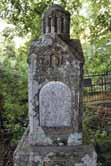

253. Bandza, Martvili municipality, 58×67×27 _ Artistic and conceptual representations are displayed on part of the surface of a rectangular stone, displaying various carved figures. The tombstone is broken in the middle and part is missing. In the central area of the surviving part, we can see foliage and a circular design surrounded by a wreath, which itself is surrounded by a rectangular frame with a double petal motif adorning its corner areas. The surface of the tomb is framed with a thick border inside of which we see the full-length, frontal depictions of angels placed above one another. On the lower section we see a half-length frontal depiction of an angel fully covering the whole of the lower part of the border with its wings. Each angel has a small, engraved detail on his chest, resembling a star or a Borjgali.


304
254. Bandza, Martvili municipality, 96×85×44 _ Artistic and conceptual representations are displayed on the grave stele, which is heavily decorated with pseudo-Classicist elements on its different sections. A conventional ram-shaped figure is erected on a single step base, with all its surfaces decorated with varied ornamental details. The side facets are fully covered with floral and foliage décor; the upper part of the front of the ram-shaped figure displays a half-length, frontal depiction of an angel, while on the back of the ram figure, which consists of three steps, a full-length, frontal depiction of a seated man is depicted. The three-stepped composition to which the figure of the man is so neatly fitted forms a kind of seat, as though the master has predesigned it especially for him. The man is holding one hand raised up, while in the other he is holding a plant across his waist. From the elements of floral décor, we can see clearly the grape clusters with their curls, and some eight-petal flower motifs interweaved into the leaf motifs.
Epitaph: Mkhedruli inscriptions are displayed on a section of the rectangular base of the stele and on the front facet of its main body. The two-line inscription on the base reads: “Oh, you stony-hearted nature, why did you first bring me to dwell on the earth, only to return me so quickly, helpless one, unto the earth?”. The inscription on the front facet of the
255. Khobi monastery, khobi municipality, 178×79×15 _ Artistic and conceptual representations are displayed on a section of the surface of a rectangular ledger stone, the centre of which is dedicated to the depiction of a cross erected on a rectangular base. Four stars and four moons of a simple design are displayed around the cross, and in different areas of the tomb. The depictions of the moon are placed in the corners of the gravestone while the stars are distributed as vertical and horizontal accents.
Epitaph: th in 1919. The reader, we beg you to grant your forgiveness”.

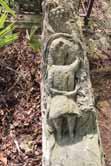

256. Khobi monastery, khobi municipality, 132×78×17 _ Artistic and conceptual representations are displayed on a section of the surface of a rectangular ledger stone filled with a depiction of a Seraphim. We see his wings and the generalized facial features. The stone is surrounded with a thick border covered with floral ornaments.
Epitaph: The long Mkhedruli inscription inscribed in the lower area of the stone is unreadable.



305
257. Kulishkari, Zugdidi municipality, 50×46×26 _ Artistic and conceptual representations are displayed on part of the base of the stele, where we can see a half-length, frontal depiction of an angel. The relief carving is relatively high. The depiction is contained within a rectangular flat frame, raised above the inner surface of the facet, although the head exceptional finesse. They are made from layers of small segments, placed on top of one another. Only the base of the stele has survived to the present day.
258. Kulishkari, Zugdidi municipality, 172×72×11 _ Artistic and conceptual representations are displayed on the area of the surface of a rectangular gravestone, which displays a very generalized depiction of the crucifixion, made from a different material, and inserted in the upper area of the surface of the sandstone tomb. Around the crucifixion image, other elements also made of this same material are inserted into the surface. It is impossible to identify them with precision – only an eight-pointed star is perceived in the lower area.


259. Kulishkari, Zugdidi municipality, 150×26×? _ Artistic and conceptual representations are displayed on a rectangular plate, cast in metal. In the upper area of the gravestone a simply moulded cross is depicted, with rays emanating from its centre. The areas around the upper and lower parts of the cross are filled with symbols representing Golgotha and the is surrounded with a twisted border.

Epitaph: Mehmed-beg, who passed away in 1843, and his wife Mariam Dadiani, daughter of Tariel, who passed away on December 12th in 1861”.


306
260. Martvili Monastery, Martvili municipality, 172x63x12 _ Artistic and conceptual representations are displayed on the surface of a rectangular ledger stone, displaying a cross of complex design in the upper area. In the upper corners of the cross we see half-length, frontal depictions of angels, with their wings raised diagonally towards the centre above the cross. Next to the lower part of the cross, a sculpture of a ram is carved, depicted in a reclining position and from an aerial viewpoint. The relief carving is relatively high, the shapes of a ram and angels’ heads are almost haut-relief. The back of the ram is hatched with sharp lines. We see its curved horns, a tail and the legs bent on one side. The bordered edges of the stone are decorated with floral ornaments.
Epitaph: A twelve-line Mkhedruli inscription, contained within a floral frame, is displayed on the lower part of the surface of the stone, which is unreadable due to its “muddled” character, and some erosion. It is likely that the date 1881 appearing in the end of the text is the date of death.

261. Martvili Monastery, Martvili municipality, 131x75x3 _ Artistic and conceptual representations are displayed on a section of the surface of a rectangular ledger stone, the four corner areas of which are occupied by half-length, frontal depictions of angels. In the upper part of the surface, we see a wreath made up of floral and foliage motifs, with a tied ribbon in the middle of its lower area. The wreath is further bordered underneath with two branches. with leaves crossing each other. The edges of the gravestone are decorated with a floral ornament placed between two filletmoulded borders.
Epitaph: The five-line Mkhedruli inscription on the lower area of the ledger stone reads: “Here rests Nina, daughter of th in 1845 and passed away on July 8th
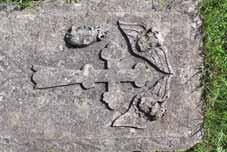
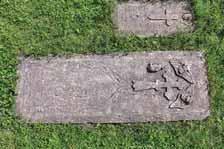
307
262. Martvili Monastery, Martvili municipality, 177x63x? _ Artistic and conceptual representations are displayed on a section of the surface of a rectangular ledger stone, showing a cross inlayed with materials of different colours, surrounded by angels. The cross is erected upon a circular design, inside of which we see a figure of a lion lying down against a blue background, together with depictions of a sword and a tower. The composition contains the elements of a coat of arms. Full-length frontal depictions of two angels are situated under the arms of the cross, while in the area above the arms is dedicated to the full-length lateral depictions of angels arranged horizontally. The angels flying above the cross are holding small pieces of fabric. The gravestone is surrounded by a border with a floral ornament. Epitaph: The seven-line Mkhedruli inscription located on the lower area of the stone, and surrounded with a moulded frame, reads as follows: “This stone was given to Terezia, the daughter of Duke Mamia of Guria, by me, Grigol, her husband, son of Leon Duke of the Megrelians, after she left this world in ... although she broke her husband’s heart and left him without comfort for the rest of his life, whereupon he never ceased shedding tears… that she left for heaven with a steadfast spirit and a pure heart and knows blessedness as she stands before the sanctuary of God. In 1871…”
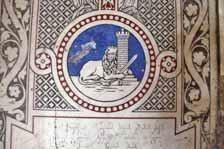
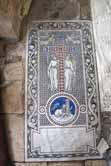
263. Martvili Monastery, Martvili municipality, 168x42x24 _ Artistic and conceptual representations are displayed on part of the surface of a rectangular ledger stone. A cross of a complex design is depicted in the upper area of the surface, on each side of which we see a half-length, frontal, stylized depiction of angels, diagonally stretched towards the top of the vertical beam of the cross; the area under the arms of the cross is filled with full-length, lateral depictions of two angels holding the lower part of the vertical beam. A compositional structure such as this references the stylized depictions of the Elevation of the Cross. An oval metal plate is inserted into the middle of the stone, stamped with the portraits of a man and a woman. The gravestone is surrounded by a wide border with a floral ornament, contained between two fillet borders. The lower and upper borders of the frame are dedicated with half-length depictions of angels, the wings of which are stretched horizontally, fully covering the width of the frame.
Epitaph: The inscriptions on the lower area of the surface of the stone reads: “Alexandre / Guia Fashtiani, son of Andria, tomb is a resting place of a married couple.




308
264. Tsaishi, Zugdidi municipality, 209×74×21 _ Artistic and conceptual representations are displayed on a section of the surface of a rectangular ledger stone, displaying a cross of complex design, on both upper corners of which we see the full-length, lateral depictions of angels. The figures of angels are carved differently – both are placed on conventionally suggested clouds. They are holding a large crown above the upper part of the cross’s vertical beam, each angel holding onto the crown with one hand. The crown is itself surmounted by a small cross. The composition is displayed in the upper area of the tomb and is surrounded by a type of frame. The lower area of the tomb displays a carved element shaped as a borjgali with rays emanating. The tomb is surrounded by a border decorated with floral ornament.
ABKHAZIA
265. Ilori, Ochamchire municipality, 135x40x5 _ A rectangular elongated ledger stone is set into the floor inside the bell tower at the west end of the Ilori Church. The main artistic and conceptual representations are displayed on the upper part of the central surface of the stone, displaying a cross of complex design contained within a rectangular frame consisting of several steps. The ends of the lower part of the vertical beam of the cross are decorated with angular half figures of angels. The side facets of the grave are decorated with floral ornaments.
Epitaph: The seven-line Russian inscription is displayed on the lower part of the tomb’s surface; the inscription provides us with the date of death – March, 1879. We are also informed that the departed was Knyaz (prince) Berdzenobi (Berdzenishvili).

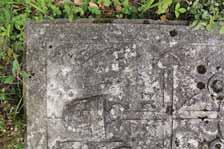


309
GURIA



266. Chokhatauri Museum of Local Folk History, 129×49×6 _ Artistic and conceptual representations are displayed on the central area of a rectangular slab, showing a depiction of the Mother of God with the infant Jesus. The composition is carved with an almost haut-relief technique and includes half-length figures of the Mother of God and the infant Jesus resting on clouds. Despite severe damage, the figure of the infant turned towards his mother is clearly perceptible, with one hand directed towards her face. The Mother of God is holding one hand around the waist of the infant Jesus, while she is pointing at him with the other hand. The figure of Jesus is presented without a halo. We can see a small fragment of the drapery of his garment. Epitaph: A four-line Mkhedruli inscription is presented in the middle of the marble tile: “Here, under this stone, rests a young man Ioseb, son of Giorgi, prince Tsulukidze, fifteen years old from his birth, he was born in 1840 and passed away on February 19th in 1860”. On both sides of the head of the Mother of God, abbreviated explanatory inscriptions are inscribed – “Most Holy” on the left and “Jesus Christ” on the right.
267. Zomleti, Chokhatauri municipality, 220×80×85 _ Artistic and conceptual representations are displayed on a medium height stele composed of several layers, standing on a massive base designed in the form of a staircase. The base is constructed as a stonework made up of rectangular slabs. The massive stele follows the conventional design in that it consists of two parts, the lower one of which is a rectangular vertical block with its header and base decorated with various carved ornaments. Conical shapes are moulded in the corner areas at both ends of the stele and are connected by the decorative columns adorning the edges of the stele. Ornamental borders are enclosed by horizontal lines along the different facets; a rhombus-like figure is carved on the upper section, the inner surface of which is decorated with ornaments. The stele is crowned with a partially open, two-stepped block, which was probably formerly surmounted by a cross.
310
268. Zomleti, Chokhatauri municipality, 182×45×37 _ Artistic and conceptual representations are displayed on different sections of a rectangular tomb chest. The tombstone is carved on a stone monolith and consists of a rock erected on a two-stepped base. A cross of a complex design, contained within a rectangular frame, is depicted on a section of the surface of the rock. The upper surface is surrounded by bevel-cut edges on all four sides, with a full-length depiction of an angel displayed on the top, and floral and foliage ornaments on the sides. The side facets of the stone are completely smooth, just like the corresponding sections of the base.
ACHARA
269. Gantiadi, Khelvachauri municipality – The memorial monument, like the tomb of modern times are surrounded by raised fence-like border from all four sides. Two vertically erected boards of different mouldings are erected on the ends of the fence. The boards are decorated with floral ornaments and Arabic inscriptions. The tall floral motif, imitating vine and presenting its stylized variation, is based on a long “bottom”; we see the vine leaves and grape clusters at different places. Epitaph: The Arabic inscription displayed on a small tile reads: “Babazadeh Hussain from Giresun was born in 1861 and passed away in 1921”.4
SAMTSKHE
270. Akhaltsikhe Jewish cemetery, 180×90×85 _ A rectangular, extended tomb chest consists of three massive blocks laid upon one another so that they resemble a three-step pyramid with a flat top. The bottom block is a single monolith, left unrendered, which serves as the base of the monument. Artistic and conceptual representations are displayed only on the side facets of the blocks, showing an embossed decoration which seems to represent an architectural arcade, and resembles a continuous lace-like ornament surrounding the tomb on all sides and on two levels. Small geometrical elements are displayed above the arches surrounding the tomb, which continue over the corner areas.



Epitaph: The whole surface of the tomb is thoroughly covered with a Hebrew inscription.




311
4 Epitaph was read by E. Ghviniashvili and Z. Shashikadze.
271. Arali, Adigeni municipality, 180×70×70 _ The gravestone, designed as a church model, is carved from a massive monolithic rock, standing on a single-step base. Artistic and conceptual representations are displayed across the façades of the church model, consisting of crosses and small, circular, carved objects. The proportions of the church and the execution of all its details provide a clear view of the main body of the church, the beams of the ‘cross-in-square’ church design, and the cylindrical drum of the dome surmounted by its conical roof. The drum of the dome has four windows, while some small false windows with slightly embossed frames appear on the façades. A door is also depicted in a conventional manner, decorated with cornices and floral ornaments. A Golgotha Cross standing on a three-step pedestal is embossed on one of the façades.
Epitaph: A five-line Mkhedruli inscription is displayed on one of the surfaces of the church model, where the date of the death of the departed is given as 1912 and a supplicatory note is addressed to the reader.


272. Chobiskhevi, Borjomi municipality, 106×56×75 _ The gravestone is designed as a church model. The grave is carved from a single piece of rock and is quite large. Artistic and conceptual representations are displayed as both façade décor and as pseudo-architectural elements. We can clearly see the arms under the dome, the drum of the dome and a conical roof. In addition, we also clearly see the façade elements and moulded torus frames of faux windows, and arcade decorations of facades, finished with a cross. Windows decorating the drum of the dome are also clearly visible.
Epitaph: Inscriptions are found on the sloping sides of the conical roof, yet it is impossible to read the content.



312
273. Chobiskhevi, Borjomi municipality, 300×75×70 _ Artistic and conceptual representations are displayed on different sections of an obelisk, which has several steps. A lateral depiction of a sheep is carved on one of the facets of the base, above which we can see a depiction of a cross contained within a medallion. One of the surfaces of the base is occupied by a half-length, frontal depiction of a man with his arms crossed over his chest in accordance with Christian custom. The depiction is surrounded by a simply moulded frame. Different surfaces of the obelisk’s body are decorated with floral and geometrical ornaments, and a small niche is carved in one of the facets for holding a candle. The obelisk is surmounted by a cross carved from a single piece of stone. Epitaph: A nine-line Mkhedruli inscription is displayed on a marble tile, inserted in one of the facets. The epitaph reads: “I, the unfortunate one, never got to have a lover and marry her and to bless the red crown, the providence of God has been fulfilled – I am a child of this rock, forget your Archila, wary this world, born in 1889, passed away in 1909”.
274. Dviri, Borjomi municipality, 174×39×34 _ Artistic and conceptual representations are displayed on various surfaces of a rectangular gravestone. The surface of the stone includes embossed depictions of a moulded cross and two-branch candle holder. The side facet of the tomb displays a haut-relief lateral depiction of a sheep in motion. The sheep has a belt-like strip wrapped around the middle of its body, the vertical line of which formally divides the figure in two parts. A full-length schematic depiction of an angel is carved near the animal.
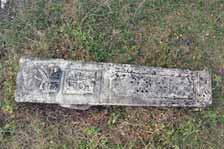



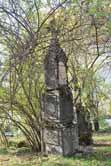
313
275. Gmrtismshobeli, Borjomi municipality, 147×34×52 _ Artistic and conceptual representations are displayed on a side facet of a rectangular block. These are placed on a recessed background within a raised, rectangular frame. The centre of the composition is dominated by a full-length frontal depiction of a man dressed in chokha-akhalukhi and wearing a hat and belt with a dagger around his waist. By his side we see a large, lateral depiction of a horse, which the man is holding by its bridle. The horse is saddled and there is a gun hanging on its side under the saddle. On the other side we see two birds, one above the other. The lower bird is relatively bigger by which it is “brought to the forefront” while the upper one is smaller and therefore “placed in the background”. In addition, crosses and various architectural motifs are carved on different areas of the tomb.
Epitaph: Inscriptions are inscribed on the surface and part of a side facet of the block. According to the epitaph we find out that someone, called Ioseb Leksasdze passed away on May 13 in 1905, and that he was married and had four sons. We also have a supplicatory prayer: “Remember Lord, Ioseb Leksasdze, who is dwelling under this
276. Ghmrtismshobeli (Borjomi municipality, 220×53×58 _ Artistic and conceptual representations are displayed on different sections of a multi-step stele. The grave marker is finished with a church model with a dome consisting of a drum and a conical roof. Two lateral depictions of animals are carved on the base and are partly covered below ground. One of them is a relatively tall deer with entangled antlers, while the other one is a ram with his horns stretched wide. We see a full-length frontal depiction of a man dressed in chokha-akhalukhi, wearing a belt with a dagger around his waist and equipped with a gun and sword. The depiction of the man is surrounded by an ornamental frame while at his sides we see a jug, drinking vessel, a bowl and another object which cannot be identified. On other facets we also see a candelabra, a half-length depiction of an angel, a crescent moon, a small circular segment and floral ornaments. We see a fully saddled horse, depicted as an independent composition surrounded by a frame. One of the compositions distinguished by its fine carving depicts a joint “frieze” depicting three eggs, an apple and a pear, all of which are presented from different angles.


Epitaph: Mkhedruli inscriptions are displayed on different sections of the stele, yet only a small part of them are legible. We learn from them that Max Bakashvili passed away on March 5, 1910. The fragment tells us that he has left children behind. The text contains the words in the first person, expressing mourning and regret.



314
277. Ivlita, Akhaltsikhe municipality, 155×47×15 _ Artistic and conceptual representations are not present in the form of figurative or ornamental depictions, but it is significant that the two-line Mkhedruli inscription inscribed on a smooth surface is here the most important decoration. The fine outlines of letters, their distribution across the surface and their carving technique fits the surface of the grave to such an extent that it bears an ornamental significance. On one side of the grave, we see a shallow and small circular hole, which may have a sacral function.
Epitaph: A two-line inscription reads: “within this grave is placed Erekle (of Aruthuna Maribi) 1799 ... 28”.
278. Ivlita, Akhaltsikhe municipality, 90×25×51 _ A rectangular, extended, tall gravestone is made in imitation of the shape of a cradle with all its facets decorated with geometric ornaments in the form of lattice works and meshes. On the upper part of the grave, the top edge represents the cradle’s handle, while the main artistic and conceptual figurative decoration unfolds across the side area. Here we see three large, full-length, frontal depictions of human beings. Small details on their clothes indicate that all three of them are women. One of them, standing slightly apart, is taller, while the other two, depicted closer to one another, have flowers in front, and are both holding crosses contained within circular frames in a raised hand.


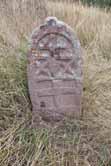


279. Khizabavra, Aspindza municipality, 103×38×55 _ Artistic and conceptual representations are displayed on the surface of a non-standard rectangular tomb chest, showing an extremely generalized depiction of a human being. Here we have a completely different interpretation of the concept of humanity – here the human body is depicted as a skeleton. We can see simplified outlines of legs and open arms depicted by single embossed lines. The linear representation of the neck and irregular circular shape of a head are also extremely generalized with only two hollow sockets representing the eyes. The depiction is held together by the crudely carved ribs around the abdomen area.
Epitaph: Inscriptions are not present, but one of the sections show traces of engraved graphemes.

315
280. Khizabavra, Aspindza municipality, 156×57×42 _ Artistic and conceptual representations are displayed on the surface of a gravestone, showing a full-length, frontal depiction of a woman with two angels above her. In the upper part of the stone, we see a cross with a complex outline. The gender of the person becomes identifiable through her dress and her headpiece. We see her long dress, her headpiece, her legs held apart, and her arms placed over her abdomen. The images of full-length, frontal depictions of angels facing each other above the depiction of the woman are also significant. They are holding a crown above the head of the departed. The surface of the stone is framed by a wide, torus-moulded border. Epitaph: Mkhedruli inscriptions are displayed on the surface of the stone, although the damage caused by environmental effects makes it is impossible to read them fully. The date 1919 is divided on both sides of the cross while a two-line inscription possibly reads: “Here rests Kekela”.

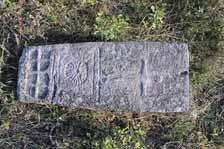
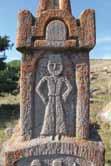


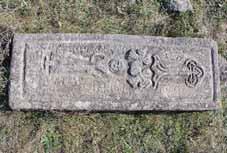

281.
full-length,
316
Khizabavra, Aspindza municipality, 190×79×60 _ A grave stele is placed on a small base, which consists of several rocks surmounted by a larger pedestal which forms part of the stele itself, and which is decorated with a torus-moulded border. Artistic and conceptual representations are displayed on the main body of the stele, showing a
frontal depiction of a man wearing a belt around his waist, a hat on his head and holding his arms akimbo. Below this depiction we see, within a frame, the depictions of an angel and a bird side by side, carved as seen from different angles. A staff is erected vertically between the two figures. The stele is finished with a moulded capital.
282. Khizabavra, Aspindza municipality, 104×41×44 _ Artistic and conceptual representations are displayed on the central section of the gravestone’s surface, showing a depiction of a man as though crucified. The composition could lead one to suppose that it may be a crucifixion, but it contains certain elements, which are incompatible with the traditional composition. The area below the figurative composition is filled with ornamental motifs including the star-borjgali inserted inside a circular outline and two relief squares divided by vertical and horizontal lines.
283. Khizabavra, Aspindza municipality, 95×21×56 _ Artistic and conceptual representations are displayed on different sections of a sculpture of a ram. One side displays an extremely generalized, small depiction of a human being carved in low relief. It is difficult to identify the gender of the person, yet, considering the working tool he is holding, we may assume that we are looking at a man. The tool looks likes crossed sticks, yet considering their angles, we may also assume that it may be a plough. Above the depiction of the man, we see an element like a star-borjgali contained within a circle. Curved horns are clearly seen around the head of the ram. We see an embossed element on its back, which can hardly be identified.
284. Khizabavra, Aspindza municipality, 133×45×45 _ Artistic and conceptual representations are displayed on different facets of a rectangular tomb chest. On the main surface of the stone, we see a Golgotha Cross with a simple shape placed within a small frame. We see a saw-tooth relief “frieze” surrounding an upper section of a side facet, while two depictions are displayed, very unsystematically, in the lower part. One of them is a simply shaped dagger and the other one is an animal depicted at the edge of the lower corner of the grave. Between them is a simple depiction of a star. It is difficult to identify the animal precisely, although the horn-like, embossed element above it leads us to think that it may be a unicorn – yet this is less likely and cannot be proved with confidence.




285. Khizabavra, Aspindza municipality, 137×44×52 _ Artistic and conceptual representations are displayed on different areas of a rectangular tomb chest, showing only a moulded cross on its main surface. One of the facets displays an axe, the surface of which is decorated by etching lines. On the other facet we see an equally large depiction of a fish.
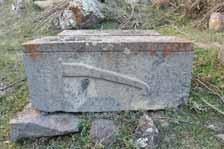
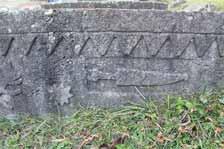

317
286. Kvibisi, Borjomi municipality, 125×35×35 _ Artistic and conceptual representations are displayed on different sections of a rectangular tombstone. In the upper part of the surface, we see an engraved cross with a complex outline, which is engraved on a rectangular slab, with two lateral depictions of small birds facing one another. On a side facet, images of an animal and an angel are depicted side by side. The full-length, frontal depiction of the angel is engraved with shallow simple lines, while the depiction of the animal is carved in haut-relief. The animal is depicted in motion, while grazing. The details of its surface are finely carved.



Epitaph: Inscriptions must have been placed on the surface, although they have now faded and are illegible. Only a few graphemes can be traced.



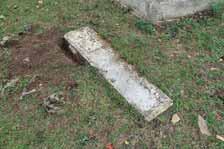
287. Kvibisi, Borjomi municipality, 145×38×37 _ Artistic and conceptual representations are displayed on the surface of a rectangular tomb chest, showing a full-length, frontal depiction of a man filling up the entire surface of the stone. The man is dressed in chokha-akhalukhi and is wearing boots with heels; he keeps his arms crossed over his chest. In the corners above his head, we see two half-length figures of angels. The slanted edges of the stone surface are decorated with a floral ornamental border fully surrounding the rectangular surface. The clothes and all the details of his depiction are clearly visible.
288. Likani, Borjomi municipality, 122×70×70 _ The headstone is a church model sculpture carved from a single piece of rock, standing on a two-step base. Artistic and conceptual representations are displayed, consisting of rather modest façade decorations. All we see are decorative arches with multi-step moulding, resting on the capitals in the corner areas. In the upper part of the tall and narrow church model, we see the main square of the church, the beams of the cross-in-square church design, and the drum of the dome decorated with false windows and surmounted by a conical roof. A shallow candle-holding niche is carved on one of the surfaces.
Epitaph: All the facets of the square block, which is the upper step of the two-step base, display Mkhedruli inscriptions. A small fragment of the epitaph reads: “the grieving wife and children every day… heartbroken passed away on 27 September in 1906”.
318
289. Machartskali, Borjomi municipality, 295×68×70 _ Artistic and conceptual representations are displayed on the body of a tall and narrow stele. The stele consists of several blocks of different shapes and sizes sitting on one another. On two opposite facets of one of the blocks, we see full-length frontal depictions of men dressed in chokha-akhalukhi. They both wear hats, one hand is lowered, the other one is held by the waist. In one depiction all details are clearly visible –especially the facial features – eyes, nose, ears and moustache. Another relief figure is a bas-relief depiction of a horse on the lower part of one of the facets. The horse is saddled, and the forelegs are reared up.





Epitaph: Inscriptions are displayed on the base area, but not all of it is legible. A fragment tells us that the departed passed away “at the age of 33 in November 1918”.
290. Machartskali, Borjomi municipality, 250×95×115 _ Artistic and conceptual representations are displayed on the body of a tall and narrow stele. The grave stele consists of several blocks of different shapes, mouldings and sizes, placed one upon another. The surmounting element of the grave stele is a dome with a drum decorated with faux windows and finished with a conical roof. On the two-step section of the stele, we see a moulded cross and a full-length, frontal depiction of a man. The details of the man’s clothes and decoration are clearly visible. He wears a hat and a belt with a dagger around his waist; he keeps his elbows apart, extended horizontally, with one arm raised and holding a drinking vessel, and the other lowered. There are several depictions by his side, which cannot all be identified, yet we can recognize among them the depictions of a crescent moon, and a table, with a few things placed upon it. Another facet of the stele is decorated with a lateral depiction of a horse, above which we see the aerial depictions of two descending birds. Different surfaces are filled with the depictions of crosses, each having different shapes and decorative elements.
Epitaph: A fourteen-line Mkhedruli inscription is stretched across the two facets of the stele, only half of which is legible: “Remember me O Lord, when you come into your kingdom, within this grave I rest, Vladimer …” the surname of the departed is unreadable and the epitaph seems to be ending with a supplication for his soul. The lower part of the epitaph is contained within a framing outline, above which we can read the date of death of the departed – 1914, within the pediment created by borders with a torus moulding. The inscriptions on the base of the stele are illegible.
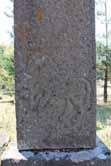
319
291. Machartskali, Borjomi municipality, 283×100×85 _ Artistic and conceptual representations are generously displayed and distributed across the facets of a multi-step stele surmounted by a dome. Several compositions are depicted on the bottom block of the stele, including full-length frontal depictions of three men. All three of them are dressed differently – they wear different hats and hold different musical instruments – two of them are holding wind instruments, while the other one has a drum hanging under his arm and is holding drumsticks in both hands. Another facet of the same block displays an image of a saddled horse, and a flower filling the whole area above the horse. Another figurative presentation is displayed on the surface under the dome, showing a full-length frontal depiction of a man holding a drinking horn and wearing a hat, chokha-akhalukhi, and a belt with a dagger and gun. Different objects are carved around him – we see a table containing with three vessels of different shapes and sizes placed upon it, and a chair on the other side. The church model is finished with a conical roof above the drum of the dome.

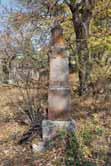
Epitaph: Mkhedruli inscriptions are inscribed on different areas of the stele, from which we learn that someone called Giorgi Sanakoshvili, son of Niko, passed away at the age of 33 in 1913. The epitaph contains a supplicatory prayer to the Lord. There is another random one-line inscription probably in the Armenian language.


292. Nedzvi, Borjomi municipality, 177×42×36 _ Artistic and conceptual representations are displayed on the surface of the tomb and its side facet. The upper area is decorated with a linear depiction of a cross, with complex moulding carved on a rectangular surface, above which we see two raised ledges, possibly intended as candle holders. Here we also see a lateral depiction of a bird. Another relief is depicted on a side facet showing a lateral image of a sheep – it is depicted in motion, holding its head down and grazing. The side areas of the tomb are decorated with engraved architectural motifs. Epitaph: Lomidze passed away on December 25, 1891 at the age of 20”.

293. Saro, Aspindza municipality, 143×49×51 _ Depictions are placed on different sections of the tomb – a plough is spread horizontally across the side facet, and a man is standing at its end. The type of porous stone used, and some minor erosion, make it difficult to see all the details, but we see the full-length, frontal depiction of a man quite clearly. The man is holding something in one hand, which cannot be identified, and is holding the plough with the other hand. On the edge of the tomb, we see shelf-shaped, carved objects. Only a cross of simple design is depicted on the surface of the tomb.



320
294. Saro, Aspindza municipality, 120×54×46 _ Depictions are found on different areas of the stone. The side facet displays a horizontally spread composition with a man standing at its edge. The type of porous stone used, and some minor erosion, make it difficult to see all the details, but we see the full-length, frontal depiction of a man clearly. The man is holding something in one hand, which cannot be identified, and a large jug in the other. On the same facet we see a drinking horn and two grape clusters hanging from the same branch. One of the facets displays horizontal, shelfshaped protrusions, which might have been designed as candle holding niches, with a small cross carved between them. A cross of simple design is carved on the main surface.
295. Ude, Adigeni municipality, 170×73×73 _ The tombstone is a replica of a domed church carved from a single massive rock and is standing on a base composed of several large stones. The base stones most probably are gravestones and each of them belongs to a separate grave. Artistic and conceptual elements are to be seen in the embossed torus-
steps, while torus-moulded borders on the drum of the dome and other details are clearly observed. Epitaph: A three-line Mkhedruli inscription on the lower part of the model is found on the front facet, which reads: “Here who passed away in 1896”. Therefore, we may conclude that this large, sepulchre-like grave holds at least two relatives.
296. Vale, Roman Catholic cemetery, Akhaltsikhe municipality, 155×70×47 _ The gravestone is a replica of a domed church carved from a single massive rock placed on a base made of a large stone. Artistic and conceptual representations are displayed, consisting of some embossed, torus-moulded, false windows on different façades, including on the drum of the dome. The details of the three-step cornice are also clearly visible, as are the door, the torus-moulded borders of the drum of the dome and other minor details. On one of the facets, at the level of a door or a window we see a full-length, frontal depiction of a human being, holding a raised sword.





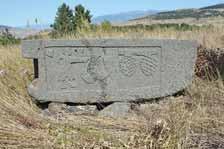
321
297. Zveli, (Dzveli) Aspindza municipality, 155×40×45 _ A massive gravestone is shaped in the image of a ram. Artistic and conceptual representations are displayed on the back of the ram, the surface of which has a rectangular shape. The head of the ram is rounded, and its curving horns are clearly visible. The flat surface of the back of the animal contains the most significant information – we see here a massive, embossed anvil and below it the depictions of a hammer, a metal chisel and pliers side by side. The relief carving of the tools is slightly lower compared to that of the anvil. On the side of the ram we see the depictions of a pitchfork, a drinking horn and several other elements which can hardly be identified.
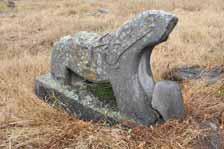




JAVAKHETI
298. Baraleti, Akhalkalaki municipality, 91×56×49 _ Depictions are found on a section of the tomb’s surface and form a highly unusual type of composition. A long plough is spread horizontally across the whole middle part of the surface and there are a pair of five bulls attached to the same plough. The plough is depicted from an aerial view while the bulls are shown laterally.
299. Chunchkha, Akhalkalaki municipality, 116×53×45 _ Depictions are placed on different areas of the sculpture of a horse carved out of a monolith and standing on a rectangular base. We see a moulded saddle and parts of the stirrups on the side of the horse. On another side of the horse, we see a small frontal depiction of a woman holding a large, stringed musical instrument in her hands.
322
300. Chunchkha, Akhalkalaki municipality, 155×50×35 _ Depictions are found on the area of the surface of the tomb showing deeply engraved horizontal and vertical lines. Such lines created different “compositions” in different areas of the tomb. We see square shapes, or a single long horizontal line divided by many vertical lines.
301. Erkota, Aspindza municipality, 117×33×47 _ Depictions are found on the side of a ram sculpture carved from a monolith. A highly generalized, full-length frontal depiction of a human being surrounded by a rectangular frame is engraved on one side. The person is holding something in his/her hands. On the other side, we see a cross surrounded by an identical frame. A circular torus is wrapped around the ram’s neck, and parts of the curled horns are visible on the area of the head.


302. Kothelia, Akhalkalaki municipality, 100×55×31 _ Depictions are found on the back of a horse sculpted from a single monolith, showing a moulded saddle and a crosshatched surface. The hatched details most probably refer to the parts of the saddle and bridle.



323
303. Kothelia, Akhalkalaki municipality, 118×67×55 _ Depictions are found on side facets of the tomb. On one side we see two decorative arches and between them, a relief depiction of a woman. Considering the generalized nature of the depiction, the only feature, which makes it possible to identify the gender of the depicted person is the long dress widened at the bottom. We can see her arms, one of which is clinging to her waist and the other which is holding slightly opened scissors. The corner areas of the tomb are decorated with rounded pillars, raised from the surface as a hautrelief decoration. The surface of the tomb displays only a cross of simple design.
304.
137×58×75
of a monolith

305. Ptena, Akhalkalaki municipality, 147×86×20 _ Depictions are placed on the header and base sections of the pillarshaped gravestone, which is finished with simply moulded capitals. The pillar is laid horizontally on the ground and its lower part is not rounded, but flat. Apart from the pillar shape, the gravestone may also remind one of the commonly found cradle shape, and this view may be supported by the existence of torus-moulded borders on its body.


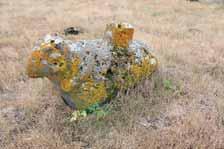
306. Saghamo, Ninotsminda municipality, 145×56×30 _ Depictions are placed on the area of the surface of the tomb showing a full-length, frontal depiction of a man with different elements depicted around him. Only one depiction can be identified as a water pitcher, while the other objects, although very concrete, cannot be identified. The man has his arms crossed over his chest in accordance with Christian custom.

324
Ptena, Akhalkalaki municipality,
_ The sculpture of a ram is carved out
together with a small church model sitting on its back. Curled horns are gently carved around the area of the head. Details of the figure of the ram are left unrendered.
307. Saghamo, Ninotsminda municipality, 200×102×60 _ Depictions are found on the side of a horse sculpture carved out of a monolith. We see two circular images. The circles are embellished with different elements, which cannot be seen around the area of the head.

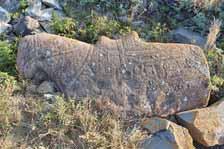

308. Saghamo, Ninotsminda municipality, 195×101×48 _ Depictions are found on the side of the sculpture of a horse carved out of a monolith, where different parts of its equipment are engraved. We see a decorated saddle on the back, and parts of a bridle around the area of the head.
309. Saghamo, Ninotsminda municipality, 160×74×46 _ Depictions are found on the area of the tomb’s surface, showing a variety of embossed and thick intertwined torus-moulded borders. Two independent torus-moulded borders, knotted in the middle, surround the tomb, forming rhombus like knots on the surface, while in the areas of the edges, some torusmoulded borders form the shapes of human arms and palms of hands at the ends. We see small details which cannot be identified.
325
310. Saghamo, Ninotsminda municipality, 178×73×22 _ Depictions are placed on the area of the surface of a rectangular tomb, in the centre of which we see a full-length, frontal depiction of a man. Only a few elements depicted around him can be identified, such as a water pitcher, an axe, a sword and a dagger, while the other carved objects, although very concrete in character, cannot be identified. The man has his arms crossed over his chest in accordance with Christian custom.
311. Satkhe, Ninotsminda municipality, 200×111×68 _ The sculpture of a ram is carved out of a monolith, together with a
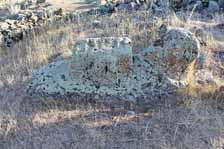




the ram are left unrendered. The model of a single-nave church sits on the back of the ram; its details are more clearly visible. We see its rooftiles, a door on one façade and a relief cross carved on its other façade.
312. Thoki, Aspindza municipality, 100×64×38 _ Depictions are found on the side of a horse carved from a monolith, showing the palm of a hand holding a shepherd’s crook. The horse is partly carved from a monolith, while the lower area is carved on a flat surface of the stone. The head of the sculpture is broken away, but considering the long tail in the back and other minor details, we may be persuaded that the sculpture depicts a horse.
313. Vardistsikhe, Akhalkalaki municipality, 148×52×67 _ Depictions are found on different parts of the sculpture of a ram carved from a monolith. On the back of the ram, a church model is sculpted. Traces of curled horns are partly visible on the area of the head. Details of the sculpture are left unrendered. The details of the church model on the back of the ram are seen more clearly. We see the roof of the church with roof tiles, and the entrance at one side, and a window at the other. The model of the church is sculpted to show both the exterior and interior, which is made obvious by the hollow space seen beyond the door and the window.
326
Abakelia, Nino, The Oldest Cosmological Concepts and Archaic Religious Symbols in the Cultural Memory of the Georgians, Tbilisi, 2017.
Abesadze, Nanuli, “The Craftsmen’s Guild in the City of Gori”, Materials for the Ethnography of Georgia, vol. 16-17, 1972.
Abesadze, Nanuli, Craft Production and the Life of Craftsmen in the Cities of Georgia: the 2nd half of the 19th c. – early 20th c. (Historical-Ethnographical Study), Tbilisi, 1986.
Arabuli, Amiran, “Epitaph”, Literatura da Khelovneba [Literature and Art], # 1, 1998.
Arabuli, Amiran, and Arabuli, Eteri, Remember me with Forgiveness, Tbilisi, 2007. The Hour of Our Death, New York, 1981.
Baliauri, Melano, and Makalatia, Niko, “The Cult of the Departed in Arkhoti Community”, Materials for the Ethnography of Georgia, vol. 3, 1940.
ENIMKI’s Moambe [The Bulletin of the Institute of Language, History and Material Culture], vol. 11, Tbilisi, 1941.
Bardavelidze, Vera, The Traditional Secular? and Religious Monuments of the Eastern Highlands of Georgia, vol. 2, Khevsureti, Tbilisi, 1982.
Bardavelidze, Vera, The Traditional Secular? and Religious Monuments of the Eastern Highlands of Georgia, vol. 3, Tusheti, Tbilisi, 1985.
Bardavelidze, Vera, The Traditional Secular? and Religious Monuments of the Eastern Highlands of Georgia, vol. 1, Pshavi, Tbilisi, 1974.
Batiashvili, Zurab, “The Georgians in the Ottoman Trebizond”, The Bulletin of the Institute of Language, History and Material Culture, Tbilisi, 2008.
Bedukadze, Sara, “The Folk Museum of Stonemasonry”, Dzeglis Megobari [Monument’s Friend], N. 7, 1966.
Bedukadze, Sara, “The Folk Standards in Stonemasonry in Khevi”, The Materials for the History of the Material Culture of Georgia, vol. 1, 1966.
Bedukadze, Sara, Folk Stonemasonry in Algeti Gorge, Tbilisi, 1973.
Berdzenishvili, Niko, “On the Forms of Land Ownership in Feudal Georgia”, Matters Concerning the History of Georgia, book 3, Tbilisi, 1966.
Berdzenishvili, Niko, Matters Concerning the History of Georgia, Historical Geography, book 1, Tbilisi, 1964.
Beridze, Vakhtang, “The Georgian Art in the 8th-9th Centuries”, Essays on Georgian History, vol. 2, Tbilisi, 1973.
Beridze, Vakhtang, The Georgian Church Architecture of the 16th-18th cc. Tbilisi, 1994.
Bezarashvili, Tsiala, Georgian Clothing, Shida Kartli (Ethnographic Research), Tbilisi, 1987.
Bochoridze, Giorgi, A Journey to Samtskhe-Javakheti, Tbilisi, 1992.
Bochoridze, Giorgi, The Historical Monuments and Antiquities of Racha-Lechkhumi, Tbilisi, 1994.
Bochoridze, Giorgi, The Historical Monuments of Imereti, Tbilisi, 1995.
Bochorishvili, Levan, “Ethnographic Writings”, Materials for the Ethnography of Georgia, #8, 1956.
Bochorishvili, Levan, “From the Historical Ethnography of Kvemo Kartli (gravestones)”, Materials for Georgian Ethnographical Studies, vol. 8, Tbilisi, 1956.
Bokhochadze, Alexi, and Mirianashvili, Nino, The Sepulchre of Dzalisi, Tbilisi, 1990.
Brailashvili, Nino, Blue Table Covers, Tbilisi, 1964.
Brailashvili, Nino, The Georgia I Remember: Ethnographic Sketches, Tbilisi, 1990.
Chikovani, Teimuraz, Trialeti, Tbilisi, 1976.
Chitaia, Giorgi, “A Brief Report of the Expedition in Lechkhumi”, The Bulletin of the Georgian Museum, 12-B, 1944.
Chitaia, Giorgi, “A Stone Coffin from Kvemo-Alme”, The Bulletin of the Institute of Language, History and Material Culture, vol. 7, Tbilisi, 1940.
Chitaia, Giorgi, “From the Ethnographic Journey to Aghbulaghi Region”, The Bulletin of the Georgian Museum, vol. 4, 1927-28.
The Bulletin of the Georgian Museum, vol. 3, 1926-27.
Chitishvili, Natalia, “Three-dimensional Architectural Models in Medieval Georgia”, Representation of Architecture in Medieval Georgia, edited by M. Didebulidze and D. Khoshtaria, Tbilisi, 2022 (publication pending).
Drosha [Flag], 1975, #11.
Chorgolashvili, Mamia, Mtatsminda (second edition), Tbilisi, 1991.
Datunashvili, Nino, Georgian Clothing and its Social Aspects from the 15th to early 19th c.,
327
Gagoshidze, Giorgi, “On the Depiction of the Cross on the Church Floor”, Sapatriarqos Utskebani [Newsletter of the
Gengiuri, Natalia, The Grave Monuments of the Early 20th c., and the Late Medieval Buildings in Kakheti and Kartli, (materials of the 2004-2005 expeditions), Tbilisi, 2006.
Ghudushauri, Tinatin, “The Customs Related to the Departed”, The Ethnography/Ethnology of Georgia, edited by Roland Topchishvili, Tbilisi, 2010.
Giorgadze, Dali, The Rights of Burial and Mourning in Georgia (According to the Ethnographic Materials from Tusheti, Pshavi, and Khevsureti), Tbilisi, 1987.
Gobejishvili, Germane, “The Sepulchre of Bedena”, Dzeglis Megobari [Monument’s Friend], 12, 1967.
Gonikishvili, Mikheil, “The Chapel of the Last King of Imereti Solomon II in Trebizond”, Dzeglis Megobari [Monument’s Friend], 36, 1974.
Grabar, Andrè: Le thème du “gisant” dans l’art byzantin, Cahiers archèologiques, 29, 1980/81.
Janashvili, Mose, “King Erekle (the lamentation and burial)”, Iveria, 1890, #117.
Japaridze, Vakhtang, “The Sarcophagus with Asomtavruli Inscription in Village Balichi”, The Bulletin of the Georgian National Academy of Sciences, #2, 1972.
Jorbenadze, Besarion, “A Sepulchre in the Village Kavtiskhevi”, Dzeglis Megobari [Monument’s Friend], 23, 1970.
Jorbenadze, Besarion, “A Vaulted Sepulchre of Zhinvali”, Dzeglis Megobari [Monument’s Friend], 47, 1978.
Kekelidze, Robert, “Gravestones from Algeti Gorger”, Dzeglis Megobari [Monument’s Friend], N 34, 1974.
Khakhanashvili, Alexandre, The King of Imereti, Solomon II, Historical Letter, Tiflis, 1910.
Khositashvili, Sergo, The Wedding and Burial Rites in Samtskhe-Javakheti (ethnographic essay), Tbilisi, 1983.
Khundadze, Tamar, “Liturgical Themes on Medieval Georgian Relief Sculptures”, ACADEMIA, 5, 2016-2017.
Khuskivadze, Theophile, The Last King of Imereti – Solomon II, (historical essay), Kvirila, 1902.
Kiknadze, Eka, Iakob Nikoladze, Tbilisi, 2016.
Materials for the Ethnography of Georgia, vol. 23, 1987.
Kotetishvili, Vakhushti, Georgian Folk Poetry, Tbilisi, 1939.
Kvachatadze, Ekaterine: On the Tradition of Decorating Gravestones in 17th _ 19th cc. Georgia, Moambe [Bulletin] (Georgian National Academy of Sciences), vol. 15, #3, 2021.
ACADEMIA, 8-9, 2020-2021.
ACADEMIA, N 8-9, 2020-2021. Spektri, 2005.
Lezhava, Samson, “The Traditional Housing in Trialeti – An Important Cultural Heritage”, Dzveli Khelovneba Dges [Ancient Art Today], #4, 2013.
Liluashvili, Manon, “Tomb Canopies in Georgia from the seventeenth to the nineteenth centuries”, Saqartvelos Sidzveleni [The Antiquities of Georgia], 23, 2020.
Lomtatidze, Giorgi and Tsitsishvili, Irakli, “A Newly Discovered Sepulchre in Mtskheta”, The Bulleting of the Georgian National Academy of Sciences, vol. 12, #10, 1951.
Lomtatidze, Giorgi, “Appeal of gravestones”, Journal Drosha [Flag], N4, and #5, 1969.
Lomtatidze, Giorgi, Archaeological Inquiries in Algeti and Iori Gorge, Tbilisi, 1989.
Lomtatidze, Giorgi, The Sepulchre of Mtskheta, Tbilisi, 1960.
Dzeglis Megobari [Monument’s Friend], 20, 1970.
Makalatia, Sergi, Ateni Gorge (Historical-Ethnographic Essay), Tbilisi, 1957.
Makalatia, Sergi, Borjomi Gorge (Historical-Ethnographic Essay), Tbilisi, 1957.
Makalatia, Sergi, Dzama Gorge, Tbilisi, 1961.
Makalatia, Sergi, Kavtura Gorge, Tbilisi, 1960.
Makalatia, Sergi, Khevi, Tbilisi, 1934.
Makalatia, Sergi, Khevsureti, Tbilisi, 1984.
Makalatia, Sergi, Ksani Gorge, (Historical-Ethnographic Essay), Tbilisi, 1968.
Makalatia, Sergi, Lekhura Gorge, Tbilisi, 1964.
Makalatia, Sergi, Liakhvi Gorge, Tbilisi, 1971.
Makalatia, Sergi, Meskhet-Javakheti, (Historical-Ethnographic Essay), Tbilisi, 1938.
Makalatia, Sergi, Phroni Gorge, Tbilisi, 1963.
Makalatia, Sergi, Pshavi, Tbilisi, 1985.
328
Makalatia, Sergi, Tedzami Gorge (Historical-Ethnographic Essay), Tbilisi, 1959.
Makalatia, Sergi, The History and Ethnography of Samegrelo, Tbilisi, 1941.
Megrelidze, Ioseb, The Antiquities in Liakhvi Gorge; Patara Liakhvi Gorge, Patsi Gorge, Jejori Gorge, book 2, Tbilisi, 1997.
Melitauri, Konstantine, “The Wooden Sepulchre Construction of Bedena”, Dzeglis Megobari [Monument’s Friend], 35, 1974.
Menteshashvili, Stephane, “About the Glossary of the Burial and Graves”, The Bulletin of the Georgian National Museum, vol. 12-B, 1944.
Muskhelishvili, Levan, “Dmanisi” (The history and description of the former city), Material Culture of the Shota Rustaveli’s Era, Tbilisi, 1938.
Muskhelishvili, Levan, Archaeological Excursions in Mashavera Gorge, Tbilisi, 1941.
Nadiradze, Eldar, “‘House’, ‘Church’, and ‘a Church Building” in Christian Symbolism”, Religia [Religion], 8-9, 1993.
Nadiradze, Eldar, “Memorial Monuments in Imereti”, Gantiadi [Dawn], #1, 1986.
Nadiradze, Eldar, “Stonemasonry in Lechkhumi”, Materials for Studying the Ethnography of Lechkhumi, Tbilisi, 1985.
Nadiradze, Eldar, “The oldest example of a zoomorphic monument from Javakheti”, Khelovneba [Art], #3-4, 1993.
Nadiradze, Eldar, Georgian Stonemasonry in Imereti, Tbilisi, 2001.
Nadiradze, Eldar, Stonemasonry and Gravestones in Shida Kartli, Shida Kartli (Ethnographic Research), 1987.
Nadiradze, Eldar, The Memorial Culture of Georgia, Tbilisi, 2001.
Nadiradze, Eldar, The Symbolism of Memorial Monuments, Tbilisi, 1998.
Nadiradze, Eldar, Zoomorphic Monuments of Georgia, Tbilisi, 1996.
Nakhutsrishvili, Niko, and Sanikidze, Giorgi, (eds.), Georgians at the Dulab Christian Cemetery in Tehran, Tbilisi, 2019.
Nikoladze, Iakob, “About Bas-Relief”, Sabchota Khelovneba [Soviet Georgia], #10, 1976.
Ochiauri, Alexi, “The Cult of the Departed Among the Communities in Roshka and Ukenakhadu”, Materials for the Ethnography of Georgia, vol. 3, 1940.
Ochiauri, TinaTin, The Burial Rites in Kartli in the Past and Now, Tbilisi, 1987.
Okropiridze, Asmat, “On the Language of Expression of Georgian Art”, ACADEMIA 6-7, 2006.
Otto-Dorn, Katharina: Türkische Grabsteine mit Figurenreliefs aus Kleinasien, ARS ORIENTALIS, The Arts of Islam and the East, vol. III, Baltimore, Maryland, 1959.
Grabplastik, Vier Vorlesungen über ihren Bedeutungswandel,von alt-Ägypten bis Bernini, Herausgegeben von Horst W. Janson, mit einer Vorbemerkung von Martin Warnke, Köln, 1993.
Ramishvili, Ramin, “A Grave with a Fretwork from Sioni”, Dzeglis Megobari [Monument’s Friend], 23, 1970.
Qartuli Khelovneba [Georgian Art], #9, Tbilisi, 1987.
Sakhokia, Tedo, “The Cult of the Departed in Samegrelo”, Materials for the Ethnography of Georgia, Vol. 3, 1940.
Salia, Kalistrate, “The Destruction of the Grave of Solomon II in the Ottoman Empire”, Bedi Qartlisa [The Destiny of Georgia], #8, 1950.
ARS GEORGICA, series B, 2012.
International InterdisProceedings, Tbilisi, 2014.
Shanshiashvili, Ana, Old Tbilisian Characters and Contemporary Portrait, Historical Tbilisi, Cultural Aspects, Tbilisi, 2013.
Aghmosavleti da Kavkasia [The East and Caucasus], #3, 2005.
Sinauridze, Manana, “A Sepulchre in the Environs of Khornabuji”, Dzeglis Megobari [Monument’s Friend], #9, 1967.
Sinauridze, Manana, “graves with sculptural depictions of a sheep and horse”, The Bulletin of the State Museum of Georgia, XXXVI-B, 1982.
Skhirtladze, Zaza, St Nino, Tbilisi, 2008.
Skhirtladze, Zaza, The Final Resting Place of St David of Gareja, Tbilisi, 2006.
Sulkhanishvili, Eter, “Tomb covers”, Essays of The Georgian National Museum, vol. 9, 104-112, Tbilisi, 2004.
Surguladze, Irakli, “For studying the zoomorphic symbolism (deer-lion)”, Works of Tbilisi State University: History, Art History, Ethnography, vol. 243, 1983.
329
Surguladze, Irakli, “The Spatial Aspects in the Religious Beliefs and Myths of Georgians”, Materials for the Ethnography of Georgia, 23, 1987.
Takaishvili, Ekvtime, Archaeological Expedition in Kola-Oltisi and Changli in 1907, Takaishvili, Ekvtime, Archaeological Expedition in Southern Georgia in 1917, Tbilisi, 1952.
Telia, Avtandil, “On the Sculpture of Dimitri Kipiani”, Sabchota Khelovneba [Soviet Georgia], #1, 1967.
The Mystery of the Gravestones in Tskadisi, Newspaper Kviris Palitra, 2017, #25, (1194).
Topchishvili, Roland and Gvimradze, Teimuraz, Ethnological Tbilisi, The Traditional Life and Culture of the Tbilisians, Tbilisi, 2017.
Tsitsishvili, Irakli, “Ancient Sepulchre in Bagineti”, The Bulletin of the Georgian National Academy of Sciences, vol. 11, #3, 1950.
Qartuli Khelovneba [Georgian Art], 8, 1979.
Materials for the Ethnography of Georgia, vol. 9, 1957. 1904, #13-14. #9, 1980.
Matsne [Messenger], #2, 1969.
330
ILLUSTRATION CREDITS
Gogotur Misriashvili: 1-7, 10-17, 19-23, 26-46, 49-63, 65, 67-182, 185-189, 191, 193-198, 200, 207, 210, 211, 214, 219, 222, 223, 225-229, 233-253, 256-260, 262-266, 268, 270, 272-275, 277-280, 282, 284, 286-293, 295-297, 299, 300, 304-306, 308, 309, 312, 313, 318, 321-323
Manon Liluashvili: 201, 202, 216-218, 220, 271, 276
Natalia Chitishvili: 183, 184, 190, 203, 205
Ketevan Dighmelashvili: 24, 25
Zurab Gengiuri: 64, 66
Eldar Nadiradze: 254 Goga Demetrashvili: 206
Marina Okhanashvili: 208
Mikheil Gabaidze: 307 Natia Natsvlishvili: 9
David Chikhladze: 232
Nino Sarava: 283
The Collection of Dimitri Ermakov at the Georgian National Museum of Fine Arts: 8, 47, 48, 215, 231, 310
Central Historical Archive at the National Archives of Georgia: 224, 230, 285, 311
Central Archive of Audio-Visual Documents at the National Archives of Georgia: 319
S. Lezhava, M. Gachechiladze, K. Kintsurashvili, T. Belashvili, Alexandre (Shura) Bandzeladze, Tbilisi, 2017, pp. 90; 199 N. Brailashvili, The Georgia I Remember, Ethnographic sketches, Tbilisi, 1990, Fig. 235; 294 Baron De Baye, In Georgia, translated from French, with the foreword and commentaries by L. Maghradze, Tbilisi, 2011, pp. 38; 298
I. Grishashvili, The Literary Boheme of Old Tbilisi, Tbilisi, 1927, pp. 213; 316 T. Beridze, Artist Vano Khojabegov, Tbilisi, 1969, pp. 38; 317 V. Beridze, Gudiashvili, Tbilisi, Corvina-Budapest, 1975, pp. 40-41; 324 Gigo Gabashvili, Designed and compiled by V. Gabelia, Tbilisi, 1986, Fig. 78; 314
The Descriptions of the Historical and Cultural Monuments of Georgia, vol 2, Akhmeta, Dusheti, Tianeti, and Kazbegi Regions, Tbilisi, 2008, Fig. 307; 221
Dzeglis Megobari
Sakhalkho Gazeti Tsnobis Purtseli
Newspaper Droeba, illustrated appendix, 1909, #85 (16); 213
Newspaper Droeba, 1909, #27; 212 Newspaper Kvali, Journal Kvali, 1893, #24; 204
331
ILLUSTRATION CREDITS FOR THE INVENTORY OF GRAVESTONES
The Collection of Dimitri Ermakov at the Georgian National Museum of Fine Arts: Entries: 23-25
Georgia. Entries: 85-87, 138, 167, 168, 346, 362
Kaspi Local History Museum: Entries 40-49
Natalia Chitishvili: Entries: 55, 59, 120, 140-142, 184
Neli Chakvetadze: Entries: 77, 82, 88, 99, 101, 138, 139, 170, 182, 251, 318,
Kristine Sabashvili: Entry 158 Shalva Lezhava: Entry 175
Natia Kalandadze: Entry 314
All the other photographs in the Inventory credited to Gogotur Misriashvili
332



 GEORGE CHUBINASHVILI NATIONAL RESEARCH CENTRE FOR GEORGIAN ART HISTORY AND HERITAGE PRESERVATION
GEORGE CHUBINASHVILI NATIONAL RESEARCH CENTRE FOR GEORGIAN ART HISTORY AND HERITAGE PRESERVATION










































































































































































 161. Khizabavra. Grave monument
SAMSON LEJAVA
161. Khizabavra. Grave monument
SAMSON LEJAVA









































 MANON LILUASHVILI
MANON LILUASHVILI






















































 MANON LILUASHVILI
MANON LILUASHVILI












































 293. Akhalsopeli (Bza). Grave monument
GIORGI PAPASHVILI
293. Akhalsopeli (Bza). Grave monument
GIORGI PAPASHVILI































 Ude, the old cemetery
Ude, the old cemetery





























































































































































































































































































































































































































































































































































































































































